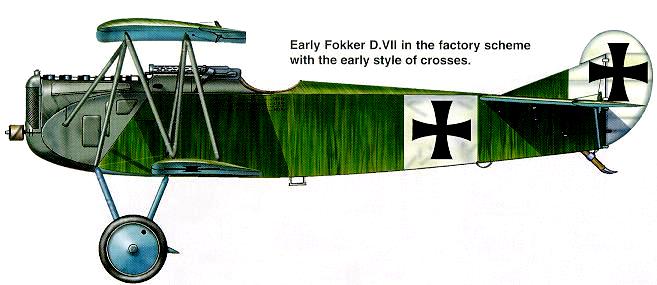- В.Кондратьев Самолеты первой мировой войны
- В.Шавров История конструкций самолетов в СССР до 1938 г.
- А.Александров, Г.Петров Крылатые пленники России
- A.Weyl Fokker: The Creative Years (Putnam)
- J.Herris, J.Leckscheid Fokker Aircraft of WWI. Vol.5: 1918 Designs Part 1: Prototypes & D.VI (A Centennial Perspective on Great War Airplanes 55)
- J.Herris, J.Leckscheid Fokker Aircraft of WWI. Vol.5: 1918 Designs Part 2: D.VII & E.V/D.VIII (A Centennial Perspective on Great War Airplanes 55b)
- J.Herris Fokker Aircraft of WWI. Vol.6: Foreign Service (A Centennial Perspective on Great War Airplanes 56)
- C.Owers Fokker Aircraft of WWI. Vol.7: Postwar (A Centennial Perspective on Great War Airplanes 67)
- J.Forsgren Swedish Military Aircraft 1911-1926 (A Centennial Perspective on Great War Airplanes 68)
- O.Thetford, P.Gray German Aircraft of the First World War (Putnam)
- W.Green, G.Swanborough The Complete Book of Fighters
- G.Swanborough, P.Bowers United States Navy Aircraft Since 1911 (Putnam)
- L.Andersson Soviet Aircraft and Aviation 1917-1941 (Putnam)
- P.Grosz, G.Haddow, P.Shiemer Austro-Hungarian Army Aircraft of World War One
- E.Hauke, W.Schroeder, B.Totschinger Die Flugzeuge der k.u.k. Luftfahrtruppe und Seeflieger 1914-1918
- Журнал Flight
В.Кондратьев Самолеты первой мировой войны
"ФОККЕР" D.VII / FOKKER D.VII
Победителя истребительного конкурса в Адлерсхофе - "Фоккер" D.VII принято считать лучшим германским истребителем Первой мировой войны и для этого есть веские основания. Самолет продемонстрировал высокую максимальную скорость, хорошую устойчивость и управляемость в сочетании с отличной высотностью и скороподъемностью.
Конструктивно машина, разработанная Антони Фоккером и Рейнольдом Платцем, представляла собой развитие типа D.VI со значительно увеличенной энерговооруженностью, которую обеспечил рядный шестицилиндровый двигатель водяного охлаждения "Мерседес" D-III мощностью 160 л.с. Начиная с июня 1918 г. самолет оснащался более мощным 185-сильным мотором BMW-IIIa (модификация D VIIF) или 180-сильным "Мерседесом" D-IIIau, с которыми его характеристики стали еще лучше.
Длина фюзеляжа и размах крыльев были увеличены в сравнении с D.VI, но их конструкция осталась прежней. Изменилось только оперение, в котором появился киль. Вооружение также оставалось стандартным - два синхропулемета LMG 08/15.
В феврале 1918 г. на заводах фирмы "Фоккер" и "Альбатрос" (OAW) развернулось массовое производство D.VII. Первые из них поступили на фронт в начале апреля. Всего до конца войны было построено по разным данным от 1700 до 2694 экземпляров (некоторые источники приводят даже цифру 3200, но это, скорее всего, число заказанных, а не фактически построенных машин).
В любом случае D.VII стал не только лучшим, но и самым многочисленным немецким истребителем того периода. К началу ноября в составе 48 истребительных эскадрилий западного фронта насчитывалось 775 D.VII, что составляло почти 3/4 самолетного парка германской истребительной авиации.
Летом и осенью 1918 г. немецкие пилоты на D.VII достигли выдающихся успехов в воздушных боях, сбив несколько сотен вражеских аэропланов. Зная об этом, представители стран Антанты на переговорах о заключении перемирия потребовали от Германии немедленно уничтожить или выдать победителям все самолеты данного типа.
Требование было выполнено. Немцам пришлось уничтожить более 900 истребителей, но Фоккер, вернувшись после войны в Голландию, успел вывезти туда 20 готовых D.VII и более 200 комплектов деталей и узлов, из которых в 1920 году возобновилась сборка самолетов для голландских ВВС и на экспорт.
В 1923 году 50 таких машин приобрел СССР. У нас они состояли на вооружении до конца 20-х гг. 19 "фоккеров" в 1919 году закупила Польша, применившая их в войне с Советской Россией. 142 трофейных D.VII американцы в том же году вывезли в США, еще 75 машин получила Бельгия в счет репараций. Отдельные экземпляры попали в Швейцарию, Данию, Финляндию, Испанию, Литву и Чехословакию.
ДВИГАТЕЛЬ: "Мерседес"D.III (160 л.с.) или аналогичный BMW - IIIa мощностью 185 л.с. (около 600 машин).
ВООРУЖЕНИЕ: 1 синхр. LMG 08/15 "Шпандау".
ЛЕТНО-ТЕХНИЧЕСКИЕ ХАРАКТЕРИСТИКИ ( с двигателем BMW-IIIa )
Размах, м 8,90
Длина, м 6,95
Площадь крыла, кв.м 20,50
Сухой вес, кг 670
Взлетный вес, кг 890
Скорость максимальная, км/ч 195
Время подъема на высоту
2000 м, мин.сек 4,0
Потолок, м 6400
В.Шавров История конструкций самолетов в СССР до 1938 г.
"Фоккер" D-VII с двигателем БМВ-IIIа в 180л. с. - одноместный истребитель, безрасчалочный биплан, крылья с полотняной обтяжкой. Иногда ставился двигатель "Мерседес" в 185 л. с. Этот самолет выпуска 1918 г. был у нас в нескольких десятках экземпляров.
Самолет|| D-VII
Год выпуска||1917
Двигатель , марка||БМВ-IIIa
мощность, л. с.||185
Длина самолета, м||7
Размах крыла, м||8,9/7,0
Площадь крыла, м2||20,3
Масса пустого, кг||688
Масса топлива+ масла, кг||90+18
Масса полной нагрузки, кг||217
Полетная масса, кг||905
Удельная нагрузка на крыло, кг/м2||45
Удельная нагрузка на мощность, кг/лс||4,8
Весовая отдача,%||24
Скорость максимальная у земли, км/ч||190
Время набора высоты||
1000м, мин||1,8
2000м, мин||4
3000м, мин||7
5000м, мин||14
Потолок практический, м||7500
Продолжительность полета, ч.||2
А.Александров, Г.Петров Крылатые пленники России
Слава других германских истребителей сильно меркнет в соседстве с истребителями Фоккера. Одним из них и, по некоторым оценкам, лучшим во время первой мировой войны был "Фоккер Д. VII". После опытов, раздумий и бесед с друзьями-пилотами Энтони Фоккер пришел к выводу о необходимости применения свободно-несущего крыла с фанерной или полотняной обшивкой, которое могло избавить аппарат от многочисленных "цепляющихся" за воздух растяжек и облегчить конструкцию самолета в целом. 20 сентября 1917 г. (н. ст.), зная о запланированном на начало 1918г. конкурсе истребителей, Фоккер отдал распоряжение своей опытной мастерской готовить прототип новой машины - биплана под двигатель "Мерседес" 160 л. с. Работа увенчалась успехом и принесла заказ на экспериментальную партию в 50 аэропланов, приступив к выполнению которого Фоккер и его инженер Рейнольд Плац (Reinhold Platz) сделали все возможное, чтобы подготовить крупносерийное производство модели, чей фюзеляж включал в себя легкий и прочный сварной каркас из стальных труб, а коробка крыльев имела всего лишь 2 И-образные крайние стойки и несколько центральных. Удивительно, но при проведении сравнительных испытаний аппарат с крайними крыльевыми связями показал даже лучшие результаты, чем другой прототип без них. К сборке "Д-седьмых" подключились компании "Альбатрос" и "Остдойч Альбатрос" (Ostdeutsche Albatros Werke = OAW) и благодаря их совместным усилиям число фронтовых "Фоккеров" нового образца увеличилось с 19, на 30 апреля 1918 г., до 828 на 31 августа того же года (по новому стилю). Примерно треть из построенных экипировалась высотными двигателями БМВ IIIа 185 л. с, обеспечивавшими лучшие характеристики, тогда как вооружение состояло из стандартного набора из двух синхронизированных "Шпандау". "Фоккеры" служили в Германии, Турции, Болгарии и Австро-Венгрии, а после войны разлетелись по всему миру, достигнув в 1922 г. Советской России, чье правительство закупило 50 "семерок". Отправленные из Амстердама, самолеты с номерами 10, 20, 25, 30-33, 38, 40, 45, 49-52, 54, 56-75, 82-88, 92-100 достигли Петрограда, где 17 аэропланов достались 1-й отдельной истребительной авиаэскадрилье и еще один - начальнику Петроградского военного округа, другие проследовали в Москву и Киев. В Петрограде "Фоккеры" собирались под руководством германского механика Ганса Шмидта (Hans Schmidt)" и, по всей вероятности, были впервые продемонстрированы общественности 2 августа 1922 г., на Комендантском аэродроме (79). До некоторых пор пулеметы на них не монтировались, да и водворение их на место заняло бы немного времени, так как вся соответствующая арматура оставалась на месте (80, а из коллекции ЦГАКФФД). Бортовые номера выполнялись в любопытном стиле (80, б из коллекции ЦГАКФФД), а на рулях поворота красовались занятные эмблемы типа виноградной грозди. Аэропланы ФД-VII, как они звались в отечественных документах, оставались в строю до начала 30-х годов.
A.Weyl Fokker: The Creative Years (Putnam)
IN ERSTER LINIE ALLE APPARATE D.VII ...
<...>
The parallel design with 160-h.p. Mercedes was built late in 1917; it appears that it made its first flights late in December 1917. This new biplane seemed to hold considerable promise, and Fokker was most anxious to get it ready for the Adlershof competition.
Designated V.11 (Factory No. 1883), the new aircraft was in some respects an enlarged edition of the V.9. Both wings were of greater chord, the increase of the lower-wing chord being sufficient to require two separate spars with box ribs as compression members and wire bracing between them. This in turn necessitated a different mounting for the lower wing. Interplane struts of N-form were fitted; these were an immensely practical innovation, and became characteristic of many later Fokker biplanes.
The cabane structure was simplified. There were tripod supports for the front spar of the upper wing, but the rear spar was connected to the fuselage by a single strut on each side. Whereas the tripod was welded to the fuselage, the rear single strut could be removed. The front strut of the tripod was connected to the centre of the engine-bearer tube. This gave direct transfer of the inertia load from the heavy engine and produced a strong and light space frame; it reduced drag and improved the field of vision.
The engine was neatly installed, with a radiator similar to that of the V.8 mounted in front of it. In the V.11 the radiator was mounted on the engine bearers and could be exchanged without removing the airscrew. The expansion tank was an integral part of the radiator.
In its original form the V.11 had a tail unit similar to that of the V.9, and horn-balanced ailerons on the upper wing. There was no cut-out in the trailing edge of the wing. Its fuselage was somewhat short, having been designed to have the same proportions as that of the V.9; the greater forward side area created by the long engine had not been taken into account.
As will be recorded later, the V.11 required a major modification before its flying qualities could be regarded as safe and satisfactory. This consisted of lengthening the fuselage by some 40 cm. (about 16 in.) aft of the centre of gravity. To compensate for the resulting tail-heavy moment, the upper wing had to be moved aft; this in turn necessitated a cut-out in the trailing edge of the upper wing. A triangular fin and a new rudder were fitted, and the area of the aileron balances was altered. There may have been a change in the amount of stagger, but this is uncertain.
After these modifications the V.11 was safe and pleasant to fly. It had now become, in all essential features, the design known subsequently as the Fok. D.VII. It appears that a second example of the modified version was built. In February 1918 it became the true prototype of the Fok. D.VII. One of these two experimental aircraft was later converted into the V.24 experimental aeroplane.
A closely related design was the V.18. This too was constructed before the end of 1917 and was intended for the Adlershof trials. In external appearance the V.18 was very similar to the V.ll but probably differed in its internal design or in dimensions. It was also heavier, and may have been designed to be of greater strength. The upper wing had a cut-out in its trailing edge, possibly indicating that the cockpit was further forward than that of the original V.11. The undercarriage had a wider track and the axle had a somewhat longer travel.
The V.18 proved to be considerably inferior to the V.11; in particular its rate of climb was unimpressive. Its career was brief: apparently it was not rebuilt after being involved in a collision with the Fokker V. 13/I during the Adlershof trials.
<...>
The first Adlershof fighter trials
The first of the three comparative trials for the selection of new singleseat fighters began late in January 1918. The idea was admirable in theory, but it must be admitted that the results, on the whole, were no more than moderately satisfactory. This was because some of the notable fighting pilots who flew the competing aircraft were in the pay of individual firms, and consequently gave biased opinions in favour of the products of those firms. Three years of war and the insidious growth of bribery in Germany had not passed unnoticed by the young fighting pilots, and it is perhaps not surprising that their conceptions of honour had become somewhat tarnished. Ultimately it became an open secret that certain officers in command of fighting formations received favours from certain firms for “plugging” their products and denigrating those of their competitors.
Among the laudable exceptions was Manfred von Richthofen, who set an example as a conscientious Prussian officer of absolute integrity. At the other end of the scale was Hermann Goering, later a notorious member of the Hitler gang. Officers serving with or under him knew that he could be bought.
The aircraft manufacturers made the most strenuous efforts to capture the bulk orders and went to almost any length to win the approval of the pilots for their products. All firms, Fokker included, had entertainment managers whose job it was to arrange lavish dinners and parties for the pilots. These young men were consequently seldom in any physical condition to assess any aircraft dispassionately. Valuable presents such as gold cigarette cases were distributed; the more “progressive” pilots were paid in cash.
When the competitive flying began, the Adlershof aerodrome - normally strictly out of bounds to all civilians - swarmed with commercial representatives of the aircraft industry. After this impromptu trade fair had gone on for a week or two, greatly impeding the flight trials, the officers in charge of the competition decided to clear the aerodrome of those civilians who had no immediate connexion with the trials. The party-worn pilots could then get on with the real business of sampling the prototypes that had passed the structural examinations or were otherwise assessed as safe enough for familiarization flights.
The ban on civilians applied to Fokker. Not to be outdone, he flew over the forbidden area in one of his old experimental aircraft to have a look at what was going on. He could do this easily enough, for he had retained one of his old sheds on the Johannisthal side. Why this had not been requisitioned in August 1914 is a mystery. In it he had strategically planted his aeroplane and his personal mechanic Schmidt.
One cannot but admire the thorough and extensive preparations that Fokker had made for these trials. He entered no fewer than eight aircraft: four biplanes, three triplanes and a mid-wing monoplane. While the trials were in progress, a further monoplane followed. This was the V.20 which, as described in Chapter X, was designed and constructed by Platz within the space of a week while Fokker was at Adlershof.
The best mechanics of the Fokker works were at Adlershof too. Indeed, the Fokker team was the best organized of ah the competitors.
Although Albatros, L.F.G.-Roland, Pfalz, Rumpler, Siemens, Schutte-Lanz and other companies had made efforts to comply with the suggestions of the IdFlieg, they had not prepared so comprehensively nor so wisely as Fokker. It soon became clear that he had presented prototypes that were good in all respects that mattered, and had not been developed in one specific direction at the expense of all other considerations. Most of the other types excelled in one aspect of performance but failed to be satisfactory in a general way. It was one of Fokker’s great gifts as a pilot to sense how the qualities of an aeroplane should be blended to produce a really practical and useful aircraft. He never sought to have emphasis on any specific quality - say, speed, or climb, or ease of handling - but preferred to achieve a balance that would meet with the approval of operational units.
Of Fokker’s four biplane entries, two (the V.11 and V.18) had the latest high-compression version of the 160-h.p. Mercedes, the type D.IIIau. The IdFlieg wanted to compare prototypes with this engine because it had been ordered in quantity from Daimler.
As noted earlier in this chapter, the V.13/II had the 160-h.p. Sh.3 engine for the same reason. However, the Sh.3 had not then passed its type test and was not in quantity production, only small batches being built.
Fokker also succeeded in his desire to oppose the Siemens-Halske engine: he managed to get one of the first of the new Oberursel UR.III rotaries and had it installed in the V.13/I for demonstration against the V.13/II with its Sh.3. He seemed oblivious to the fact that the new Oberursel was inferior in altitude performance and propulsive efficiency. As it was a modification of the well-tried Le Rhone, he was convinced it was better suited to operational needs.
The IdFlieg had indicated that two fighter types would be chosen for quantity production, one with the Mercedes engine and another with a rotary engine not yet specified. Fokker hoped it would be the Oberursel: the Siemens people hoped equally that it would be their own engine, which was then being evaluated at the front.
Soon after the trials began, Fokker asked Manfred von Richthofen to try the V.11 He flew it on January 23, 1918. When he landed he told Fokker that it had a good performance and was manoeuvrable, but its flying qualities were unsatisfactory. This was so: it was tricky to handle and directionally unstable; when dived, it had a strong tendency to swing. This was unacceptable in a combat aircraft. Its stalling characteristics were unpleasant and might lead to accidents. If these vices could be remedied, the V.11 stood a good chance of success. Von Richthofen was delighted to note that Fokker had incorporated the control grip and gun triggers that he favoured, in place of the usual press-buttons.
Fokker heeded von Richthofen’s criticism: he knew it was justified. He had had little opportunity to fly the V.11 himself, but his brief acquaintance with it had sufficed to tell him that its flying characteristics were unpleasant, and that it needed careful handling.
And so it was that the extensive modifications that have already been described came to be hastily undertaken in the Fokker shed at Johannisthal. Expert welders and other workmen, with tools and materials, were summoned from Schwerin to work all hours over the week-end under Fokker’s direction. Fokker took great care to conceal the extent of these modifications from the technical officers and other competitors. This was a wise precaution, for the structural reliability of the aircraft might have been questioned after such extensive rebuilding. Fokker let it be known that the V.11 had had a slight landing mishap and needed some repairs. It was normal practice for minor repairs or engine overhauls to be undertaken during the trials, and any suspicion that might have attached to the V.11’s temporary disappearance was further reduced because the job was done at a week-end, when the aerodrome was deserted.
With Fokker’s usual luck, everything went smoothly. A trial flight showed him that the V.11’s handling characteristics were greatly improved, although at the expense of some manoeuvrability. But it was now really safe to fly, and could be dived without any swing developing. At the first opportunity, Fokker suggested to von Richthofen that he should try the aircraft again: the control gearing had been adjusted, Fokker explained, and the Herr Rittmeister would now find it more pleasant to fly. Von Richthofen was surprised that these “small adjustments” had made the V.11 so delightful to handle; it was now vice-free. He urged other pilots, notably Loerzer, to try it. It seemed to be a really promising aeroplane.
The Trials
The Adlershof trials began on January 21, 1918, a mild day with only a thin layer of cloud at about 13,000 ft. All works pilots were busily engaged on the climbing tests under the control of the Adlershof technicians. These officials weighed every aeroplane before and after flight, noted the type of airscrew used on each (to ensure that the same one would be used in the speed tests), and installed two sealed and calibrated barographs. Refuelling was supervised to guard against the use of any special mixtures. All of these precautions were necessary to avoid cheating by enterprising manufacturers.
The best climbing performance was put up by a Siemens-Schuckert D.III fitted with a special Siemens Sh.3 engine: this gave about 220 b.h.p. on the ground and drove its airscrew at 2,000 r.p.m. instead of the usual 1,800 r.p.m. maximum. This S.S.W. D.III reached an altitude of 6-0 km. (20,000 ft.) in twenty-two minutes. Service pilots, however, found this aircraft rather tricky to land and less manoeuvrable than the Fokker biplanes.
Fokker demonstrated the not-yet-modified V.11 and, later, the V.13/I with its new 145-h.p. UR.III engine at low altitudes. His superb handling of these aircraft made a great impression. Another UR.III engine was tested in a Fokker triplane.
The second day was again mild. The V.9 fitted with a 110-h.p. UR.II, had to make a forced landing outside the aerodrome owing to engine trouble after a climbing trial, and was damaged. The new Junkers D.I low-wing monoplane was flown against an Albatros D.Va, an obsolescent type. The Albatros was flown by Hauptmann Schwarzenberger, the head of the fighter experimental section of the Flz. and its chief test pilot. The Junkers was flown by Fokker, as a director of the Junkers-Fokker Works. To everyone’s amazement the Junkers proved the slower of the two. Fokker explained afterwards that the Junkers had an airscrew whose pitch was too fine; his engine threatened to overspeed and consequently he had to throttle down. There was undoubtedly something wrong with the airscrew, for it disintegrated in flight. Fokker managed to land the monoplane undamaged.
Later in the day he tried the V.13/I with the UR.III, but the engine was still running unsatisfactorily.
On the third day the fighter pilots were allowed to try those prototypes that had been structurally cleared. Oberleutnant Bruno Loerzer tried one of the new Siemens-Schuckert D.IIIs but, despite his skill and experience, crashed it when landing. Oberleutnant Ritter von Tutschek turned turtle in an Albatros D.Va fitted with the high-compression Mercedes. As already mentioned, Manfred von Richthofen tried the unmodified V.11; he found it faster than the Albatros D.Va, against which it was flown for comparison of speeds. The representatives of other firms grew uneasy when von Richthofen flew the Fokker V.11 as his first aircraft: a rumour that he “was sold on Fokker” went around. This was quite unjustified. Manfred von Richthofen, then as always, was completely impartial and unbiased.
Fokker’s pilot Schuetzenmeister climbed to 4-0 km. (13,200 ft.) in the V.13/I, but the engine failed to give the expected power. Fokker demonstrated the V.17 mid-wing monoplane for the first time. When it was matched against the V.11, the Pfalz D.IIIa and the Albatros D.Va, the monoplane was the slowest of all. It was during the afternoon of this day that Fokker made the telephone call to Platz that resulted in the V.20, which Fokker flew at Adlershof eight days later.
On January 25, misfortune befell the Fokker team. While thick fog covered the aerodrome, a mechanic of the Oberursel works taxied the V.13/I into the V.18. This aircraft and an Albatros standing nearby were extensively damaged.
When the fog lifted during the afternoon, the Fokker works pilot Grosse climbed in the V.11 to 5-0 km. (16,500 ft.) in 30-7 minutes, despite unfavourable weather. In a later climb he put up the impressive time of 25-2 minutes to the same altitude.
In their first discussions with the Adlershof technicians, the fighter pilots expressed disappointment with all the aircraft they had sampled. Climbing times of 25 to 30 minutes to reach 6-0 km. (20,000 ft.) were regarded as acceptable, but all the new types were slow. This opinion reduced the chances of those firms who had aimed primarily at producing fast-climbing fighters; it had a particularly adverse effect on the types with the Siemens Sh.3 engine. The conclusion was that fighters with water- cooled engines were preferable for operational purposes; they were faster but did not have such good climbing performances.
Another of the Siemens-Schuckert D.III biplanes made a crash landing and turned over. An identical aircraft, however, made the climb to 6-0 km. (20,000 ft.) in 20 minutes. The Fokker V.13/I, flown by Schuetzenmeister, took 22 minutes to climb to 5-0 km. (16,500 ft.).
Few flights were made during the seventh day because most of the pilots were too fatigued, from one cause or another. Fokker, as a lifelong abstainer, had no hangover, and flew the V.17, climbing to 5-0 km. (16,500 ft.) in 24 minutes. This was a good performance on the low power of the V.17’s UR.II engine. The V.18 had been repaired and made a trial climb, piloted by Heide; its time was disappointing, however.
The next day was distinguished by a dense fog and the removal of all unnecessary commercial representatives from the aerodrome.
In the quieter atmosphere that followed, the trials continued with more serious flight testing and sober discussion of the results. Climbing trials, speed comparisons and mock combats were held, interspersed with familiarization flights by the fighter pilots. There were sundry crashes, all in landing accidents. The second Schutte-Lanz D.III, a promising design by W. Bleistein, was written off after a particularly ill-judged landing.
During the first few days of February, the Fokker triplane variants with the 200-h.p. Goebel Goe.III and 145-h.p. Oberursel UR.III engines made spectacular climbs, piloted by Matthias and Grosse. They failed to give the Fok. Dr.I a new lease of life, however, for the type was regarded as much too slow. The climbs served only to demonstrate the capabilities of the new rotary engines.
The Choice
The fighter pilots were now asked to indicate which two of the various prototypes they thought best, one with the Mercedes engine, the other with a rotary.
Two different types had to be selected because the German Army Flying Corps did not believe in complete standardization of its aircraft or engines. There was the pre-war example of Austria to point the dangers of standardization in a field that was developing rapidly; and there was the further operational proof of the British Royal Aircraft Factory types. The German engineering experts welcomed the official policy which, by spreading responsibility over a number of firms, provided a form of insurance against set-backs.
The Service technicians wished that they could feel equally happy about the question of water-cooled engines for fighter aircraft, but all efforts to break the Daimler monopoly had proved unavailing. The new 185-h.p. B.M.W.IIIa engine had been successfully flown in an Albatros D.Va during the trials and had proved to have an excellent performance, especially when climbing; but quantity production was only beginning. The new 185-h.p. Benz Bz.IIIa had been demonstrated in a L.F.G.-Roland D.VI, and the 195-h.p. Benz Bz.IIIb eight-cylinder engine in an Aviatik D.III; but these engines had not been fully tested, much less put into production. So it had to be the Mercedes.
The choice of an airframe for this engine was a relatively simple matter. Albatros, Pfalz and the L.F.G. had made no real efforts to provide something progressive. The new Rumpler types were promising but so lightly built that their ability to withstand the strains of operational use was questionable.
The matter was virtually decided after Manfred von Richthofen had flown the Fokker V.11 for the second time, after its modification. He had urged Loerzer and Klein to try it. They compared it with the two Rumplers, both of which had a better climbing performance than the Fokker. They flew the V.11 in mock combats against standard Service types and other prototypes. It proved faster and far more manoeuvrable than the Junkers D.I, and had the advantage of still being conventional. The V.11 was delightfully easy to fly. In a dive it accelerated quickly to high speed but remained as steady as a rock. The view from the cockpit was good. All pilots who tried the V.11 seemed to like it.
Points of criticism were that the performance at high altitude could be better, that the aircraft was rather heavy, and that its climb was not impressive. The new 185-h.p. B.M.W. engine ought to be installed. This last point had to be answered by the IdFlieg representative's reminder that production of this engine had not yet really started. It had to be the Mercedes, for the next six months at least.
Following their earlier contention that speed at medium altitudes was preferable to spectacular climbing performance, the fighter pilots recommended the adoption of the Fokker V.11 as the basis of the new Mercedes-powered fighter type. It was essential that the new type be supplied quickly and not, as had happened with earlier Fokker fighters, when it had been surpassed by new enemy types. Could the Fokker works cope with rapid quantity production, if the V.11 were chosen?
Precisely the same question was in the minds of the IdFlieg officers. Those who knew Fokker’s production facilities at Schwerin were certain that he could not possibly cope with a really large order. To achieve early deliveries it would be necessary to have the V.11 produced under licence by two or three firms that had adequate, up-to-date facilities; these firms should be given the bulk of the orders. At that time the Albatros company at Johannisthal and their large branch firm, the Ostdeutsche Albatros Werke at Schneidemuhl, had no urgent orders. They had the largest production facilities in Germany. A further possibility was the A.E.G. aircraft factory at Henningsdorf: they had ample experience with welded structures.
A memorandum to the Kogenluft was prepared to enable Thomsen to give his decisions to Siegert and to his personal representative at the trials. The memorandum contained the reasons for the selection of the V.11 and enumerated the production difficulties that had to be resolved before the new type could be put into service at an early date.
<...>
Hauptmann von Falkenhayn of the Kogenluft’s staff told Fokker of the decisions and congratulated him on his double success. Fokker was asked how soon he could arrange for type tests to be made, and how quickly he could supply production aircraft. He retorted that he could promise nothing, for his factory was cluttered up with those A.E.G. C.IV trainers that the IdFlieg had inflicted on him.
At that moment Fokker did not know that this very problem had been discussed when the question of giving him direct orders was considered, and the IdFlieg had agreed to cancel the A.E.G. contract in favour of the new fighter types. The alternative would have been to order only prototypes from Fokker and place the production contracts with better-equipped firms. This idea was rejected, however; the A.E.G. trainers were not too badly needed, and there was no wish to stifle Fokker’s eagerness to get production going.
Fokker was promised, on the spot, a provisional order for 400 V.11-type aircraft, subsequently designated Fok. D.VII, at £1,250 per airframe (1914 value), a very generous price. He was told to initiate production with all possible speed: to expedite matters, the existing prototypes should be modified to production standard for test purposes. This was the biggest order Fokker had received up to this time.
His amazement grew when he learned that his main rivals, the Albatros concern, were to build the V.11 under licence; so were the Ostdeutsche Albatros Werke and the A.E.G. This was a triumph for the little Dutchman who, at a time when his paternal subsidy looked like being cut off, had thought of offering his services as a flying instructor to the Albatros Werke before the war. For every licence-built V.11 he was to get a standard fee of 5% of the airframe price.
Viewed against the other prototypes submitted for the Adlershof trials, and bearing in mind the supply position in blockaded Germany, no better choice than the V.11 could have been made. Its selection was amply vindicated by its subsequent operational success. The choice of the V.13 was also sensible in the circumstances.
Fokker had succeeded by rights and had arrived at the top of the German aircraft industry. He had beaten his competitors fair and square in the most exacting competition ever held, for the largest German contracts ever awarded. All he now had to do was to keep Reinhold Platz at work and not let him feel too important!
Acceptance tests of the Fok. D.VII
Until Fokker’s success in the Adlershof trials, the outlook for his Schwerin factory had been gloomy. The triplane was too slow; its repeated structural failures had destroyed all future prospects; and no further orders could be expected. Production of the A.E.G. C.IV was progressing but did not bring much profit; moreover, as a low-priority contract, the supply of engines and materials was somewhat erratic. By 1918 a strict system of rationing according to priority was in force: part of it was operated by the Association of German Aircraft Manufacturers, which was not exactly biased in favour of the Fokker works.
During January 1918, fifty-four Fok. Dr.I, twenty-four A.E.G. C.IVs, and the three remaining Fok. D.IVs were supplied to the Army. The D.IVs were special long-span, large-area versions for high-altitude experiments; they had waited a long time for their high-compression Mercedes engines.
On February 4, 1918, the V.11 underwent its type test. The empty weight was found to be 655 kg. (1,445 lb.) and the operational all-up weight 845 kg. (1,860 lb.); the wing weight was 125 kg. (277 lb.). The aircraft was recommended for adoption, subject to the submission of a production-type aircraft and its ability to pass a structural test. This sample production-type D.VII, numbered D.230/18, was completed during March 1918.
Meanwhile, modifications of the V.11 proceeded in attempts to improve the original aircraft still further. By now Fokker had learned to value patience and application in test flying. He had at last found that it was well worth while to try and try again, in painstaking test flights, in order to get the best out of an existing design; he had seen what could be done when he modified the original version of the V.11.
Fokker had certain preferences in the handling qualities of aircraft, and liked to attain them in his own products. He liked aeroplanes to be slightly tail-heavy in level flight and slightly nose-heavy when gliding. He disliked an aircraft that “hunted” in the pitching plane: that is, that suffered from pitching oscillations or overbalanced elevator control. Control-force harmonization he regarded as important, and he was seldom satisfied with the aileron controls of his aircraft (indeed, the ailerons were usually heavy on Fokker types). Fokker disliked undercarriages that induced bouncing when landing.
On the other hand, discomforts such as draughts, cold, oil splashes, and so on, did not trouble him; he tried to convert other pilots to his point of view, even when they might have to endure such conditions for hours at considerable heights, whereas Fokker flew for quarter-hours at low altitude. He rarely saw the need for providing any form of crash protection: to him, such things were luxuries and he thought too much fuss was made about them.
In pursuing the development of the V.11, Fokker had two main objects: to improve its climb and its handling qualities. He did not want to hand over to Albatros an aeroplane that they might be able to improve. In climbing performance the aircraft compared unfavourably with other types - the Rumplers, for instance - that had the same engine. It did not occur to Fokker that the Rumplers climbed so well because they were of exceptionally low weight.
A new experimental aircraft, the V.21 (Factory No. 2310), was built; it had tapered wings. This modification was not worth the complication it entailed. The V.21, fitted with a high-compression Mercedes engine (the D.IIIau), took part in the second D-aircraft trials. At 840 kg. (1,830 lb.) its flying weight was slightly less than that of the Fok. D.VII, but its climbing performance was poorer. It took 45 minutes to reach an altitude of 5-9 km. (19,400 ft.), and its ceiling was only 6-3 km. (20,800 ft.). The experiment was therefore fruitless.
The V.22 had dihedral on the upper wing and a four-blade airscrew with the blades set at 120°/60° like the Austrian Baudisch propeller. Fokker hoped for improved stability and manoeuvrability, and for improved thrust and climb. The improvements were negligible and, to Platz’s relief, all these complications were dropped. All the ribs in each wing could remain identical, and the spars could be built with straight tops.
The structural test was made on one of the original V.11 airframes (Factory No. 1883) early in February 1918. When the sand load on the ends of the upper wing reached the specified load factor of 5 in Case A, the tips flexed by 180 mm. (7-1 in.). This deformation proved to be wholly elastic, however, and returned to zero on removal of the sand load. Structural failure did not begin until a load factor of 10-52 in Case A was reached, when the joint at the interplane strut failed. Thus the Fok. D.VII was stronger than any other operational aeroplane used during the war; indeed, no structural failure has ever occurred in the air with a D.VII.
The German pilots quickly gained full confidence in the type, for they found that it would not break up even when badly shot about. There were no vital lift cables to be severed by bullets or shell splinters. Fok. D.VIIs were landed safely even with cabane or interplane struts severely damaged.
Few new types passed the Adlershof structural tests with the ease of the Fok. D.VII. The only modification requested by the Flz. was a local reinforcement of the lower wing spars at the point of union with the interplane struts. This was easily done and made no significant addition to the weight.
An interesting feature of the tests was that the fuselage failed under 112% of the specified load when both lower longerons buckled. This was further proof of the reliability of Platz’s experimental stressing methods.
The results of the strength tests of the Fok. D.VII were convincing evidence of the great changes that had taken place since Platz became Fokker’s designer. He had produced an aeroplane that was not merely the best operational fighter but was also the strongest and had passed the searching structural tests without criticism. This was quite an achievement.
Later, in June 1918, Fokker-built wings were again tested in Case C (terminal-velocity dive), this case having been found to be critical in other aircraft types. The Fok. D.VII again showed its robustness. Even at 200% of the prescribed load (load factor of 2-5) no undue deformation was observed. However, when moist sand was used, the leading-edge ply strip deformed. This discovery led to tests of ribs that had been wrapped in wet cloth for 24 hours. When load was applied to them the plywood folded and tore easily.
The Flz. informed Fokker that, although the D.VII was satisfactory when dry, it deteriorated dangerously under the influence of moisture. They strongly advised Fokker to ensure proper production control. The protection of all plywood surfaces by thorough varnishing was vital. Moreover, the Adlershof experiments had proved beyond doubt that the plywood used by Fokker was brittle and generally inferior to that used by the Albatros firm. Fokker was again warned to use good-quality material.
As a further consequence a structural examination of a service Fok. D.VII was made in August 1918. The aircraft was D.272/18 (Factory No. 2358, Mercedes engine No. 37,650), which had been sent to the front with the first production batch in early April. It had served in the field for three months under the worst conditions. The purpose of the investigation was to discover how the strength had been affected.
The test D.VII was found to weigh 68 kg. (150 lb.) more than the original specimen aircraft. Unfortunately, this was not an uncommon occurrence during the war.
The sand loading proved that the strength of the wing structure, fuselage and control surfaces was entirely adequate. The tests proved, however, that certain components were of less than the specified strength, and these were parts that could not have been affected by operational use. The control column, for instance, was not strong enough, and the rudder bar did not withstand the prescribed load; the strength deficiencies were 12% and 13% respectively. The anchoring of the fuel tank was not strong enough, nor was that of the undercarriage. There was too much friction in all the control circuits. In general, however, the aircraft was considered to have remained operationally serviceable.
The condition of the control circuits led the IdFlieg to suspect that the Fokker works were not pre-stretching control cables in accordance with regulations. The report also pointed out that Fokker had failed to submit a reinforced undercarriage as requested during the type test. It went on to require the strengthening of the lower fork of the control column and the bearing tube of the rudder bar; the fuel tank was to be mounted in steel straps as required by the BLV.
In September 1918, when Fok. D.VII production was nearing its end, two further structural tests were made on details. On one occasion the wing-like axle fairing had tilted back in flight: this led to the suspicion that it might not stand the stress of diving. A sand-loading test dispelled the doubt: the fairing did not collapse until 228% of the drag load had been applied.
The second test was of the rudder. The rudder cables had been doubled because several instances of shot-away cables had been experienced, and the test was made to determine whether the severing of one cable would be harmful. The rudder withstood 150% of the required load; beyond this value the main tube began to distort. So the rudder was also above suspicion, even with one control circuit severed.
The engine question
The Daimler monopoly of water-cooled engines used in fighter aircraft and the Army’s desire to break it have already been mentioned. This matter had assumed vital importance by 1918, when enemy fighter types had good-quality engines of 220-h.p. and more, and others of greater power were being developed. Allied two-seaters had engines of 350-400 h.p. whereas none of the German long-range reconnaissance aircraft had power units of more than 260-h.p. The Hispano-Suiza and Rolls-Royce designs were exemplary and far in advance of anything on the German side.
In Germany the development of new and more powerful engines was officially encouraged. Even radically new designs were given support. The end of the six-cylinder in-line engine was predicted. But no-one went so far as to suggest the development of high-power air-cooled engines as the contemporary British technicians did.
The old 150-h.p. Benz Bz.IIIa of 1914-15 was redesigned with a higher compression ratio; this pushed its output up to nearly 200 b.h.p. It saw operational use in the Roland D.VIb fighter, to which the Benz gave a good climbing performance; seventeen of these Rolands were in use on the Western Front in July 1918.
The high-compression Benz Bz.IIIa was never tried in the Fok. D.VII, but one was experimentally fitted with the 240 b.h.p. Bz.IVu; this engine was a similarly improved version of the 220-h.p. Benz, which had become obsolete for bombers and two-seaters. The D.VII with the Bz.IVu was designated Fokker V.24; it had the Factory No. 2612, and Grosse flew it on its acceptance trials on April 24, 1918. The V.24 had an impressive climbing performance but did not handle well; its manoeuvrability had been impaired, and its high wing loading made it unacceptable for use from the small, rough airfields at the front.
The V.24 was sent to Adlershof for engine trials, but probably remained the property of the Fokker Works. With its heavy Benz engine it participated in the second fighter trials of June 1918. Soon afterwards it was converted to take the B.M.W.IIIa.
The Benz Bz.IVu was subsequently the standard power plant of the Pfalz D.XIV, only a few of which reached the front before the Armistice.
Of the existing higher-powered six-cylinder engines, the 260-h.p. Mercedes D.IVa and the much better Maybach Mb.IV were never tried in fighter aircraft. They were badly needed for bombers and long-range reconnaissance aircraft. The D.IVa was never really successful, although it was widely used; it was heavy and its performance at altitude was poor.
All Argus and NAG engines in production were suitable only for trainers and communications aircraft. The Argus company made some notable efforts to regain its former position but none came to fruition before the Armistice.
Of the new designs, only the 195-h.p. Benz Bz.IIlb V-eight engine was sufficiently developed to be submitted for operational trials. The design was based on the Hispano-Suiza but did not compare with the French engine.
Several other promising V-eights passed the official 60-hr. test, but none had gone into production by the time of the Armistice. None equalled the standard of contemporary British and French engines: Germany had fallen behind in the field of water-cooled engines for fighters, and had no air-cooled engine to offer.
This was attributable to the short-sighted policy pursued by the military authorities who, in spite of pre-war warnings by German technicians that more powerful engines would be necessary, had insisted that 100 h.p. would be enough for their two-seaters, and that no greater power would be needed in the future. This attitude discouraged development and the German aero-engine industry never made up the lost leeway during the war.
Thus, thanks to the improvidence and incompetence of the Army authorities before and during the early part of the war, German airframe designers could not look to more powerful engines as a means to increased performance: they had to achieve their results by their ability to design efficient aircraft.
There was, however, one engine that proved especially effective in the Fok. D.VII. This was the 185-h.p. B.M.W.IIIa, which was the outcome of a successful attempt to break the Daimler monopoly.
Camillo Castiglioni, the financial genius from Trieste, had learned from his German firms (notably the Hansa-Brandenburg Aircraft Works) how difficult engine supplies were. His engineering adviser, Dr. W. Lissauer, assured him that an aero-engine firm would be a worthwhile acquisition.
Castiglioni decided to buy up a small engine factory near Munich, the Rapp aero-engine works, and to re-organize it with enlarged and up-to-date production facilities as the Bayrische Motoren-Werke, abbreviated B.M.W. He was able to lure away from Daimler a team of able engine designers, led by Frietz. They were glad to free themselves from the static policy of their former firm and to work on new designs and developments.
This design team quickly evolved a six-cylinder in-line engine, generally similar to the 160-h.p. Mercedes but with oversized cylinders and a new carburettor system that compensated for altitude. As mentioned earlier, this new 185-h.p. B.M.W.IIIa engine flew during the Adlershof trials and showed excellent climbing capabilities in an obsolete fighter type.
Fokker was able to obtain one of the first B.M.W. engines, with a promise of further supplies. This was installed in the second officially ordered Fok. D.VII, D.231/18 (Factory No. 2314). The installation differed very little from that of the standard Mercedes, but a slightly larger radiator was required because the engine was able to develop up to 240 b.h.p. for very short periods near the ground.
The B.M.W.IIIa was an immediate success in the Fok. D.VII. The aircraft powered by this new engine was given the official type designation Fok. D.VIIF.
After flight testing by the works pilot Neisen the D.VIIF was delivered to the Flz. for evaluation. The climb and ceiling were so much improved that it was quickly decided to fit the B.M.W. engine to as many production Fok. D.VIIs as possible; the limiting factor would be the rate of production of the engines. The Fokker works were granted a provisional priority in the supply of B.M.W. engines.
Thirteen Fok. D.VIIFs were supplied in May, twenty-eight in June, and forty in August. Even in November, when Fok. D.VII production was about to cease, eighteen D.VIIFs were delivered.
Fighter pilots were delighted with this new Fokker: everyone wanted to exchange his D.VII for a D.VIIF. All kinds of subterfuge were employed to get hold of one of the precious B.M.W. engines for installation.
The B.M.W.IIIa was built under licence by the Opel Works, but this version was not so highly thought of. After the war it gave trouble in Fok. D.VIIFs and Fok. C.Is in service with the Dutch Army.
The B.M.W.IIIa had a compression ratio of 6-55 and was designed to run on a fuel mixture of 60% benzene and 40% petrol (of 0-86 specific weight). Benzene was home-produced in Germany from coal, and was in better supply than petrol. Allied experts who tested examples of the B.M.W. failed to use this high-octane fuel, and were led to make unjustified criticisms of the engine. It was one of the most economical engines then in use: when properly adjusted, its fuel consumption was only about 180 gr./h.p./hr. (0-4 lb./h.p./hr.).
Had the war continued into 1919, the B.M.W.IIIa would have been obsolete. It would have been replaced by the 220/260-h.p. B.M.W. IV, which was basically similar to the IIIa but had cylinders of 10 mm. greater bore and stroke. Only five examples of this engine had been made by the time of the Armistice; but years later it proved its excellence.
Fokker felt that he was not getting enough Mercedes and B.M.W. engines for his factory’s production of Fok. D.VIIs, and complained to the authorities. To his discomfiture, he was curtly informed by IdFlieg officials that his facilities at Schwerin seemed to serve the war effort best by concentrating on experimental and development work; it was not in the interests of the Service to place major production contracts with the Fokker works.
Thus officialdom acknowledged Fokker’s failure to invest part of his immense profits in the improvement of his production facilities. He still had no proper factory, and this fact is recorded in an official IdFlieg report of March 1918, dealing with industrial capacities and development of production. This report stated that the factory premises at Schwerin mostly consisted of temporary accommodation such as sheds and hutments. The IdFlieg had been unable to determine the size of the available working space, for the production facilities were spread widely over the Schwerin district. The total labour force was about 3,000 workers. No other major aircraft production plant in Germany resembled the Fokker works. In the IdFlieg report, the proprietor was named as designer and test pilot of the firm.
The Fok. D.VII in production
The Albatros aircraft works were the largest manufacturers of aircraft in Germany at the time of the first Adlershof trials. Their management were not exactly pleased at having to build the Fok. D.VII under licence. Once, their products had swept the Fokkers from the fighter market; now the situation had been reversed. Nevertheless, the Albatros people made the best of a bad job, and energetically set about the production of the Fok. D.VII.
Their technicians were somewhat daunted to learn that there were no workshop drawings of the new Fokker, nor were any likely to be forthcoming because the Fokker works produced from jigs and assembly sketches. They therefore obtained from Schwerin a complete airframe and settled down to make their own drawings, using the airframe as the basis, together with sketches provided by Platz’s department. Production jigs were laid out accordingly. In addition, foremen were given instruction in the Fokker workshops, notably in the welding techniques used in making the fuselage and cabane structure.
After this preparation, Albatros and the sister works at Schneidemuhl quickly started production of the Fok. D.VII. Their production soon overtook that of Schwerin, and Fokker was jealous of their output and its quality. This largely inspired his complaint that Albatros were given preference in the supply of Mercedes engines; but it was only natural that the greater part of the supplies of available engines should go where the aircraft were produced most quickly.
Owing to the circumstances in which the licence production of the Fok. D.VII was initiated, components made by the three principal contractors were not interchangeable. For example, it was impossible to replace the undercarriage of a Fokker-built D.VII with the corresponding component made by Albatros. Even the products of the two Albatros works differed. Large spares depots, notably one at Maubeuge, had to be organized to cope with the enormous quantities of spares required for the three versions of the “standard” Fok. D.VII. If any A.E.G.-built Fok. D.VII had materialized, a fourth version would have had to be catered for.
The A.E.G. made no D.VII, however. Their Henningsdorf works were fully engaged on production of the Riesenflugzeuge that were assembled at the A.E.G. Stettin works. These A.E.G. types were regarded as of prime importance, and it appears that the IdFlieg did not press for the production of Fok. D.VII.
The Fok. D.VII at the front
The first example of the Fok. D.VII to go to the front went to Manfred von Richthofen’s unit, Jagdgeschwader I, early in April 1918. Von Richthofen was seen flying it when visiting neighbouring aerodromes. Against the enemy, however, he flew his Fok. Dr.I until his death on April 21. Jagdgeschwader I was then in the Somme area with its base near Foucaucourt.
During May 1918, Jagdstaffeln 26, 2, 27, 36 and 3 were fully equipped with the Fok. D.VII. The pilots were delighted with their new mounts, and their victory scores mounted.
On May 1, nineteen Fok. D.VIIs were operational; on July 1 the total was 407; two months later, 828. In November 1918, forty-three Jagdstaffeln were equipped with a total of 775 Fok. D.VIIs.
After the first three months of operational use, however, the standard version with the high-compression Mercedes ceased to be adequate to deal with opposing Allied types, particularly in its performance at high altitude. Above 4-5 km. (15,000 ft.) the manoeuvrability deteriorated; and at heights above 4-0 km. (13,200 ft.) the new Siemens-Schuckert D.IV proved to be considerably faster. This was the first time that a rotary-powered fighter had a better altitude performance than one with a Mercedes engine.
The Fok. D.VIIF was, of course, much better and was eagerly sought after. As already noted, however, only limited production of the B.M.W.IIIa was possible; consequently the majority of Fok. D.VIIs had to have the unwanted Mercedes.
General criticisms of the Fok. D.VII related to bad manufacture (for instance, in Fokker-built aircraft, fuel tanks opened at the seams). However, serious operational trouble was caused by overheating of the ammunition boxes in flight. Several fires in the air, some of them tragic, resulted from it. On July 15, 1918, Leutnant Friedrichs’ aircraft (D.304/18, a Fokker-built machine) was seen to be on fire at a time when enemy action could be excluded as a cause: the characteristic whitish smoke of burning phosphorus was seen. Friedrichs bailed out, but his parachute failed to open. Next day, Leutnant Bender of Jagdstaffel 4 succeeded in parachuting from his burning Fok. D.VII. He stated that he heard reports; there was no doubt that his incendiary ammunition had ignited. An hour later another D.VII of Jagdstaffel 45 suffered the same fate.
On July 17, incendiary ammunition was forbidden for use in Fok. D.VII aircraft. Some pilots had been able to land their burning aircraft and to prove beyond doubt that the fire originated in the phosphorus ammunition. A new kind of incendiary-cum-armour-piercing ammunition had been introduced, but this was not the principal cause of the trouble.
Several schemes were tried to prevent the overheating of the ammunition container. Insulating layers and increased ventilation were tried. A better idea was the ducting of cooling air over the containers from an air intake in a modified radiator.
It was, of course, unpleasant for pilots to know that their aircraft could be set on fire by their own ammunition. Not all of them had taken to wearing parachutes: many of those who did learned too late that the parachutes were of ersatz materials and untrustworthy. Even the parachute harness consisted of a kind of paper yarn that would disintegrate when moist.
When the Fok. D.VII appeared on the Western Front it created a sensation among Allied pilots. Lacking the more graceful lines of the Albatros and Pfalz scouts, it looked clumsy and inferior. Soon, however, two-seater crews brought back startling accounts of the new German fighter that appeared to be able to stand still in the air with its nose up, in which attitude it would pour a stream of bullets into the two-seater from the blind spot. Those Allied airmen who escaped from an encounter with a Fok. D.VII were inclined to overrate its ability in speed and climb.
The Fok. D.VII could not, of course, stand still in the air. German pilots had quickly learned now to exploit the qualities of the thick wing section, which stalled gradually and at a rather high angle of attack. Thus they could approach a two-seater from below, where the observer could not bring his guns to bear, and make their attacks with the D.VII in a nearly stalled condition, with full throttle and nose high.
This manoeuvre was safe and simple, for the Fok. D.VII was not prone to fall into a spin. In fact, it needed skill and forceful handling to compel it to spin. When it did so, the motion was steep, with the nose well down, and the aircraft exhibited a strong tendency to come out of its own accord.
It was not long before examples of the Fok. D.VII fell into Allied hands. One of the first was Fok. D.VII (O.A.W.) No. 2009/18, which made a forced landing intact in French territory in May 1918; it had a Mercedes engine. Its performance was carefully investigated at Villacoublay.
Another, Fok. D.VII (Alb.) No. 1450/18 (Factory No. 2455) was brought down by an S.E.5a on June 6, 1918; it landed slightly damaged, behind the British lines. Its new high-compression engine attracted the attention of British experts, apparently more than did the far more significant airframe. The engine was removed and bench-tested, and a comprehensive report was issued. The airframe was merely examined, although it might easily have been repaired. The report on the aircraft was rather more objective than the earlier one on the Fok. Dr.I. It was admitted that the Fok. D.VII was a perfectly practical and interesting aeroplane, even if some of its design features appeared to be unorthodox or risky.
The journal Flight printed its own appraisement of the aircraft, and very sensibly urged aerodynamicists in Britain to investigate the properties of thick aerofoils in cantilever wings before dismissing them as unsatisfactory. The designer of the Fok. D.VII persisted in using such aerofoils, and the performance of his aircraft was by no means bad; in fact they were obviously better than many other fighters then in use. And the serviceability of the D.VII in the field was obvious.
Clear evidence of the high regard that the Allies had for the type is provided by the well-known paragraph of the Armistice conditions, which demanded the immediate surrender of all aircraft of the Fok. D.VII type.
The Allies had expected to collect about 2,000 Fok. D.VIIs, but their intelligence reports must have been inaccurate, for only about half that number had been produced. No more than 700 or 800 can have been in operational use. Many of these were not handed over, for their pilots preferred to crash them or to fly them back to Germany, sometimes loaded with personal luggage of all kinds. Of the aircraft thus “saved”, a considerable number landed at Schwerin. Fokker gave instructions for them to be hidden for future use.
Other Fok. D.VIIs were handed over to Switzerland, Holland, Denmark and Sweden. Thanks to this action the type survived for many years, but those aircraft that were handed over to the Allies were mostly allowed to rot. Some were hidden in Germany, but most of them were traced for destruction by Allied agents, or decayed in their hiding places.
Variants of the Fok. D.VII
At the time of writing, it is virtually impossible to trace and record all the many variants of the Fok. D.VII. The various two-seat conversions and developments will be discussed separately.
Some of the modifications of the basic design were made for purely experimental purposes. These included the daring experiments made at Adlershof by von Heidelberg, a university-trained engineer who served as a first-rate experimental pilot on full-scale research work at Adlershof. He it was who flew a D.VII with interplane struts removed. Flights were also made with full cable bracing on the wings for drag-determination tests.
Development work on the D.VII was pursued in four places; most of it aimed at improving the aircraft. Fokker’s own efforts at Schwerin resulted in the V.36. The Albatros concern carried out tests of their own. Although the A.E.G. did not produce the type in quantity, G. Koenig of that company conducted aerodynamic experiments that entailed some modifications, as a preliminary to production.
The Flz. made a series of modifications, some in attempts to improve the flying qualities still further, others for basic research in controllability. Unfortunately, little information about these experiments has come to light. The modified aircraft were apparently designated 1D7, 2D7, 3D7, and so on. Modification 6D7, for example, had no fin and a modified balanced rudder; the undercarriage axle fairing was not fitted. The 7D7 had an enlarged fin and no axle fairing. Another experimental version had a lengthened fuselage.
Platz, of course, knew nothing of this Adlershof experimental work, nor was any of it inspired by Fokker.
A version of the Fok. D.VII powered by the 210-h.p. six-cylinder Austro-Daimler engine was in production at the Allgemeine Ungarische Maschinen-Fabrik A.G. (MAG) of Budapest towards the end of the war; it was intended for use by Austrian fighter units. The MAG-built Fok. D.VII was slightly shorter than the standard German aircraft but did not differ significantly in weight. Its climb was claimed to be better than that of the Fok. D.VIIF, but this is unlikely because the Austro-Daimler engine was less suitable than the B.M.W. for high-altitude work. No Fok. D.VII was used operationally by Austria.
An Albatros development
At the instigation of the IdFlieg, an experimental order was given to the Albatros Works for a plywood fuselage for the Fok. D.VII. This was done, not out of mistrust of the original steel-tube structure, but simply because it was felt necessary to insure against any interruption in the supply of steel tubes. Deliveries of the Fok. D.VII were so vital to the fighter squadrons that interruption of production must be avoided at all costs.
The plywood fuselage was an Albatros development, but the aircraft itself was assembled, finished and put through its acceptance flights at Schwerin. These test flights were made on April 27, 1918, by the works pilot Grosse. This may have been done because Albatros-built wings were not then available or had not yet been approved. The aircraft had no Fokker factory number; it was Fok. D.VII (Alb.) No. 541/18, fitted with a Mercedes D.III engine No. 40720. The wings and tail unit were standard D.VII components.
This Fok. D.VII variant underwent a type test at Adlershof on May 15. It was cleared for operational use and recommended for front-line service. The empty weight differed little from that of the standard aircraft.
However, the supply of steel tubing sufficed for all aircraft-production needs until the Armistice, consequently it was never necessary to produce the plywood-fuselage D.VII in quantity.�
After the war
<...>
In Germany, the few Fok. D.VIIs that had been salvaged one way or another were employed on meteorological work until at least 1930. These regular flights, entailing climbs to heights of 7-0 km. (23,000 ft.), were conducted by the Deutsche Seewarte at Hamburg. Other countries used Fok. D.VIIs on similar meteorological duties with equal success.
Most of these aircraft were German-built and embodied ersatz material; nevertheless, no case of structural failure in the air was reported. But it was no mere coincidence that the Albatros-built Fokkers were preferred and lasted longest.
The air forces of Holland, Belgium and Poland used the Fok. D.VII; and specimens found their way to Switzerland, Sweden, Denmark, Italy, Spain and to countries even farther afield. They proved to be excellent advertisements for the Fokker firm.
Those that were used by the Dutch Army came from the 120 Fok. D.VIIs that Fokker smuggled from Germany to Holland when he fled from Schwerin. Sales to other countries were so good that additional batches of the type had to be made in Holland.
By December 1922, Dutch military pilots had flown over 2,000,000 km. in 11,000 hours on Fok. D.VIIs without a single fatal accident, in spite of many forced landings in difficult country. Some of these veterans were flown until the outbreak of the Second World War. When one Dutch pilot crashed in a Fok. D.VII owing to engine failure in 1938, he was amazed to find that the carburettor of his B.M.W. engine was stamped with a guarantee valid until 1918. The makers of this item had underestimated the quality of their products.
For want of B.M.W. engines, some of the Dutch Fok. D.VIIs were fitted with Siddeley Puma engines. These were less reliable and less popular.
The second fighter trials
<...>
The selection of a fighter with a water-cooled engine provided a surprise. It was a foregone conclusion that the engine would be a B.M.W IIIa; in fact, the Mercedes-powered prototypes had been asked for solely to provide comparisons. Since no major modification was required to interchange the Mercedes and the B.M.W., all the Mercedes-powered aircraft could be included in the final reckoning.
The Flz. officers confidently expected that the front-line pilots would choose either the Rumpler D.I or the Fokker D.VII. But Udet seemed to be much taken with the Pfalz D.XII, and his opinion carried so much weight that the other pilots reluctantly agreed with him. To the surprise of the Flz. experts, they chose the Pfalz D.XII.
This type climbed well and was fast, but it was definitely not so easy to fly as the Fok. D.VII. Its flying qualities were very much like those of the Spad: it had an abrupt stall and would spin with little provocation. The Pfalz D.XII also somewhat resembled the Spad in appearance; this proved to be an embarrassment in combat.
The Pfalz D.XII was adopted and a large order was placed for the type. Subsequent events proved the Adlershof experts correct in their judgment. When the Pfalz D.XII reached the front, pilots tried to get rid of it as quickly as they could. Udet was one of the first to discard it. It was rumoured that he had been too much in favour with the financial backer of the Pfalz firm.
Although Fokker was gratified to hear this rumour and to learn how little the Pfalz D.XII was liked, he was angered to find that the major part of the output of the B.M.W. engine now went to Pfalz for the Pfalz D.XIIf. His ration of these precious engines for the Fokker D.VIIF was growing smaller and smaller.
Fokker claims in his autobiography that pilots deliberately crashed Pfalz D.XIIf’s to get their B.M.W.IIIa engines for installation in Fokker D.VIIs. There are no records to prove this, but it is not unlikely: faulty or unsatisfactory aircraft were occasionally disposed of in this manner, and some pilots were quite skilled at damaging aircraft sufficiently to ensure that they would be written off without sustaining personal injury. On the other hand, the Pfalz D.XII was tricky to fly, and the crashes may have been merely a symptom of inadequate training.
J.Herris, J.Leckscheid Fokker Aircraft of WWI. Vol.5: 1918 Designs Part 1: Prototypes & D.VI (A Centennial Perspective on Great War Airplanes 55)
Fokker V.11
Keen to evaluate the potential of the new cantilever wing design, Fokker ordered another biplane fighter from his workshop on 20 September 1917. This particular aircraft was assigned the works number 1883, and was given the Fokker designation V11. The basic design of its airframe very closely resembled that of the V9, being enlarged to make up for the additional size, weight, and power of the inline engine. Available photos taken during construction of V11 show that it was, initially at least, powered by a Mercedes D.III engine, which shows clear signs of previous use. This invites suggestion that this engine may have been second-handed from another Fokker aircraft, possibly a D.IV which had been returned to the factory, or maybe even from the V2, V3, V6, or V8 prototypes.
The rear fuselages of both the V9 and the initial V11 very closely resembled that of the Fokker Triplane, which seems a reasonable design concept considering the initial successes demonstrated by the two Fokker F.Is at the front.
Unlike the V9, the V11 sported no undercarriage axle wing, indicating this component may have been considered better-suited for the rotary-engined fighters.
The first performance and weight figures for this aircraft were recorded at Schwerin as early as mid-October 1917, indicating that the aircraft was completed roughly three to four weeks after the experimental workshop received their order.
Conventional wisdom has it that the aircraft was shipped to Adlershof to take part in the First Fighter Competition on 18. January 1918, a date confirmed by Fokker records. At the competition it was reportedly test-flown by Manfred Freiherr von Richthofen (and others), who universally praised its performance but criticised its lack of directional stability, especially in a dive, as well as its tendency to swing in flight.
In order to remedy this deficiency, Fokker supposedly rushed over his most experienced welders from Schwerin in order to lengthen the fuselage “over the weekend”, and voila, the modifications turned Vll into the clear winner of the competition.
While this makes for an amazing narrative, some indications make this story somewhat hard to believe. To begin with, it would imply that the pretty obvious defects mentioned had escaped the attention of Fokker and his team of test pilots at Schwerin over a period of two months. This seems somewhat unlikely, and even more importantly, all available photos of Vll in its initial shape were taken at Schwerin. No known photo taken at Adlershof shows the aircraft in its initial guise.
Furthermore, when comparing photos of the freshly-completed V11-I to the modified V11-II, which was photographed at Adlershof, it becomes obvious that the modifications did not just comprise of lengthening and deepening the rear fuselage. The wing area was reduced by integrating the ailerons into the wing, adding a cut-out to the wing centre-section, and possibly reducing the chord of the wings. A larger-capacity radiator was fitted, and a 170 hp Mercedes D.IIIa engine now powered the aircraft - the upright air pump ahead of the first cylinder is now clearly visible. The familiar “streaked” camouflage scheme had been applied, but no works number is visible.
A look at a graph documenting the wing loads of Fokker aircraft shows that a wing load of approximately 34,2 kg/m2 was recorded for V11 in mid-October 1917. By early January, before the aircraft was shipped to Adlershof, a wing loading of around 41,29 kg/m2 was recorded for V11. This clearly indicates that by then, the lengthened fuselage and reduced wing area (now 20.2 m2) had been applied to the aircraft, resulting in V11-II. Interestingly, the wing area of V1-II was now exactly that of the D.VII production aircraft.
Taking all this into account, the aircraft appeared markedly different from its first appearance, and to this day it is not entirely clear if the photos show a radically-rebuilt airframe or two completely different planes. Certainly, Fokker records only mention the works number 1883 for V11, implying that it was indeed just one aircraft.
On the other hand, the sheer extent of modifications, which literally cover almost the entire airframe, suggests the existence of two aircraft under the V11 designation.
After Fokker received his initial production order for the D.VII, V11 was included into this batch of 300 aircraft where it was assigned the military number 227/18. This way, Fokker obtained payment from the authorities for an experimental aircraft which he had originally financed out of his own pocket. All indications are that V11 was destroyed during the type-test procedure at Adlershof in February 1918, where load-tests were carried out on the airframe, proving it to exceed all specified load factors.
The question whether the V11 or the V18 was the true prototype of the D.VII is impossible to answer. While the V11-II was picked as the winner of the First Fighter Competition, the production D.VII inherited features from both of these aircraft, and a few entirely new details as well. In a way, the V11 and V18 were two parallel paths that eventually merged into the Fokker D.VII by late February 1918.
Fokker V11-II Specifications
Engine: 160 hp Mercedes D.III
Wing: Span 8.72 m
Area 24.0 m2
General: Length 6.90 m
Height 3.05 m
Empty Weight 592 kg
Loaded Weight 821 kg
Climb: 1000m 3 min
2000m 6.5 min
3000m 11 min
4000m 17.3 min
5000m 22.5 min
Fokker V18
The Fokker V18 experimental aircraft, given the Fokker works number 2116, was closely related to the Vll and must be seen as the second prototype ancestor to the aircraft that eventually entered serial production under the military designation Fokker D.VII.
From the start, this machine had a taller rear fuselage that already closely resembled that of the later D.VII. Importantly for its flying qualities, it had much enlarged vertical tail surfaces for better stability. The leading edge of the horizontal tailplane was curved, resembling the shape of the component on the early Fokker F.Is. As was the case on the Triplane, the curved leading edge of the horizontal tail surfaces was not adopted for production aircraft.
The construction order for the Fokker V18 was dated 12 December 1917; work on the aircraft proceeded quickly. It was sent to Adlershof on 17 January 1918, actually a day before the V11 was, in order to participate in the First Fighter Competition. Once again, Fokker records document the aircraft had a 160 hp Mercedes D.III, while photos prove it was in fact powered by a D.IIIa.
Without a doubt, Fokker wanted to assure that his latest designs were powered by the better-performing engine during the competition.
On 25 January 1918, V18 was damaged as a result of an accident. As the result of an Oberursel maintenance man making a mistake while adjusting the engine of Fokker V13, which was parked nearby, the rotary-engined prototype made a sudden hop that was halted by the tip of the lower left wing of V18. However, the damage was quickly repaired, and testing of V18 resumed on 27 January.
Like Vll, the aircraft was missing the axle wing that was a standard component on the Fokker Dr. I, as well as on all of Fokker's 1918 production aircraft.
After Fokker received his initial production order for the D.VII, the V18 prototype was absorbed into this batch of 300 aircraft, where it was assigned the military number 228/18. However, it is unknown if it was ever fully brought up to D.VII production standards, or if this inclusion into the first batch was merely intended to assure that Fokker would receive payment for his prototype investment.
Fokker V18 Specifications
Engine: 170 hp Mercedes D.IIIa
Wing:
Span 8.72 m
Area 23.1 m2
General: Length 7.03 m
Height 2.9 m
Empty Weight 634 kg
Loaded Weight 860 kg
Climb: 2000m 5.3 min
3000m 10.5 min
4000m 17.3 min
5000m 26.0 min
Fokker V21
For many years, the true identity of the Fokker V21 had researchers puzzled. It was known that this aircraft had been assigned the Fokker Works Number 2310, but since a rudder showing just this works number was seen on a Mercedes-powered mid-wing monoplane, it was determined that this must have been the V21. Thanks to the research of the much-missed historian Alex Imrie we know that this mid-wing monoplane was, in fact, Fokker V23, Works Number 2443. When said photograph was taken, V23 mounted a “comma"-shaped rudder which was originally fitted to the real V21, and this component was marked with the Fokker Works Number 2310.
The true Fokker V21 was, in fact, the Fokker D.VII production prototype, and it is termed exactly that in official Fokker records. Unfortunately, the few available photographs of V21 only show it being fitted with the final tail-plane, featuring the tall rudder complete with the fin as seen on the production Fokker D.VIIs.
In these photos the aircraft is painted in the overall “streaked” scheme known so well from the Fokker Dr.I, which was still in full production at Schwerin when the V21 first appeared in February 1918. Records documenting wing data and engine performance mention the D.VII for the first time during this month, and in this context it is possible to determine that V21 was indeed the D.VII “pattern aircraft”.
It is noteworthy that the Iron Cross markings were also applied in an identical way to that seen on the Dr.I, being marked on a rectangular white background, a style of application that had become obsolete by an Idflieg instruction dating back as far as October 1916!
The fact that the initial small rudder, which was apparently first fitted to V21, was then transplanted to V23 proves that even by early February the final D.VII production configuration had not yet been determined. Last-minute modifications were still being carried out then.
Streaky fabric covering aside, the details seen on V21 match those of the first production D.VIIs, including the wing layout and the type of radiator fitted to the airframe. Some very minor details differed, but on the whole it can be seen as the true “pre-production” Fokker D.VII.
Unsurprisingly, the overall dimensions recorded for V21 match those of the D.VII.
On 22 May, V21 aka Werknummer 2310, was sent to Flz.A.Gr 6 (the aircraft testing department) at Adlershof, in order to participate in the upcoming Second Fighter Competition.
We hear about it one more time on 17 October, when it was sent to the Central Acceptance Commission at Berlin-Johannisthal.
Fokker V21 Specifications
Engine: 160 hp Mercedes D.III
Wing:
Span 8.90 m
Area 20.2 m2
General: Length 6.945 m
Height 2.945 m
Empty Weight 652 kg
Loaded Weight 870 kg
Climb: 2000m 7.0 min
3000m 12.0 min
4000m 19.5 min
5000m 27.0 min
Fokker V22
After the victory of Fokker’s new D.VII fighter in the First Fighter Competition, Austrian pilots were given the opportunity to fly the first prototype. Fokker wrote to the Austro-Hungarian Fliegerarsenal (Flars) as early as 19 February 1918 that he could deliver 40 D.VIIs a month to Austria if he could get the necessary quota of steel tubes. In four weeks, he wanted to have two samples of the D.VII ready for the LFT. The first was the V22, powered by the 200 hp (19000 series) Austro-Daimler engine and a four-bladed Jaray propeller and steel tube fuselage.
The V22 carried the Fokker Works number 2342, and this reveals that it was “sandwiched” into the early Fokker D.VII fighters, between 256/18 (w/n 2341) and 257/18 (w/n 2343). As such, it was a series-production airframe that was adapted for installation of the Austrian engine and armament. This is an important fact that has to be kept in mind when reading the later objections brought up by the Austrian authorities against license manufacture of the aircraft.
A second projected prototype was to have a plywood fuselage, intended as a fallback solution in case a lack of steel tubing would prevent serial production either in Austro-Hungaria or in Schwerin as an “export” version. However, as early as March 1918, Idflieg officer Oblt. Reichelt indicated that a number of wagon-loads of steel tube could be supplied to ensure production at or for the Austro-Hungarian empire. On 2 March, Fokker requested the delivery of two 8 mm Schwarzlose M16s for the V22, which was to receive the latest version of Fokker’s central control system. He had agreed to deliver the V22 readily-equipped to full military standards. Of course, this would allow for an evaluation of the type under realistic circumstances.
On 15 and 16 March 1918, Austrian Stabsfeldwebel Franz Kuttner flew the V22 at Schwerin-Gorries. Kuttner had previously been a Fokker flight instructor. During these evaluations, a climb time to 3000 meters was recorded in 8 to 9 Minutes, while 5000 meters were reached in 17 1/2 to 19 minutes. The aircraft was reported to have very good flight characteristics, offered remarkably good visibility as was very maneuverable.
In early April, the Austrian War Ministery purchased the aircraft, which was delivered to MAG on 24 April 1918. Fokker invoiced Flars via MAG on 13 June, the price of the airframe was 30.000 Marks.
Thorough testing by the Fliegerasenal at Wien-Aspern followed under Austrian military serial number 90.05. Flars representatives were initially opposed to serial production of the aircraft, expecting equal or better performance from their own new or improved fighter designs.
An Austrian report dated 20 April listed seven points that supposedly prevented production of the type by an Austro-Hungarian manufacturer under licence. These points document an obvious ignorance of facts that can only be explained by a massive bias of the Austro-Hungarian authorities against the Fokker design. For this reason, they are repeated in full here:
“The aircraft presented cannot be considered to enter series production with us.
1) The performance should be equalled by our new single-seaters (powered) by the 225 hp Daimler and 240 hp Hiero (engines), possibly even exceeding it. (author's note: This is a reference to the Oeffag D.III, Berg D.I, Phoenix D.III, and WKF D.I fighters)
2) By the time license manufacture is fully underway (5 months or more) our new single-seaters are already available.
3) 19000-engines (i.e. the 200 hp variant of the Austro-Daimler fitted to the V22) are no longer in production.
4) Range is less than that of our single-seaters. In that context, useful load must be reduced in order to increase the fuel capacity.
5) In spite of the lower useful load, 190 kg versus 240 kg in our planes, the total weight is higher than that of the Berg single-seater.
6) In terms of structural strength, the Fokker will likely lag far behind our single-seaters.
7) Installation of machine guns and visibility, especially ahead at eye level, are impeccable, but should be ideally equalled by our new single-seaters.”
Regarding point 1: For the most part, this remark can be interpreted as wishful thinking. The Oeffag D.III was a licence-built version of the Albatros D.III, a 1916-vintage design that can be considered completely outdated by April 1918. The Berg was structurally weak, even when powered by lighter, less powerful versions of the Austro-Daimler. Finally, the Phoenix was also a design that had reached the limits of further development.
Regarding 2: As it turned out, the only new design hinted at, the WKF D.I, would not enter frontline service before the end of the war. The other three designs, powered by the 225 hp Daimler and 240 hp Hiero engines, did see service, but were merely evolutions of old and, more or less, proven designs.
Regarding 3: This objection cheerfully ignores the fact that 225 hp Daimler engine could have been easily installed in the V22 - had an example of it been made available to Fokker. That was not the case at the time. Flars officials obviously feared that it would give the Fokker an improved performance that could not be matched even by the new domestic designs powered by the same engine.
Regarding 4: The only new design hinted at, the WKF D.I, would not enter frontline service before the end of the war. The other three designs, powered by the 225 hp Daimler and 240 hp Hiero engines, did see service, but were evolutions of old designs
Regarding 5: Available records indicate that the V22 was indeed tested with a useful load of 190 Kg. Endurance of the WKF D.I was 2 hours and 30 minutes, one hour more than that of the V22, but it weighed 1005 Kg, almost 100 KG more than the V22.
Regarding 6: By that time, the D.VII had passed all mandatory German load tests with flying colors, and since the V22 was nothing but a modified D.VII these results could be applied to the V22 as well. In spite of this, as late as 09 July, the Austrian authorities noted that the V22 was not cleared to be flown by frontline pilots since calculations concerning structural strength were not (yet) available.
The Berg D.I had suffered from structural failure of its wings during its entire frontline life, the Oeffag D.III featured a single-spar lower wing versus the V22's double spar lower wing. All Austro-Hungarian designs had wooden fuselages that offered inferior survivability for the pilot in case of a crash compared to the steel-tube fuselage used by Fokker design.
Regarding 7: Positioning the radiator in the nose of the D.VII meant that no water pipes coming down from the upper wing obstructed the forward view for the pilot, as was the case of several of the competing designs. Mounting the machine guns on top of the fuselage alone did not ensure good forward visibility from the cockpit.
Aside from the points quoted, this report completely ignores the most important technical advance of the V22: its cantilever wing that rendered rigging wires completely obsolete. In this context it is worth mentioning that all domestic designs that are hinted at in the report (Oeffag D.III, Berg D.I, Phoenix D.III, and WKF D.I) still featured the now obsolete thin airfoil rigged wings.
V22 took part in the fighter evaluation flight in Wien-Aspern from July 9 to 23, 1918, where LFT pilots were forbidden to fly it, due to a lack of documents proving the structural integrity of the aircraft. This happened at a time when hundreds of D.VIIs were serving without any sign of structural defects in dozens of Fliegertrupper Jagdstaffeln on the Western Front! Therefore, Fokker’s MAG-Chief Seekatz organized a presentation of the aircraft by German Lt. Mallinckrodt to the LFT chief. By August the examination of the Fokker D.VII, as it was now referred to, had been successfully concluded, and orders for Austro-Hungarian use could be placed, at last.
Fokker V22 Specifications
Engine: 200 hp Austro-Daimler (MAG)
Wing: Span 8.90 m
Area 20.2 m2
General: Length 6.945 m
Height 2.945 m
Empty Weight 689 kg
Loaded Weight 908 kg
Max Speed 210 km/h
Climb: 2000m 5.0 min
3000m 9.0 min
4000m 13.5 min
5000m 19.0 min
Fokker V24
The Fokker V24, Works Number 2612, was a version of the D.VII with a heavier, more powerful, overcompressed 200 hp Benz Bz.IVu engine. After acceptance flights by pilot Gross on 26 April 1918, the V24 took part in the Second Fighter Competition at Adlershof.
This same engine was also tested in the Pfalz D.XIV, a slightly enlarged derivative of the Pfalz D.XII. However, unlike Pfalz, the Fokker V24 had the same wings as the standard Fokker D.VII. The V24 and Pfalz D.XIV were compared with one another during the Second Fighter Competition. In four climb flights between May 27 and June 13, the Pfalz D.XIV, with a starting weight of 1032 kg, averaged 24.2 minutes climb to 5,000m and the V24, at a starting weight of 1006 kg, averaged 22.3 minutes, results that were roughly equivalent.
The additional weight of the Benz Bz.IVu offset the advantage of its greater power, and both performance and maneuverability with the Benz Bz.IVu were not as good as with the 185 hp BMW IIIa. Combined with the need for the Bz.IVu for two-seaters, this eliminated further consideration of the Benz engine for fighter use.
After the climb competition with the Pfalz D.XIV, the V24 was converted to a BMW IIIa engine and after conversion was delivered to ZAK on 17 October 1918.
Fokker V24 Specifications
Engine: 200 hp Benz Bz.IVu
Wing: Span 8.90 m
Area 20.2 m2
General: Length 7.14 m
Height 3.15 m
Empty Weight 750 kg
Loaded Weight 989 kg
Climb: 2000m 6.0 min
3000m 8.5 min
4000m 12.5 min
5000m 16.3 min
J.Herris, J.Leckscheid Fokker Aircraft of WWI. Vol.5: 1918 Designs Part 2: D.VII & E.V/D.VIII (A Centennial Perspective on Great War Airplanes 55b)
Fokker D.VII - Fokker's Triumph
Fokker had struggled since the eclipse of his Eindeckers, and his famous Triplane was only a partial success. Limited to the same engines and weapons his competitors used, Fokker needed a significant breakthrough to build a dramatically better airplane, and he finally achieved it in the Fokker D.VII with its wing of innovative structural and aerodynamic design.
Although sharing its engine and armament with the Albatros, Pfalz, and other German designs, the Fokker D.VII introduced important structural and aerodynamic innovations that greatly improved its effectiveness. By far the most important was its thick wooden wing built around a box spar. The thick wing, with its rounded leading edge, offered high lift and exceptional stalling characteristics, making the D.VII maneuverable and easy to fly and enabling it to ‘hang on its prop’ without stalling. These exceptional handling qualities made good pilots out of average ones and made aces out of good pilots. Other designers used thin airfoils because they had somewhat less drag than the thick Fokker wing. However, the strong Fokker wing eliminated the need for the extensive system of bracing wires that thin airfoils required. The combined drag of thin airfoils with their bracing wires was significantly more than the drag of the thick Fokker wing which needed no external bracing wires, and this was the secret to the Fokker’s improved speed and climb with the same power.
Due to relatively stagnant engine development, upon its introduction to service the Fokker D.VII was powered by the same basic Mercedes engine used in the Albatros scouts in August 1916! It was not until the new BMW engine finally arrived in June/July that the Fokker D.VII fulfilled its full potential and became the premier fighter of the war. The BMW engine was similar to the familiar 160 hp Mercedes D.III engine but developed its 185 hp at 2,000 meters altitude because it was over-compressed. That meant it could not be run at full throttle until reaching the thinner air at 2,000 meters without detonation and engine damage. This design gave it more power at high altitude for increased speed and exceptional climb.
Mercedes countered with the over-compressed 180/200 hp D.IIIau and finally the 200/220 hp D.IIIavu, the latter having greater bore. The Mercedes 180/200 hp D.IIIau was installed in most D.VIIs, and the 200/220 hp D.IIIavu was installed in a few late examples. The D.IIIavu gave performance equivalent to the BMW.
Although the BMW-powered Fokker D.VII became a legend in its own time, there were never enough of them to win the air war for Germany. Only about 1/6 of D.VIIs at the Front were powered by the BMW engine.
Two items were key to Fokker fighter evolution, the engine and the wing design. The above table shows the differences in specifications between types. The D.II(MAG) was a reinforced development of the Fokker D.IV that differed mainly in its use of the more powerful 185 hp Daimler, which gave the aircraft more speed and better climb rate than the D.IV. Unsurprisingly, the Fokker D.VII powered by the 185 hp BMW had better speed and much better climb than the D.VII powered by the 170 hp Mercedes. The D.VII was much stronger than the D.IV.
All the types were similar in their use of steel-tube fuselage and tail structure, 6-cylinder water-cooled engines, and two machine guns. The D.VII’s use of a nose radiator reduced cooling drag compared to the bulky side radiators of the D.IV and D.II(MAG), an incremental improvement of the design.
However, the key difference was the wing design.The thick airfoil, cantilever wing of the D.VII was a fundamental advantage in several respects. For one, although it was similar in weight to the thin wing, it was significantly stronger, which made the D.VII much safer and more robust than the earlier D.IV, which was relegated to training due to fragility. In addition, the cantilever wing allowed elimination of most of the drag-producing bracing wires, contributing to the better speed and climb enjoyed by the D.VII. Finally, the rounded wing leading edge gave the D.VII much better stall characteristics.
The excellent stall characteristics of the D.VII wing gave it important advantages that may not be obvious to readers who are not pilots. First, the air flow separation from the thick, rounded wing is gradual as the angle of attack increases; the resulting turbulence gives the pilot advance warning of the approaching stall. This enables the pilot to either avoid the stall by reducing the angle of attack, or to knowingly enter the stall if that gave a tactical advantage. Also, the wing can fly at higher angles of attack, giving greater lift and another tactical advantage. The behavior during the stall was also more benign and stall recovery was straightforward.
In comparison, the thin wing with sharper leading edge used by the D.IV and all competing Allied fighters stalled abruptly with little warning for the pilot, and aircraft behavior during the stall was generally dramatic compared to the gentle behavior of the D.VII. For all but expert pilots, the result was that pilots avoided approaching the stall and were not able to fly their aircraft to their limits to get the most performance and maneuverability out of them. This explains the saying that the D.VII made good pilots out of average pilots; they were able to fly the D.VII to its limits and their opponents generally were not. After being re-equipped with the D.VII, German pilots doubled their rate of scoring victories.� In January 1917 Fokker received an order for 200 AEG C.IV (240-439/17) two-seaters for use as trainers. This occurred because Fokker had no original designs suitable for production and Idflieg wanted to utilize Fokker’s unused production capacity. In July 1917 Fokker received a second order for 200 AEG C.IV (6500-6699/17) two-seaters.
Upon the D.VII winning the First Fighter Competition, Fokker needed that production capacity. He asked for cancellation of the AEG C.IV contract for the remaining part of the C.IV contract and Idflieg agreed. The contract for AEG C.IVs 6600-6699/17 were cancelled and the work numbers were not reused.
Production of the BMW IIIa engine was only sufficient to power about 1/3 of Fokker-built D.VII fighters; the others had to rely on the Mercedes D.IIIa. Far fewer BMW engines went to Albatros and OAW, so perhaps 1/6 of all D.VIIs at the front had the BMW. In July 1918 the new 185 hp Mana Ill was installed in D.VII 4292/18, and post-armistice in 10347/18 and 10348/18. The Mercedes 180/200 hp D.IIIau was installed in most D.VIIs, and the 200/220 hp D.IIIavu was installed in a few late examples.
Fokker D.VII Specifications
Engine: 185 hp BMW IIIa
Wing: Span 8.90 m
Area 20.2 m2
General: Length 6.954 m
Height 2.945 m
Empty Weight 688 kg
Loaded Weight 906 kg
Maximum Speed: 200 km/h
Climb: 1000m 1.8 min
2000m 4.0 min
3000m 7.0 min
4000m 10.2 min
5000m 14.0 min
6000m 18.7 min
Fokker Fighter Evolution
Fokker Type D.IV D.II(MAG) D.VII D.VII
Engine 160 hp Mercedes D.III 185 hp Daimler(MAG) 170 hp Mercedes D.IIIa 185 hp BMW IIIa
Wing Span, m 9.7 10.2/9.70 8.90 8.90
Wing Chord, m 1.25 1.23 1.60/1.20 1.60/1.20
Wing Gap, m 1.32 1.30 — —
Wing Area, m2 22.5 21.4 20.2 20.2
Length, m 6.3 6.70 6.954 6.954
Height, m 2.45 2.55 2.945 2.945
Empty Weight, kg 606 645 654 688
Loaded Weight, kg 841 865 844 906
Max Speed, km/h 160 175 190 200
Climb to: 1,000 m 3 3.1 3.0 1.8
2,000 m — — 6.5 4.0
3,000 m 12 11.0 11.0 7.0
4,000 m 30 — 17.3 10.2
5,000 m — 34.9 22.5 14.0
6,000 m — — — 18.7
Note: Climb times in minutes.
Fokker D.VII Production Orders
Date Quantity Ordered
Fokker Albatros & OAW
Feb. 1918 300 400
March 1918 — 200
June 1918 100 200
July 1918 200 300
Aug.1918 - 300
Aug. 1918 - 300
Sept. 1918 200 -
Oct. 1918 200 300
Nov. 1918 - 200
Total 1,000 2,200
Note: The above are German orders. 630 Austro-Hungarian-built D.VIIs were ordered in August 1918 as follows: Fokker - 225, MAG - 150, Aviatik - 255. Few were completed.
Fokker D.VII Serial Numbers
Manufacturer Serial Numbers
Fokker 227-526/18
Albatros 527-926/18
OAW 2000-2199/18
OAW 4000-4199/18
Fokker 4250-4449/18
OAW 4450-4649/18
Fokker 5050-5149/18
Albatros 5200-5599/18
OAW 6300-6649/18
Albatros 6650-6899/18
Fokker 7604-7805/18*
OAW 8300-8649/18
Albatros 10050-10100/18**
Fokker 10347-10399/18***
Notes: * Includes two experimental aircraft
** Only two aircraft identified
*** 37 built in this range.
J.Herris Fokker Aircraft of WWI. Vol.6: Foreign Service (A Centennial Perspective on Great War Airplanes 56)
Fokker-MAG 90.05
The Fokker V11 and V18 won Germany's First Fighter Competition in February 1918, and the Fokker D.VII was the resulting production fighter.
The D.VII featured a welded steel tube fuselage and tail assembly. Because wood was in greater supply, a D.VII with wood fuselage was built for comparison. This aircraft was intended for evaluation by the Austro-Hungarians, but was instead diverted to the Second Fighter Competition.
The shortage of steel tubing in the Austro-Hungarian Empire motivated Flars to ask Fokker to build a second D.VII made of wood that was powered by a 200 hp Daimler engine. This prototype achieved climb rates comparable to the standard BMW-powered D.VII when tested on 8 and 14 August, 1918. This aircraft was shipped to Aspern on 27 August and was reported stored at Aspern on September 2. Meanwhile, Germany had guaranteed to supply enough steel tubing to support Austro-Hungarian production of the D.VII.
After evaluating the Fokker V22 (90.05) in August, Flars chose the Fokker D.VII to replace the Aviatik D.I and Albatros D.III fighters starting in October 1918. The planned production program scheduled construction of 660 Fokker D.VII fighters starting in December 1918 and being completed in March 1919, with 255 built by Aviatik, 225 by Fokker, 150 by MAG, and 30 by Thone & Fiala. Production by WKF and Lohner was considered but not decided by the war's end.
In August Flars awarded Fokker a contract for 75 Fokker D.VII airframes, less engines and armament, with a second order for 150 aircraft waiting for approval.
Flars initially planned to install Hiero engines of 200 hp or 240 hp, but the 225 hp Daimler (MAG) was in production at MAG, so that engine was chosen for convenience. A standard production D.VII, 7805/18 (work number 3657), was powered by a 225 Daimler to investigate engine compatibility. It made is first flight at Schwerin on 11 October 1918. The first six production D.VII airframes, work numbers 3861 and 3863 to 3867, were shipped to MAG for installation of engine and armament on 23 October 1918. The Austro-Hungarian Empire was collapsing as the war was coming to an end, and the shipment was delayed at Cinkota-Nagyicce but eventually reached Matyasfold. On 12 March 1919 the six Fokker D.VII fighters were listed in the inventory of the Hungarian First Flying Group.
Fokker stored 24 completed D.VII airframes at Schwerin for the LFT when the war ended, and further work on 38 sets of wings at Fokker's Perzina works was cancelled in December 1918.
No solid speed and climb specifications are available for the production Austro-Hungarian D.VII with 225 hp Daimler, but the speed and climb below 2,000 m were likely somewhat superior to that of the 185 hp BMW-powered D.VII due to the higher power below 2,000 m, with speed and climb above 2,000 m comparable.
Fokker D.VII (Austro-Hungarian) Specifications
Engine: 225 hp Daimler
Wing: Span Upper 8.57 m
Span Lower 7.00 m
Chord Upper 1.60 m
Chord Lower 1.20 m
Gap 1.41 m
Stagger 0.65 m
Wing Area 20.8 m2
General: Length 7.00 m
Height 2.75 m
Track 1.80 m
Empty Weight 670 kg
Loaded Weight 874 kg
Fokker D.VII (Wooden Fuselage) Specifications
Engine: 200 hp Daimler
Climb: 1000m 2.0 min
2000m 4.0 min
3000m 7.0 min
4000m 10.1 min
5000m 14.1 min
C.Owers Fokker Aircraft of WWI. Vol.7: Postwar (A Centennial Perspective on Great War Airplanes 67)
Argentina
Argentina’s Aviation Naval acquired a single Fokker D.VII. This aircraft had been brought to Argentina by an organization known as the Franco-Argentine Commission which had organized an exhibition in Buenos Aires with a mixture of Allied and captured German aircraft of WWI. The single D.VII was then donated to the Aviation Naval. Most of the aircraft displayed at the exhibition were apparently hulks and non-airworthy, but the D.VII was flown by a Sr. Estegui who had obtained permission (though a civilian) to use the aircraft in a flight across the Andes, but he shortly destroyed the engine.
This aircraft never gained a Navy serial and may, in fact, not have been painted in Argentine Navy colours of the period. No photograph of this unique aircraft is known and, almost certainly, the only WWI German Fokker fighter to reach Latin America.
Australia
Being a young country, Federation only occurring in 1901, Australia was anxious to prove its worth to Great Britain and followed Britain into WWI. Australia fielded a Flying Corps with one squadron in Palestine, and three on the Western Front as well as training squadrons in the UK.
The Australian War Records Section (AWRS) was established to collect material and trophies for a Museum that was to be built after the war. Aircraft were particularly wanted. With the end of the war the Australian Government wanted their share of the aircraft that the Germans had to turn over to the Allies under the Armistice conditions. The aircraft obtained were stored at No.2 Aircraft Salvage Depot (ASD), Fienvillens, France. Seven Fokker D.VII were recorded as ‘New, complete.’ During the week ending 23 August 1919, a Fokker D.VII (no serial listed) and an E.V monoplane serial 140/18, were amongst the aircraft sent across the Channel to the UK. Eventually 16 German aircraft were shipped to Australia. They included Fokker D.VII (O.A.W.) 8371/18 and Fokker E.V 140/18. Both were recorded as ‘Complete.’
The two Fokkers were exhibited at the Exhibition Building in Nicholson St, Melbourne, to raise funds for the proposed war museum. The Fokkers then traveled by train to the Motor Trader’s Association of South Australia’s show in 1920 in Adelaide. Here they were displayed with the local boys, the Smith brother’s, Vickers Vimy bomber that had flown out from the UK to Australia.
The Australian magazine Aircraft, for 1 October 1920, records that when Parer and McIntosh arrived in Melbourne after their epic flight from England to Australia in a single engine Airco de Havilland D.H.9 biplane, they were greeted by an aerial escort of a DH9a, DH6, Fokker Biplane, Sopwith “Pups”, “Doves” and “Gnu”; Bristol scouts, Se5 (sic),Avro, Boulton and Paul and an old Maurice Farman. The Melbourne Herald newspaper for 31 August devoted much space to the “Airman’s Odyssey” and noted that amongst the machines was a Fokker from Point Cook - a captured German machine still bearing the signs of war service. This Fokker was the D.VII and was stunted over the city as part of the aerial welcome. Parer and McIntosh’s D.H.9 was later purchased by the Australian Government and ended up in the Australian War Museum (AWM)’s collection.
Each state was offered one aeroplane but the two Fokkers were not allocated. In 1936 the AWM needed space in the part of the Exhibition Building it occupied in Melbourne. It was suggested that the aircraft stored here could be sold to raise funds for the Memorial. The aircraft were described as being in a very bad condition after being stored for a long time in cases which were not waterproof and had been raided once or twice by local ‘hobos’.
The two Fokkers were included in the aircraft still in store. The RAAF inspected the aircraft and reported that the civil aviation authorities would never allow the aircraft to fly in Australia. The engines were said to be too expensive to consider selling them to operate from motor boats.
There was a fire in the Exhibition Building in February 1925. The nightwatchman, J Kirby, reported that he came on duty around 10.30 pm and did his regular rounds. At 6 am he checked that the aeroplanes had not been interfered with overnight... At 12.20p. m. I was in the curators office when A. Horneman ran in through the engine room shouting to me to call the Fire Brigade. It was reported that five cases and their contents had been destroyed. Three cases were untouched. There was apparently no report on what was burned and what survived in the three untouched cases.
Newspaper reports stated that six aircraft had been lost. Kevin Murray recalled seeing the Fokker D.VII still in the tin storage shed in the early 1940s. Mr Murray’s research showed that an aircraft, type unknown, was still stored in the iron shed in June 1948 when the Exhibition Trust notified the AWM that the shed was to be demolished. The aircraft had been disposed of by 16 September.
Belgium
Under the terms of Armistice and Peace Treaty, Belgium received 75 D.VII fighters in February to March 1919, and another nine from Germany in 1920. At the 7° Groupment at 35 were selected for service in the Aviation Military Beige and received the serial F1 to F35. Like the USAS, some were used in the occupied zones in Germany by the 9th and 10th fighter squadrons in 1919, as close-support for the Breguet XIV and Spad XI reconnaissance machines. They were also utilised by the 11th fighter squadron. From 1922 they were used only as unarmed advanced trainers with the VIth training group that was composed of three squadrons. In 1924 the training school at Asch was closed and all training transferred to Wevelgem.
In 1928, 15 Fokkers remained in service with the training units: - F5 to F7, F10, F13-F15, F17, F18, F20, F21, F23, F25, F34, and F35. Due to their age and problems with obtaining spares, in 1930 the last Fokkers were withdrawn from service. It appears all, except three, were scrapped.
These three entered the civil register as OO-AMH, OO- AMI and OO-AMY.
As noted in the above table, a number of the military’s D.VII fighters found their way onto the civil registry. The following lists aircraft that cannot be identified as ex-military aircraft. In 1930 when the fighters were withdrawn from service three were sold to private owners: OO-AMH, OO- AMI, and OO-AMY.
The Fokker D.VII fighters served with the following Belgian units: 4th Escadrille (Zebra insignia); 9th Escadrille (Thistle); 10th Escadrille (Comet); 11th Escadrille (white paper doll); VIth Training Group comprising three training squadrons (penguin) from 1919 to 1930 with schools at Asch and Wevelghem. With the reorganization of the Aeronautique Militaire in July 1921, the remaining Fokkers with the operational squadrons were transferred to the training squadrons at Asch.
In 1928 the film L'Yser was released. It was a Belgian production by Rigo Arnould after a screenplay by Maurice des Ombiaux. The announcement made mention of a grand reconstruction of WWI. A reenactment was filmed of the dogfight between Guynemer and von Richthofen(?). A Nieuport-Delage ND.29 C1 was painted with the stork emblem and the name Le Vieux Charles as Guynemer’s mount. A Fokker D.VII was marked with the serial No. 6689/18 in an unusual manner, however the original 6689/18 had crashed in 1921. The machine can be identified from photographs as a Fokker Schwerin built D.VII.
Fokkers of the Film L’Equipage
The 1923 novel L'equipage by Joseph Kessel was filmed by Anatole Litvak in 1935. The lack of actual WWI aircraft saw Hanriot 436 two-seaters used for the French Salmsons. Four of the civil Belgium Fokkers were obtained for the film. After he moved to the USA, Litvak remade the story as his first film in his new country. Stearman C 3 biplanes were modified to look like the French aircraft of the first film as the remake used the aerial scenes from the first film. Released in 1938 as Flight into Darkness it is also known as The Woman I Love. The original French and the US version of the film were on release in New York after 1938.
On 12 November 1934, after a half-hour flight, Avro 504K OO-ANY returned to the airfield, near Nourlemon, France, but D.VII OO-AMI was performing low level aerobatics at the field, and coming out of a loop he drove the wheels of the D.VII into the upper wing of the 504K, the force of the collision driving both aircraft to the ground. Nagant, the pilot of the D.VII, suffered a broken arm, but the pilot of the Avro, Marc Henry, was pulled from the wreckage with several broken bones and his face unrecognizable, having been thrown into the instrument panel. Henry was later to say that he was lucky because, in a way, he was a guinea pig for cosmetic surgery that was in its infancy after the mid-1930s.
Fokker D.VIII
One Fokker E. V was flown in Belgium colours This was Werke Nummer 2842, Serial No. 201/18. This was one of the E.V monoplanes that were brought up to D.VIII standard after the wing failures on the early E.V type. As far as is known this machine was never taken onto the Aeronautique Militaire register. It served a short time at the Flying School at Asch, apparently by Lt van Cotthem as his personal aircraft. Its eventual fate is unknown but it is assumed to have been scrapped.
Known Belgian Fokker D.VII Fighters
Serial German Serial Notes
F1 23 March 1923, Flying school. October 1923, transferred to TD at Evere for repairs. Written off 12 May 1924.
F2 6693/18 With 9 Squadron in 1919. Written off 2 July 1924.
F3 (18 March 1922). Crash. Sgt Fernand J Gh Dony severely injured. Probably 9th Squadron.
F4 Written off 12 May 1924.
F5 16 November 1925, from TD to Flying School, Wevelgem. No further data.
F6 8 July 1921, From VII to III Squadron, Haren. 11 October 1923, when sent for repairs. 27 July 1927, from TD to Flying School, Wevelgem. No further data.
F7 2 July 1921, in service. 29 November 1928, from TD to IV/1 at Evere No further data.
F8 20 October 1922, Transferred from VII Groupe to VI Groupe. 14 June 1924, Written off.
F9 2 July 1921, into service. Destroyed as at 30 May 1922.
F10 2 July 1921, into service. 24 October 1929, somersaulted in landing. Kpt. Emile Courtois
F11 5370/18 Written off 20 January 1925
F12 6690/18 19 September 1929, written off after bad landing
F13 June 1922 sent for repairs. No further data.
F14 7711/18 On 9 October 1925, Kpl Joseph Lambrechts put the D.VII into a roll and crashed fatally. Written off 28 November 1925.
F15 6687/18 28 April 1922. Transferred from IV Groupe to VI Groupe. 23 April 1924. Still in service 11/3 Flying School.
F16 6743/18 28 April 1922. Transferred from IV Groupe to VI Groupe. Written off 12 May 1924.
F17 6681/18 1921. 10th Squadron. 28 July 1922. Transferred from VI Groupe to VII Groupe. 20 July 1928 to TD for repairs.
F18 7707/18 16 April 1929, Stood on nose at Wevelgem by Johannes Braun.
F19 5139/18 14. October 1922, Transferred from VI Groupe to VII Groupe for repairs. Written off 19 September 1927.
F20 6679/18 14 October 1922. Transferred from VI Groupe to VII Groupe for repairs.
F21 5149/18 27 May 1922. Noted in service. Still in use in November 1926.
F22 5443/18 23 March 1922. Aircraft considered repairable. In service. 3 September 1924. From II/3 Flying school to 1/3 Training Depot for repair. 29 October 1924, written off.
F23 6670/18 27 May 1922. Recorded in service.
F24 6688/18 26 October 1921. Recorded in service.
F25 6683/18 Crashed tearing undercarriage off. 19 April 1922. Transferred to VII Groupe for repairs, previous order to destroy revoked.
F26 6703/18 Crashed December 1921.
F27 7620/18 Crashed December 1921.
F28 27 May 1922. Noted in service. 21 September 1923. Transferred from Flying School to Evere for repairs.
F29 27 January 1922. Transferred from VII Groupe to VI Groupe.
F30 16 July 1928. Fatally crashed by Lt Valere Decloet due engine problems during ‘Coupe de Challenge’
F31 27 May 1922. Recorded in service. 19 September 1927. Write off.
F32 27 May 1922. Recorded in service.
F33 1 August 1922. Placed in service. 6 October 1922, Transferred from VI Groupe to VII Groupe for repairs. 19 September 1927. Write off.
F34 1 August 1922. Placed in service.
F35 1 August 1922. Placed in service.
Other Belgian Military Fokker D.VII Fighters
Serial Notes
2045/18 O-BABY.
3190/18 O-BLUF. Also given as 5089/18.
6162/18 O-BEBE. Registered March 1920.
6684/18
6686/18
6689/18
6695/18
6718/18
6740/18
6743/18
6748/18
6840/18 O-BOBE.
7626/18 O-BISE.
7684/18
8447/18 Possibly O-BAFA
Civilian Belgian Fokker D.VII Biplanes
Civil Registration German Serial Notes
O-BABE March 1920.
O-BABY 2045/18 August 1920.
O-BEBE 6162/18 March 1920. Scrapped 13 November 1923.
O-BILL April 1921, to Societe Nationaled’Etudes et de Transport (SNETA).
O-BISE 7626/18 May 1920. Scrapped 19 February 1926.
O-BLUF 3190/18 August 1921, and scrapped 9 February 1924
O-BOBE 6840/18 October 1920.
O-BOFA 8447/18 August 1921. Scraped 15 September 1923.
OO-AMH 22 August 1931. Texaco Oil &Co. Converted to a two-seater by SABCA. Scrapped 21 October 1937.
OO-AMI Registered on 5 September 1931. Modified to two-seater by SABCA in 1934. Crashed near Chalonssur-Marne, France, during filming of ‘L’Equipage’ when it collided with Avro 504K OO-ANY. on 12 November 1934. Deleted 29 December 1934.
OO-AMY 13 September 1931. Became OO-UPP on 25 December 1934. Crashed near Paris on 6 July 1937. Was used in film L’Equipage. Possibly the RAF Museum’s D.VII.
Bulgaria
Bulgaria had received eight Fokker D.VII fighters during the war but they were too late to see action. 5324/18 was examined by the British after the Armistice. It has the usual German national markings. It was stated to be a Very sensitive machine and difficult to land, not tiring to fly. Range of vision very fair. Strongly constructed. Given the reports of the types good flying qualities in all other reports, it would appear that the machine was not flown and the reporter relied on the verbal reports of the Bulgarians. Under the Treaty of Neuilly-sur-Seine of 27 November 1919, Bulgaria could not have a military air arm. Six Fokkers were destroyed at Bozhurishte in October 1920, including 5324/18 and 5355/18, and a Fokker E type.
In 1923 the first school for aviators was opened. Military buildup of the air force was covered by posing as a sports organization or civil company. At least one D.VII was retained and was converted to a two-seater, this machine appeared in civil registration after the war as B-BIXP. The second seat was a decoy and it was flown with the rear opening faired over. In 1926 a Yugoslavian Breguet XVI stumbled into Bulgarian airspace and B-BIXP was sent up to intercept, but the interloper turned away before an interception could be accomplished. New Lucifer powered Bristol Fighters were obtained from the UK and flew under civil registrations. The peace treaty had stipulated that Bulgaria could not have aircraft with engines of more power than 180-hp and that any such must be obtained from France, Italy of the UK.
Canada
The Canadian Air Force (CAF) had been created in the UK on 3 November 1918. No CAF squadron reached the Front. No. 1 Squadron, CAF, (No. 81 Squadron (Canadian), RAF), was formed at Upper Heyford, Oxfordshire, England, on 20 November 1918. The squadron flew Sopwith Dolphin and S.E.5a fighters. Amongst the German aircraft returned from Europe to be crated and sent to Canada, were Fokker D.VII fighters. Photographs show some of these with the CAF maple leaf emblem of No. 1 Squadron painted on their fuselage sides. Twenty D.VII fighters were collected at Chingford for shipment to Canada in early 1919. Some were flown while others were prepared for shipment. Thirty-six D.VII fighters were actually allocated to Canada but not all were shipped. The actual numbers received in Canada vary according to source, but it appears that twenty-three actually arrived.
On arrival in Canada, some were erected and loaned to the Bishop-Barker Aeroplanes Ltd that had been set up by William Billy Bishop and William Barker, both celebrated Canadian fighter pilots. The company operated a Curtiss HS-2L flying boat at Toronto Island that flew Toronto’s elite to their summer homes in nearby Muskoka. The company’s pilots flew the Fokkers for the Canadian National Exhibition over Toronto.
The Celebration of Victory saw an exhibit of war trophies at the Hamilton Armories around Armistice Day 1919. They included an unidentified Fokker D.VII, AEG G.IV 574/18 bomber and Junkers J.I 586/18 armoured trench strafer, together with Sopwith Snipe E8102.
The First International Air Race in August 1919, was a big event in North America that year. The American Flying Club, the Aero Club of Canada and the Canadian National Exhibition came to an agreement to run the race from New York to Toronto. It was reported that all entries were from the USA, but twelve Canadian entries are expected before the exposition opens. Captured German Fokker planes, now in the possession of the Dominion government will be admitted to the contests, it has been decided, provided their pilots hail from allied countries. There are now twenty-two of these craft in Toronto now.
Barker was quick to use the D.VII that he had access to, to enter the race. The entrants included D.H.4, S.E.5a, Curtiss Jenny of various marks, D.H.9A, Caproni Ca.3, Italian S.V.A., L.W.F. G-2, Curtiss Oriole, Lepere LUSAC 11, Standard J-I, USD-9A, Avro 504K and two Fokker DVII fighters. These were race Nos 50 (W.G. Barker) and 56 (Capt C.W. Cook).
Lieut.-Col. WC. Barker, Canadian ace, winner of several decorations in the war, arrived at New York from Toronto early Tuesday morning in a captured Fokker. Colonel Barker carried a bag of mail for Washington. He flew his plane with one hand because of injuries received in a fight with a squadron of enemy machine in October, 1918, and could not use his compass. His plane was the center of interest at Roosevelt Field. His was the first international mail. Colonel Barker started right back, and latest reports had left Albany for Syracuse, reported the Aircraft Journal.
Both Canadians started from Toronto and completed the race. Cook came in 16th at 759 1/2 minutes that included a penalty of 90 minutes as he had to have the axle straightened twice. Barker came in 25th at 1434 1/2 minutes. They were placed 23rd and 29th in the reliability section.
In November 1921, the Canadian Air Board took custody of the remaining Fokkers, the Royal Canadian Air Force not being established until 1924, and Lt Col Robert Leckie, the Superintendent of Flying Operations, had the machines scrapped and destroyed.
It is evident that the D.VII fighter that came to Canada had parts of other machines used to make a complete flyable D.VII before they left the UK, as 6810/18, Brome County Historical Society D.VII, has tailplane from 6506/18 and elevators from 8318/18, two fighters that were not received in Canada.
Fokker D.VII Fighters Received in Canada
Serial Present Condition Disposition Notes
5924/18 Undercarriage not fitted. Considerable damage. In storage.
6504/18 Undercarriage not fitted. Slightly damaged In storage. Donated it chin cowl to 6810/18
6769/18 Undercarriage not fitted. Slightly damaged In storage.
6810/18 Undercarriage not fitted. Slightly damaged In storage. Presented to Brome County Historical Society. Still preserved here in its original lozenge fabric.
6818/18 Recorded sent from UK.
6822/18 Mounted on undercarriage. Fair condition. In storage.
6832/18 Mercedes No. 45715. University of Saskatchewan. It disappeared.
6833/18 Undercarriage not fitted. Slightly damaged
6842/18 Allocated to University of Winnipeg.
6846/18 Mounted on undercarriage. Slightly damaged.
6849/18 Serviceable. Mercedes 45628. On loan to Bishop B & Co Presented to University of Manitoba. Engine to National Aviation Museum for their D.VII.
7685/18 Mercedes No. 1284. Ottawa Exhibition.
7728/18 Mounted on undercarriage. Damaged In storage.
8413/18 Mounted on undercarriage. Damaged In storage.
8474/18 Assembled. War Trophies Building.
8488/18 Undercarriage not fitted. Slightly damaged In storage.
8492/18 Undercarriage not fitted. Slightly damaged In storage.
8493/18 Undercarriage not fitted. Damaged Mercedes No. 45105. In storage. Presented to University of Alberta. Disappeared in the 1930s. The engine was ‘discovered’ in Tasmania, Australia. It was purchased by the Vroege Vogels (Early Birds Foundation) in the Netherlands and installed in their flying reproduction D.VII.
8502/18 Serviceable. Mercedes 32746. On loan to Bishop B & Co In US hands in 1919, taken over by the British and shipped to Canada 19 May 1919. Presented to University of Mount Allison. Burnt in 1921. The ailerons on 6810/18 are from this D.VII.
8526/18 Serviceable. Mercedes 45648. On loan to Bishop B & Co In US hands in 1919, taken over by the British and shipped to Canada 19 May 1919.
8583/18 Serviceable. Mercedes 42527. On loan to Bishop B & Co Presented to University of McGill.
8609/18 Serviceable. Mercedes 37176. On loan to Bishop B & Co In US hands in 1919, taken over by the British and shipped to Canada 19 May 1919.
10132/18 Recorded sent from UK. No record of it being in Canada.
10349/18 Serviceable. Mercedes 45700 On loan to Bishop B & Co In US hands in 1919, taken over by the British and shipped to Canada 19 May 1919.
10350/18 Serviceable. Mercedes 45659. On loan to Bishop B & Co In US hands in 1919, taken over by the British and shipped to Canada 19 May 1919.
Unknown Presented to the University of Arcadia.
Czechoslovakia
<...>
The Czechoslovakian authorities had tried to obtain aircraft from Germany and Austria even though this was against the wishes of the Inter-Allied Aircraft Control Committee (IAACC).Ten Fokker D.VII fighters were ordered in March 1920 after similar discussions had broken down. This order, like the previous ones, fell through. The Allies were against any such acquisitions and were interested in obtaining access for their own products into the new nations of Europe. French interests in Czechoslovakia led to the gift of 115 aircraft, including 50 Spad fighters, to the new republic, this gift enabling the establishment of the Czechoslovakian air force.
The only D.VII that can be confirmed as serving Czechoslovakia was 38.67. This Schwerin-built fighter was one of six that had been obtained from Fokker but had not entered service with the Austro-Hungarian empire’s Luftfahrtruppe before the war ended. It came into the Hungarian Red air force and was serving with the 8th Voros Repuloszazad on 13 May 1919, when, according to some sources, Istvan Fejes was attacking an armoured train when his machine gun fell off damaging the airscrew, forcing him to land. He was captured by Czechoslovakian troops and the machine taken into the Czech inventory, with the same ‘serial’ number. Other sources state that three Hungarian fighters attacked Czech positions at Komarno, and the synchronization gear of Fejes’s D.VII failed causing damage to the airscrew and forcing him to land near Lucenec. Fejes was taken PoW and repatriated in July after hostilities ended.
D.VII 38.67 was never used by a combat unit in Czechoslovakia. In July 1919, after being repaired, the D.VII was assigned to 5. letecka setnina (No. 5 Aviation Company). In August it was used for propaganda when it and two Spads visited several smaller Bohemian cities for flying days. At the beginning of 1920 the aircraft was recorded at the air school at Prague, and after a change of engine and more repairs, at the Air School at Cheb where the Czechoslovakian air school had been established. It lost its armament and was a trainer from here on. In early 1920 it was awaiting repairs at the air school in Prague. It was to be repaired a number of times during its career. From October it was with the Vzduchoplavecke uciliste (Aeronautical Training Centre), Cheb. It was rearmed with Vickers guns instead of the original Schwarzlose machine guns. In 1921 from January to September it was at the Hlavni letecke dilny (HLD - Main Aviation Works) in Prague.
The Czechoslovakian Aviation Club organized the First Air Meeting in the country in September 1921. The D.VII took part in activities on the 9th with the racing number 16 on the fuselage together with the reinstated 38.67 serial. Armament had been removed for this civil event. The list of aircraft participating in the Meeting included two Fokker D.VII aircraft with the race numbers 11 and 16. What was No. 11? Was this a misprint? To date no photographic proof of this second D.VII has been uncovered.
38.67 suffered a crash landing after an engine failure on 18 October 1921. Salvaged, it was repaired at the HLD facility at Olomouc between January and June 1922. It emerged in a new four colour scheme. The machine served at Cheb and after August 1923, a white rectangle was painted on the fuselage indicating the Vzduchoplavecke uciliste in Cheb. Withdrawn from training in October 1924, it was written off in January 1925 with a total flight time just under 34 hours.
Aircraft 3860, 3871 and 3872 were offered to the Czechs by ex-Austro-Hungarian enterprises, and if these are Fokker werke nummers, then they are D.VII fighters. However, it is unknown how these Fokker machines came to Austria or Hungary, the Austro-Hungarian Empire no longer being in existence.
<...>
Denmark
The Danish Haerens Flyvertropper only used one Fokker D.VII and this was solely for aerobatic training. This was a civilian aircraft and came from Dansk Luft Rederi (Danish Air Service). The Army purchased it in 1922 together with another that was used solely for spares. Given the serial F.nr.1, it lasted until 4 September 1927, when Lt Carl J.T. Erlind crashed it at an air show at Kastrup Airport. Erlind died on 1 April 1928, from the injuries he had received in the crash.
Estonia
In 1923 the Estonian airline Aeronaut ordered a D.VII in Germany. The plane received civil registration E.14. It made a forced landing in Poland and was confiscated there.
Finland
The treaty of Brest-Litovsk in March 1918, had required the Russians to vacate Finland, however, Red troops continued to cross the border. Germany came to Finland in response to a request from the Finish Government who were under pressure from Soviet Russia. During the Finnish Civil war, the Germans conducted aerial activities. With the Armistice, German forces had to withdraw from the Baltic and when they left Finland, they took their aircraft with them. Finland acquired a number of German and Russian aircraft, fighter types being two Nieuport 17 and one Nieuport 21 ex-Russian fighters, three O.A.W. manufactured Fokker D.VII and a solitary Spad S.VII. The actual source of the Fokkers is unknown, however, they arrived at Utti airfield in 1919. Finland was eager to obtain new German surplus aircraft at bed-rock prices, but he French who were supporting the Finnish government vetoed this. The French were more than willing to sell their surplus aircraft to Finland but at much increased prices than those from Germany.
The Fokkers were apparently only used for pilot training in aerobatics and fighter tactics. 1C356 was lost on 10 January 1920. Ensign Tauno Hannelius misused the engine throttle on take-off. The high altitude tuned engines did not respond to fast throttle moves, and when Hannelius went over the throttle limit the engine cut out. In trying to make an emergency landing, the aircraft turned over onto its back. Hannaelius was hospitalized by the crash and although he blamed the mechanics for the engine failure, the committee judged it as due to pilot error. Another D.VII was lost in 1920. 1C355 in February. Corporal Gustaf Robert Michelsson under shot while performing an emergency landing into a wooded area. He escaped unhurt but he machine was written off.
1C352 managed to survive until 1924. It had a close call in July 1922. Lt Eero Antti Heinrichius overshot Utti airfield and as a result, broke the upper wing in three places and the lower wings into four pieces. The undercarriage was smashed and all the fuselage longerons were bent. This was held dure to careless flying. It must have been repaired and placed back into service.
Finland used the three Fokker D.VII fighters from 1919 to 1924 at the Utti and Viipuri air bases.
Finnish Fokker D.VII Fighters
German Serial Finnish Serial Notes
8532/18 1C350, later 1C355 Received late summer 1919. Destroyed in forced landing at Utti 6 February 1920. Sgt G.R. Michelson.
8515/18 1C351, later 1C356 Received later summer 1919. Crashed during take-off at Utti on 10 January 1920, when piloted by T Hannelius. Written off 14 January 1920.
8545/18 1C352, later 1C357, then 1D357 Received late summer 1919. Written off 19 March 1924, after being crashed by Lt E Konni, with total flight time of 62:30 hours.
Source: Keskinen, K, Partonen, K and Stenman, K. Suomen Ilomavoimat 1918-27 - Finnish Air Force, Vol. I. K Stenman, Finland. 2005.
France
France obtained a number of Fokkers during the war; a few were taken intact and were subject to testing, including 6480/18 and 6718/18.
The following D.VII fighters were handed over under the peace provisions: 4489/18, 4593/18, 4640/18, 6666/18, 6783/18, 6796/18, 6825/18, 6851/18, 7725/18, 7739/18 and 8509/18. 6852/18 was displayed at the Invalides in 1918. 6796/18 is on display in the Musee de l’Air et de l’Espace, Paris.
At least one D.VII was flown as a civilian aircraft. This was F-ABGM (ex-6851/18) that was registered on 9 December 1920, to a M Roger Ricaud. The serial number quoted was 6851. It was written off in October 1931.
A number of Fokker D.VI fighters were surrendered to the French at the end of the war, however, their history in French hands has still to be unearthed.
Germany
On 21 January 1919, the commander of the German air arm, von Hoeppner, announced the dissolution of the air arm of the army and thanked all units for their service. There were still a few flying units left fighting in the Baltic. The Treaty of Versailles ends all hopes of using these units as the nucleus of a new air arm. All military aircraft and associated equipment were to be handed over to the Allies. The Inter-Allied Aeronautical Control Commission (IAACC) had been established to ensure that all military aircraft were to be destroyed.
Even before the Treaty of Versailles, the German state had air units operating in the Baltic - the Freikorps. The story of these units is beyond the scope of this document, however the results of the German withdrawal from those new countries that came into being led to the acquisition by their air arms of abandoned Central Power machines, including Fokkers as noted in their individual country chapters. The German military and paramilitary in all its forms, had the Fokker aircraft in service in April 1920 shown in the above table.
The Polizei-Fliegertruppe - air police - were seen as a measure to keep military aircraft in operation. There were 12 such units established by 21 January 1920, with 14 being the final figure. Fokker D.VII 8516/18 and 7644/18, among others, were used by the police units. This subterfuge did not go unnoticed and in February 1920, the IAACC ordered all such activity to cease while the aircraft were inspected, and the air police were banned and their aircraft eventually destroyed.
Deutsche Luft-Reederei GmbH (DLR) commenced commercial operations on 5 February 1919, with an AEG J.II (DLR 13) and amongst its mixture of aircraft had three D.VII ex-fighters. The true number of aircraft hat DLR operated will never be known. The IAACC destroyed many aircraft and some would have been those of DLR. On 8 May 1920, DLR sold Fokker D.VII (D-179 ex-7609/18) to Deutsche Luft-Lloyd.
On 4 May 1920, Fokker Dr.I, registration D-600, was taken over by the Dutch company Internationale Lucht Vervoer Onderneming (ILVO). Due to the lack of civil aircraft, the IAACC wrote to the German Foreign Office that DLR could keep 32 LVG C.V and C.VI, 13 AEG J.II, three Fokker D.VII biplanes, and three Friedrichshafen FF 45 and eleven FF49 floatplanes. The IAACC took over DLR’s Fokker Dr.I, D-39, in 1921 and destroyed it.
Von Greim and Ernst Udet managed to obtain two unused Fokkers, D.VII 10415/18, converted to a two-seater, and a D.VIII, from storage at Bramberg, and were to use them at airshows they arranged in 1919. These proved popular, and they also obtained two Rumpler D.I fighters that they flew in their shows. After Ritter von Greim crashed at the Tegernsee show, the aircraft were confiscated and destroyed.
Albatros at Johannisthal bought back aircraft from the German Government and they were stated to be privately owned. In August 1920. The IAACC allowed Albatros to keep 13 aircraft including two Fokker D.VII fighters, D.138 (ex-6533/18) and D-139 (ex-6540).
An IAACC report of 28 August 1920, lists the Fokker aircraft locations shown above.
Lloyd Ostflug had two D.VII biplanes, D-138 & D-139, together with four Albatros C-types in September 1921.
A report by a French IAACC officer on Fokker, Schwerin, on 29 November 1920, noted that the company was building automobiles and sports boats. There was a Fokker C.I biplane, No. 3972 with BMW engine No. 1492, at the factory to be converted into a hydroplane. The floats were almost completed and the first flight was due to take place on 30 November. Engineless Fokker D.VII 3657 (7805/18) was present as well as a newly constructed Fokker Limousine monoplane.
The first German civil register after the end of the war from March 1919 to May 1920, and included the following Fokker aircraft in the upper table on the facing page.
A second German civil register was started with those aircraft that the IAACC approved. These were marked by a star on their fuselage near their registration. This numerical system continued until April 1934, when letters replaced numbers. See the lower table on the facing page.
<...>
Fokker Aircraft in Service in April 1920
Fokker Type Air Force Air Police In Storage
D.II 2 - 5
D.III 2 12
D.V 2 8
D.VI 8
D.VII 61 47 470
E.V/D/VIII 6 5 153
Dr.I 22
Source: Andersson, L & Sanger, R. Retribution & Recovery - German Aircraft and Aviation 1919 to 1922, Air Britain, UK, 2014. P.135.
An IAACC Report of 28 August 1920, Lists the Following Fokker Aircraft Locations
Firm Address Fokker
Type Serial Motor Serial motor Decision Date 1920
Bavaria Film Munich D.VII 6821 Authorise 10 Aug
Deutsche Luft Lloyd A.G. Johannisthal
D.VII 7669 Benz 35742 Authorise 14 Aug
D.VII 10375 Benz 34144 Authorise 14th
Albatros Johannisthal Werke
D.VII 6540 Authorise 14 Aug
D.VII 6533 Authorise
Deutsche Seewarke Hamburg D.VII 6797 BMW 14 Aug
Deutsche Luft Reederei Johannisthal D.VII Not stated 5 July
Schweriner Industrue Werke Schwerin
Limousine Declare civil 1 June
C.I 3972 Authorise 13 Aug
C.I 3974 Authorise 13 Aug
D.VIII (sic) 3568 BMW Authorise 13 Aug
Source: Liste Complete Des Avions Autorises Aux Firmes Allemandes en Date Du 28/8/20. Ferko Collection, University of Texas at Dallas, Box 8 Folder 1.
Fokker Aircraft on the First German Civil Register
Registration Type Air Police
D-179 D.VII Ex-7609/18. To DLR.
D-299 D.VII To Rumpler Luftverkehr
D-367 D.VII Ex-6531/18. Polizei-Fliegertruppe-Paderborn, handed over in July 1920, destroyed
D-368 D.VII Ex-7667/18. Polizei-Fliegertruppe-Paderborn, handed over in July 1920, destroyed
D-369 D.VII Ex-10087/18. Polizei-Fliegertruppe-Paderborn, handed over in July 1920, destroyed
D-600 Dr.I DLR. To Netherlands 5 May 1920, for exhibition.
Source: Andersson, L & Sanger, R. Retribution & Recovery - German Aircraft and Aviation 1919 to 1922, Air Britain, UK, 2014.
Fokker Aircraft on the Second German Civil Register
Registration Type Air Police
D-39 Dr.I DLR, June 1920. Destroyed 1921.
D-88 D.VII Bandische Luftverkehrs-Gesellschaft in 1919. Destroyed 4 October 1921.
D-138 D.VII Albatros Werke to Lloyd Ostflug. October 1922 ordered withdrawn from use.
D-139 D.VII Albatros Werke to Lloyd Ostflug. October 1922 ordered withdrawn from use.
D-159 D.VII Deutsche Luft-Lloyd. Destroyed 1921.
D-159 D.VII 2nd aircraft, same registration. Ex-8304/18. Deutsche Luft-Lloyd. Seized. To Poland 1923.
D-195 C.I Junkers Flugzeugwerk. Dutsche Lloyd Flugzeugwerke. Possibly exported from Amsterdam.
D-196 C.I Junkers Flugzeugwerk. Dutsche Lloyd Flugzeugwerke. Possibly exported from Amsterdam.
D-299 D.VII Rumpler. (1)
D-1123 D.VII (w/n 8510). BMW IIIa. As of February 1928. Exported May 1929.
D-1555 D.VII (w/n 6797). Was used for meteorological duties but only received its registration in January 1929. Registration to Deutsche Seewarte, Hamburg. Apparently destroyed, registration withdrawn March 1932.
Notes: (1) Ries shows D-299 as a Heinkel HE 3.
Hungary
The Austro-Hungarian Empire broke up with the end of World War I with the independent Hungarian Republic established on 17 November 1918. The Allies gave an ultimatum to Hungary in January 1919, for Hungarian troops to withdraw from the cities of Arad, Debrecen and Szeged. The government resigned in protest and the Communists under Bela Kun set up a new government.
Czechoslovakian and Rumanian forces invaded the country from the north and east respectively, while Serbian troops from Yugoslavia invaded from the north. In addition, French forces occupied several areas in Southern Hungary.
The Hungarian Red Army was established in April 1919 and hastily organized the Voros Repuloesapat (Red Airborne Corps). Any and all aircraft that could be obtained were pressed into service. Some Fokker D.VII fighters were obtained from the airfield and ex-Ungarische Allgemeine Maschinenfabrik AG (MAG) factory at Matyasfold. A few of the MAG-built fighters were converted to two-seaters with the fuel tanks transferred to the upper wing. Why this was done when fighters were in short supply is unknown.
The six D.VII fighters purchased from Fokker in 1918 were shipped to Matyasfold where the MAG factory installed their 225-hp Austro-Daimler engines with the Berg type radiator. These six fighters together with MAG-built 93.01, were assigned to the First Flying Group at Matyasfold by 12 March 1919. As the Schwerin-built D.VII fighters arrived too late to be taken into the Luftfahrtruppe they did not receive serials in the Austro-Hungarian system. From records it appears that they were operated with their werke nummers as serials. Thus w/n 3867 became 38.67 and this serial was kept after the machine came into Czechoslovakian hands.
The 8th Voros Repuloszazad (8th Squadron) was the elite squadron of the new air arm and on 6 April 1919, this unit, based on the MAG airfield at Matyasfold, had two single seat (93.03 and 93.07) and two two-seater (93.02 and 93.08) MAG D.VII fighters. Two D.VI fighter trainers were also in service.
Stefan Fejes’ D.VII was captured by the Czechoslovakians on 13 May 1919, a sad day for the 8th Voros Repuloszazad. On 1 June Frigyes Hefty was performing a low-level attack near Tizaluc when he was hit by anti-aircraft fire and forced to land near the river Tisza.
Another incident involving the Fokker fighters on 21 June saw six Fokkers and Berg fighters escort a Brandenburg C.I two-seater to the airfield at Nemes-Ocsa occupied by the Czechoslovakians. The idea was that while the fighters occupied the defences by shooting up the field, the Brandenburg would land and the two Hungarian pilots who had squeezed themselves into the back cockpit of the Brandenburg would ‘liberate’ the two aircraft that had been reported at the field. Unfortunately, the machines were gone by the time the raid took place, but the Brandenburg landed anyway under enemy fire, and one of the crew, Gyula Ezer, took the canvas landing T as a trophy. He left a receipt where he wrote: Today we visited your airfield, as proved by this letter, and took everything we found. We leave a receipt for all items taken. For the carbon copy of the receipt we will go directly to Pozsony. Signed Hary Squadron.
In July it is reported that a Fokker D.VI and three D.VII fighters of the 8th Voros Repuloszazad tried to intercept a Rumanian bomber, however, on catching sight of the Hungarian machines, the Rumanian escaped into clouds.
According to P.M. Grosz, an unknown number of MAG-built fighters found their way into the Czech and Hungarian air services. At least nine, but probably more, were flown by 8th Voros Repuloszazad. These aircraft were flown with their original Austro-Hungarian series 93 serials, but later the designation H.01 to H.09 were applied - H for Hungary, thus 93.08 became H-08.
After 133 days the Hungarian Soviet Republic of Bela Kun ceased to exist. The D.VII fighters had been used in the main for harassing ground troops. Despite the invading armies taking much material the Hungarians were able to save dozens of aircraft to western Hungary.
The National Army of the counter-revolutionary Hungarians had three D.VII and a solitary D.VI in its small air arm. When they liberated Budapest, they found that the Rumanians had taken or destroyed all aircraft in the city.
The provisions of the Peace Treaty led to the Hungarian government attempt to disguise its military aircraft by giving them civil registrations. Magyar Aeroforgalmi RT (MAEFORT - Hungarian Air Traffic Co) was set up. The Treaty of Trianon of 4 June 1920, banned all aviation in Hungary. When IAACC entered Hungary, it considered MAEFORT a military organization in disguise and had it dissolved.
When civil aviation was again permitted in 1924, five Fokker D.VII aeroplanes that had been hidden from the IAACC, were refurbished in 1924-1925 by the Hungarian authority for civil aviation and given civil registrations H-MFOA to H-MFOE (later HA-FOA to HA-FOE). The national airline, Magyar Legiforgalmi Reszventarsasag or MALERT, was used as a cover for clandestine military aerial training, since 1921, while under the presence of the IAACC.
The Central Repair Workshops are reported to have supplied some modified D.VII trainers in 1926, one of which was still in service in 1928. In 1920 the Hungarian government had ordered 36 Fokker D.VII aircraft from MAG, believed to be unarmed two-seaters, but the contract was cancelled.
The four civil Fokker D.VII trainers had their registrations cancelled in 1934.7 One D.VII, H-MFOD (later HA-FOD) was on display in the Museum of Transportation but was destroyed during World War II.
Little is known of the Fokker D.VI fighters in Hungarian service. According to some sources at least eight D.VI fighters had been completed by MAG when the Rumanian troops occupied Budapest.
Japan
Amongst the assortment of aircraft ceded to Japan under the peace reparations were four D.VII fighters (230/18, 322/18, 8523/18 and 8587/18), four E.V fighters (172/18, 199/18, 220/18 and 221/18) and one D.VIII (507/18) fighter. One D.VII and one E.V were given to the Navy, one D.VII to the Army’s Aeronautical School.
Latvia
The exact number of Fokker D.VII fighters that were used by Latvia is unknown. The aviation historian Paul Branke interviewed Latvian personnel who were survivors from the period and they thought that there were probably two. They do not seem to have been involved in the conflict with the Soviet Union before the armistice of 1 February 1920.
D.VII (OAW) 8595/18) with 160-hp Mercedes engined was one of two Fokkers found amongst some ten aircraft abandoned by the Germans at Spilve in 1919. It entered service with the serial No. 4. In June 1920, No. 4 was flown to Rezekne to take part in the action against the Soviet Bolsheviks in Latgale, but the aircraft crashed about 10 miles from its intended destination on the 8th. On 20 July 1920, it was involved in a forced landing due the engine overheating and hit a tree causing the machine to swing around through 180°. It required repairing before being returned to service. It was finally written off after it was assigned to the flight school. It hit a Halberstadt C.V while taxying and not repaired.
D.VII serial No. 16, was the other Fokker obtained at Spilve. It had major damage and originally had been deemed to be beyond repair. Alternatively, it may have been another airframe obtained from other sources. It appeared on the air service flying school roster in 1922. While being flown by Capt Edvins Bitte, No. 16 was written off after it crashed on the Riga airfield on 25 February 1924. Bitte was flying in fog and lost his sense of attitude. He thought he was straight and level at a safe altitude when his left wingtip hit the ground causing the machine to somersault. Bitte appeared to be fine and told WO Fricis Launics that he felt all right. He displayed no injuries from the crash except for a red dot on his forehead. Unfortunately, Bitte died three days later in hospital with a skull fracture, it had not been picked up in time to save him.
Lithuania
Lithuania organized an air force in early 1919 and had four Fokker D.VII fighters in its inventory. The Fokkers were purchased in the autumn of 1919. It was not legal for Germany to sell military aircraft at this time and the actual date is unknown. It appears that two Albatros (OAW) machines were purchased, Nos. 8397/18 and 8497/18 with 160-hp Mercedes engines, along with 160-hp Mercedes powered 9397/18, and some with the 185-hp BMW engine; these latter included 6508/18. The fuselage of 6508/18 was also included in the purchase. The machines were all in a bad condition needing refurbishment, as were the spare parts available in depots in Lithuania. According to Andersson and Sanger, none of the three Fokkers (8397/18, 8497/18, and 6508/18) were airworthy. The Lithuanian workshops rebuilt four D.VII fighters using parts of the aircraft supplied and newly manufactured parts.
Due to the combat conditions that involved Lithuanian forces the D.VII fighters were not required as there was little enemy aerial activity. The Lithuanians utilized German C-types and J-types to harass ground troops and enemy transportation.
From 1920 the Military Aviation Workshop began to assemble and refurbish the D.VII machines. The machines that came away from the Workshop were made from parts cannibalised from other machines and newly made parts. They were given new serials that were also their construction numbers (c/n). Newly constructed fighters were Nos. 2, 3, 5, 6, 28, 38, and 39.
The first D.VII, No. 2, flew on 20 September 1920. Four D.VII fighters were in service by September the following year. When Poland invaded Lithuania on the Vilnius front, the D.VII went into action. On 6 October 1920, No. 2 took off in defence of Kaunas airfield, but the Polish machines had completed their attack and were heading for home before Lt Jurgis Dobkevicius could catch them. One machine dropped its bombs with the safety pins still intact in its haste to get away.
Due to the severe economic conditions, new aircraft were a luxury the new country could not afford. Ten Italian Ansaldo S.V.A.10 two-seaters were finally purchased in 1923, and eight Czechoslovakian Letov S20L fighters in 1925. From 1923 the Military Aviation Workshop had been building new D.VII airframes to utilize the ex-German engines that were available. These were built without plans using the machines already on hand.
The decision to re-engine the S.V.A.10 biplanes with the 240-hp Siddeley Puma left one Puma available and this was installed in a Fokker D.VII. There was little difference in the weight of the 160-hp Mercedes, or the 185-hp BMW, and the Puma, but the latter had more power. The Puma was a straight six water-cooled upright engine and fitted the D.VII fuselage with only the height of the engine cowling being increased by 20 mm. Due to the fact that the standard D.VII radiator was of insufficient capacity for the Puma, a radiator was mounted under the fuselage.
D.VII No. 27 was chosen for the conversion that was begun early in 1928, and completed by July. Tested on 27 July, the machine was accepted for service. The Puma D.VII achieved a speed of 200 km/hr at sea level compared with 180 for the Mercedes. Due to the larger fuselage side area with the engine and its accompanying radiator, manoeuvreability of the D.VII was reduced, and vision for landing was less than the standard D.VII. As it was slower than the fighters in service, No. 17 was relegated to a trainer but was not flown much. The D.VII was kept as an aerobatic trainer and two new airframes were constructed but reverted to the reliable old 160-hp Mercedes.
The two new machines were ready in early 1930 but their testing had to wait for the airfield to dry out. No. 37 was tested on 7 May, and No. 38 on 5 June, both being accepted. These machines had the Lithuanian modifications of a head rest; the fuselage behind the cockpit being raised and ground-adjustable trim tabs added to the elevators. The undercarriage did not have the sub-wing of the original. It had the V-struts joined by a rigid tube and the axle was mounted with shock cord to this fixed tube. In 1928, while undergoing repairs, No. 3 and No. 5 were so modified to match Nos. 27, 37 and 38. The D.VII continued as trainer until 1937. The Lithuanian Fokkers were also operated on skis in winter.
During their service three Lithuanian D.VII machines crashed, with only one fatality. In 1921, No. 2 was written off after it was seriously damaged in a forced landing. A D.VII, probably No. 3, was lost when the upper wing failed during aerobatics in 1932. The pilot, L Miliunas, escapade using his parachute. No. 5 fell into a spin on 13 July 1933, during a landing approach to Kaunas and the pilot, A Stukas, did not have enough height to regain control and he crashed with fatal results.
Lithuainian Fokker D.VII Fighters
W/N Serial No. First Flt
2 2 20 September 1920.
3 3 15 January 1921.
5 5 07 October 1921.
6 6 21 September 1921.
28 27 27 July 1927
38 37 07 May 1930
39 38 05 June 1930
Source: Production list of the Military Aviation Workshops, Plieno Sparnai No. 4, 1997. P.80.
The Netherlands
Remaining neutral during the 1914-1918 war years, the Netherlands collected and interned a vast mixture of German and Allied types. As noted in the previous volumes of this series, a Fokker monoplane A20/16 was interned on 8 September 1916, commencing the Netherlands association with Fokker military aircraft.
The first D.VII to be interned was Albatros manufactured 5584/18, flown by Alfred Baum of Marine Feld Jasta 4 from Koolkerke, a district of Bruges, Belgium. On 15 October 1918, he landed his D.VII, undamaged at 9:05 in the morning after suffering motor failure. Interned it was given the Netherlands serial F227. In 1919 it was stored in Hangar 20. Five more D.VII fighters landed near Stein on 13 November 1918. They were returning to Germany but became lost and landed too early in the Netherlands.
The below table details the Fokker D.VII fighters interned in the Netherlands:
Interned Fokker D.VII Fighters
Interning Serial Mfr Date Interned Notes
5584/18 Albatros 15.10.1918 Flown by Alfred Baum of Marine Feld Jasta 4 from Koolkerke, a district of Bruges, Belgium. On 15 October 1918, he landed his D.VII, undamaged at 9:05 in the morning after suffering motor failure. Interned it was given the Netherlands serial F227. On 9 November 1918, it was test flown by Lt Versteegh and issued to the 2nd Escadrille. In 1919 it was stored in Hangar 20.
99 4001/18 O.A.W. 13.11.1918 Damaged. 160-hp Mercedes No. 34050.
100 4293/18 Fokker 13.11.1918 Slightly damaged. 160-hp Mercedes No. 40932. It had been delivered in July from Schwerin-Gorries with Mercedes No. 40752.
101 2176/18 O.A.W. 13.11.1918 Damaged. 160-hp Mercedes No. 41119.
102 4144/18 O.A.W. 13.11.1918 Slightly damaged. 160-hp Mercedes No. 41976. This D.VII is reported to have been rebuilt at Schiphol in 1919.
103 4000/18 O.A.W. 13.11.1918 Damaged. 160-hp Mercedes No. 37660.
Source: Gerdessen, F & Geldhof, N. De Internneringen van vliegtuigen tijdens De Groote Oorlog, Uitgeveri Geromy bv, Netherlands, 2018.
The six D.VII biplanes that were interned in the Netherlands were not purchased. 5584/18 was stored at Soesterberg in Hangar 20, along with 23 other German aircraft. The other five were stored at Schiphol. This was a burden on the Netherlands authorities as they took up hangar space, though Germany had to pay for their storage. In the late 1920s they were sold as scrap, but it was not until the early 1930s that the costs were recovered from the German government.
Anthony Fokker tells how at the Armistice he came in for the doubtful honour of being the sole manufacturer to have his airplane specifically mentioned. Article 14 that detailed the items of military equipment that had to be handed over to the Allies said: In erster Linie alle Apparate D.VII (All machine of the D.VII type). This was wonderful advertising of the worth of my plane, but the cost ran too high. It meant the entire liquidation of my companies. Resolving to save as many aircraft and engines as he could, Fokker organized to get the machines out of Germany. He called the chapter detailing his account of the move from Schwerin to the Netherlands as ‘The Great Smuggling Plot;’ however, the late P.M. Grosz established that Fokker had permission to move the aeronautical material. In obtaining the use of the railway and crossing the border, Fokker may have had to bribe personnel to grease the way, but the story in the book is full of fabrication. Fokker took 98 D.VII fighters and 118 C.I aircraft from Schwerin when he moved to the Netherlands.
Fokker records that he could see that Many of the smaller countries had been starved for aircraft for so long a big market was ready to absorb anything offered it - one reason why it had been important to get my airplanes and motors out of Germany. The Netherlands government had contracted with the N.V. Nederlandsche Automobiel - en Vliegtuigfabriek Trompenburg (Netherlands Automobile and Aircraft Factory at Trompenburg) that built aircraft under the name Spyker, for 220 airplanes and 200 engines. Actually, in October 1918, two contracts were given to the firm for 118 V.4 reconnaissance aircraft and 98 V.3 fighters using the same engine. Given the problems with obtaining the necessary raw materials to build these aircraft - the prototypes V.3 and V.4 had not been built, it was realised that these designs were now out of date and in early 1919, Trompenburg got in touch with Fokker with the result that Fokker aircraft were offered instead.
The orders were taken over by Fokker but the numbers were much reduced. Once Fokker obtained contracts to supply the Luchtvaartafdeling (LVA - Army Air Service); the Marineluchtvaartdienst (MLD - Naval Air Service) and the Koninklijk Nederlands Indisch Leger (KNIL - Army Air Service of the Dutch East Indies), he was established as the prime manufacturer for the Netherlands armed services until World War II. Fokker Amsterdam was to supply 100 D.VII fighters: 43 in 1920; 7 in 1921; and 50 in 1922. 20 were for the LVA, 20 for the MLD and 6 for the KNIL, and 50 for Russia.
The LVA and the D.VII
The first ten LVA D.VII fighters (serial Nos. 250 - 259) had the 160-hp Mercedes D III engine. Later ones (Nos. 160 - 269) had the 185-hp BMW IIIa. Early ones would be re-engined later with the BMW IV if they survived. Two additional D.VII fighters were built by the LVA from components of crashed aircraft. The Fighters served with the LVA’s Mitrailleur-en Bommen-Vliegtuig Afdeling (MBVA - Machine Gun and Bomber Unit). In 1930 the D.VII was replaced by the Fokker D.16 but was to serve as a trainer until phased out in 1938.
<...>
Meteorological flights by the D.VII aircraft of the LVA commenced in 1920. These daily flights for the KNMI (Royal Dutch Meteorological Institute) were carried out every day in the early morning regardless of the weather. The D.VII was equipped with self-recording instruments and a height of approximately 6000 metres was reached. The record for such flights was held by Adj J Bakkenes with 883 flights. The meteorological flights were nearly all made by the Fokker D.VII biplanes, with the C.I carrying out these flights some of the time.
During the 2nd International Polar Year, Nos. 260 and 263 were based at an improvised airfield at Reykjavik, Iceland, in 1932-1933. The pilots were Lt J.H. van der Giessen and Sgt H Bosch with the assistance of Sgt C van der Leden. Together they made some 346 weather flights.
By 1930 the Mercedes engines were worn out and were replaced by BMW engines. Of the Mercedes-equipped D.VII fighters, only five were left, Nos. 250, 256 to 259. Nos. 250, 256 and 257 had the legend ‘BMW 250’ stenciled on the fuselage under the horizontal stabilizer, indicating that a 250-hp BMW was installed, however, it is not certain if these engines were actually installed in these aircraft.
In 1922 the armament was changed from the original German LMG 08/15 (Spandau machine gun) for the Vickers aircraft machine gun.
There was only one fatality involving the D.VII in LVA service. Sergeant C.G. Th. Elout fell out of No. 271 on 25 July 1930, while performing loops.
From 18 D.VII fighters in service in 1920, to a maximum of 19 in 1921, the numbers fell gradually to 1932 when 10 were in service. This number continued until 1935 when six were in service. The last four D.VII fighters along with the remaining C.I reconnaissance aircraft were written off on 29 March 1938.
The MLD and the D.VII
In October 1918, the Marine Luchtvaart Dienst (MLD - Naval Aviation Service) had ordered twenty Spijker V.3 biplanes. This was changed to twenty D.VII fighters with new 185-hp BMW IIIa engines. They were therefore the model Fokker D.VIIF. They received serial Nos. D20 to D-39.
The MLD received their D.VII fighters before the LVA; they were delivered from 16 October 1919 to 3 January 1920. They were delivered on barges to De Kooy airfield. They were intended to provide the defence of Fort Den Helder and the South Quarter (Naval base Vlissingen). In 1926-1927 they were combined into one fighter squadron. This group became known as the ‘Blue Band’ squadron due to the blue bands painted on the fuselage and wings of their Fokker D.VII aircraft. The D.VII also served with the MLD Fighter School and as a weather reconnaissance aircraft with daily flights to about 3500 metres.
It is not clear if the MLD’s D.VII fighters were delivered with armament as it was not specified in the contract. They were fitted with LMG 08/15 machine guns, and in 1920 Madsen machine guns, and then in October 1921, Vickers machine guns were installed.
The D.VII was withdrawn from fighter duties in 1927, but were retained as aerobatic trainers and finished up as ground-instructional airframes. Weather flights were continued during this time. Around 1930 the remaining MLD fighters were re-engined with the BMW IV, after D-28, serving as the prototype for the conversion, was tested successfully. The appearance of the aircraft was changed considerably. The nose radiator was dispensed with and a close cowl fitted around the engine. A retractable radiator was fitted underneath the fuselage and a headrest provided for the pilot. One test was carried out with the 160-hp Mercedes engine but it gave no improvement in performance.
Eleven more were re-engined including D-40. The exact number of D.VII fighters used by the MLD cannot now be known as they used to rebuild crashed aircraft and would issue the new one with the same serial s the newly arrived crashed aircraft. Some parts of the crashed aircraft would be incorporated into the new machine in order not to infringe patent rights. As a rule, the Technische Dienst (Technical Service) at De Kooy had unregistered aircraft ‘in stock’ awaiting the arrival of a wrecked aircraft. An additional D.VII with a new serial, No. D-40, was built by the MLD in 1930. The last MLD D.VII fighters were phased out in 1937, but not all were scrapped at this time.
D-28 was retained for a future aviation museum and was found by the Germans at Schiphol in 1940. It was taken to Germany. The aircraft was found in Bavaria in 1948 and placed in the Deutsches Museum in Munich where it resides today. What happened with the machine between 1940 and 1948 is unknown.
There were three fatal crashes of MLD D.VII fighters:
- 2 May 1930: Bootsman H Klaver with D-21.
- 10 July 1935: OVl3 M Holewijn with D-29.
- 20 July 1936: O.O.11.vl K van Mulligen with D-24.
The USN received the following appraisal of the D.VII in 1920 from their counterpart in the Netherlands.
The battleplanes of the Fokker D.VII type are giving to the Marine Aviation Service every reason for satisfaction, and come up entirely to our expectations.
The planes proved themselves of a very strong construction when the charging tests were executed, as they filled all our requirements. In regard to their daily use there never occurred any defect deserving of mention.
The KNIL and the D.VII
The Ministerie van Kolonien (Ministry for Colonies) had ordered six fighters from Trompenburg in 1917, but the order was cancelled in 1919. In January 1920, Fokker fighters were considered and six D.VII fighters were ordered with 185-hp BMW engines. However, the KNIL’s D.H.9 bombers were fitted with the 230-hp Armstrong-Siddeley Puma engine, and this engine seemed a logical choice. It was decided to a D.VII with this engine and Fokker was advised to have a test machine with this engine ready by January 1921. Fokker was not happy with the choice, and the performance of the D.VII was not up to that of the Mercedes or BMW powered examples. An oval frontal radiator was fitted, presumably of greater area than the original to account for the climate of the Dutch East Indies.
The prototype was ready in time but the test machine (w/n 46) crashed on 25 February 1921, killing the pilot Adolph Parge. A second D.VII was prepared and this ‘D.VII (Kolonien)’ was flown at Schiphol on 27 April. This led to an order for six unarmed D.VII aircraft for the Koninklijk Nederlandsch Indisch Leger - KNIL. These six airplanes were given serials F301 to F306 (w/n 41-44, 47, & 48).
As far as is known, these Fokkers never were used to form a squadron by themselves alone, but they appeared with the emblem of the le Vliegtuigafdeling (1st Squadron), a cat with an arched back, and then the penguin emblem of the 3e Vliegtuigafdeling that was established in 1927. In 1928 two remained and were soon written off as obsolete.
It is believed that the type was never armed in KNIL service. By the time the armament problems had been worked out, they were obsolete, and were retained as training machines. The last Fokker D.VII was demonstrated at an airshow on 3 July 1928. No fatal accidents were recorded with the KNIL Fokkers.
First deliveries from the N.V. Nederlandsche Vliegtuigenfabriek were from May 1920 when 40 D.VII fighters were supplied to the LVA and MLD. For these ex-German aircraft Fokker introduced a new set of factory construction numbers. This implied that the aircraft were not machines paid for by the German government and being privately owned, could be sold without interference by the IAACC.
LVA Fokker D.VII Fighters
Serial Notes
F250 Accepted on 17 May 1920. On 10 August 1936, at Bennebroek reserve Sergeant pilot Da Waal Malefijt had to make an emergency landing due to engine failure and the aircraft was severely damaged on landing. Written off on 23 March 1938.
F251 Accepted on 22 May 1920. During a bad landing by 2nd Lt D.B. Brugma on 30 April 1926. It was deleted in 1929.
F252 Accepted on 21 May 1920. On 18 May 1924, Sgt J J. Buwalda made an emergency landing. The plane turned over and was wrecked and written off.
F253 Accepted on 25 May 1920. Test flown by Lt G Sandberg. Written off 1930, after repairs.
F254 Accepted on 4 May 1920. Crashed by Sgt Wiersma on 28 March 1924, and written off.
F255 Accepted on 4 May 1920. 1st Lt H van Weerden Poelman suffered a landing accident on 5 August 192O.Written off, but parts were used in the construction of F270.
F256 Accepted on 12 May 1920. On 8 August 1934 it was sent to Luchtvaart Bedrijf (LVB - Aviation Workshops) for overhaul with 1,459 hours flight time. Written off on 7 August 1935.
F257 Accepted on 21 May 1921. At LVB for repairs. Written off 29 March 1938.
F258 Accepted on 5 May 1920. Heavily damaged in a landing by reserve Sgt A.L. Clignett on 19 April 1934, and handed over to LVB. Written off 16 October 1935.
F259 Accepted on 20 May 1920. Written off on 29 March 1938.
F260 Accepted on 14 May 1920. In 1932-1933, with meteorological flight in Iceland. Lt P Noomen made a forced landing near Lekkerkerk on 10 April 1935, that badly damaged the aircraft. It was handed over to the LVB and written off on 12 December 1935.
F261 Accepted on 4 May 1920, 1st Lt J.J. Jongbloed was flying it at the ICAR international Aviation Exhibition in Rotterdam on 17 September 1922, when it was dragged over the field by gusty winds that destroyed the machine.
F262 Accepted on 14 May 1920. Very bad landing by reserve 2nd Lt F van Breemen on 23 January 1931, and written off on 11 February 1931.
F263 Accepted on 3 June 1920. Was the so-called Weather Report Fighter.’ On 15 December 1936, 2nd Lt F.A.M. Janssen slipped and crashed. Written off on 5 January 1937.
F264 Accepted on 14 June 1920. Landing crash on 16 November 1927 and written off.
F265 Accepted on 27 May 1920. On 21 July 1933, reserve 2nd Lt H.C.A. van Montfoort performed a landing off an Immelmann manoeuvre, but crashed completely destroying the machine. Written off 25 October 1933.
F266 Accepted on 5 May 1920. Bad landing by 2nd LtT.H. Leegstra on 13 February 1935, and aircraft handed over to LVB. Written off on 12 December 1933.
F267 Accepted on 5 May 1920. Kn W.H.F Giel of the KNIL, crashed on 8 November 1920 Written off in 1921, parts were used in the construction of F270.
F268 Accepted on 8 June 1920. Bottom wing replaced in April 1937. Written off on 29 March 1938.
F269 Accepted on 21 May 1920. On 9 December 1927, 1st Lt J Schott hit a high-voltage cable, the machine being destroyed and written off.
F270 Constructed with parts of F255 and F267 by the LVA; in service on 8 April 1921. On 7 February 1936, 2nd Lt H.C. Gautier suffered engine failure and had to make an emergency landing near Haastrecht. Written off on 5 March 1936.
F271 Built from spare parts, most likely in 1926. In use for meteorological flights from December 1927. On 15 July 1930, reserve Sgt C.F. Th. Elout fell from the plane when performing a looping over Soesterberg at 300 m and was killed. The plane was destroyed
F600 Two-seater. Flown by Capt Versteegh from 1920. Used as lead plane in his stunt team and to transport the team’s mechanic.
F800 Serial No. change after delivery of C.VI No. 600 late 1925. 26 May 1934 registered as PH-AJW to A.H.G. Fokker. 26 May 1937, CoA expired. 30 June 1937cancelled from Civil Register. Still stored at Schiphol in May 1940. Fate unknown.
Source: Luchtvaartarchief Herman Dekker.
Interned Fokker D.VII Fighters in Service
Year # in Svc Year # in Svc Year # in Svc Year # in Svc
1920 18 1925 16 1930 12 1935 6
1921 19 1926 17 1931 11 1936 5
1922 18 1927 15 1932 10 1937 4
1923 18 1928 15 1933 10 1938 0
1924 17 1929 14 1934 10
Source: Research by F Gerdessen.
MLD Fokker D.VII Fighters
Serial Notes
D-20 14 July 1927. Test with BMW engine. 15 October 1921. Hard landing. Equipped with camera gun. 10 march 1937. Written off.
D-21 30.12.1920. Caught by strong wind while landing, completely destroyed. 16 November 1921. Back in service. 2 May 1930, fatal flight accident, bootsman H Klaver killed.
D-22 15 November 1920. Heavily damaged at De Kooy. 14 March 1933. Used as a target aircraft for gunnery training. Written off on 20 April 1934.
D-23 29 December 1920. While on overland flight to Soesterberg, undercarriage damaged. Was not picked up by MLD until 14 February 1921. 1 March 1934. Test flight with new Sperry instruments. Further flying dates unknown. Written off on 18 October 1935.
D-24 1 March 1921. Armament test. 27 July 1936. Write off due to fatal accident on 20 July 1936; pupil pilot K van Mulligen killed. Written off on 4 August 1936.
D-25 13 January 1921. Armament test. 11 March 1937. Written off on 17 March 1937.
D-26 8 November 1922. Flight with BMW No. 1594. 4 November 1933. Last recorded flight.
D-27 February 1921. Armament practice. Written off 5 February 1934.
D-28 18 April 1921. Camera gun flight. 30 June 1937. Retained for museum. Confiscated by Germans in 1940 and moved to museum in Munich.
D-29 14 October 1921. Recorded in flight to 5000 m in 15 mins. 16 July 1935, crashed near De Kooy. OVLe M Holoewijn killed. Written off 31 July 1935.
D-30 11 February 1921. Engine trouble. 5 September 1935. Assigned to Flying School for aerobatic training. Written off 18 October 1935.
D-31 Damaged 14 December 1929, Sgt. J.A. Remmerswaal. Written off.
D-32 3 January 1921. Emergency landing at De Kooy due to engine failure. 7 July 1925. Last recorded flight.
D-33 12 October 1923, forced landing near De Kooij, badly damaged. No further flight data.
D-34 1 July 1921. In service, damage report. 19 March 1930. Severely damaged in flying accident. Written off on 14 April 1930.
D-35 8 November 1920. Damaged in emergency landing due to engine failure. 9 February 1934. Last recorded flight. Written off on 22 May 1934.
D-36 13 May 1921. Engaged in search for missing plane lost in sea. Nothing found. 21 April 1936, report of forced landing. No further data.
D-37 15.03.1921. Recorded in service. 17 May 1933. Last flight book entry. Written off on 8 February 1934.
D-38 26 March 1920, proposed for write off. Written off on 6 April 1920.
D-39 14 December 1923. Emergency landing at Heerhugowaard during search flight. 10 February 1934, test flight & later aerobatic trainer. Written off 24 October 1936.
D-40 8 August 1930, recorded in service. 10 March 1933, last recorded flight.
Fokker Netherlands Construction Numbers Applied to ex-German Airframes
C/N Type Date Notes
12-14 D.VII 1920 4432-4434. To USAAC
41-44 D.VII 1921 KNIL
46 D.VII 1921 KNIL but crashed before delivery
47-48 D.VII 1921 KNIL
49-98 D.VII 1922 To USSR.
Poland
Polish airmen encountered Fokker’s planes during the Great War, while flying in the Central Powers aviation. The most famous were Lt. Sylwester Garsztka from the German Jasta 31 or Oblt. Marian Gawei, who tested the Fokker E.V (113/18) for Austro-Hungarian aviation.
From mid-1915 Kapiton Wlodzimierz Zagdrski, the Chief of Staff of the Polish Legions Command established under the Austro-Hungarian crown, strove to create an autonomous Air Division of the Polish Legions. Money was collected and attempts were made to buy planes in Vienna. He also tried to place six selected NCOs in the Aviation School in Aspern and/or in Kampfeinsitzerschule Warschau-Mokotow. Unfortunately, the Austrians had problems providing airplanes, because production for the needs of their own front aviation was inadequate. These are also such ‘achievements’ as the Voisin plane (from the 3rd Air Division of the Sth Russian Army, Pilot Wlodzimierz Hellmann-SWIA and observer, Lieutenant pilot Konstanty Antonievich Czerniatynski, O.K.) shot down by soldiers from the staff company of the Legions Headquarters or Fokker D.V from Kampfeinsitzerschule Warschau-Mokotow, which had an accidental landing near the Legionnaires’ position, could have been a free gift.
Unfortunately, due to strong protests by the German command, both planes were returned to the Germans.
Ultimately, it was possible to train in various aviation schools belonging to the k.u.K. probably only four legionary non-commissioned officers: Lieutenant Janusz de Beaurain, platoon leader Antoni Poznahski, Corporal Grzybowski, and platoon leader Zawisza, who later became very useful in the newly created Polish Aviation.
Until the peace treaty signed at Versailles came into force, the Germans had legally or semi-legally sold several hundred D.VII fighters abroad. Fokker D.VII fighters also found their way to Poland via such routes. Their exact number is difficult to determine.
In Polish aviation there were four types of numbering: - the original German one from Lawica Aviation Station (Stacja Lotnicza Lawica) and two series from the Central Aviation Workshop in Warsaw (Centralne Warsztaty Lotnicze CWL): series 18 for D.VII F with BMW engines and series 22 for D.VII with Mercedes engines. Some planes had their airframe number changed three times. Therefore, it is impossible today to give the exact number of D.VII Fokkers. The table shows the list that was established for the Fokker D.VII aircraft in Poland.
Poland received about 50 machines, of which: 25 were purchased in Germany, 20 in France; two were obtained in Wielkopolska reclaimed land; and three came from the assignment of the Entente War Reparations Commission. They included Fokker D.VII fighters were from all manufacturers of the type: Fokker, Albatros, O.A.W., powered by Mercedes D.III and D.IIIa, or BMW.IIIa.
The examples completed in 1919, had Conrad engines from Niedersachsische Motoren-Werke: NMW C-III with 132 kW (180 HP) and Nationale Automobil Geselschaft NAG C-III.
During the Polish-Bolshevik war of 1919-1920, D.VII fighters were the basic equipment of the following squadrons: 2nd Wielkopolska (Region) Aviation Squadron (2 Wielkopolska Eskadra Lotnicza), then 13th Fighter Squadron (13. Eskadra Mysliwska) and 4th Wielkopolska (Region) Aviation Squadron (4 Wielkopolska Eskadra Lotnicza),then 15th Fighter Squadron (15 Eskadra Mysliwska). In smaller numbers, the Fokkers D.VII were used in the 10th Reconnaissance Squadron (10 Eskadra Wywiadowcza) and the 19th Fighter Squadron (19 Eskadra Mysliwska). They took part in combat operations on the Wielkopolska region of Poland and Lithuanian-Belarusian Fronts, in the Battle of Warsaw, in the Battle of the Nemunas, on the Southern Front near Lviv and near Zamosc. They were used for offensive operations, the pursuit of Bolshevik planes, for bombing, for cavalry strafing operations and for liaison flights.
An interesting technical episode was the equipment of the Fokkers with the 15th Fighter Squadron in April 1920 with under-fuselage bomb carriers for two 12.5-kg P.u.W. bombs and simple bomb rack, mounted at fuselage side, for fragmentation bombs (Wurfgranate 15’s - called in Poland Little Mouses). Probably the first bomb attack carried out in groups by five D.VII’s from the 15th Fighter Squadron was the spectacular 19 May 1920, air raid on the Rudnica railway station, to destroy the military transports there.
After the war, Fokkers were the basic equipment of the 13th and 15th fighter squadrons in the 3rd Aviation Regiment (3rd PL).
The intention of the command was to standardize the equipment in the units. It was therefore intended to equip the 13th Fighter Squadron with the Fokker D.VII with Mercedes D-III engines, and the 15th Fighter Squadron with the BMW-IIIa powered Fokker D.VIIF. This was partially successful.
Five Polish pilots died flying the D.VII during Polish-Russian War: two each from the 13th and 15th Fighter Squadrons and one in the 3rd Aviation Group. Two were in combat, two for unknown reasons and one credited to pilot error. The latter was the accident of Capt. pil. Stefan Bastyra on 6 August 1920, at the Lviv aerodrome. The new Fokker No. 501/18 crashed on take-off, probably caused by the pilot’s fainting. Fokker D.VIII fighters in Polish aviation were also used for pilot training. They found themselves in the equipment of the Higher School of Pilots in Lawica (Wyzsza Szkola Pilotow w Lawicy), and then in Grudziadz, in the Pilot’s School in Bydgoszcz (Szkola Pilotow Bydgoszcz) and in the training squadrons of the 1st, 2nd, 3rd and 4th Air Regiment.
In the second half of the 1920s, the Fokkers began to be withdrawn from use. In 3rd Air Regiment (3.PL) they were replaced with Ansaldo Balilla fighters. In the years 1925-1927 the CWL “18” series of D.VIIF planes with BMW. Ill engines were in the equipment of the newly created 11th Fighter Air Regiment (11 Mysliwski Pulk Lotnicz - 11.MPL), which in mid-1925, before being transferred to Lida, was formed at the Warsaw/Mokotow airfield. In 11th Fighter Air Regiment (11.MPL), from squadrons 113rd and 114th, they were withdrawn in the spring of 1926. At that time, several were assigned to the newly formed fighter squadrons 3rd Air Regiment (3PL): 117th and 118th, which however, were disbanded after a few months.
In September 1926, there were six D.VII Fokkers in the Aviation Park of 11th Fighter Air Regiment warehouse, including four airframes without engines. These were planes with the following numbers: 18.1, 18.2, 18.3, 18.6, 18.8 and 18.10. Half a year later, on 28 March 1927, they were practically withdrawn from service, orders were sent to the regiments to send their spare Fokker D.VII parts to the CSL in Deblin.
In November 1927, the army had three Fokkers D.VII fighters for sale (one operational, two for renovation), which were not subject to the ban on flights.
The longest surviving Fokker D.VII was No. 18.6, sent on 22 November 1928, from 11 FAR to Cassation at Zaklady Mechaniczne Plage & Laskiewicz ZMP&L in Lublin. The well-known instructor Pawel Zoltotow tried to acquire this aircraft for sports purposes, but in the meantime - on 27 November 1929, the last D.VIIF in Poland was dismantled and the transaction did not take place.
The Fokker D.VII aircraft was well-liked by Polish pilots.
Romania
Rumania received a large quantity of aeronautical material when they left Hungary. Some 150 aircraft of different types and in different conditions were obtained and included the following Fokker 25 Fokkers: 93.10 to 93.26. H.1, H-4 to H.10. Hungarian sources state that three Fokker D.VII biplanes were taken from the Magyar Repulogepgyar (Hungarian General Aircraft Factory), seven D.VII, two D.VI, one experimental D-type, and one original Fokker (V22?) from MAG. The entire surviving aircraft of the 8th Voros Repuloszazad were included in those taken back to Rumania.
Rumania did use the Fokker D.VII in the war. A report of 26 May 1919, mentioned two Fokkers captured at Debrecen, and that one had had its markings changed and was pressed into service. In June D.VII 76.06 was recorded as serving with Grupul 5 aviatie.
The collapse of the Hungarian Soviet regime led to 150 aircraft being captured by the Rumanians, and an infusion of 26 Fokker D.VII and 16 Aviatik Berg D.I fighters into the Rumanian air arm. However, little appears to have been recorded as to their use, the Fokkers virtually disappear from Rumanian records. In March 1920, a Lt Nicolac Cottache arrived in Vienna where he was to purchase tyres that were suitable for Fokker and Berg fighters. Photographs of Fokkers in Rumanian markings have yet to surface.
Russia
Soviet Russia came out of the October Revolution and the Civil War, despite intervention by the Allied powers. By the end of the Civil War the Red Army’s air units were composed of a miscellaneous collection of aircraft. About 500 different Fokker aircraft were purchased from Fokker’s company in the Netherlands between 1922 and 1924. Included in these were a number of D.VII fighters. Fifty D.VII fighters are recorded by Fokker as having been sent to the Russia in 1922. They were powered by the 185-hp BMW engine.
In the early spring of 1922, the Soviet trade mission reviewed the 50 fighters in Amsterdam, one machine was selected and test flown by the German pilot G Rother. The test was considered satisfactory and the fighters were purchased for the Soviet Government. Armament was two Vickers synchronized machine guns. These were later converted to take Russian 7.62 mm ammunition.
The fighters were disassembled, and shipped to the Soviet Union port of Leningrad. Fokker sent a mechanic, G Schmidt, with the machines to assist in the reassembly of the fighters.
From March 1922, the D.VII fighters were allotted to the 1st Fighter Squadron in Trotsk near Petrograd, and the 2nd Fighter Squadron in Kiev. The allocation for each squadron was to be 19 FD.VII fighters as the type was referred to in Soviet documents.
The Soviet pilots and mechanics found the D.VII to be quite simple to fly, rugged, and reliable. It could take hard handling without stress failure. In September 1922, the 1st Squadron flew 17 of its FD.VII fighters to Moscow. In 1923, the 3rd Fighter Squadron (renamed 2nd Squadron) took part in the manoeuvres of the 1st and 2nd Cavalry Corps in the Ukraine. Three FD.VII fighters suffered accidents during this time.
The 1st School for Military Pilots in Moscow utilized three FD.VII fighters. In September 1922, the head of the School, N.P. Ilzin, was killed in a mid-air collision with a Nieuport 17 flown by a cadet pilot.
The FD.VII was replaced by the Fokker D.XI, the 3rd Fighter Squadron receiving the new machines in January 1925. The FD.VII fighters that were still serviceable were utilized to form the first naval fighter squadrons. In 1927 when the naval squadrons were absorbed into the air force, there was a total of 37 FD.VII fighters still serviceable in the air force, making up about a quarter of the air forces small force of fighters.
By now the FD.VII fighters were showing their age. Many were deleted as ‘Service life expired,’ and ‘dilapidated’ appeared on maintenance reports. They were recovered and had their engines replaced. The importation of engines had stopped and they mechanics had to rely on those previously obtained. Accident due to engine failure increased. On 31 October 1927, two accidents occurred on the 50th Squadron, the pilot of one, Matveyev, being killed. In July-September 1928 there were eight accidents due to causes such as wheels blowing out on landing, cowling panels opening in flight and radiators leaking. Despite all this the 50th Detachment continued training with the FD.VII fighters. In 1929 the 50th Detachment was disbanded, and from this point on no Soviet unit was ever fully armed with the FD.VII.
In 1931 there were only about a dozen of the fighters in use. By the end of 1932 there were only four, and by December the following year only one, that was soon written off.
At the secret German flying school at Lipetsk since the summer of 1925, a couple of D.VII fighters were in use during the years 1926-1929, along with the majority Fokker D.XIII fighters of the school. The Germans left in 1933 after the Nazis came to power.
Sweden
Sweden was offered 141 D.VII fighters in January 1920, if 26 others could be transported to Sweden. 13 were for South America and 13 were to be kept for later use by the Reichswehr. The latter were to be taken over by the Swedish Army if not taken up by Germany in five years. This offer was not taken up.
In 1919 Herman Goering joined the Svenska Lufttrafik AB company as a pilot. He brought his Fokker D.VII F7716/18 with him. The F in the serial designation indicated that it was powered by a 185-hp BMW IIIa engine. This machine was purchased by the Swedish Army on 16 April 1920, and entered service with the Flygkompaniet (Army Aviation Service) with the serial No. 937. It appears that the machine was not armed and was used as an advanced trainer. No. 937 was recorded in April 1922, when it was withdrawn from service due to wear and tear. Its fate is unknown.
Switzerland
Switzerland's Fokker D.VII Fighters
The Swiss Fliegertruppe obtained two Fokker manufactured D.VII fighters in 1920 from private hands. They were given serials Nos. 608 and 609. They performed well and more were acquired.
In 1921, the Swiss authorities purchased ten used German D.VII fighters through the Allied Control Commission. Eight were powered by the Mercedes D.III and two were D.VII F with the B.M.W. engine.
The Eidgenossische Konstruktions-Werkstatte (K+W) Thun, selected No. 615 selected to have its Mercedes engine replaced by a 300-hp Hispano-Suiza 8Fb engine. The installation on a test basis. Although the performance was slightly improved with the more powerful engine, the flight characteristics were not satisfactory. Also, the machine could not be armed as no synchronising gear was available.
When No. 615 was refurbished in 1932, a Mercedes D.III engine was installed and provision was made for the pilot’s back-pack parachute. It continued to serve until 1938. It appears that no photographs of the D.VII with the Hispano-Suiza engine have survived.
The other seven Albatros-built Mercedes engined fighters (Nos. 616 - 622) were also refurbished by K+W and emerged with the stringers on the fuselage sides, a recognition feature of Swiss D.VII fighters. The two D.VIIF fighters with the B.M.W. motor, Nos. 623 and 624, were prized by pilots due to their greater flight performance and quiet engine running. They were withdrawn from service in 1938 due to their age.
Six Albatros-built Fokker fighters were purchased from the Allied Control Commission by Alfred Comte in 1925. After his company had refurbished these Mercedes D.III powered fighters, they were taken into the air force as Nos. 625 to 630.
In November 1920, the Swiss military pilot Carl Hogger from Dubendorf, purchased an unarmed OAW-built Fokker D.VII for private use from war stocks in Berlin. He flew this in stages to Friedrichshafen, the then Allies customs airport, and from there flew to Dubendorf.
Since the German custom officials had no instructions covering civil aircraft, Hogger, with the assistance of airport staff, was able to start his Fokker out of the empty Zeppelin shed and fly over the customs post at a height of about 100 m to Switzerland. Then, together with his friend, Alfred Comte, the pair advertised the air force on many flying days with the D.VII, now with the civil registration CH-46, until the end of 1925.
In January 1926, this aircraft was taken over by the air force for training purposes with the serial No. 631.
In 1928 the flying service were successful in obtaining ten brand new Mercedes D.III engines through a wholesale company in Zug. These were most probably the ten that Belgian sold to Comte. Alfred Comte’s company in Oberrieden had grown into an aircraft factory and he built eight D.VII fighters under license. The new engines were to go to these aircraft, Nos. 632 - 639.
These were the last batch of D.VII fighters obtained by the Swiss Fliegertruppe. They served up to 1941, a then exceptional length of service for a 1918 design.
Nos. 608 to 609 and 615 to 624 were acquired without armament. All Swiss D.VII fighters were fitted with two machine guns, and in 1932 with provision for a Salvator parachute. The D.VII had a flying time of 600 hour in the air. No. 631 had an extra tank that allowed for 4 hours instead of the three hours flight time and a range of 600 instead of 400 km.
Fokker D.VII
Serial Entered Service Notes
608 07.01.1920 10146/18, Albatros built. Destroyed in emergency landing 13 August 1929; pilot Oblt O Carmine.
609 20.03.1920 6050/18, built by OAW. Retired 21 February 1938.
615 13.03.1923 300-hp Hispano-Suiza 42 8 Fb engine. Retired 21 February 1938.
616 11.12.1922 Crashed at Kloten, 8 February 1929, pilot Oblt H Karnbach.
617 11.12.1922 Crashed at Hegnau, 9 August 1930. Lt E Pickel of Fl Kp 4, killed. Collision with Dewoitine No. 671.
618 11.12.1922 Retired 19 February 1938.
619 24.11.1922 Retired 21 February 1938.
620 11.12.1922 Crashed at Kloten, 7 July 1928; pilot Lt P Pieth.
621 24.11.1922 Retired 22 February 1938.
622 02.09.1922 Retired 18 February 1938.
623 24.11.1922 B.M.W. IIIa. Crash landing, 14 May 1923; pilot Oblt K Immenhauser
624 11.12.1922 B.M.W. IIIa. Retired 22 February 1938.
625 02.04.1925 Crash landing at Murten, 18 March 1932; pilot Lt H Honegger.
626 04.05.1925 Retired 21 February 1938.
627 01.05.1925 Crashed 7 August 1927. Oblt A Guex of Fl Kp 15 killed.
628 28.05.1925 Retired 19 February 1938.
629 30.03.1926 Retired 19 February 1938.
630 09.12.1926 Retired 16 February 1938.
631 06.11.1920 Previously CH-46. To Fliegertruppe in January 1926. Flown to Berlin, 31 December 1936, by Ernst Udet as D-EIRA.
632 02.12.1929 Retired 16 January 1941.
633 01.11.1929 Retired 10 January 1941.
634 01.11.1929 Retired 10 January 1941.
635 18.11.1929 Crashed and hit a tree at Montpreveyres 26 January 1932. Maj E Primault.
636 18.11.1929 Crashed at Lausanne, 7 March 1931, pilot Oblt. P. Robert.
637 27.12.1929 Crashed at Thun, 6 September 1935. Pilot Lt A Berger killed.
638 23.12.1929 Retired 21 November 1941.
639 30.12.1929 Retired 26 November 1941.
Note: All 160-hp Mercedes D.IIIa unless noted otherwise.
Source: ‘Fokker D.VII.’ Cockpit, Switzerland, February 1981. P.36. Additional notes by F Gerdessen.
Turkey
Seven Fokker D.VII aircraft were received by the Ottoman army in October 1918, presumably at their main aviation centre at Yesilkoy (San Stefano), now a suburb of Istanbul and home to Istanbul Ataturk Airport. The Fokkers were given Ottoman serials FD9 to FD15.
Three D.VII fighters (FD10, FD13 and FD14) were despatched to the squadron at the Dardanelles (6’nci Boluk or 6th Flying Company). They arrived on 13 October 1918, but were not flown. That same day, the German pilots, who comprised the majority of the squadron, ceased flying. The Macedonian front had collapsed and Allied forces were free to march on Istanbul (Constantinople). To avoid capture, German pilots and mechanics made for home via the Black Sea and Russia. (When the first RAF aeroplane landed on 2 November 1918, at the 6th Flying Company’s Galata aerodrome, no German officers were present.) With German personnel gone, no Turkish pilots and mechanics could operate the aircraft. Presumably the Fokker D.VII fighters of the Dardanelles squadron were then transported back to Yesilkoy by sea across the Marmara.
(Note: Armistice of Mudros was concluded on 30 October 1918 and took effect at noon the next day, 31 October. Article 19 stated: All Germans and Austrians, naval, military, and civilian, to be evacuated within one month from the Turkish dominions: those in remote districts to be evacuated as soon after as may be possible.)
The other four Fokker D.VII fighters (FD9, FD11, FD12 and FD15) had been retained by 9th Flying Company (9’uncu Boluk) at Yesilkoy. This squadron guarded the Ottoman capital against Allied aerial attack, a relatively frequent occurrence in 1918.
Turkish sources state that the D.VII, the most modern aircraft in Ottoman air service, were conspicuous by their absence when the Royal Air Force bombed Istanbul in mid-October 1918. The Fokkers may not yet have been operational, or their German pilots unwilling to risk their lives in a battle that was clearly lost. There is a suggestion that the D.VII was assigned exclusively to German pilots.
However, one action by Turkish D.VII fighters has been recorded. It took place on 25 October 1918, the day when the Allies last overflew Istanbul in anger. Five Ottoman aircraft ascended from Yesilkoy to intercept a flight of D.H.9 bombers that was reported to have crossed the Dardanelles. The defenders were a disparate group, comprising an Albatros D.III, Nieuport 17, Halberstadt D.V and two Fokker D.VII fighters. The Ottoman flight had perhaps little time or training to cooperate as a unit. Squadron commander Captain Fazil Bey in the Albatros D.III circled south-east over the Sea of Marmara. The Fokkers, piloted by newly-arrived German lieutenants Kretzner and Dickmann, headed north-east following the Bosphorus. The Halberstadt had a problem with its ailerons and had to return to Yesilkoy, the Nieuport following when it ran out of fuel. At 2.45 pm, Fazil Bey spotted five D.H.9s. At this time, he was over Uskudar, on the Asian shore of Istanbul. The Fokkers were now some nine kilometres north, over Stenia Bay. He fired a few rounds from his machine gun in warning but the German pilots seemed unaware of the signal. Fazil Bey took on the D.H.9s alone, watched by the whole city. Badly wounded in the brave attack, he managed to land at Yesilkoy just before passing out. The D.H.9s, flying in V formation according to Fazil Bey, were from No. 226 Squadron RAF, based at Marsh Aerodrome on the Aegean island of Lemnos. They were undertaking a photographic reconnaissance of the battlecruiser Goeben (flagship of the Ottoman Navy, Yavuz Sultan Selim) in Stenia Bay. The RAF pilots reported being attacked by three aircraft (an Albatros, a Fokker and an unknown type) before reaching Istanbul. The Albatros was, according to their report, shot down and crashed on landing, the ‘Fokker’ broke up in the air and the third machine did not come within fighting range. It seems likely that the D.H.9s, who successfully completed their reconnaissance, did not encounter the D.VII, whose pilots were disgraced in Turkish eyes.
When the armistice was concluded with the Ottoman empire, Allied units took control of Yesilkoy air station. HMS Empress anchored off Yesilkoy on the evening of 11 November 1918. British and Greek aircraft landed at the aerodrome on 14 November, and overflew Istanbul during the taking of the city.
For a short time, Yesilkoy air station was used by both Ottoman and Allied airmen, thanks to the intervention of Louis de Goys de Mezeyrac. The Frenchman, a distinguished pilot in the war, was part of the occupation forces, but had been a colonel in the Ottoman army commanding the Yesilkoy training school between 4 March and 5 August 1914 (when war broke out). The good agencies of de Goys de Mezeyrac did not spare the Ottoman airmen for long. A month or so later, the British demanded that the Turks abandon Yesilkoy within three days. Some equipment was saved and 45 aircraft were transferred by sea to Maltepe, on the Asian side of Istanbul. Among them were six Fokker D.VII fighters (FD10 to FD15). The remaining D.VII (FD9) was abandoned with 15 other old or unserviceable aircraft at Yesilkoy.
Ottoman personnel attempted to circumvent Allied prohibition of military aviation by establishing the Turkish Air Transport Foundation under the Postal Ministry. Facilities at Maltepe were limited, with four hangars but no dedicated workshop. According to Turkish sources, a suitable airfield was denied to them as the British wanted it for polo. A landing field had to be improvised surreptitiously under cover of it being a football ground. Petrol was also scarce. By May 1920, four aircraft (a Fokker D.VII, two Albatros C.III and an Albatros D.III) had been readied for flight. A failed attempt was made to fly these aircraft from Maltepe to join Mustafa Kemal’s nationalist forces. In response, the British army of occupation seized the aircraft and equipment at Maltepe. On 12 July 1920, “Q" Force R.A.F., consisting of headquarters No. 55 Squadron (D.H.9s and 9As) and aircraft park arrived at Haidar Pasha, and took over the air station. On 17 July 1920, grenades were tossed at the parked and stored aircraft, although few details are available. Presumably the five remaining Turkish D.VIIs were destroyed on that day. On 25 June 1920, the Air Force Inspectorate of a reorganised Ottoman army had been formally abolished and all personnel transferred. These events mark the end of the Ottoman army air service.
This section on the Turkish Fokkers was written by Bernard de Broglio.
Fokker D.VII in Ottoman/Turkish Service
Ottoman
Serial German Military Number Werke Nummer Unit Assigned Fate
FD9 5203/18 5749 9th Flying Company, Yesilkoy Abandoned at Yesilkoy
FD10 5291/18 5980 6th Flying Company, Dardanelles Transferred Maltepe
FD11 5297/18 5896 9th Flying Company, Yesilkoy Transferred Maltepe
FD12 5303/18 5902 9th Flying Company, Yesilkoy Transferred Maltepe
FD13 5331/18 5950 6th Flying Company, Dardanelles Transferred Maltepe
FD14 5332/18 5981 6th Flying Company, Dardanelles Transferred Maltepe
FD15 5336/18 5935 9th Flying Company, Yesilkoy Transferred Maltepe
Ukraine
The Ukraine had at least one Fokker D.VII fighter in its short-lived independence after WWI.
United Kingdom
The UK received many captured aircraft during the war years. They were tested where possible for information to be distributed to front line pilots as to their weaknesses, etc. More aircraft were received due to the Armistice provisions and many Fokkers were amongst them. Some were turned into British squadrons on occupation duty in Germany and did not make their way back to the UK.
In June 1919, Halberstadt 8078/18, Fokker 4595/18 and Fokker 7618 were received by the National War Savings Committee in Trafalgar Square for the purpose of the Victory Loan Demonstration.
It is understood that these machines will be broken up for the purposes of the Victory Loan Campaign, and the Department of Aircraft Production wanted to know the manner in which these machines should be written off charge of Martlesham Heath.
A single Fokker D.VII came onto the British civil register. G-EANH was registered o 18 September 1919, to a J Forgan-Potts. It received no Certificate of Validation that was required for aircraft imported from abroad. Cancelled September 1920.
An original Fokker D.VII is in the RAF Museum collection.This is O.A.W. 8417/18. It is said to have been one of the civil D.VII fighters from the film L'Equipage - OO-AMY. Reregistered as OO-UPP it suffered a forced landing near Paris on 6 July 1927. As was typical of these machines, it contained parts from a number of different D.VII fighters. Richard GJ. Nash found a D.VII, either OO-UPP or OO-AMH near Versailles. This machine he acquired and brought back to the UK for the Nash Collection in 1938.
With the outbreak of WWII the machine was stored. In 1950 it went to No. 39 Maintenance Unit, RAF Colerne, Wiltshire, for restoration. It was displayed again for the first time since WWI in July 1950 at the RAF display at Farnborough. In December 1953, nine aircraft of the Nash Collection were purchased by the Royal Aeronautical Society, and the D.VII was included in this purchase.
The D.VII was displayed through 1957 and then stored. In 1963 it was moved to the RAF Museum storage facility at RAF Henlow along with the former Nash Bleriot XXVII, S.E.5a and Sopwith Camel. It appears that during this time the civil modifications of tanks in the wing centre section were removed and an original Mercedes D.III engine was fitted. Displayed in 1966 it moved back into storage. In 1992 the Nash Collection was purchased from the Royal Aeronautical Society by the Ministry of Defence on behalf of the RAF Museum. Restored at the RAF Museum Restoration Centre at Cardington to be as close as possible to a 1918 D.VII in lozenge camouflage fabric. Now on display in the RAF Museum.
United States of America
By December 1918, the US Air Service in France had taken over 30 new D.VII fighters, that had been completed just after the war ended. In January, 74 more were obtained. What is most remarkable about the Fokker fighters received in Europe was that the USAS took a number into service with the AEF squadrons posted to ensure the Armistice demands were met. These included: 4086/18, 4097/18. 4568/18, 6425/18, 6426/18, 6430/18, 6520/18, 6646/18, and 6722/18.
USAS reports in January 1919, listed the Fokkers amongst the aircraft that were left behind by the Germans.
Five of the serviceable D.VII fighters have been issued to the list (sic), 9th, 12th, and 91st Aero Squadrons, namely: - 5, 6,12, 20, 23... Some of these have already been crashed by the Squadrons.
Those Fokkers that can easily be made serviceable by the replacement of damaged or missing parts are numbers 2, 4, 7, 8, 9,10,11,15,19, 24, 26, 27, 29. Considering the number of D.VII fighters brought back to the USA, it is interesting to note that the report lists the following types at Treves that should be sent to the United States for test and study: The Pfalz D.XII, D.F.W. C.V, Halberstadt CL.II, CL.IV, and C.V, A.E.G.J.II, G.IV, L.V.G. C.VI, Rumpler Rubild and C.IV, and Hannover CL.IIIa are listed, but no mention is made of the D.VII. It is therefore assumed that a decision had already been made to collect as many airworthy D.VII fighters as possible.
A Memorandum of 1 January 1919, lists the aircraft loaded onto railway cars at Coblenz for the USA. It was recommended that the airplanes be accepted from the German Commission on the basis of previous inspection and flight tests made to day (sic). The list covers Fokker D.VII and Roland D.VIb fighters only.
The adjacent table lists Fokker D.VII fighters that arrived by rail at Coblenz and were inspected on the RR Cars upon which they arrived.
The 5th Shipment of rail cars containing aircraft to Coblenz contained Albatros D.III, D.V and D.Va, Pfalz D.III, D.IIIa, D.VIII and D.XII, Halberstadt D.III, Roland D. VIa, Fokker D. VI, D. VII and Dr.I fighters. The Fokkers are listed below:
At Villers-le-Chevres, Cosnes, East and West Fields, and Tellancourt it was reported that It seems quite evident that when the Germans abandoned these airplanes they rendered them unserviceable by removing entirely some of the magnetos and the breaker points and distributers of others. Many new tires were deliberately slashed with a knife. It was noted that souvenir hunters had cut the insignia from the wings, tail and rudder of many of them, and removed or broke some of the instruments on some of them. The machines were now placed into hangars and boarded up and guarded.
The US shipped 347 captured/surrendered enemy aircraft back to the USA in 1918-1919. The US was to receive more Fokker D.VII fighters than any of the Allies and to use them for military and civil service for many years; 142 were brought back to the USA. Unlike the British S.E.5a and French Spad S.13 fighters, they were not put into active squadron service. They were used as advanced trainers.
The US House of Representatives passed Resolution No. 190 of 1 August 1919, calling for a report from the Air Service. This report listed every USAS depot and station with lists of the aircraft and engines that were on hand. A Report of Director of Air Service was completed by 4 December 1919, and printed in 1920. The report does not give all the information Congress asked for as some records were unavailable, contracts were still in place, and as far as the report covers material from overseas, had not been compiled owing to the fact that certain fields have been unable to inventory late shipments on account of the lack of personnel to handle the necessary uncrating and clerical work. The report does cover the
following Fokker aircraft:
Five Fokker (type unknown) were at Ellington Station (Field).
Three Fokker D.VII were at Hazlehurst Station (Field).
An Inventory of Enemy Material in the U.S. 27 August 1919, listed the following Fokker aeroplanes out of a total of 176 enemy machines:
One (1)Fok D.I.
Two (2) Fok D.VI.
Sixty-seven (67) Fok D.VII.
One (1) Fok Dr.I.
Two (2) Fok E.V.
The Monthly Inventory of Aircraft’ for Fairfield Air Intermediate Depot (FAID) for 4 June 1921, listed a total of 672 aircraft and included the following Fokkers:
Eleven (11) Fok. D.VII.
Three (3) Fok D.6
One (1) Fok E.V
Two (2) Fok Triplane.
Aircraft at McCook Field as of 31 May 1921, included eight Fokker D.VII and a single D.6 biplane, and two DV8. The latter are thought to be Fokker E.V/D.VIII monoplanes. There were 178 aeroplanes at McCook Field as of 31 May 1921. In the June 1921 report the number of D.VII fighters had increased to 11, the Fokker D.VI to three, one Fokker E.V was registered together with two triplanes.
McCook had their own numbering system for aircraft that were used at the field. They were ‘P’ numbers and were carried on the rudder of the aircraft. The June reports included flying hours for Fokkers, identified by their ‘P’ numbers with their costs. The figures shown in the table are the same as in the report, why minutes were not converted to hours in not known.
By the 1923 report, more modern Fokkers had been added to the inventory. The Fokker PW-5 had joined the CO-4 biplanes
The Fokker D.VII in the USAS
As of 19 June 1920, there were 120 Fokker D.VII biplanes in the U.S., distributed as follows: 10 with 1st Pursuit Group at Kelly Field; 2 at Kelly Field; 26 at the A.S.M.S. at Kelly Field; 7 at McCook Field; 1 at Bolling Field; 18 at Americus Aviation General Supply Depot, GA; 21 at Fairfield Air Depot; 4 at Middleton Air Depot; 4 at Rockwell Air Depot; 3 at Dallas Repair Depot, TX; 2 at Montgomery Repair Depot, AL; 13 at Speedway Repair Depot, Indianapolis, IN; 5 at ‘Factories’; 1 Miscellaneous; 2 in transit.
The following D.VII fighters were used by the Victory Loan Flying Circus that operated from March 1919, with Curtiss JN Jenny, Spad 7, S.E.5a and Fokker D.VII fighters, bringing to the American public the Air Service and show off the fruits of victory:
The Fokkers would attack the Curtiss biplanes that were then rescued by the SE-5 and Spad fighters in a mock battle. The Victory Loan flights were used by the Air Service to collect information on landing fields the nature of the terrain flown over and for recruiting.
The ‘First Transcontinental Reliability and Endurance Test’ was conducted by the Air Service from 8 to 31 October 1919. The Trial was to put Air Service personnel, equipment, and techniques to a most rigorous test and pave the way for future civil transcontinental routes. The Trial consisted of two flights, one from New York and the other from San Francisco; both running separately and independently on the same route. The aircraft that entered for the race comprised 46 US DH-4, six DH-4B, one DH-9 biplanes, two Martin Bombers, one Bristol Fighter (piloted by Brig Gen Lionel E.O. Charlton, British air attache), seven British SE-5a, three Le Pere LUSAC 11, one Italian Ansaldo SVA-5, one Thomas Morse MB-3, one French Spad and fine Fokker D.VII fighters.
The Fokkers received the following race numbers: Nos. 2 (Col C.C. Culver); 3 (Maj Maxwell Kirby); 11 (Lt Col H.E. Hartney) on the New York to San Francisco section, and for the other section, Nos. 57 (2nd Lt F.W. Seifert) and No. 64 (Cdt J.A. Cardiff).
Harold Evans Hartney made the East to West section in 48 hr 23 min 03 sec, and the round trip in 77 hr 17 min 20 sec. He was the winner of the Round Trip section of the test without changing his motor. Hartney’s achievement in crossing the continent both ways in his German Fokker D.VII was one of the highlights of the Test. He had been equipped with an auxiliary fuel tank and barely made it over the Rockies.
Hartney wrote that I was fortunate or unfortunate enough to fly the German Fokker. It was one of their first type and had a 160 H.P. Mercedes low compression motor. Were I flying the race over again in a Fokker, I would insist on a high compression motion (sic) for the high altitude work and take one of the 180 Fokkers of which we have a number on hand. The performance of the latter is more than in direct proportion to the increased horse power.
The German Mercedes 160-hp low-compression motors in the Fokkers gave a wonderful performance. No spares were needed and only a few minor adjustments to the magnetos, jets and plug points were made. ... The simple cheap construction of the Fokker and its peculiar wing section are both radical departures in airplane design, and designers will do well in the future to consider this machine and its very ingenious construction. For a long trip of this nature, necessitating quick refills, tanks must be made more accessible. The motor itself, is very accessible; any part can be reached and worked on with perfect ease.
There were three accidents involving the Fokkers. No. 2 was damaged in a forced landing between Rochester and Buffalo, NY, due to heavy rain. This put him out of the test. No. 64 was damaged when landing at Salduro in a cross wind, and nosed over.
The D.VII had the advantage that its engine was designed to run on low-grade fuel, so that the machines could land at any farmer’s field and get refueled with tractor fuel. Also, the engine was easily accessible, having being so designed, more so than any other competitors.
McCook Field
McCook Field was obtained by the US government when they temporarily leased what was then known as North Field, some 254 acres, about one and a half miles from Dayton, Ohio, for the purpose of an experimental station for engineering purposes only. Opened on 1 October 1917, the facility was names McCook Field after a Civil War commander, General Alexander McDowell McCook who died at Dayton in 1903. On 5 December 1917, the Airplane Engineering Department moved from its Dayton offices to the McCook Field and the Airplane Experimental Station of the Signal Corps was in operation.
When the field proved too small, the nearby Wilbur Wright Field was obtained for the testing of larger aircraft.
The Engineering Division at McCook undertook the evaluation of the US Army Air Service, as the Signal Corps Aviation Section had become in May 1918, of US prototypes, foreign aircraft and post-war, ex-enemy aircraft. Some of the latter were given USAS serials, others used their old serial number, but McCook assigned P-numbers to all the aircraft that were used in the Engineering Division.
McCook Field Fokker D.VII P-Numbers
The Engineering Division of McCook Field tested a D.VII to destruction. The Division then presented reports on the results of the static testing. The wing structure was tested on 3 December 1919. The wing cell tested was part of a German Fokker of the D. VII type turned over to this Government under the terms of the Armistice. It bore the identification No. 7774/18. This airplane is a single-seater pursuit biplane equipped with a 160-180 h.p., 6-cyl Mercedes engine.
After a description of the unique wing cell, the report noted that When the load representing a factor of safety of 6.0 was applied, sharp cracking noises were heard in the upper wing near the inner strut point. This was apparently a slight giving of glue in the plywood leading edge reinforcement, for no further failure developed as the test progressed. The lower wing spars, front and rear, failed in bending at a factor of 10.7. No apparent damage was caused to the upper wing, the struts and fittings being all in good shape. The report concluded that the strength of the wing structure developed in this test, is highly satisfactory, and the wings represented an unusually efficient design.
Other reports were given on the Chassis, Tail Surfaces, and fuselage.
The D.VII was used to test US engines. What qualities the D.VII had over other available airframes for this purpose is not recorded, however, its rugged construction and easy adaptability to take larger engines made it the right aircraft at the right place at the right time. Pilot’s reports show that its qualities were well regarded by USAS pilots.
McCook P-127
D.VII P-127 was selected to be tested with a 215-hp Liberty-6 Model A engine (Factory No. Thomas-Morse No. 3 A.S. No. 47841). It was Equipped as single-seater, pursuit. Night attack. The observations of the test pilot, Louis P Moriatry, for this report give an appraisal of the D.VII as a fighting machine as well as for this combination of engine and airframe.
The flying qualities of this airplane are exceptionally good. In maneuvering it responds easily and rapidly, all the control surfaces being balanced and very effective. It is tail heavy on climb or in level flight with full engine, and nose heavy in a glide; at certain throttle positions it balances longitudinally. The lateral balance is normal. Very little effort is required in flying at normal speeds.
The main advantage of this airplane in combat are its maneuver ability, which is very good; its visibility, which is much better than that of the average biplane, and its high stalling angle, which permits shooting almost vertically upward.
The radiator has not sufficient surface to care of moderate air temperatures. On the other hand, the shutter arrangement does not give sufficient blanketing to prevent overcooling in colder air. Thus on a day when the temperature on the ground is in the neighborhood of 50° F., the engine will overheat at low altitudes and overcool at 15,000 feet.
The oiling system has given considerable trouble, owing to the fact that the pump is above the level of the oil tank.
The maintenance of this airplane is, on the whole, very simple, especially as regards the engine. The mounting gives easy access to spark plugs, distributors, carburetors, etc.
The standard engine control which is installed in this airplane had certain disadvantages. The altitude control at times, jars open from vibration, and, if tightened so that this can not occur, is very stiff and difficult to operate. Another difficulty is the fact that there is no handle on the altitude control, making it impossible to determine how much is being used. This condition could be remedied by interchanging the altitude and spark controls.
The Altitude control is closed by closing the throttle. This arrangement, thought very convenient for landing, is inconvenient in maneuvering and would be dangerous in combat, as it necessitates readjusting the altitude control each time the throttle is closed. It is believed that the disadvantage of a possible landing with the altitude open is more than the offset by the advantage gained in combat by making the altitude and throttle controls independent of each other.
McCook P-195
P-195 had a Packard 1237 V-12 high compression engine, Factory No. 2; A.S. No. 94602, installed. A report was presented on this engine in 1922. The flying qualities of the D.VII with this engine were similar in most respects to airplanes of this type equipped with the standard B.M. W. or Mercedes engines, the most noticeable points of difference being in landing and maneuvering ability.
Due to the increase in weight this airplane lands with considerably more speed than the standard Fokker, and rolls much further after being on the ground. It is not, however, a difficult airplane to land.
The airplane is sensitive on the controls, but it stiffer laterally than the standard Fokker. On the whole it does not maneuver as nicely as the B.M.W. engined airplane, due presumably to the distribution of a greater amount of weight over a longer portion of the fuselage, which appears to hold the airplane in its given course, and to resist any turning moment. The airplane can, however, be maneuvered very quickly and nicely by the application of a greater amount of force on the controls than is required on the standard Fokker.
The airplane is quite tail heavy in level flight wide open near the ground. This tendency disappears rapidly above 10,000 feet, and the airplane is perfectly balanced at an altitude of from 18,000 to 20,000 feet.
The nose radiator cools the engine perfectly. It never overheated on the hottest days, and the shutters were generally required above 10,000 to 12,000 feet in the climb, being fully closed above 17,000 feet in both climb and speed courses.
The general arrangement of the cockpit is good, as far as location of instruments, etc., is concerned. The throttle mixture control, shutters, and gas shut-off valve are all operated by levers and rods giving a very smooth, positive action, and delicate adjustment. They are the most satisfactory set of controls for these devices of any airplane I have ever flown. The placing of the seat and ruder bad is bad, however, making a most uncomfortable seating arrangement which practically paralyzes the pilot’s legs and body in a flight of two hours. Also the seat is so constructed that it is impossible to use a parachute with it.
During the entire test the Packard engine ran perfectly, giving no trouble whatever, and requiring no adjustments of any kind. This engine runs with almost entire absence of vibration at any speed up to 2,000 revolutions per minute. It throttles perfectly and runs smoothly, without any roughness or difficulty in carburation, back-fire, or splitting at any desired speed. It had a remarkably quick and smooth acceleration and appears never to 'load up'. It is a very easy engine to start, generally starting the first time over.
On the whole from the pilot’s standpoint it is a delightful engine to fly and maintain.
The Report was signed by 1st Lt Muir S Fairchild, A.S., Test Pilot.
Performance of USAS Fokker D.VII Test Airplanes
Comparative Performance Data - Fokker D.VII
The Aviation and Aircraft Journal reported that there were 44 entries for the 1920 Pulitzer air race. Civilian entries were three Ansaldo types, civilianised A.l Balilla fighters and SVA 9 biplanes, entered by the Eagle Flying Corp and Aero Import Co; and the Morane-Saulnier Company entered their A.l monoplane. The USN entered two Curtiss 18T Triplanes; two Loening; one Loening Special monoplanes; and six Vought VE-7 biplanes. The US Army entered 17 US DH-4; four S.E.5a; two each of Ordnance D and Thomas-Morse MB-3 fighters; one Verville-Packard racer; two Spads, one Sopwith Dolphin, and a Fokker D.VII with a 300-hp Packard engine. The pilot was Maj C.H. Walsh.17 The winner was the Verville-Packard closely followed by the Thomas-Morse MB-3 that had half the horsepower of the winner. Unfortunately, the Fokker did not enter the race as it turned over in snow at Buffalo en-route to the race and was withdrawn.
D.VII Biplanes Loaned to Industry
The Hall-Scott Motor Car Company was loaned a D.VII for experimental research work with their L-6 aviation power plant. In an attempt to interest the Air Service in purchasing a similar machine, the Hall-Scott Company wrote to Brig Gen William Mitchell in May 1920, stating that This particular Fokker has been flown by the following distinguished pilots, the plane being equipped with our L-6, 200 HP power plant.
Capt Eddie Rickenbacker.
Capt E.M. Deckert - French Ace.
Maj Reed Chambers.
Maj Hallett Pilots D Davidson, Frank Clark and H.L. Burkhardt, three of the best civilian pilots upon the Pacific Coast.
Notwithstanding the fact that the Company was trying to sell their engine, they say that the combination of the engine with the exceptional maneuver ability of this type plane, which is up to the present writing, according to their ideas, second to none.
After considerable flying with our stock 200 HP engine installed, it was replaced by a special high compression L-6 engine. We also removed the gasoline tank and replaced same with a special seat gas tank, which gave ample room for a passenger so that a two-place job was made of this machine. We further developed a special release compression device that can be operated from the pilot’s seat enabling the engine to be stopped and started in the air without trouble. It has been found that Liberty equipment will stop in the air if throttled exceedingly low and stunted, when once stopped, it is impossible to get the propeller revolving due to the compression. With this new device, which is very simple and light, the motor can be restarted without trouble.
The first flights with this plane made over into a two-place job were conducted by Captain Deckert. He stated that with full gas capacity and a passenger, the machine flew level at 1350 R.P.M. and that he could not notice any appreciable difference in the handling of same when equipped as a single seater. At 9000 feet the pin was pulled out of the throttle control, which we have set so that the engine will develop slightly in excess of 200 HP. up to this height, and pulled wide open; This allows the engine to turn up fully 150 R.P.M. more with a 7’pitch propeller and according to Capt. Deckert, was just like beginning a new flight, in that it seemed to double the power. This additional power at 10,000 feet or over will not cause any ill effects upon the engine and will allow throttling and yet maintain a speed well over 100 M. PH. with an approximate consumption of Gasoline from 8 to 9 gallons per hour.
It was stated that the aircraft handled the same as the single-seat D.VII except when landing as the tail went down slightly faster with the passenger. The handling qualities are already known as not being surpassed by any similar type airplane of the present day. A photograph of a two-seater D.VII with the ‘Hall’ engine shows that the nose entry was cowled over and the radiator was let into the upper wing centre section. The article states that With this engine "Jimmy”Angel has flown the special Fokker over a measured course near Fresno, at a speed approximately 200 m.p.h. This was accomplished after the Fokker wing had been rebuilt at a slightly different curve. The plane so powered has a cruising speed of 150 m.p.h.
Fokker D.VII A.S.94034 was fitted with a Packard 1A825 V-8 engine when, on 18 August 1923, it suffered a forced landing 30 miles S.W. of Cincinnati. The pilot stated that while flying cross country to Louisville, Kentucky, with engine functioning perfectly, same suddenly missed several explosions and immediately he heard a terrific noise and saw oil fumes coming out of engine section. The engine stopped suddenly and caused quite a jar to the airplane.
The pilot reported that While flying at an Altitude of three thousand feet a slight knock and uneven firing of the motor was noticed. As there was no suitable landing field in sight the airplane was turned to the left towards the Ohio River, where afield could be found. Before the turn was completed the motor broke up with a terrific noise and jar. During the descent the propeller continued to turn and set up sufficient vibration to cause danger of the motor being torn from the plane.
A landing was made in a small lot on the top of a hill and it was necessary to swing the ship into a fence to avoid tumbling down the hill slope which was very steep, and about 150 ft. to the bottom. The airplane struck the fence broadside and nosed over.
A brief inspection of the motor showed a large hole in the crankcase where a connecting rod broke through. Pieces of bearings and pistons were found on the ground under the motor, and it is thought that the crankshaft had broken. The motor had flown 26 hours 6 mins since its lasts overhaul.
The aircraft was to be salvaged. The motor was to be taken for inspection. The accident was found to be unavoidable and not due to the fault or neglect of anyone. This report does not include the pilot’s name, however, the Aircraft Accident Report does. It was 1st Lt J.H. Doolittle.
At this time Doolittle had approximately 1,610 hours flying time, had been involves in three previous accidents, was considered an excellent pilot and had averaged 40 hours per month for the previous three months. At the time of the incident, Doolittle was flying with a civilian passenger, O.H. Snyder. The place where they came down was identified as Rising Sun, Indiana.
Doolittle wrote in his autobiography that he wanted to combine flying and engineering as it would be good to have pilots and engineers understand each other, so he went to the McCook Engineering School. If I saw a new plane, particularly it was sleek and looked like it might have a fine performance, I wanted to fly it right then. At McCook he flew the Bristol XB-1A, Lawrence-Sperry M-1 Messenger, Fokker TW-8, French Morane-Saulnier 30 EP-1 Pursuit trainer, Fokker D.VIII, French Nieuport 27, Fokker CP4A observation plane, Junkers-Larsen JL-6 all-metal ground attack plane, and Lewis-Vought VE-t tandem trainer. There is no mention of the Fokker D.VII, so it appears that he did not consider it as sleek with a good performance!
In his autobiography Anthony Fokker wrote that Some forty D-7s and a few D-8s, either captured or delivered after the Armistice, were brought back to McCook Field, at Dayton, by the United States Army Air Corps. They were flown for experimental purposes there, and gained a solid reputation for me amongst army aeronautical engineers. Fokker visited McCook in 1920 in order to find out the requirements of the Army’s air corps. He had a warm welcome and he soon returned to the USA with some of his latest products. The Chief of the Engineering Division, Maj Thurman H Bane, wrote that Frankly, we gave Fokker a lot of attention here. We even assembled the whole field and allowed him to show us some pictures taken during the war of German equipment and some moving films of his own types. We hailed him as a great man on all occasions and tried to make him think that he was being shown everything we had, but he did not see the things mentioned above. - the variable pitch propeller or any new engine development except the Packard 300 in his D.VII - He can build airplanes much cheaper than American designers and a whole lot simpler reference maintenance and probably almost as good in the long run. I should like to see him settle in this country. If he doesn't, he may join our friends the Japs which we might lead to regret at a later date. Bane thought highly of Fokker and noted that a Curtiss welded steel tube fuselage had been received and was undergoing sand testing at the present time. It is entirely possible that it may be all right, but it doesn’t look very good to me.
The USAS did buy and try out various Fokker fighters and transports over the 1920s. Fokker was so successful that he established his own factory in the USA. The Atlantic Aircraft Corporation in 1922. One of its first major jobs was to provide 100 US Liberty DH-4 biplanes with steel tube fuselages.
In addition to the D.VII loaned to the Hall Scott company, three were at the Boeing’s Settle plant. One of these was converted to a two-seater and used by the attached Air Service personnel, while the others were apparently torn to pieces to evaluate their design. One other was given to NACA at Langley Field. Through such direct inspection, as well as favorable Air Service and NACA technical reports, the D.VII had a very significant effect on subsequent U.S. aircraft design.
Fokker D.VII & the USN/USMC
Perhaps the most unusual type to be considered for shipboard use as a shipplane by the USN was the Fokker D.VII. Shipplanes were fighter and reconnaissance aircraft flown from platforms mounted on capital ship turrets. The British pioneered this system in WWI and the USN was anxious to try it using Sopwith Camel and Nieuport 28 fighters, Hanriot HD-2 seaplanes concerted into landplanes, and Sopwith 1 1/2 Strutter reconnaissance biplanes.
The US received a large number of the Fokker fighters as part of German war reparations and the Army operated a substantial number as described above. The Navy was interested in aircraft designed for the Army and vice versa. In October 1919, Commander J.C. Hunsaker noted items of interest at McCook Field, Dayton, Ohio. With regard to the Fokker D.VII he wrote that the Fokker Showed the remarkable characteristic of hanging dead in the air at an angle of about 45 degrees, being suspended by the propeller thrust only. The plane appeared able to stand in this position for an almost indefinite length of time without falling over laterally.
In February, 1920, the Navy expressed the desire to obtain two Fokker D.VII fighters for experimental shipboard use. This was probably the reason for the Bureau of C&R request that the distance for a D.VII be measured from start to take-off. With the high compression Mercedes motor' it was stated to be 179 feet in a 10 mph breeze, and 240 feet with the low compression motor and no wind.
A Memo of April 9, ‘Plans for Atlantic Fleet’, noted that permission had been granted for 12 D.VII biplanes to be transferred from the Army without charge as excess war material. They were to arrange for them to be flown to Langley Field where Navy could take charge.
The Secretary of War approved the transfer, without compensation, of 12 Fokker D-7 biplanes with 100% spare engines but no other spare parts, from the Army to the Navy. Six (6) of these aeroplanes will be shipped to the Marine Flying Field, Reid, Virginia and the other six (6) will be held in reserve for the Atlantic Fleet Air Detachment. The 12 aircraft were to be taken from Fairfield, Ohio, where they have been stored, to the Fleet Supply Base, Hampton Roads. They were expected to arrive there about May 24th. The condition of these planes is unknown to the Army and is, therefore, assumed to be doubtful. An effort is being made to have an inspection made. On 29 May it was proposed to ship the machines to the Marine Flying Field, Reid, Va.
Only six Fokkers are mentioned in documents and it is thought that only these six were received from the Army and Nos. A-5849 to A-5854 were cancelled, and their Bureau Nos. were not reused. It appears that the USMC obtained all the Fokkers. According to F Gemeinhardt, only two Fokkers were put into flying condition. Only A-5845 can be confirmed from photographs. 2nd Lt Sanderson and Tex Rogers, at this time a 1st Lt, assembled a D.VII each as their personal aircraft. Rogers called his D.VII a dream machine.
The two Fokkers were named ‘Hans’ and ‘Fritz’ (A-5845 and A-5848) after the characters in the popular 1920’s comic strip The Katzenjammer Kids. Gemeinhardt records that after Sanderson and Rogers left for the Caribbean, ‘Han’s (A-5845) was flown by an inexperienced pilot and suffered an engine failure over the Chompowampsig Swamp. The machine made a good pancake landing and was salvaged, but stricken as a result of its dunking.
A-5848 was lost in 1922 when two airplanes collided above Quantico, Va., on April 17, while engaged in battle practice. The dead are 1st Leiut. Earl M. Randall, who was alone in a Fokker; 2nd Lieut. Duncan W Lewis, who was piloting a Vought VE7 (A-5964) and Private Joseph J. Dhooghe, who was acting as observer.
The two planes which had been flying around each other, seeking to get above and behind each other, simulating a “dog fight," collided at an altitude of about 4000ft., as they came side by side. Their wings interlocked and then broke off entirely, and the two planes were said by witnesses to have fallen sideways to the ground.
The Marine Corps was not to receive a modern fighter until the Being FB-1 arrived at Quantico in 1926.
Civil USA Fokkers
Many D.VII biplanes entered the US civil market. The May 22, 1922, issue Aviation magazine published a list of aircraft and engines sold by the Government and listed 12 Fokkers and 10 Rumpler C.IV biplanes, amongst the 25 types of aircraft listed. Some went to Hollywood. For the 1927 film Wings, directed by William Wellman, a Fokker D.VII was crashed by ace stunt man Dick Grace. One of the heroes of the story, played by Dick Arlen, steals a German fighter from an airfield and while a D.VII takes-off in pursuit, he turns back and shoots it down on the airfield. Grace had to start and be at about 75 feet in the air when the other machine, a Curtiss P.I USAS fighter, painted up in German markings, flown by Thad Johnson, would simulate an attack that would bring the D.VII down.
In preparation for the stunt, Grace drained all the gas out of the Fokker and poured just two gallons back as a precaution against fire. The undercarriage and struts were sawn partly through.
At the red flag to indicate all was ready with the camera crew, Johnson gave the P.I the gun and was off in a cloud of dust. He made a beautiful climbing turn and verticled back in my direction. The blocks were from under my wheels now, too. I was also ready to take to the air, I glanced once more out the side of the cockpit to see if the field was clear and also to locate the spot where I was to kill the Fokker.
When he reached the allocated spot, Grace shoved the stick forward. With a crash the wingtip went into the ground. The ailerons and the lower panel crumpled. The propeller split and shattered in a thousand different directions. I was satisfied. Everything was as I had figured. I was distributing my forces and my speed nicely.
Then happened one of those little things of such inconsequence. The landing gear, which was of steel, withstood the first terrific jolt, and the solid beams of the wings did not break. With little of my speed slackened the injured wing lifted from the ground. The cross wind caught me, and I was in the air.
My ailerons were useless, broken. I could not dig in a wing. If I travelled farther the shot would be entirely useless. My motor was already out. I had “cut it” when the propeller had first hit the ground.
Now there remained but one course. I would have to nose the thing in, and a ‘nose in' is bad at any time. It meant that the full force of the crash would be transferred from the motor to the fuselage and to me.
I pushed my chest against the belt so that there would be no snap as I hit, then I shoved the stick forward.
Those that saw the crash said that Grace got out of the cockpit by himself. He crawled three feet away before he collapsed unconscious. What he did not realise was the he had broken his neck. He refused to go to hospital, posing for photographs with William Wellman, the director, and it was not until the following day, when he realized that something was seriously wrong with his neck, did he go to hospital to be told he had dislocated his sixth cervical vertebra and broke four others.
Frank Tomick was another pilot who flew for Wings. He was nearly killed when a series of aerial bombs that exploded to simulate anti-aircraft fire came too close to his Fokker D.VII and he had to land with a badly damaged wing and one aileron missing. There appears to be no record as to the number of real Fokkers that flew for Wings. Film historian, James Farmer records that two D.VII fighters were crashed for Wings. If so, only one made it to the screen, and that is Grace’s crash.
1927 saw the release of what film historians consider the second of the really great WWI aviation films, Howard Hughes’s Hell’s Angels. The aerial scenes have rarely, if ever been equaled and make up for the ridiculous plot. Hughes assembled as many genuine aircraft from the period as he could find. The British were represented by four S.E.5a ex-skywriters and Thomas-Morse S-4C fighters as Sopwith Camels, and the Germans by five original D.VII fighters. Travel Air 2000 biplanes, converted to Wichita Fokkers, were used to make up the numbers.
One surviving Hell’s Angels D.VII was crashed for the 1935 Wallace Beery movie West Point of the Air. Paul Mantz refurbished the D.VII for the film. Although he was in charge of the aerial portions of the film, Mantz performed only a few of the aerial sequences, Fred Clarke doing the majority of the flying. Sadly, only four D.VII fighters survived their film careers.
One of the Hell’s Angels survivors had been refurbished by Air Services in 1925/26, before it was sold to Dewey Ward in 1927. Ward owned a California winery and the aeroplane was a two-seat conversion with a Hall-Scott motor. Ward flew his D.VII for Hell's Angels. This D.VII now resides in the Canadian National Aeronautical Collection travelling there via Jim Mathiesen in 1971. Mathiesen’s D.VII was registered 1178. The machine has been restored to its WWI configuration with the University of Manitoba providing a Mercedes D.IIIa engine. The changes made to install the Hall-Scott engine were restored, including a new radiator that was made and installed as was the new oil/fuel tank. Work on the restoration was halted in 1975 when work was transferred to the Curtiss H-2L La Vigilance, but the correct serial of the machine had been discovered. It was 10347/18. In January 2019, the fully restored machine was received from The Vintage Aviator in New Zealand, in full lozenge fabric and its correct serial number.
Paul Mantz’s D.VII would have the longest movie career of any D.VII. It was flown until at least 1963 within the Tallmantz Collection. The D.VII, identified as 3764, was fitted with a 200-hp Hall Scott L-6 engine and operated by Beacon Airways before being obtained by Howard Hughes for Hell’s Angels. The front cockpit was covered over for the film and when it was acquired by Paul Mantz, he fitted a Hisso engine behind a flat radiator. It was refurbished for Men with Wings, and now had an experimental license but kept the same number: NX3764. The aircraft was stored for a long time and the license lapsed and a new one was obtained by Mantz as N4729V.
Sold in 1966 this D.VII went through a couple of owners before the Fokker Company purchased it in 1981 for $US 49,500 from the Wings & Wheels Museum at Orlando, Florida. It was moved to the Netherlands where it was completely rebuilt as a post-WWI LVA machine. The upper wing had been altered for the various roles the machine had played over the years. It had been strengthened and had two fuel tanks installed. It was decided to restore the aircraft to the configuration that the LVA would have received in the 1920s. The work was carried out by the Military Aviation Museum with Fokker building any missing or non-authentic parts that were necessary. The Navy was interested and carried out work on the fuselage and tail structure. The air force restored the Mercedes engine that came with the aircraft.
Restored with the serial No. 266 and orange national markings, the aircraft was loaned to the Nationaal Militair Museum. When Fokker went bankrupt, the D.VII was again to be put up for sale. The Fokker Heritage Trust was formed to save the aircraft and the Museum joined with a substantial donation to help with the acquisition of the machine. After its acquisition it went on display at the Aviodome before to returned to Soesterberg where it remains today.
Ever Sloniger, according to his son, won a D.VII in a poker game. A Hispano-Suiza replaced the worn-out Mercedes engine and the Nebraska Aircraft Corp (later the Lincoln Aircraft Corp) rebuilt the aircraft as a two-seater and Sloniger used it for transport for ‘Page’s Aerial Pageant.” In 1922, Sloniger was described as a stunt pilot whose antics with an airplane are simply astounding. He has never performed but to excite his audience to the highest pitch of excited enthusiasm. He does everything that a creative mind can think ofX The ultimate fate of this D.VII is unknown.
The Jarrett Fokker D.VII
Col G.B. Jarrett established his Museum of World War History on the Steel Pier in Atlantic City in 1930 and it remained there for ten years. In early 1936, while in Hollywood, Garland Lincoln, my friend and a pilot of longtime movie association found a Fokker D. VII. Since the boys out there knew I wanted one badly they had kept their “eyes peeled. ” Garland told me he knew of a D.VII, where is, as is, and how is for a mere few dollars. We went in a car to find it out in a field. There on its nose and looking like a pile of rubbish in need of burning was a D.VII. The identification was by the tail standing in the air with its characteristic design. I took it. It had been flown in “Hell’s Angels”. Later its owner had swapped the Mercedes engine for an OX5, modifying the frame accordingly. Then he further embarrassed the poor D.VII by making it a two-seater. His faulty design had cost him his life some days prior to my purchase of it....
It took me a year to rebuild the D. VII. I managed to get permission to buy original factory drawings from my friends at Wright Field. While not complete they did give me the necessary and critical dimensions. Rebuilding it was one of my most fascinating museum jobs.
Jarrett found the lozenge fabric was a stickler. He dyed fabric by hand and considered the effect was near perfect.
When the war broke out in Europe, he stored his collection of guns, aircraft and miscellaneous WWI items for the duration. It was not until 1946 that he saw his collection again. The Fokker, a Spad S.VII, Nieuport 28, Sopwith Camel and Pfalz D.XII went with him to Maryland, unfortunately the Fokker had to be junked. In a later article, Jarrett wrote that he covered the frame of the Fokker with Muslin and laid out the lozenge pattern, carefully painting he sections to dye”properly. The effect after doping, was satisfactory, but it took a lot of time.
According to a letter from John Garwood published in Air Pictorial, the D.VII had been modified into a high-wing monoplane and that it crashed in 1929. Jarrett bought the fuselage from Balboni’s Hollywood junk yard in 1935. Jarrett had to build new wings for the machine.
At least 13 Fokker D.VII biplanes received civil registrations when the US civil register was started in 1927.
J.Forsgren Swedish Military Aircraft 1911-1926 (A Centennial Perspective on Great War Airplanes 68)
Fokker D.VII
The Fokker D.VII needs no introduction, being considered as the best fighter of the Great War. One solitary Fokker D.VII was briefly used by the AFK. However, the story behind its acquisition is highly interesting.
On May 8, 1919, Hermann Goring took off from Schwerin in a Fokker D.VII, landing 75 minutes later in Copenhagen. This particular Fokker D.VII, s/n F.7716/18 (c/n 3568) had been delivered in October 1918. It seems likely that it did not reach any frontline unit. Adorned with black-and-white stripes, the airplane had possibly been earmarked for use by Bruno Loerzer.
Following the end of the war, the Fokker D.VII was handed over to the Allied Control Commission. On August 25, 1919, it was formally sold back to the Fokker factory at Schwerin. The airplane did not return to Germany, though, remaining with Goring, who used it for demonstration flights on behalf of Fokker. However, already by mid-September, Goring was to all intents and purposes fired by Fokker, who informed the Danish military authorities that the former fighter ace would not be allowed to fly the airplane any longer. Having made himself unpopular in the Danish capitol, both among the German colony and Danish high society, Goring decided to relocate to Sweden. His third visa application, dated December 20, 1919, was met with approval, with Goring travelling to Sweden by train. In Stockholm, Goring was employed by the airline Svenska Lufttrafik AB (SLA), which at the time was commencing operations using seven LVG C.VIs obtained from the Deutsche Luftrederei (DLR).
Quite exactly how Goring came into possession of the Fokker D.VII isn’t entirely clear. In February 1920, Fokker once again contacted the Danish military authorities, demanding that the D.VII to be returned to the recently relocated factory in Amsterdam. This was not to be, as Goring, during a short visit to Copenhagen in mid-February 1920, prepared the transfer of the Fokker D.VII to Stockholm by rail. His visa application reads "Inspection of airplane for Svenska Lufttrafik".
On February 23, 1920, the airplane was formally purchased from SLA by the AFK at a price of 8,000 kronor. Before the Fokker D.VII was taken over by Flygkompaniet, Goring found time to use it for aerobatic flights over central Stockholm on April 9 and 11. On April 19, Goring flew the D.VII to Malmen, where the airplane was issued with the serial number 937. Goring appear to have remained at Malmen until May 12, when he flew a repaired SLA LVG C.VI to Gothenburg.
On July 9,1920, Gustaf von Segebaden used the D.VII to reach an altitude of 7,050 metres, then a Scandinavian record. Somewhat surprisingly, the sole Fokker D.VII saw comparatively little use before being struck off charge in November 1920, having accumulated a mere 21:25 hours. Several post-war offers for Fokker D.VII’s were declined for various reasons.
Fokker D.VII Technical Data and Performance Characteristics
Engine: 1 x 185 h.p. BMW IIIA
Length: 6,90 m
Wingspan: 8,90 m
Height: 2,90 m
Wing area: 20,50 m2
Empty weight: 670 kg
Maximum weight: 906 kg
Maximum speed: 200 km/h
Armament: -
O.Thetford, P.Gray German Aircraft of the First World War (Putnam)
Fokker V 11
This was the aircraft that was finally judged the best at the first D types Competition, and eventually, with a little modification, went into production as the D VII. The absence of vertical fin, the narrowness of the undercarriage vees and the shorter fuselage, as compared with the eventual production version, may be noted. The V 11 was powered with the 160 h.p. Mercedes D III engine. At the competition on 25th January 1918, flown by test pilot Grosse at a loaded weight of 874 kg. (1,923 lb.), it climbed to 5,000 m. (16,400 ft.) in 30.7 min. On the following day at 844 kg. (1,857 lb.) weight it took only 25.2 min. to make the climb.
Fokker V 18
Another step in the evolution of the D VII was the V 18, and the increased similarity, compared with the prior V 11, may be noted. A vertical fin was now added to improve directional stability. Power unit was again the 160 h.p. Mercedes D III. After a brief career, this prototype was destroyed in a collision with V 13 during the Fighter Trials at Adlershof. Loaded weight, 861.6 kg. (1,896 lb.). Climb, 1,000 m. (3,280 ft.) in 3 min., 5,000 m. (16,400 ft.) in 28 min. Ceiling, 6,400 m. (20,990 ft.).
Fokker V 21
V 21 was another D VII variant with tapered wings which participated in the second D types Competition in June 1918. It was fitted with a high-compression 160 h.p. Mercedes D III engine. Loaded weight was 853 kg (1,877 lb.), when it climbed to 1,000 m. (3,280 ft.) in 3 min. and to 6,000 m. (19,680 ft.) in 45 min. No photograph available.
Fokker V 22
Combining the best points of the V 11, V 18 and V 21, this machine became production D VII. It is seen here fitted with Jaray type airscrew. Engine, 160 h.p. Mercedes D III. Span, 8.9 m. (28 ft. 2 1/2 in.). Length, 7.0 m. ft. (22 ft. 11 5/8 in.). Height, 2.75 m. (9 ft. 0 1/4 in.). Weights: Empty, 700 kg. (1,540 lb.). Loaded, 850 kg. (1,870 lb.). Speed, 186.5 km.hr. (116.6 m.p.h.). Climb, 1,000 m. (3,280 ft.) in 3.8 min. Duration, 1 1/2 hr. Armament, twin fixed Spandau machine-guns.
Fokker D VII
Following the Triplane into production at the Fokker factory came the D VII, undoubtedly the most famous of all the German fighting scouts of the First World War. The D VII was another product of the fertile brain of designer Reinhold Platz, a figure whose work has become increasingly well known of recent years, mainly due to the researches of the late A. R. Weyl, F.R.Ae.S. Previously Anthony Fokker had managed to claim for himself the design of these machines, largely due to the reticence of Platz, a man without any desire for personal publicity. No doubt Fokker played a part in the evolution of the aircraft, though some of his ideas were wildly fanciful, but it was Platz who managed to bring the practical engineering qualities to bear and produce a worthwhile aeroplane. That Fokker was a brilliant pilot is beyond question, and once he had flown a prototype his flair for knowing instinctively what modifications would improve the machine was a great advantage. It was largely through his flying ability that he was on such good terms with many of the pilots of the German Air Force, particularly Bruno Loerzer.
Forerunner of the D VII was the V 11 prototype. First flights were encouraging, though Fokker discovered that the aircraft needed to be lengthened and required a vertical fin to damp down over-sensitivity, a characteristic which would probably have meant disaster in the hands of a less skilled pilot. After modifications the aircraft was entered in the first of the competitions for D class machines (i.e. single-seat fighting scouts) held at Adlershof airfield in January 1918. The decision of the Front Line pilots, invited to test the machines, was unanimously for the Fokker D VII, and large contracts were awarded to the firm. The irony of the contracts was that Fokker's great rival - Albatros - was ordered to manufacture the D VII under licence at both its Johannisthal factory (Fok. D VII Alb.) and at the Schneidemuhl works (Fok. D VII Oaw.). Each drawing office prepared their own drawings, and no attempt at complete standardisation was made. As a result, although all aircraft looked alike, there were detail differences, and not all components were interchangeable.
As a precaution against failure of steel supply, Albatros built an experimental D VII (541/18) with a wooden fuselage, but circumstances did not require it to go into production. Curiously enough, this aircraft weighed some 40 lb. more than a standard D VII.
The standard D VII was of basically similar construction to the Triplane, using the same formula of wooden cantilever wings and welded steel-tube fuselage. However, the wings differed in having two separate box-spars instead of a single compound spar; they also tapered in depth towards the tips. The same type plywood-covered leading edge and wire trailing edge was retained. A feature shared by the D VII and its Triplane predecessor was the "one-piece" lower wing, which was accommodated by a special cut-out in the lower longerons enabling the spars to go right through the fuselage. The wing was bolted in and a metal panel fitted below to fair off the bottom fuselage contour. Ribs were of three-ply, with narrow flanges tacked all round both sides of the perimeter, forming a sandwich. The top surfaces of the wings were perfectly flat and possessed no anhedral, as has often been shown in the past. The horn-balanced ailerons were of welded steel tube and tapered inversely from root to tip.
The fuselage was a braced box-girder welded from steel tube in the traditional Fokker manner, although forward of the cockpit, the structure became necessarily complex in order to provide adequate strength to support the engine. Metal panels covered the sides back to the leading edge of the lower wing and back to the cockpit on the top decking. Decking aft of the cockpit was in the form of a plywood panel over which the fabric was stretched. The characteristic triangular tailplane and fin, with their large, balanced and rounded, flight controls were also completely fabricated from light-gauge steel tube. All centre-section and interplane struts were of streamlined section steel tube, likewise the undercarriage vees and, as in the Triplane, an aerofoil lifting surface enclosed the axle, spreader bars and elastic-cord shock absorbers. Apart from the metal panels forward, the whole airframe was fabric covered.
Initially, the D VII was fitted with the 160 h.p. Mercedes D III engine, and the car-type radiator represented a new departure for a German production single-seater. Later in 1918 the new 185 h.p. B.M.W. engine went into D VIIs and gave improved performance.
The success of the Fokker D VII was attributable to the fact that it was a fairly easy, yet responsive, machine to fly, with an apparent ability to make a good pilot out of mediocre material; also it retained extreme controllability at its ceiling. With these points went an ability to "hang on its prop" to shoot at an opponent when other machines would have stalled into a spin. One of the first units to be equipped with D VIIs was Geschwader No. 1 (Jastas 4, 6, 10 and 11) in late April 1918, almost immediately after it had lost its legendary commander Baron Manfred von Richthofen, who was killed in a Triplane on 21st April 1918. Throughout the summer of 1918 D VIIs operated in increasing numbers: by early July there were 407 in service and by November a total of 775. The Geschwader No. 2 (Jastas 12, 13, 15 and 19) and Geschwader No. 3 (Jastas 2, 26, 27 and 36) were fully equipped as well as Jastas 5, 7, 8, 14, 16, 20, 22, 23, 24, 28, 29, 30, 32, 35, 37, 40, 44, 45, 46, 47, 48, 49, 51, 52, 53, 54, 56, 57, 58, 59, 66, 69, 71 and 79. These agile machines operated with tremendous success and wrought much havoc; the sight of "straight wings" approaching in a stepped-up gaggle struck anxiety into many a stout-hearted Allied pilot. Such was the regard of the Allied Powers for the capabilities of the Fokker D VII that it was specifically singled out for mention in the Armistice Agreement article which designated items that were to be handed over to the Allies "In erster Linie alle apparate D VII" (especially all first-line D VII aircraft). Some complete, but dismantled, aircraft were "organised" over the border and into Holland by Anthony Fokker, and they continued to be manufactured there and used by the Dutch Air Force until the late 1920s in the Netherlands East Indies.
TECHNICAL DATA
Description: Single-seat fighting scout.
Manufacturers:
Fokker Flugzeug-Werke G.m.b.H. (Fok.).
Albatros Werke G.m.b.H. (Alb.).
Ostdeutsche Albatros Werke, Schneidemuhl (O.A.W.).
Power Plant:
One 160 h.p. Mercedes D III 6 cylinder in-line water-cooled engine.
One 185 h.p. B.M.W. III 6 cylinder in-line water-cooled engine.
Dimensions (Mercedes version): Span, 8.9 m. (29 ft. 3 1/2 in.). Length, 7.0 m. (22 ft. 11 5/8 in.). Height, 2.75 m. (9 ft. 2 1/4 in.). Wing area, 20.5 sq.m. (221.4 sq.ft.).
Weights: Empty, 700 kg. (1,540 lb.). Loaded, 850 kg. (1,870 lb.). Captured aircraft: Empty, (1,622.5 lb.). Loaded, (1,936 lb.).
Performance: Maximum speed, 186.5 km.hr. (116.6 m.p.h.) at 1,000 m.(3,280 ft.). Captured aircraft: 182.5 km.hr. (1141 m.p.h.) at 2,000 m. (6,560 ft.). Climb, 1,000 m. (3,280 ft.) in 3.8 min. (Mercedes), 2.5 min. (B.M.W.); 5,000 m. (16,400 ft.) in 31.5 min. (Mercedes), 16.0 min. (B.M.W.). Captured aircraft: 1,000 m. (3,280 ft.) in 4.25 min. Ceiling, 22,900 ft. Duration, ca. 1 1/2 hr.
Armament: Twin fixed Spandau machine-guns synchronised to fire forward through airscrew.
Fokker V 24
With factory No. F 2612, the V 24 was virtually a standard D VII experimentally fitted with 200 h.p. Benz engine and served as the prototype for the later 185 h.p. B.M.W.-powered production D VII. Span, 8.9 m. (28 ft. 2 1/2 in.). Length, 7.0 m. (22 ft. 11 5/8 in.). Height, 2.75 m. (9 ft. 0 1/4 in.). Loaded weight, 1,006 kg. (2,213 lb.). Climb, 1,000 m. (3,280 ft.) in 3.1 min., 5,000 m. (16,400 ft.) in 23.5 min. Armament, twin fixed Spandau machine-guns.
W.Green, G.Swanborough The Complete Book of Fighters
FOKKER D VII Germany
Ordered on 20 September 1917 as a parallel development to the rotary-engined V 9 (from which was to be derived the D VI), the V 11, powered by a 160 hp Mercedes D III six-cylinder water-cooled engine, was the progenitor of the D VII, the most famous of all German World War I fighters. Of mixed construction like preceding Fokker fighters, the V11 flew in December 1917, but revealed some directional instability and other shortcomings. These were rectified by lengthening the fuselage, reducing the wing gap and stagger, etc, and the V 11 competed at Adlershof, together with the essentially similar V18, in the January 1918 D-type contest. Pronounced winning contenders by the Idflieg, these prototypes provided the basis for a fighter to which the designation D VII was assigned, contracts being placed with Fokker at Schwerin and the Albatros factories at Johannisthal and Schneidemuhl (OAW). Other prototypes comprised V 21, the 200 hp Austro-Daimler-engined V 22 - which was to be evaluated at Aspem in July 1918 - and the 185 hp BMW IIIa-engined V 24. This last served as the prototype of the similarly-powered D VIIF. Armed with two 7,92-mm LMG 08/15 guns, the D III-powered D VII began to reach the Front in April 1918, followed closely by the BMW IIIa-powered D VIIF, and licence production of the D VII with the Austro-Daimler engine was undertaken by MAG (Magyar Altalanos Gepgyar) in Hungary. In the event, MAG completed only 12 D VIIs, and these postwar. Fokker produced 877 series D VIIs (of which six were supplied to MAG as pattern aircraft together with the V 22), and 923 and 826 were built respectively by the Johannisthal and Schneidemuhl facilities of Albatros. Ninety-eight D VIIs were smuggled from Germany to the Netherlands after the Armistice, of which 22 went to the LVA (Luchtvaartafdeling), 20 to the MLD (Marine Luchtvaartdienst), six to the KNIL (Koninklijk Nederlands Indisch Leger) and the remaining 50 were sold to the Soviet Union. Eight D VIIs and two D VIIFs were acquired from the Allied Control Commission by the Swiss Fliegertruppe - one of these later being fitted with an Hispano-Suiza 8Fb engine as the D VIIS - which obtained a further six overhauled D VIIs in 1925 from the Swiss Alfred Comte concern, which went on to build eight D VIIs during 1928-29. A total of 142 D VIIs was shipped to the USA in 1919 for evaluation and use by the US Army’s Air Service, at least a dozen of these being used at McCook Field for experimental work with various engines, including the 230 and 290 hp Liberty, 200 hp Hall-Scott L-6 and 375 hp Packard 1A-1237. Several more D VIIs were purchased in 1920 for the Air Service from Fokker, and other countries to adopt the D VII post-World War I included Belgium, which received 75 from March 1919. Of these, 35 were delivered to the Army’s Aviation Militaire, remaining in service until 1931. The following data relate to the standard D III-powered D VII.
Max speed, 115 mph (185 km/h) at sea level, 116 mph (187 km/h) at 3,280 ft (1000 m).
Time to 3,280 ft (1000m), 5.8min.
Empty weight, 1,508 lb (684 kg).
Loaded weight, 2,006 lb (910 kg).
Span, 29 ft 2 1/3 in (8,90 m).
Length, 22 ft 9 3/4 in (6,95 m).
Height, 9 ft 0 in (2,75 m).
Wing area, 217.44 sq ft (20,20 m2).
G.Swanborough, P.Bowers United States Navy Aircraft Since 1911 (Putnam)
FOKKER D.VII
After the Armistice, the Army brought 142 Fokker D.VIIs into the United States. These were the finest German fighters in service at war's end, and were used in numbers throughout the Air Service as trainers for several years. Twelve were to have been transferred to the Navy for use by the Marine Corps, but only six (A5843-A5848) were used. These remained in the training role at Quantico, Virginia, until 1924. The first influence of the D.VII on subsequent US Naval aircraft design was to be noted in the Boeing FB-1 of 1925. Power plant was a 180hp Mercedes or 185 hp BMW. Span, 29 ft 3 in; length, 23 ft; gross weight, 1,993 lb; max speed, 124 mph.
L.Andersson Soviet Aircraft and Aviation 1917-1941 (Putnam)
Fokker D VII
Designed in 1917 by Reinhold Platz, the Fokker D VII was certainly one of the most successful aircraft of all time. This legendary single-seat fighter soon revealed outstanding agility and excellent controllability and became the mainstay of the German Luftstreitkrafte. The Fokker V 11 prototype was first flown in January 1918 and a batch of 400 was immediately ordered after a competition for single-seat fighters at Adlershof the same month. The D VII featured wooden cantilever wings with two box-spars and a welded steel-tube fuselage of rectangular cross section. Metal panels covered the sides of the fuselage forward of the lower wings and forward of the cockpit on the top decking. The triangular fin and tailplane were also made of steel tube. The ailerons, elevator and rudder were horn-balanced. The struts and the undercarriage were of streamlined steel-tube and an extra lifting surface was added to the axle between the wheels.
The Fokker fighter was at first fitted with the 160hp Mercedes D III engine driving a normal two-bladed wooden propeller, but this engine later gave way to the six-cylinder in-line water-cooled BMW IIIa rated at 185hp. A flat car-type radiator was fitted in front of the engine. Armament consisted of two fixed synchronised 7.92mm LMG 08/15 machine-guns with 500 rounds each, mounted on top of the fuselage in front of the cockpit.
The Fokker D VII was operational from April 1918 and by November nearly 800 were in service. Many were smuggled from the Fokker works at Schwerin in Germany to Holland in railway waggons in 1919. They were later sold and these aircraft and a number of ex-German machines saw service in Belgium, Holland, Lithuania, Poland, Rumania and the Soviet Union. A few also found their way to Denmark (two), Finland (three), Hungary, Latvia (three), Manchuria (three), Sweden (one) and Switzerland (four), and two were used by the Germans at Lipetsk. The last four of the Dutch machines were written off as late as 1938.
Fifty D VIIs were sold by Fokker to the Soviet Government in 1922. They were handed over in Amsterdam to representatives of the Russian Trade Commission in Berlin and their c/ns were; 10, 20, 25, 31-33, 38, 40, 45, 49-52, 54, 56-75, 82-88 and 92-100. One was test-flown by the German pilot Harry Rother in Amsterdam. Upon delivery to Leningrad in May 1922 they were assigned to the 1st Otdel'naya istrebitel'naya aviatsionnaya eskadril'ya at Gatchina, Leningrad, and the 3rd Otdel'naya istrebitel'naya aviatsionnaya eskadril'ya at Kiev. A German fitter named Hans Schmidt was sent out to erect the aircraft properly. In September 1922 the 1st Otdel'naya istrebitel'naya aviaeskadril'ya made a flight to Moscow with seventeen Fokker D VIIs. A single aircraft was assigned to the Commander of the Leningrad Military District and three to the 1st Higher School of Military Pilots in Moscow. One of these was destroyed when the commander of the school, N P Il'zin, collided in the air with a pupil flying a Nieuport 17 in September 1922.
Early in 1925 the D VIIs were replaced by Fokker D.XIs in the eskadrilii at Leningrad and Kiev and were handed over to the 1st Otdel'nyi morskoi istrebitel'nyi aviatsionnyi otryad, a naval fighter unit at Peterhof and to the 1st Otdel'nyi istrebitel'nyi aviatsionnyi otryad at Evpatoriya on the Black Sea. When these units became the 46th and 50th Aviaotryady in 1927, thirty-seven D VIIs remained. The 46th Aviaotryad received Grigorovich I-2s in 1928, and the 50th was disbanded in 1929. Single examples of the Fokker D VII were used for advanced training from about 1928 by the 1st, 2nd, 3rd and 8th Schools of Military Pilots, a couple of other flying schools, the 83rd (Training) Aviaotryad, the 73rd Aviaotryad and the 15th, 17th and 29th Aviaeskadrilii. Three of the eleven aircraft remaining in 1931 were handed over to Osoaviakhim, possibly for use as advanced trainers or aerobatic display aircraft. By the end of 1932 only four were on VVS charge and one was still left in December 1933. In the VVS the Fokker D VII was normally known as the FD-VII.
185hp BMW IIIa
Span 8.9m; length 6.95m; height 2.75; wing area 20.2irr
Empty weight 688kg; loaded weight 906kg
Maximum speed 198km/h; landing speed 90km/h; climb to 1,000m in 2.5min; ceiling 6,500m; endurance 1.8hr; range 425km
P.Grosz, G.Haddow, P.Shiemer Austro-Hungarian Army Aircraft of World War One
Fokker D.VII (Series 04.200?)
At the close of the First Fighter Competition at Adlershof in February 1918, Fokker informed the LFT liaison officer that a D.VII with an all-wood, veneer-covered fuselage (replacing steel tubing and fabric) would soon appear at MAG for demonstration. In the event, this particular variant (w/n 2268) was diverted to the Second Fighter Competition in May 1918 and never reached Matyasfold. The shortage of steel tubing motivated Flars to ask Fokker to build a second, all-wood D.VII, powered by a 200 hp Daimler engine. As with the previous machine, the wooden fuselage was constructed at Fokker's recently-acquired Flugzeugwerke Lubeck-Travemunde. When flight tested at Schwerin on 8 and 14 August 1918, the wooden D.VII achieved climb rates comparable to the standard BMW-engined version. It left Schwerin on 27 August for Aspern where it was reported stored in damaged condition on 2 September 1918. Perhaps there was little reason to repair the fighter, for Germany, producing sufficient aircraft-quality steel tubing for its own needs, had guaranteed the LFT enough tonnage to support the projected D.VII production program.
In August 1918, after evaluating the Fokker 90.05 (V 22), Flars chose the Fokker D.VII to supersede the Aviatik D.I and Albatros D.III fighters beginning October 1918. The production program promulgated in August 1918 scheduled delivery of 660 Fokker D.VII fighters between December 1918 and March 1919, consisting of 255 built by Aviatik, 225 by Fokker, 150 by MAG, and 30 by Thone & Fiala. Production by WKF and Lohner was considered but no firm commitments were made.
Flars awarded Fokker a contract for 75 Fokker D.VII fighters less engine and armament in August 1918. A second order of 150 fighters was awaiting war ministry approval. The LFT delivery schedule called for 10 fighters in October 1918, 15 in November, and thereafter 50 per month through March 1919. Initially, Flars had planned to install the 200 or 240 hp Hiero engine, but since the 225 hp Daimler(MAG) engine was in production at MAG, that engine was chosen. A standard production Fokker D.VII, 7805/18 (w/n 3657), powered by a 225 hp Daimler engine to investigate engine compatibility, performed the maiden flight at Schwerin on 11 October 1918. The first six D.VII production airframes (w/n 3861, 3863 to 3867) were shipped to MAG for engine and armament installation on 23 October 1918. In the turmoil of the war's closing days, the shipment was delayed at Cinkota-Nagyicce but eventually reached Matyasfold. On 12 March 1919, the six Fokker D.VII fighters, powered by MAG-built 225 hp Daimler engines and armed with two Schwarzlose machine guns, were listed in the inventory of the Hungarian First Flying Group.
Twenty-four completed D.VII airframes for the LFT were stored at Schwerin when the war ended and further work on 38 wing sets at Fokker's Perzina works was cancelled in December 1918. Fokker invoiced the LFT for the six D.VII supplied as "series 93." But as this series designation was assigned to MAG, it is believed that the Fokker-built D.VII fighters would have received the LFT series designation 04.200.
Fokker D.VII (Wooden Fuselage)
Engine: 200 hp Daimler
Climb: 1000m (3,281 ft) in 2 min
2000m (6,562 ft) in 4 min 2 sec
3000m (9,843 ft) in 7 min 2 sec
4000m (13,124 ft) in 10 min 7 sec
5000m (16,405 ft) in 14 min 4 sec
Fokker D.VII (Series 04.200?)
Engine: 225 hp Daimler
Wing: Span Upper 8.57 m (28.12 ft)
Span Lower 7.00 m (22.97 ft)
Chord Upper 1.60 m (5.25 ft)
Chord Lower 1.20 m (3.94 ft)
Gap 1.41 m (4.63 ft)
Stagger 0.65 m (2.13 ft)
Total Wing Area 20.8 sq m (223 sq ft)
General: Length 7.00 m (22.97 ft)
Height 2.75 m (9.02 ft)
Track 1.80 m (5.91 ft)
Empty Weight 670 kg (1477 lb)
Loaded Weight 874 kg (1927 lb)
Fokker D.VII(Av) Series 132
In August 1918, Flars chose the Fokker D.VII as the principal next-generation fighter by placing firm and pending orders for a total of 630 aircraft, of which Aviatik received the largest share. As part of the blanket order dated 29 May 1918, Aviatik received a contract for 150 Fokker D.VII(Av) series 132 fighters powered by the 225 hp Daimler engine. An additional order of 105 D.VIIs was under consideration. Delivery was scheduled to begin in November 1918, followed by 40 aircraft in December and 70 per month through March 1919. Berg, viewing the turn of events with great bitterness, attempted to keep his Aviatik D.I in production, but in the end had to acquiesce to his employer's wishes and reluctantly join the team of draftsmen at MAG that was preparing D.VII manufacturing drawings. When the D.VII airframe supplied by Fokker was measured, Aviatik engineers discovered that the Fokker factory drawings were "quite different and incorrect." On 31 October 1918 when production work was stopped, Aviatik had not progressed beyond the preliminary planning stage and the D.VII contract was annulled. For additional information on the Fokker D.VII see the Fokker D.VII series 04.200 and Fokker D.VII(MAG) series 93.
MAG-Fokker 90.05
When the Fokker V 11/II emerged as one of the winners of the First Fighter Competition at Adlershof in January-February 1918, the LFT liaison officer recommended immediate production. Fokker, quick to respond to any business proposition, informed Flars (19 February) that he could supply “40 D.VII fighters per month provided steel tubing was made available." Fokker stated that two D.VII variants intended for the LFT were scheduled for completion in four weeks. One, designated V 22 (w/n 2342), had the standard D.VII steel-tube fuselage. The other was a D.VII fitted with a plywood-covered, all-wood fuselage. On 2 March 1918, Fokker requested two Schwarzlose M 16 machine guns for the completed V 22 in which the latest version of the “Fokker central interrupter mechanism" was installed.
Flars test pilot Stabsfeldwebel Franz Kuntner, a former Fokker flying school instructor, flew the V 22, powered by the 200 hp Daimler engine, on 15-16 March 1918 at Schwerin. His flight report praised the performance and maneuverability, the view from the cockpit, and the machine gun placement. The 200 hp Daimler engine gave the V 22 a climb performance which exceeded that of the Mercedes-engined D.VII. The V 22 was shipped to Matyasfold on 24 April 1918. In light of Kuntner's enthusiastic report, the LFT's negative reaction was surprising, but it must be borne in mind that the Fokker D.VII had yet to be proven in combat. The LFT assessment, dated 20 April 1918, stated categorically that V 22 production was out of the question because:
1) The performance of our new 225 hp Daimler and 240 hp Hiero-engined fighters will probably match, if not exceed, that of the V 22.
2) Before Fokker production can attain full output (five months or more) our new fighters will be available.
3) The 200 hp Daimler engine is no longer in production.
4) The range is below that of our single-seat fighters. Useful load must be reduced at the expense of increased fuel load.
5) In spite of a lower useful load, the V 22 weighs more than the Aviatik D.I (useful load 190 vs 240 kg).
6) The structural strength probably is inferior to our aircraft.
7) The machine-gun installation and pilot's visibility are excellent but this should be attainable in our new fighters.
Flars engineers visited Matyasfold in May 1918 to inspect the V 22 and marvel at Fokker's always impressive flight demonstration. The V 22 was now fitted with a two-bladed propeller. The V 22 (designated MAG-Fokker 90.05) appeared at the Fighter Evaluation (9 to 13 July), but LFT pilots were prohibited from flying the V 22 on the grounds that static test data had not been submitted, the aircraft was incorrectly rigged, and the engine ran poorly. To redress the problem, on 25 July 1918 Seekatz accompanied Uzelac to Aspern where Leutnant Theodor Mallinkrodt of the German Air Service proceeded to show what the D.VII was made of, including "15 loops and power dives." On the following day in a speed competition against the 225 hp Aviatik D.I series 338 fighter, the 200 hp V 22 proved marginally faster. Now totally convinced, Uzelac gave a verbal commitment to purchase 200 Fokker D.VII fighters. By the end of August, production orders had been negotiated with Aviatik, Fokker, MAG and Thone 81 Fiala (see appropriate chapters for details). According to Seekatz, Uzelac had ordered the installation of a 225 hp Daimler engine in the V 22 for continuing flight evaluation. Whether this was actually done is not known.
MAG-Fokker 90.05 Specifications
Engine: 200 hp Daimler (MAG)
Wing: Span Upper 8.90 m (29.20 ft)
Total Wing Area 20.2 sq m (217 sq ft)
General: Length 6.95 m (22.80 ft)
Empty Weight 719 kg (1585 lb)
Loaded Weight 909 kg (2004 lb)
Climb: 2000m (6,562 ft) in 5 min
3000m (9,843 ft) in 9 min
4000m (13,124 ft) in 13 min 30 sec
5000m (16,405 ft) in 19 min
Fokker D.VII(MAG) Series 93
Upon completion of the Fokker V 22 (90.05) evaluation, Fokker, Aviatik and MAG were given production contracts in late August 1918 for the Fokker D.VII fighter. MAG was to build 150 machines, numbered 93.01 to 93.150 and powered by the 225 hp Daimler(MAG) engine. The first ten machines were to be delivered in December 1918, twenty in January 1919, and 60 in February and March. The large backlog of Aviatik D.I fighters precluded delivery of the Fokker fighters at an earlier date.
Fokker sent drawings and manufacturing specifications to Matyasfold where Aviatik and MAG personnel prepared manufacturing drawings, parts lists and material specifications. According to Aviatik reports, the actual D.VII airframe supplied (90.05?) differed in some aspects from the Fokker-supplied drawings. At the end of October 1918, MAG had 35 Fokker D.VII(MAG) in final assembly and parts for an additional 25 were in process. The war ended before any were accepted. Viktor Storer, a Flars officer, recalled that flight testing of the production prototype was virtually complete at the time of the Armistice.
A small number of MAG-built D.VIIs found their way into the Czechoslovakian and Hungarian air services. At least nine, but probably more, were flown by the 8th Squadron of the Hungarian Red Airborne Corps which was staffed by many former Flik 42/J pilots. Five fighters, concealed from the Inter-Allied Aeronautical Control Commission, surfaced in 1924-1925 when they were refurbished for the Hungarian civil aviation authority. A few remained in service until 1932. One Fokker D.VII(MAG) fighter, designated H-MFOD (later HA-FOD), put on display in the Museum of Transportation, was destroyed in World War II.
Fokker D.VII(MAG) Series 93 Specifications
Engine: 225 hp Daimler (MAG)
Wing: Span Upper 8.57 m (28.12 ft)
Span Lower 7.01 m (23.00 ft)
Chord Upper 1.60 m (5.25 ft)
Chord Lower 1.20 m (3.94 ft)
Dihedral Upper 0 deg
Dihedral Lower 0 deg
Sweepback Upper 0 deg
Sweepback Lower 0 deg
Gap 1.42 m (4.66 ft)
Stagger 0.70 m (2.30 ft)
Total Wing Area 20.3 sq m (218 sq ft)
General: Length 7.10 m (23.29 ft)
Height 2.87 m (9.42 ft)
Track 1.80 m (5.91 ft)
Empty Weight 670 kg (1477 lb)
Loaded Weight 874 kg (1927 lb)
E.Hauke, W.Schroeder, B.Totschinger Die Flugzeuge der k.u.k. Luftfahrtruppe und Seeflieger 1914-1918
30. Flugzeuge der Österreichischen Aviatik-Werke Wien, Stadlau
132.01 Fokker D.VII (Av) Projekt Dm 225
90. Flugzeuge der Ungarischen Allgemeinen Maschinenfabrik, M.A.G.
90.05 Fokker DD. WNr. 2342 (Type D.VII) V 22 Dm 200
93.01 — 93.09 Fokker D.VII (M.A.G.) Dm 225
Журнал Flight
Flight, July 25, 1918.
A FOKKER BIPLANE OF RECENT TYPE.
ONE of the most interesting additions to the rapidly growing collection at the Enemy Aircraft View Rooms is a Fokker biplane of the D VII type, built, according to a pencilled date on one of the wing spars, in April of this year. The date is 24, IV, 18. The machine is thus one of the most recent to be exhibited, and is of interest on that account, as well as because of the originality of its design. Except for the fact that it is a biplane, the new Fokker product is very similar to the triplane described in our columns recently. The booty construction is the same, and the "wireless" wing design is very similar to that of the Fokker triplane. There is one notable departure, however; the engine fitted has evidently been a stationary water-cooled one, probably a 180 Mercedes.
The body of the Fokker biplane is built throughout of steel tubing, the method of joining the struts and cross members to the corner rails being the same as in the Fokker triplane, and the tubular quadrants serving as an anchorage for the cross-bracing wires being also exactly of the same type as in the previous machine. The wire bracing, as before, is simply doubled over the terminals, and only a single strainer being employed in each double wire. The tail plane and elevator are similar in shape and construction to those of the triplane, to the description of which we would refer our readers for details. The rudder is balanced, as in the triplane, but is preceded by a triangular vertical fin, which has probably been necessitated by the larger water-cooled engine, which gives a deeper body in front. The vertical fin is chiefly remarkable on account of the fact that it has its front attachment slightly off-set to the left, probably to counteract the tendency, caused by the torque, to turn to the left.
The pilot's seat is similar to that of the triplane, and is provided with the same wing nuts for quickly adjusting its height to suit individual pilots. In the machine exhibited, the control lever is missing, but from the parts remaining in place it would appear that there has been a forked lever pivoted on a longitudinal rocking shaft, which in turn carried the cranks for the aileron control cables, which pass over pulleys in the top plane in the manner illustrated in our description of the triplane.
The engine, which, as we have already pointed out, has been of the water-cooled type, is mounted on a structure built entirely of steel tubes. The two engine bearers are large diameter tubes, supported from the corner rails by small diameter tubes apparently of very light gauge. The tanks are placed immediately behind the engine, the right-hand compartment of the large main tank carrying the oil, and the left-hand compartment the petrol. A Vee-type radiator of honeycomb formation is built into the nose of the body, and is provided on the inside with a shutter for adjusting the cooling.
The under carriage is of very similar design to that of the triplane, the axle being enclosed in a wing section of three-ply wood. The shock absorbers are of the spiral spring type, and are covered, in by a woven casing. A feature of the Fokker construction, both as exemplified in the triplane and in the present machine, is the large amount of welding employed, and the manner of employing it. After an examination of the biplane, one is apt to come to the conclusion that the designer of the Fokker biplane places implicit faith in has welders, and, we are bound to admit with very good cause. The welding is excellently done throughout the machine, but the way the designer has seen fit to employ the welded joints is not above criticism. Thus, on examining the undercarriage, one finds that the lug - a simple forked arrangement - to which the cross bracing cables of the front bay are attached, is simply welded to the wall of the chassis strut without any internal reinforcement. The result, as regards one of the lugs, has been that in the shock of landing the lug has pulled out bodily a large triangle of the strut wall. The welded joint itself has remained intact, but it appears probable that the welding process has weakened the metal of the strut wall so that under the sudden stress of a rough landing this part gave way first, leaving the joint itself intact. This speaks well for the welder, but less so for the designer.
With regard to the wings of the Fokker biplane, these have been designed on the "wireless" principle, as in the case of the triplane. There is this difference, however, that whereas in the triplane the two spars were placed so close together as to form a single box, they are quite separate in the biplane, owing, no doubt, to the greater chord, which with its consequent greater travel of the centre of pressure, made it necessary to place the spars farther apart than could conveniently be done with the single-box arrangement. Each of the spars is built up of spruce flanges, connected on front and rear faces by three-ply webs, the whole forming a box. Both spars taper in a vertical as well as in a horizontal plane. The spars of the upper wing are of uniform width and depth over the portion between the body struts, and taper, from the point of attachment of these struts, to the wing tip, both in front elevation and in plan. The lower wing spars are of uniform section for the width of the body, and hence taper with a straight taper to the tips. The wing section appears to be similar to, but an enlarged edition of, that employed in the triplane. It is extremely deep compared with any modern standard, about 9 1/2 ins. being the maximum thickness of the top plane. The bottom plane, which is of smaller chord, appears to be a geometrical reduction of the top one, and is of considerably smaller chord. The actual dimensions have not yet been ascertained, as the machine in question is very considerably damaged, but we hope to refer to it in more detail at a later date. As far as can be; ascertained at present, the chord of both wings was uniform from root to tip, which fact would appear to indicate that the section from point to point varies from one of very great depth and thickness in the centre to one of more orthodox section near the tips. The aerodynamic effect of this would be of interest, and we cannot in this connection refrain from again urging, as we have repeatedly done in the past, the advisability of having tests made on all available enemy aerofoil sections and the results published. A section like the Fokker is not generally credited with any very high efficiency, but the mere fact that it has been retained in a design, examples of which have been built not more than three months ago, would certainly appear to indicate that it has not been found in practice to be so inferior as to outweigh any other advantages that may attend its employment.
The wing ribs of the Fokker biplane are somewhat similar to those of the triplane, but a difference was noticed in the construction of the flanges. In the triplane the thin three-ply web was accommodated in a narrow groove in the top and bottom flanges, but so narrow was the web that quite 50 per cent, of the tacks missed the web altogether and simply served to weaken the flanges. In the biplane it is not, therefore, surprising to find that an attempt has been made to eliminate this defect. This attempt has taken the form of the employment of a two-piece flange instead of the old grooved one-piece flange. Instead of vertical tacks the two halves of the two-piece flanges are held together and to the thin web by transverse tacks driven through alternately from right and left, and riveted over.
The manner of supporting the top plane is somewhat different from the method employed in the triplane. No wire bracing whatever is used, the necessary transverse rigidity being provided by the arrangement of the body struts. Sloping outwards from the body is a system of struts, all stream line steel tubes. One strut runs from the lower corner rail of the body to the rear spar. A set of three struts unite in a welded joint secured to the top spar by a single bolt. Each of these three struts is welded to a portion of the body, so that when the top plane is removed, a pyramid of steel tubes remains in place on the body, sloping upwards and outwards from the sides. The front one of these struts is welded to the tubular engine bearer, projecting through an opening in the metal body covering. The middle strut is welded to the bottom corner rail at the point where is, attached the front strut of the undercarriage, and the third strut is also welded to the bottom -corner rail, or, more correctly speaking, to a rail running above the spars of the lower wing, at the point where it is crossed by the front spar. The upper front spar is thus rigidly secured, whereas provision has been made for an adjustment of the angle of incidence by fitting into the end of the strut running from the rear spar to the lower body rail a threaded eye bolt fitting into a socket on the lower rail. Incidentally it might be mentioned in this connection that the upper plane is marked "Anstellwinkel 0·" (angle of incidence 0·.) Whether or not the bottom plane is also set at no angle of incidence we have not yet been able to ascertain. The mounting of the bottom plane is slightly different to that of the bottom plane of the triplane. In the latter provision was made for a slight adjustment of the angle of incidence, but in the biplane no such arrangement is to be found, the spars being rigidly attached to the body corner rails.
Only one pair of inter-plane struts connect the upper and lower wings on each side. These are in the form of an N, the joints between the members being welded. The joints between the legs of the N and the wing spars are in the form of ball and socket joints, those for the front top spar and rear bottom spar being fixed, while threaded bolts screwed into the end of the struts meeting the upper rear and lower front spars provide means for adjusting the incidence. No lift or landing wires are fitted, the deep spars being relied upon to resist the bending moments without external aid. Internally the wings are drift-wired with solid circular section steel wire, of 'heavy gauge, but not in duplicate. It was noticed that one of the lugs to which a drift wire was attached had sheared through, but we should hesitate to say that this necessarily indicates that here was a weak point regarded from the point of view of flying stresses, as the wing had evidently been badly damaged by the machine turning over on landing.
The armament of the Fokker biplane consists of two Spandau guns mounted on top of the body and synchronised in the usual manner to fire "through" the propeller.
As regards the covering of the Fokker biplane this is chiefly remarkable, in the specimen under review, on account of the colours in which it is painted. The front portion of the body and the top surface of the top plane are painted a deep vermilion, while the rear portion of the body is painted white. The lower surfaces of the top plane and the bottom plane are camouflaged in the usual German manner by a printing in different colours of lozenge-shaped figures.
The tail plane and elevator are painted black, with the exception of a parallel portion of the top surface, which is painted white like the body.
As already mentioned one of the wing spars bears the date 24.IV. 18, and another spar is branded "Gebr. Perzius, Flugzeug Abteilung." Painted in red stencil on the rear face of the bottom spar is the wording D VII Fl. No. 1450.
Flight, October 3, 1918.
THE FOKKER BIPLANE, TYPE D VII.
[From the Technical Department, Aircraft Production, Ministry of Munitions, we have just received an official report on the Fokker biplane. Except for extreme pressure on our columns the first instalment of our own description of this machine would h<...> appeared in last week's issue of "FLIGHT," the greater part of the material for this article being made-up ready for publication. After carefully perusing the official report we have decided to adhere to our original intention of publishing our own description of this machine, preceded by certain items in the official report compiled from sources not available to the general Press. At the same time we feel obliged to point out certain discrepancies between the official report and our own. These occur mainly in scale drawings of the machine. Thus in the side elevation the inter-plane struts are shown, in the official drawing, as approximately parallel whereas as a matter of fact they are very far from being so. This mistake has apparently been caused by placing the front side of the lower plane too far forward, bringing it into line with the chassis strut attachment, while, as a matter of fact, it is placed slightly farther aft in the recess in the body, as clearly indicated in "FLIGHT'S" side view. Fig. 1. In the same manner the rear spar of the bottom plane appears to have been placed too far aft. Turning our attention to the front elevation of the official general arrangement-drawing, it is found that the top wing is represented as having its top surface set at a negative dihedral and its lower sur<...> at a positive dihedral angle. This does not tally with our own measurements, which show that the top surface of the top plane is perfectly straight, the lower surface sloping up to it. Again, the taper of the top spars is shown in the official drawing to ex<...> right from centre line to tip. This is not correct. The top spars are parallel between the points of attachment of the struts slop<...> outward from the body, tapering from these points to the tip. This may appear only a small matter and one not worth drawing attention to. It should be remembered, however, that a change in the particular example referred to might, and in all probabi<...> would considerably affect the stability and manoeuvreability of the machine, and the matter may not, therefore, be of as <...> consequence as might be imagined. In the official plan view of the Fokker there are one or two points which are not strictly accu<...> such as showing the upper wing tip with a sharp corner at the leading edge instead of rounded off, and a straight leading edge instead of one slightly swept back. With this, however, we are not quarrelling, as the rounded corner woud be of m<...> importance, and the sweep-back, as pointed out in our description, may be intentional, or, on the other hand, may have be caused by straining the wings badly. We have no desire to find fault merely for the sake of it, but when it comes to such serious item as the off-setting of the vertical fin, which is shown in the official plan view as being on the centre line, while a matter of fact its front end is off-set to port, we do think this is inexcusable, especially as it is quite correctly pointed out in the text of the report that the biplane "has a triangular fin with foremost point is fixed an inch or two to the port side of the centre line of the machine," and a sketch, Fig. 12, has been drawn to illustrate this feature.
The text of the official report is quite accurate, as jar as have been able to judge, and the respective sketches are excellent with one exception. Fig. 15 in the official report is intended to show the engine bearers and their mounting. Whether it does with any great success or not does not greatly matter to <...> argument, but what does matter is that important tubes form part of the bearer and body structure have been omitted. <...> to illustrate our point we are publishing the official <...> well as our own (page 1114). - ED.]
THE following data, relating to the performance of this t<...> of machine and the detailed particulars of the weights, wh<...> are reproduced from the official report, should be of considerable interest. It will be seen that these data have been compiled from various sources, some being obtained from the machine described, while others have been based upon figures relating to machines captured by the French :-
The British No. of the machine is G/2B/14, and the German No. is Type D7 F.N. 1,450; maker's No. 2,455.
It was brought down north of Hazebrouck on June <...> 1918, by a British S.E.5a, and is a single-seater fighter.
This aeroplane presents features of very grea<...> whether viewed from the standpoint of aerodynamic ties or of actual construction. The machine which has been the subject of investigation was unfortunately rather extensively damaged, thus making absolute accuracy of description difficult, and trials of performance impossible.
A similar machine, however, has been tested for performance by the French authorities, who have issued the following report :-
Altitude. Time of climb. Speed at this height,
metres feet m. s. m.p.h.
1,000 3.281 4 15 116.6
2,000 6,562 8 18 114.1
3,000 9.843 13 49 109.7
4,000 13.124 22 48 103.5
5,000 16,405 38 5 94.9
The following data regarding weights is taken from a French source :-
Weight of fuselage, complete with engine, &c 1,322.2 lbs.
Weight of upper wing with ailerons 167.2
Weight of lower wing 99.0
Weight of fin and rudder 6.6
Weight of fixed tail plane 17.6
Weight of elevators 9.9
1,622.5
[The schedule of principal weights given below is the result of weighing the actual components mentioned, which were taken from the aeroplane allotted G/2B/14]
A different French report gives the following figures, which are taken from inscriptions found on one of the Spandau <...> captured Fokker of the same type :-
Weight, empty 1,540 lbs.
Permissible load (useful load and fuel) 396 lbs.
Schedule of Principal Weights. lbs. oz.
Upper wing, complete with ailerons, pulleys, bracing
wires, fabric and strut fittings 156 0
Lower wing (no ailerons fitted), complete with strut
fittings and fabric 97 0
N strut between wings 6 9
Straight strut, between fuselage and trailing spar of
upper wing 2 8
Aileron frame, with hinge clips, without fabric 4 8
Rudder frame, with hinge clips, without fabric 4 11
Fin frame, without fabric 1 14
Tail planes (complete in one piece), without fabric 12 6
Elevators (complete in one piece), without fabric 11 2
Radiator, empty 48 0
Undercarriage strut, each 2 10
Undercarriage axle, with shock absorber bobbins 18 2
Bobbin, each 0 7
Shock absorber, each 3 9
Undercarriage (complete), without wheels and tyres,
and without plane, but including struts 29 4
Aluminium tube, forming rear spar of undercarriage
plane 1 8
Wheel, without tyre and tube 11 8
Tyre and tube 9 4
Tail strut 1 15
Fabric, per square foot, with dope 0 1
Bottom plane compression rib 0 15
Bottom plane, ordinary rib 0 11
Top plane ordinary rib, at centre of plane 1 0
Bracket, with bolts, attaching top plane to fuselage
struts 1 11
Main spar, top plane, including fillets for ribs, per
foot run in centre 1 12
Owing to tapering ends the average weight per foot of the spars will be slightly less than this figure.
Fabric and Dope.
The fabric is coarse flax, coarser and less highly calendered than the type usually met with, and a good deal heavier.
It is colour-printed in the usual irregular polygons. The bright red paint, mentioned below, is removable by alcohol, but not soluble in it, coming off as a skin under the treatment.
Under the paint is a dope layer - an acetyl cellulose. Neither paint nor dope presents unusual features.
Weights
Paint 92.0 gms. per sq. m.
Dope 68.1 "
Fabric 143.6 "
303.7 "
Strength 1,772 k/m.
Extension 7.0 per cent.
Where the wings are not painted, the fabric is covered with a thin layer of dope only.
[With these comments upon and extracts from the official report, we now commence our own description, in its original form, of the Fokker biplane.]
****
[Of the machines now on view at the Enemy Aircraft View Rooms, Agricultural Hall, Islington, few are of greater interest than the Fokker biplane, D VII. This is mainly due to the fact that this machine is of recent manufacture (the wings bear the stamp 24. IV. 18) and is at present employed in considerable numbers on the Western Front, but also on account of the unusual design of some of its more important component parts. In our issue of July 25th, 1918, we published a more or less diagrammatic perspective drawing of this machine, the set of wings then available for inspection being in a very damaged and incomplete condition. At the same time we gave a brief description of the main characteristics, which will, therefore, be familiar to readers of "FLIGHT." A complete set of main planes is now available, and by the courtesy of the authorities we have been permitted to inspect the machine and to prepare the following drawings, sketches, and description. - ED.]
As its class letters (D VII) indicate, the Fokker biplane is of the single-seater fighting type of machine. As distinct from all previous types of Fokker machines it is fitted with a large water-cooled engine, with the radiator mounted in the nose of the body. As regards its wings the Fokker biplane forms a compromise between the one-and-a-half- plane originated by the Nieuport firm and the ordinary single-strutter machine with both planes of the same span and chord. In the Fokker the upper plane is considerably greater in area than the lower, while the difference between the two is not quite so pronounced as in the Nieuport type. The single pair of interplane struts form the link of similarity to what we have termed the ordinary single strutter, inasmuch as they are not of the Nieuport Vee type, but follow general practice with the one exception that they are braced by a single diagonal tube instead of the more usual incidence wires.
From the general arrangement drawings it will be seen that the upper plane is mounted comparatively low in relation to the top of the fuselage, thus giving a fairly good view forward. Owing to the method of mounting the top plane there are no bracing wires running across the top of the body, interfering with the two machine guns, which are mounted above the body. As pointed out in our preliminary report on this machine, it is of the "wireless" type as regards its wing truss, no lift wires or landing wires being provided, although internal drift wires are fitted in the wings. This feature has been made possible by choosing an extremely deep wing section, very similar to that of the Fokker triplane described in our issue of May 30th, 1918, which gives ample room for a spar deep enough to take the wing loads without the external aid of lift wires. The construction of the wings will be dealt with in detail later, but at the present juncture a few words regarding the aerodynamic side of the question may not be amiss.
When describing the Fokker triplane we expressed a doubt as to whether all things considered, the deep wing section was "worth while." One has become accustomed to regard such a deeply cambered section as liable to have a high resistance factor, although its lift coefficient may be, and probably is, high. At the time we strongly urged that the N.P.L. should carry out wind tunnel tests on a model of the section to ascertain what, exactly, are its lift and drag coefficients and other characteristics. Up to the time of writing we have no information to the effect that such tests have been made. Nor are we prepared to express the opinion that tests would necessarily reveal any astonishing and unexpectedly good features. When, however, we see such a section employed in a machine of so recent manufacture as April of this year, we confess that we do think there is reason to suppose that the section cannot be so very inferior; otherwise why continue to employ it? Surely the scientific German mind would not tolerate its retention just to please a designer of a "freak" machine? One is therefore forced to the conclusion that the enemy has found that the wireless, wing truss with the (possibly) larger resistance section has its advantages over low-resistance sections plus their wire bracing.
That the particular spheres of flying in which the section scores may be climbing and a high ceiling we should be the last to deny, but even so the enemy must, after weighing the cons and pros, have come to the result that these two attributes are of more importance than mere speed, if the latter is obtained at the cost of the former. Without the wind tunnel tests, or actual tests of a full size machine, one does not even know whether or not the Fokker biplane does have a comparatively low maximum speed. We would therefore again urge that tests be carried out in the wind tunnel, and that the results be made known to British manufacturers and designers.
An examination of the plan view of the Fokker biplane will show that ailerons are fitted to the top plane only, and that even so are of an area which would appear to be wholly inadequate, as compared with those of machines of more orthodox design. Yet from what one can learn from pilots who have seen the actual machines at close quarters they appear to be very quick on the lateral control. Why is this? Again, one can only come to the conclusion that in some way the peculiar wing section must be responsible for the efficiency of the ailerons. Whether this be due to the deep section as such, or whether to the fact that the wings are very much tapered in thickness from root to tip is difficult to say. It appears probable that it may be in some measure due to both factors. The fact remains that sufficient lateral control is apparently provided by ailerons of ridiculously small area.
It has already been mentioned that the wing spars of the Fokker biplane taper from root to tip. The form this taper takes will be to a certain extent apparent from the front elevation of the machine, but a more detailed reference to it may be of assistance. The upper wing spars, front as well as rear, have their top surfaces perfectly straight. The bottom surfaces are parallel to those of the top for a length extending between the points of attachment of the outward sloping body struts. From this point to the tip the lower surfaces of the spars slope upwards. The effect of this arrangement is to give the lower surface of the top plane a dihedral angle, the top surface being straight.
As regards the lower wing spars, their taper appears to be approximately symmetrical, that is to say. Both surfaces of the spar are parallel for the short length resting inside the body, while from the side of the body to the wing tip the upper surface of the spar appears to slope down to about the same extent as the lower surface slopes up. In the machine under review both wings appear to have a sweep back of about one degree or so, but whether this was present originally or whether produced by excessive strain we have not been able to ascertain. The remaining component members of the machine do not present anything particularly unusual, and we can therefore now turn our attention to the :-
Construction.
Body. - As in the case of the triplane, the body of the Fokker biplane is built of steel tubing throughout. The general arrangement and most of the details will be clear from the side elevation and plan, Fig. 1. The four corner tubes or longerons vary considerably in section as one progresses from nose to stern. Their outside diameter at any point is indicated in the drawings, but we have not been able to ascertain the thickness of the tube walls, as this would have necessitated cutting a great number of rails and struts. Apparently the tubes are of very light gauge, and are joined, a larger to a smaller, at the points where occur the body struts. The struts are attached to the longerons, as in the triplane, by welding, the joint being particularly well made. As a matter of fact it is only this excellent workmanship that mates this construction feasible. Whether the welding has been done by the oxy-acetylene method, by oxygen and hydrogen, or by electricity is impossible to say. The construction points unmistakably to the body framework having been welded in place over jigs, and as one spoiled joint would ruin the whole framework it appears probable that a considerable amount of control of the temperature of the flame used would be an advantage. Possibly, therefore, the welding has been done by electricity. Whatever the method, there can be no doubt that the welding is excellently done, and, unless an entirely new method has been evolved by the enemy, could only have been entrusted to highly skilled workmen.
It is not only in joining the struts of the body to the longerons that welding has been employed, but also to a great extent for securing members which do not, strictly speaking, belong to the main body framework. For instance, the three stream line steel tube struts which connect the front spar of the top plane with the body are welded at their lower ends to various portions of the body frame. The front one of these struts is welded to the tubular engine bearer, while the other two are welded to the upper and lower longerons respectively. Thus when the wings are dismantled these struts remain in place on the body, a fact which would, one imagines, render them liable to damage during transportation In order to give an idea, of the amount of skilful welding necessary in the Fokker body we show, in Fig. 2, a complexity of welds, all occurring at one joint. There are no less than seven members joined here by welding, not counting the socket for the front chassis strut, which might, as a matter of fact, have been included as it is attached to the longerons by welding.
In conformity with the rest of the design of the body of the Fokker biplane, the engine bearers and the framework connecting them with the fuselage are in the form of steel tubes. Of these there are a considerable number, some plain, straight tubes and others bent to the shape of a letter U. The arrangement of these bearers and their supports is shown from two points of view in Fig 3. The inset shows one of the split collars or slips by means of which the engine is secured to the two bearers.
Fig. 4 shows some constructional details of the body and tail planes of the Fokker biplane. The fixed tail plane as well as the divided elevator are built up of steel tubes, the general arrangement being shown in Fig. 1. In the general sketch of Fig. 4 the ribs of the tail plane have been omitted so as to show more clearly other details. Like the tail plane and elevator, the rudder and its fin are built of steel tubing. The fin has the peculiarity that its front end is slightly offset to port, probably to counteract a tendency, caused by the torque, to turn to the left. This offsetting of the fin would probably result in a tendency to turn to the right with the engine switched off, but with regard to this we have no data, as the machine has not been flown by any of our pilots, being in a too damaged condition to make this expedient. The attachment of the front end of the fin to the front transverse tube of the tail plane is shown at A, Fig. 4. The detail at B shows a hinge that is very extensively used on the Fokker biplane, both for the elevator and rudder, and also for the ailerons. The construction of the hinge will be easily understood from a reference to the sketches. A sheet aluminium plate has a portion stamped out as shown to form the front half of the bearing, the remaining two strips forming the rear half. Into the space thus formed is forced a bush that provides the bearing surface for the rudder or elevator tube. The whole hinge impresses one as being very neat and simple, and the only objection that might be raised against its employment is that each hinge has to be pushed into place before the elevator or rudder ribs are welded to the tubular leading edge. As, however, everything is, apparently, done over jigs this is a matter that is easily managed while building up the control organs. The sketch at D shows the split collars used for securing the two diagonal tubes which reinforce the body frame at the point where occurs the handle by means of which the rear portion of the body is lifted when handling the machine on the ground.
The body of the Fokker biplane terminates at the rear in a sort of false stern post of wood, the last vertical tube of the body being placed some little distance farther forward. This tube, which is welded at its ends into the angle formed by the converging longerons at this point, has mounted on its upper end the attachment for the tail plane. This is in the form of a simple bolt, which does not appear to provide any adjustment for the angle of incidence of the tail plane, although it might easily be extended to do so. The front attachment of the tail plane to the top longerons is by means of two bolts passing through short lengths of tube welded to the inside of the longerons. At its lower end the vertical tube referred to above carries the attachment for the tail skid, the details of which are shown at F. The upper end of the tail skid is sprung by coil springs and the amount of travel is limited by a cable as shown at E. The sketch at G shows the tubular quadrant to which the bracing wires of the body are attached. As in the triplane these wires are simply doubled over the quadrant, and are thus not strictly speaking in duplicate. Only a single wire strainer is incorporated with each double wire, the method of locking the strainer being as shown in the sketch.
(To be continued.)
Flight, October 10, 1918.
THE FOKKER BIPLANE, TYPE D VII.
(Continued from page 1116.)
IN our last instalment the construction of the Fokker biplane body was dealt with in detail. Before turning our attention to the wings, it may be as well to refer briefly to some of the equipment and accessories which, although being attached to or mounted in it, do not form a part of the main body structure.
The Controls.
In principle the controls of the Fokker biplane are very similar to those of the triplane described in our issue of May 9th, 1918, but some of the details are somewhat different. Fig. 5 is a perspective view of the controls. A longitudinal rocking shaft is carried in two bearings, formed by clips bolted to transverse tubes in the bottom of the body. The control column, which is a steel tube tapering towards its upper end, fits into a tapering socket that is in turn welded to the collar surrounding the longitudinal rocking shaft. The downward projection of the column is similarly welded to the bottom of the collar. It will thus be seen that a welded joint is relied upon for the main elevator cables, a feature which places great reliance on the excellence of the welded joint.
The longitudinal rocking shaft has a forward projection, on which are carried the two crank arms operating the aileron cables. These two cranks are formed of sheet steel bent over so as to form a stream-line section with its sharp edge pointing downwards. They are placed at an angle of about 100· to one another, and are, in addition, staggered, the port arm being in front of the starboard one. The rudder bar, as in the Fokker triplane, is in the form of a steel tube secured to its collar as shown in the sketch and pivotting on a vertical tube secured at its lop to one of the fuselage cross struts, and at the bottom to one of the bottom cross struts via a fork formed by two short tubes as shown, in order to clear the longitudinal shaft. The pilot's feet are prevented from slipping off by the tubular guards welded to the foot bar. The method of anchoring the rudder cables to the foot bar is interesting. On each side a short tube is welded to the side of the foot bar, and through this tube is passed a bolt which also goes through the arms of the stirrup or shackle that forms the final attachment for the rudder cables. Here again the controls put the -welded joints under tension. In the triplane the shackles passed over the foot bar, the vertical tubes being welded to the front of the bar, thus avoiding the tension on the welded joint. The method of making the shackles is very simple, as shown in the detail sketch of Fig. 5. A short length oа tube of small diameter has its ends slotted and flattened out, holes being provided in the flat portion for the vertical bolt. The tube is then bent and the shackle is finished. In Fig. 5. the floor boards have been omitted on the starboard side to show the controls, but under the left foot guard will be seen a segment of aluminium which serves to protect the floor against the constant rubbing of the pilot's heel. Another such guard is, needless to say, fitted under the right foot.
The grip in which the control column terminates at its upper end is quite different from that found on the Fokker triplane. In the present machine the grip consists of a small piece of wood, shaped to fit the fingers of the right hand, and having a slight hollow at the top for the thumb. The triggers for the machine guns are not pushed by the thumb as in the majority of other machines, but are pulled by the fingers towards the grip. On the port side of the control lever is mounted a Bowden control for the throttle. The handle of this had been knocked off in the machine examined, so it has been impossible to ascertain its exact shape. It has therefore been shown dotted in the sketch. This lever does not operate the throttle direct, but is connected to the proper throttle lever mounted on the port side of the body by Bowden cables. The object evidently is to enable the pilot to work the throttle from the control lever during a fight, instead of having to shift his hand and possibly fumbling about for a few seconds before getting hold of the main throttle lever. It will be noticed that no provision has been made in the biplane for locking the elevators in position, the necessity for doing this having apparently been avoided by the arrangement of the gun and engine controls.
Before leaving the subject of controls reference may be made to the lateral control system of the Fokker biplane, which is somewhat unusual. In order to facilitate an explanation of the principle on which the aileron control is based, we have prepared a diagram. Fig. 6, which shows, in purely diagrammatic form, the paths followed by the aileron cables over the various pulleys. It will be noticed that the lower plane has not been included in the diagram. This is due to the fact that nowhere do the aileron control cables pass over or through the bottom plane, as is usually the case in German machines, specially when the typically German aileron crank levers, working in slots in the top plane, are fitted. In the Fokker biplane the crank levers are vertical as in British machines. So far as one is able to judge, the object which the designer had in mind when working out this control system was to provide positive control, not only to the aileron that is being pulled down, but also to that being pulled up. The manner in which this object has been attained in the Fokker, will be understood by a reference to Fig. 6. In the explanation to follow we shall refer to the cable pulling down the ailerons as a positive cable, and to that pulling up the ailerons as the return cable. In the diagram the two sets of cables have been drawn differently, the positive cable being shown by a chain dotted line, while the return cables are indicated by a plain dotted line From the crank on the longitudinal rocking shaft in the fuselage the positive cable runs through a guide on the top longerons (not shown), over a pulley mounted on the top rear spar, along the spar, around another pulley, and hence to the lower aileron crank. The return cable from the same crank arm in the body runs through the same guide on the top longeron, to a pulley at the side of that for the positive cable, along the spar in the opposite direction to that of the positive cable, over another pulley and hence to the top crank of the aileron. The arrows in the diagram will help to make the arrangement clear. Thus, when the control lever is pulled to port, the positive cable pulls down the starboard aileron, and the return cable pulls up the port aileron.
Tanks.
As far as we have been able to ascertain, all the tanks carried on the Fokker biplane have been incorporated in one single tank of brass. The oil tank occupies the extreme starboard side of the tank, then comes a small reserve tank, and on the port side, partitioned off from the reserve tank, the main tank, which, judging from the lines of rivets visible on the outside, is divided up into two compartments communicating with one another. From external measurements the capacity of the various tanks is approximately as follows: Oil tank, 3 gallons; petrol, 20 gallons. These figures are only approximate. Both petrol tanks work under pressure, supplied by two pumps, one driven by the engine and the other hand operated. As shown in Fig. 7, the mounting of the tank is rather unusual, there being no supporting bands passing underneath the tank, which is slung from the top cross tubes of the body by means of brackets and bolts, as shown.
Instruments.
The instrument board of the Fokker biplane is not a very elaborate affair, the "gadgets" being few in number, compared with the instrument boards of some of our own machines. Especially noticeable in all German machines, with the exception of some of the later Gothas, is the absence of speed indicators. In the case of the Fokker it is possible that some of the instruments may have been removed, although there are no indications that more have been fitted than those now in place on the machine. On the port side of the instrument board is the hand magneto, surmounted by its switch. In the centre are the two petrol pressure indicators, and underneath them the petrol and pressure cocks. In the top right-hand corner is a grease pump for the water pump. Mounted on the starboard body struts is the hand-operated petrol pump and the compass. The mounting of the latter is somewhat unusual, as shown in Fig. 8. A small piece of three-ply wood is clipped at its upper end to one of the body bracing wires and at its lower end to the bottom longeron. Mounted on this is the bracket that carries the compass. The base plate is provided with a curved slot which allows of adjusting the placing of the compass in relation of the centre line of the body. A brass bar of square section projects downwards from the base plate, and on this are mounted the adjusting magnets. These are evidently placed initially by experts, and the pilot is not permitted to interfere with them in any way, as they are locked in position and sealed with a lead seal. One would imagine that in an all-steel body like that of the Fokker, the size and number of the adjusting magnets necessary would be considerable; yet this does not appear to be the case.
The throttle and ignition control levers are placed at the pilot's left hand. As already pointed out when describing the main controls, the throttle lever is connected up with Bowden cables to a throttle lever on the control column. The main throttle lever operates the throttle via a series of rods and cranks. The ignition is similarly controlled.
Armament.
The armament consists of two Spandau machine guns, provided with the usual interrupter gear for firing between the blades of the airscrew. The mounting of the machine guns is indicated in Fig. 9. Each gun is provided with two supports, and a certain measure of rigidity is added by running a tube from the front support rearwards and outwards to the end of one of the top cross struts. As in other German machines, the rear gun support allows of vertical adjustment, while the front support provides for a slight adjustment laterally. The cartridge boxes are of sheet aluminium, and do not present any features of particular interest.
Radiator.
The honeycomb radiator, which is unusual for a German machine, in that it is placed in the nose of the fuselage, is of Vee shape as seen in plan. The apex of the Vee is cut off, however, forming a flat of approximately 4 ins. width down the extreme front of the radiator. The left half of the curved top of the radiator forms a small water tank, while the right half is simply a curved fairing. Provision has been made for varying - although apparently to a very small extent - the cooling by placing a small door or shutter over the starboard side of the radiator. This door, which is placed on the inside, behind the radiator, is normally allowed to trail in the line of flight, but can be pulled against a spring by means of a cable so as to lie fiat against the back of the radiator. When closed this door only covers a small portion of the radiator, less than one-third, so one does not imagine that the amount of control over the cooling is very great. The mounting of the radiator will be fairly clear from Figs. 1 and 4 in our last issue.
The Undercarriage.
The undercarriage of the Fokker biplane is of the simple Vee type, with stream-line steel tube struts. At their upper ends the struts terminate in balls fitting into sockets welded to the fuselage members, and are prevented by a short bolt from coming out of the socket. At the lower end the undercarriage struts are welded to a sheet steel box, in which is a slot for accommodating the travel of the axle. This sheet steel box also serves as a support for the short stubs to which are anchored the shock absorbers. These are of the coil spring type, enclosed in a woven covering after the fashion of rubber cord. An aluminium box, formed of sheet, connects the port and starboard boxes and serves as the main spar of the fairing, or wing section, surrounding the axle. This section was severely damaged in the machine examined, and its exact shape is therefore a matter of surmise, but it appears probable that in section it was very similar to the wings. From what little remains of it this section appears to have been covered top and bottom with three-ply wood. In addition to serving as a fairing for the axle this section probably gives a not inconsiderable amount of lift, especially when landing, when there would be a "cushioning" effect due to the proximity of the section to the ground. The diagonal bracing of the undercarriage is in the form of stranded cable in the front bay only. The cables are attached at the lower end to a forked lug welded to the wall of the struts One of these lugs, as pointed out in our preliminary description of the Fokker biplane, had pulled a triangular portion of the -strut wall out, although the weld itself appeared undamaged. At the upper end, the bracing cables of the undercarriage are simply passed around the bottom longerons and spliced. This feature was shown, incidentally, in Fig. 2 in last week's issue of "FLIGHT."
(To be continued.)
Flight, October 17, 1918.
THE FOKKER BIPLANE, TYPE D VII.
(Concluded from page 1144.)
As already mentioned the wings of the Fokker biplane form one of the most interesting features of the design, both aerodynamically and structurally. In Fig. 11 are shown four typical sections, taken at various points in the planes. The top section in the illustration is taken in the centre section of the top plane. Underneath this is a section taken on the top plane rib occurring a short distance inside the attachment of the inter-plane struts. These two sections give a good idea of the manner in which the planes of the Fokker biplane taper in camber towards the tips. It will be seen that both upper and lower surfaces of the section are flattened out towards the tip. The other two sections shown in Fig. 11 represent the lower plane rib at the root and inside the attachment of the inter-plane struts respectively. Here, it will be seen, there is no flattening out of the bottom camber, in fact it appears that the maximum bottom camber of the thinner section is slightly greater than that of the section at the root... In both upper and lower plane sections it will be observed that the distance from centre line of front spar to leading edge diminishes slightly as the tip is approached. This accounts for the sweep back referred to in a previous instalment of this article.
Constructionally the ribs are built up of solid webs of thin three-ply wood. The flanges of the ribs are attached in a somewhat unusual manner to the webs. Instead of having the flanges in one piece and grooved for the web, the flanges in the Fokker biplane are in two halves, the three-ply web passing between the two halves of the flanges and extending the full thickness of the section. The flanges are tacked together and to the web by horizontal tacks driven through and riveted over.
The wing spars are of the box type of construction, as indicated in Fig. 12, which shows the sections of all four spars in the centre, i.e., where the maximum dimensions are found. The flanges, it will be noticed, are not solid, but are built up of two laminations each. The top flanges of all four spars are so shaped as to form an approximately rectangular space between them and the bottom flanges. At the points of attachment of the spars, such as to body or to inter-plane struts, this space is filled with a distance-piece in the form of a piece of wood. The distance-piece does not, however, touch the flanges direct, a piece of wood tapering towards the ends, which are forked, being interposed between the distance-piece or packing block and the flanges. The object of this arrangement appears to be connected with shear stresses on the spars, which are disposed of gradually instead of suddenly in this manner. The rib flanges are made of pine, and are connected by thin webs of three-ply, about 1.5 mm. thick, which are glued to the flanges. The tops and bottoms of the spars are afterwards covered with a strip of fabric, which extends over the sides of the spar to past the edge of the flanges, thus acting as a protection for the glued joints. The leading edge, as in the Fokker triplane, is in the form of very thin three-ply wood, which extends back to the front spar, where it finishes off in a serrated edge having its points tacked to the spar. This feature is shown in Fig. 13. This sketch also shows the vertical triangular-section pieces of wood which reinforce the rib webs, as well as the manner of attaching the ribs to the wing spars. The trailing edge is in the form of a wire, and its attachment to the ribs is shown in another sketch in Fig. 13. The end rib of the wings of the Fokker biplane is different to that of the triplane, which had, it may be remembered, a tip formed by an ordinary wing rib laid on its side. In the biplane the wing tip is formed by a piece of wood of U-section, which is attached to the ends of the spars as shown in the sketches at the bottom of Fig. 13. Between the spars, and between trailing edge and rear spar, the ribs are strengthened by tapes running alternately over and under the ribs. A short distance in front of the trailing edge there is a further reinforcement in the form of a long strip of wood of square section running through all the rib webs.
The attachment of the wings to the body has already been briefly referred to. The front spar of the top plane is attached to the top of the tripod formed by the tubes rising from and welded to the body, which were described at the time of dealing with the fuselage. The rear spar is similarly attached to a single strut. The details of the attachment are shown at A and B, Fig. 14. A thin strip of steel is bent over the spar and passes down the sides of the spar to the bottom corners. Another piece of sheet steel - this of heavy gauge - is bent to form two forks, the upper of which fits over the sides of the spar, to which it is attached by two horizontal bolts, while the other fork projects downwards and inwards and serves as an anchorage for the bolt that passes through the head of the rear centre section strut. The attachment of the bottom plane to the fuselage is shown in sketches C and D, Fig. 14. The general principle is similar to that employed for the upper plane attachment, and the details will be easily understood from an inspection of the sketches. The manner in which the bottom plane, which is built in one piece, is dropped out of the body when the bolts have been removed is briefly indicated in the sketch D. The lower false longerons are cut at this point, and a trap door formed by a framework of steel tubing is bolted in place under the wing. By undoing these bolts the door can be swung out of the way and the bottom plane dropped through. The absence of wing bracing wires facilitates the dismantling and erecting of the wings.
The inter-plane struts of the Fokker biplane are of streamline steel tube. The manner of attaching them to the wing spars is illustrated in the sketch E of Fig. 14, which, although representing the front spar attachment particularly, is typical of the other attachments as well. Vertical piercing of the spars is avoided by employing a base plate having forked members passing down the side of the spar and secured to it by two horizontal bolts. Through this base plate is inserted a socket of the shape shown at F, Fig. 14. This socket is machined out of the solid with a large base plate of circular shape, provided, however, with flats preventing it from turning. The base plate of the socket is of ample area, thus minimizing the tendency of the socket to tilt on the spar owing to any angularity of the inter-plane struts.
Reference to the aileron controls has already been made and a diagram published of the path followed by the aileron control cables. The remaining sketches of Fig. 14 show the details of the arrangement of the various pulleys and guides for the aileron cables. At A is shown the method of mounting the pulleys on the rear top spar. A forked lug is secured to the spar by a horizontal bolt passing through the spar, and has welded to it a tubular guide for one of the aileron cables. The two pulleys are enabled to swing freely by pivoting the sheet steel framework carrying them on a bolt passing through the fork of the lug referred to above. A reference to the diagram (Fig. 6), published last week, will show where these pulleys occur.
Before reaching the aileron crank levers the cables pass over another set of pulleys, also mounted on the rear top spar, but immediately in front of the crank levers. These pulleys and the method of mounting them form the subject of the sketches at G, Fig. 14.
The ailerons of the Fokker biplane are built up of steel tubing, as shown at H. It will be noticed that with the exception of the balanced portion of the aileron the trailing edge is formed by a wire. The attachment of this wire to the framework is shown at I. A stiffener or false trailing edge is formed by a tube running through the aileron. This tube is welded into the angle between the tubular ribs of the aileron as shown at J. The aileron crank levers are welded direct to the tubular leading edge without the intermediary of a collar, as in the case of the elevators. The shape of the crank levers is shown at K. The hinges of the ailerons are exactly similar to those of the elevator and rudder, which were described and illustrated in a previous instalment of this article.
Flight, November 21, 1918.
"HANGING ON THE PROP."
THERE are few evolutions in the air of which the modern aeroplane is not capable when handled by a skilful pilot. The loop, the "apple turn-over," the spiral nose-dive, the spin, the Immelmann turn, the dead leaf fall, and a host of others will be familiar to many readers of "FLIGHT," as they are to be seen almost any day from one or more of London's suburbs. There is one stunt, however, which has not yet become familiar on this side of the Channel, although it will probably not be long before that also is numbered among the service pilot's stock-in-trade. The evolution we have on mind, and which was, we understand, originated by pilots if Fokker biplanes at the Front, has become known as "hanging on the prop." The title is very descriptive, conveying as it does the idea that the machine is held up by the propeller only. This would be exactly the impression of another aviator watching from an aeroplane travelling at ordinary speeds, although in point of fact it appears very doubtful whether the machine is stationary. It is far more likely that it is moving along, but at so comparatively slow a rate that to an observer watching from another machine moving along at a speed well above 100 m.p.h. it does indeed appear to be "left standing."
In the accompanying sketch we have endeavoured to convey an impression of the attitude which the Fokker biplane assumes when performing this new "stunt." As a matter of fact, it may be doubtful whether the machine actually assumes a position so near the vertical, but when preparing the drawing it was found that if the angle was less, the drawing did not convey the impression desired but rather one of a modern high power machine climbing at a steep angle.
From what we can gather from pilots who have seen the Fokker go through this evolution it appears that this machine is able, not only to assume this attitude, but to maintain it for long periods, the latter being the feature of the stunt which impresses pilots most. It is, we think, generally agreed that the majority of machines, if placed in such an attitude, would be very prone to come out of it in a side slip or a tail slide. This does not appear to be the case with the Fokker which, as already pointed out, seems to be able to maintain this extraordinary position practically indefinitely.
As to the advantages of this stunt, these would appear to be a steady platform from which to fire, and the ability of firing up at a machine passing overhead, i.e., in a position where it is precluded from returning the fire.
Aerodynamically the why and wherefore of this remarkable performance can scarcely be accurately stated without the most complete data of the machine, engine and propeller. Broadly speaking, what would appear to happen is this: The machine is travelling along an approximately horizontal flight path, probably at the same time climbing slightly. This would mean that the machine was very cabre not only relatively to the horizontal but also to its flight path. The propeller axis therefore forms an angle with the relative wind, the component of which that is parallel to the propeller axis being small. This would mean that the translational speed of the propeller (along its axis) would be small, and furthermore that the conditions obtaining would be rather different from those of a machine travelling slowly but with its propeller axis parallel or nearly so to the flight path. In the case of the Fokker, it would appear that the propeller, owing to its oblique path through the air, is acting less as a fan than is a propeller moving slowly through the air with its blades revolving in a plane practically at right angles to the relative wind. This would probably mean that although the efficiency would be very low, the thrust would be comparatively high, not high enough, of course, to absolutely sustain the machine, but high enough to do so in conjunction with the air pressure on the wings, body and tail of the machine.
The air pressure would, of course, as the machine is assumed not to be quite vertical, have a resultant having an upward slope, and between the resultant of the air pressure on the machine, which would have an upward and rearward direction, and the propeller thrust, which would have an upward and forward direction, the machine is sustained. The resultant of these two components would have a forward slope, as the machine is supposed to be travelling along horizontally.
Another "explanation" might be that the machine is actually dropping all the time, the propeller thrust merely serving to retard the fall sufficiently to give the impression that the machine is "hovering," As has been pointed out, without having full data of the machine, engine, and propeller, it is hardly possible to give a correct explanation of what takes place, and in the foregoing we have only endeavoured to indicate briefly the principles involved. If any readers should have a fuller, or a different, explanation, we shall be pleased to open our columns to a discussion of the aerodynamic side of the problem.
 |
Сайт - Pilots-and-planes /WWW/
|
| Early Fokker D.VII in the factory scheme with the early style of crosses.
|
 |
J.Herris, J.Leckscheid - Fokker Aircraft of WWI. Vol.5: 1918 Designs Part 1: Prototypes & D.VI /Centennial Perspective/ (55)
|
| Fokker D.VII 262/18 of Emil Thuy
|
 |
J.Herris, J.Leckscheid - Fokker Aircraft of WWI. Vol.5: 1918 Designs Part 2: D.VII & E.V/D.VIII /Centennial Perspective/ (55)
|
| Fokker D.VII 382/18 of Lt. Georg von Hantelmann, flown by Lt. Kurt Wusthoff, Jasta 15, JG II, 17 June 1918. Von Hantelmann scored 25 victories and was recommended for the Pour le Merite but Germany's collapse prevented it.
|
 |
J.Herris, J.Leckscheid - Fokker Aircraft of WWI. Vol.5: 1918 Designs Part 2: D.VII & E.V/D.VIII /Centennial Perspective/ (55)
|
| Fokker D.VII 402/18 of Vfw. Max Holtzem of Jasta 16b, summer 1918.
|
 |
Сайт - Pilots-and-planes /WWW/
|
| Early Fokker D.VII of Jasta 16b.
|
 |
Сайт - Pilots-and-planes /WWW/
|
| Early Fokker D.VII al Jasta 16b.
|
 |
J.Herris, J.Leckscheid - Fokker Aircraft of WWI. Vol.5: 1918 Designs Part 2: D.VII & E.V/D.VIII /Centennial Perspective/ (55)
|
| Fokker D. VII (Alb) 652/18 “L" of Lt. Fritz Krautheim, Jasta 23
|
 |
J.Herris, J.Leckscheid - Fokker Aircraft of WWI. Vol.5: 1918 Designs Part 2: D.VII & E.V/D.VIII /Centennial Perspective/ (55)
|
| Fokker D.VII (Alb) 697/18 of Oblt. Robert Greim, Staffelfuhrer of Jasta 34b
|
 |
J.Herris, J.Leckscheid - Fokker Aircraft of WWI. Vol.5: 1918 Designs Part 2: D.VII & E.V/D.VIII /Centennial Perspective/ (55)
|
| Fokker D.VII(Alb) 817/18 Nickchen IV of Offzstv. Fritz Blumenthal, Jasta 53
|
 |
Сайт - Pilots-and-planes /WWW/
|
| Nickchen IV flown by Fritz Blumenthal of Jasta 53
|
 |
J.Herris, J.Leckscheid - Fokker Aircraft of WWI. Vol.5: 1918 Designs Part 2: D.VII & E.V/D.VIII /Centennial Perspective/ (55)
|
| Fokker D.VII (Alb) 883/18 of Oblt. Robert Greim, Staffelfuhrer of Jasta 34b
|
 |
Сайт - Pilots-and-planes /WWW/
|
| A Fokker D.VII (1450/18) piloted by Hans Shultz when it was shot down by Lt C.H.R. Lagesse of 29 Sqdn.
|
 |
J.Herris, J.Leckscheid - Fokker Aircraft of WWI. Vol.5: 1918 Designs Part 2: D.VII & E.V/D.VIII /Centennial Perspective/ (55)
|
| Fokker D.VII (O.A.W.) 2035/18 of Lt.d.R. Rudolf Windisch, Jasta 66. Windisch scored 22 victories and was awarded the Pour le Merite.
|
 |
J.Herris, J.Leckscheid - Fokker Aircraft of WWI. Vol.5: 1918 Designs Part 2: D.VII & E.V/D.VIII /Centennial Perspective/ (55)
|
Fokker D.VII (Alb) 5278/18 ‘Hertha’ of 21-victory ace Lt. Friedrich Noltenius, Jasta 27. Original markings.
|
 |
J.Herris, J.Leckscheid - Fokker Aircraft of WWI. Vol.5: 1918 Designs Part 2: D.VII & E.V/D.VIII /Centennial Perspective/ (55)
|
| Fokker D.VII(Alb) 5278/18 Hertha., unknown pilot, Jasta 27. Later markings.
|
 |
J.Herris, J.Leckscheid - Fokker Aircraft of WWI. Vol.5: 1918 Designs Part 2: D.VII & E.V/D.VIII /Centennial Perspective/ (55)
|
| Fokker D.VII (Alb) "RK" flown by Lt.d.R. Richard Kraut of Jasta 63
|
 |
J.Herris - Development of German Warplanes in WWI /Centennial Perspective/ (1)
|
| This Fokker D.VII, flown by Lt. Richard Kraut of Jasta 66, was brought to Canada as war booty after the armistice. The Fokker D.VII made a dramatic impact on the air war over the Western Front; German pilots doubled their rate of scoring victories after they started flying it. It outperformed the Albatros in all respects, especially maneuverability, and was much stronger, so structural failures were no longer a concern for the pilots, enabling them to fly the airplane to its limits. These qualities were primarily due to the innovative wing design.
|
 |
J.Herris, J.Leckscheid - Fokker Aircraft of WWI. Vol.5: 1918 Designs Part 2: D.VII & E.V/D.VIII /Centennial Perspective/ (55)
|
| Fokker D.VII(O.A.W.) 6340/18 of Lt. Hermann Becker, Staffelfuhrer of Jasta 12, JG II.
|
 |
J.Herris, J.Leckscheid - Fokker Aircraft of WWI. Vol.5: 1918 Designs Part 2: D.VII & E.V/D.VIII /Centennial Perspective/ (55)
|
| Fokker D.VII (O.A.W.) 6372/18, Oblt. Amandus Rostock, Jasta 76
|
 |
Сайт - Pilots-and-planes /WWW/
|
| Fokker D.VII (OAW 8425/18), this machine was turned over to the British at the end of the war.
|
 |
J.Herris, J.Leckscheid - Fokker Aircraft of WWI. Vol.5: 1918 Designs Part 2: D.VII & E.V/D.VIII /Centennial Perspective/ (55)
|
Fokker D.VII(OAW) “Du doch nicht!” of Ltn. Ernst Udet, who was the highest scoring ace to survive the war with 62 victories. His fiancee’s nickname “Lo!” appeared on his aircraft from mid-1917 until the end of the war.
Interpretation of "Du doch nicht!!" showing the Jasta 4 unit marking of a black nose
|
 |
J.Herris, J.Leckscheid - Fokker Aircraft of WWI. Vol.5: 1918 Designs Part 2: D.VII & E.V/D.VIII /Centennial Perspective/ (55)
|
| "Du doch nicht!!" in the all-red Geschwaderfuhrer scheme
|
 |
J.Herris, J.Leckscheid - Fokker Aircraft of WWI. Vol.5: 1918 Designs Part 2: D.VII & E.V/D.VIII /Centennial Perspective/ (55)
|
| Fokker D.VII "U.10" of Lt. Heinz Freiherr von Beaulieu-Marconnay before capture and as now restored in the NASM.
|
 |
J.Herris, J.Leckscheid - Fokker Aircraft of WWI. Vol.5: 1918 Designs Part 2: D.VII & E.V/D.VIII /Centennial Perspective/ (55)
|
| Fokker D.VII "U.10" of Lt. Heinz Freiherr von Beaulieu-Marconnay after capture and the insignia of the 95th Aero Squadron was applied.
|
 |
J.Herris, J.Leckscheid - Fokker Aircraft of WWI. Vol.5: 1918 Designs Part 2: D.VII & E.V/D.VIII /Centennial Perspective/ (55)
|
| Fokker D.VII (O.A.W.) of Uffz. Alfred Bader of Jasta 65. Bader scored 2 victories.
|
 |
J.Herris, J.Leckscheid - Fokker Aircraft of WWI. Vol.5: 1918 Designs Part 2: D.VII & E.V/D.VIII /Centennial Perspective/ (55)
|
|
|
 |
J.Herris, J.Leckscheid - Fokker Aircraft of WWI. Vol.5: 1918 Designs Part 2: D.VII & E.V/D.VIII /Centennial Perspective/ (55)
|
| Fokker D.VII (O.A.W.) of Lt. Hans Besser of Jasta 12. Besser downed at least 2 Liberty planes.
|
 |
J.Herris, J.Leckscheid - Fokker Aircraft of WWI. Vol.5: 1918 Designs Part 2: D.VII & E.V/D.VIII /Centennial Perspective/ (55)
|
| Fokker D.VII of Lt.d.R. Hans Kirschstein, Jasta 6. Kirschstein scored 27 victories and was awarded the Pour le Merite before being killed in a flying accident as a passenger.
|
 |
В.Кондратьев - Самолеты первой мировой войны
|
| Фоккер D.VII, пилот - лейтенант У.Неккель, осень 1918г.
|
 |
В.Кондратьев - Самолеты первой мировой войны
|
| "Фоккер" D.VII, пилот Готтард Заксенберг из 1-й морской истребительной эскадрильи (Marine Jasta 1), лето 1918г. Капот мотора снят для улучшения охлаждения.
|
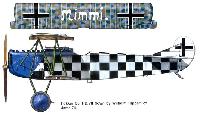 |
Сайт - Pilots-and-planes /WWW/
|
| Fokker built D.VII flown by Wilhelm Hippert of Jasta 74.
|
 |
W.Green, G.Swanborough - The Complete Book of Fighters
|
| D VII of Ltn Veltejns, Jasta 15, summer 1918.
|
 |
J.Herris, J.Leckscheid - Fokker Aircraft of WWI. Vol.5: 1918 Designs Part 2: D.VII & E.V/D.VIII /Centennial Perspective/ (55)
|
| Fokker D.VIIF of Lt. Olivier Freiherr von Beaulieu-Marconnay, Jasta 19, JG II, who scored 25 victories and was nominated for the Pour le Merite.
|
 |
J.Herris, J.Leckscheid - Fokker Aircraft of WWI. Vol.5: 1918 Designs Part 2: D.VII & E.V/D.VIII /Centennial Perspective/ (55)
|
| Fokker D.VII(O.A.W.) of Lt. Franz Buchner, Staffelfuhrer of Jasta 13, JG II, September - November 1918.
|
 |
J.Herris, J.Leckscheid - Fokker Aircraft of WWI. Vol.5: 1918 Designs Part 2: D.VII & E.V/D.VIII /Centennial Perspective/ (55)
|
| Fokker D.VII (Alb) of Lt. Carl Degelow, Staffelfuhrer of Jasta 40. Degelow scored 30 victories and was awarded the Pour le Merite.
|
 |
J.Herris, J.Leckscheid - Fokker Aircraft of WWI. Vol.5: 1918 Designs Part 2: D.VII & E.V/D.VIII /Centennial Perspective/ (55)
|
| Fokker D.VII (OAW) in the unit colors of Jasta 18 (vermillion red forward fuselage and white rear fuselage). The additional personal markings of the black skull and crossbones and black framed fuselage are of eight victory ace Ltn. Kurt Monnington. Monnington scored 8 victories.
|
 |
Сайт - Pilots-and-planes /WWW/
|
| A Fokker built D.VII flown by the Polizerflieger (Air Police) Staffeln at Paderhorn during the early 1920s.
|
 |
Сайт - Pilots-and-planes /WWW/
|
| Fokker D.VII
|
 |
Сайт - Pilots-and-planes /WWW/
|
| Ear y Fokker D.VII belonging to Oblt Karl Bolle of JG 2. Bolle finished the war with 36 victories.
|
 |
В.Обухович, А.Никифоров - Самолеты Первой Мировой войны
|
| Фоккер D VII
|
 |
E.Hauke, W.Schroeder, B.Totschinger - Die Flugzeuge der k.u.k. Luftfahrtruppe und Seeflieger 1914-1918
|
| Fokker D.VII
|
 |
C.Owers - Fokker Aircraft of WWI. Vol.7: Postwar /Centennial Perspective/ (67)
|
| Fokker D.VII 38.67, Czech Air Service, September 1921, Racing '16' applied for the First Air Meeting.
|
 |
C.Owers - Fokker Aircraft of WWI. Vol.7: Postwar /Centennial Perspective/ (67)
|
| Belgian D.VII bearing the thistle insignia of the 9th Escadrille.
|
 |
W.Green, G.Swanborough - The Complete Book of Fighters
|
| A D VII of the Belgian Aviation Militaire, Bruxelles-Evere, July 1919.
|
 |
C.Owers - Fokker Aircraft of WWI. Vol.7: Postwar /Centennial Perspective/ (67)
|
| Belgian D.VII bearing the penguin insignia of the Wevelgem pilot's school.
|
 |
C.Owers - Fokker Aircraft of WWI. Vol.7: Postwar /Centennial Perspective/ (67)
|
| Belgian D.VII bearing the Comet insignia of the 10th Escadrille.
|
 |
C.Owers - Fokker Aircraft of WWI. Vol.7: Postwar /Centennial Perspective/ (67)
|
| Fokker D.VIIF 937 (ex-7716/18) after being flown to Sweden by ex-JG I leader Herman Goring. It was purchased and repainted in Swedish Air Service markings and used as a trainer. 1920.
|
 |
C.Owers - Fokker Aircraft of WWI. Vol.7: Postwar /Centennial Perspective/ (67)
|
| Fokker D.VIIF 7716/18 Flown to Sweden by Hermann Goring
|
 |
C.Owers - Fokker Aircraft of WWI. Vol.7: Postwar /Centennial Perspective/ (67)
|
| Fokker D.VII (OAW) sent to Canada postwar and flown by Major William G. Barker VC in the Toronto to New York air race of 1919. 50 was the roughly painted number he was assigned for the race.
|
 |
C.Owers - Fokker Aircraft of WWI. Vol.7: Postwar /Centennial Perspective/ (67)
|
| Danish D.VII
|
 |
C.Owers - Fokker Aircraft of WWI. Vol.7: Postwar /Centennial Perspective/ (67)
|
| Finnish D.VII (OAW) 8545/18 '1C357'
|
 |
C.Owers - Fokker Aircraft of WWI. Vol.7: Postwar /Centennial Perspective/ (67)
|
| Latvian D.VII (OAW) '4' (ex-8595/18)
|
 |
C.Owers - Fokker Aircraft of WWI. Vol.7: Postwar /Centennial Perspective/ (67)
|
| French D.VII (OAW) 6557/18
|
 |
C.Owers - Fokker Aircraft of WWI. Vol.7: Postwar /Centennial Perspective/ (67)
|
| Netherlands D.VII LVA No. 251 with early form of national insignia.
|
 |
C.Owers - Fokker Aircraft of WWI. Vol.7: Postwar /Centennial Perspective/ (67)
|
| Fokker D.VII 265 of Netherlands LVA
|
 |
C.Owers - Fokker Aircraft of WWI. Vol.7: Postwar /Centennial Perspective/ (67)
|
| Fokker D.VII F-302 of Netherlands KNIL.
|
 |
C.Owers - Fokker Aircraft of WWI. Vol.7: Postwar /Centennial Perspective/ (67)
|
| Fokker D.VII (O.A.W.) 22.04 (ex-8588/18), 2/Lt. Antoni Bartkowiak, 15 Eskadra Mysliwska, Lewandowka Aerodrome, Autumn 1920
|
 |
C.Owers - Fokker Aircraft of WWI. Vol.7: Postwar /Centennial Perspective/ (67)
|
| Fokker D.VII (OAW) CWL No. 22.05 “Memento Mori" belonging to the 13th Fighter Squadron (13.EM). At that time, the planes of this squadron had personal emblems painted on the aircraft sides. The aeroplane was in original finish from the OAW factory.
|
 |
C.Owers - Fokker Aircraft of WWI. Vol.7: Postwar /Centennial Perspective/ (67)
|
| Fokker D.VII 502/18 flown by Lt Wojciech Bialy, 15 Eskadra Mysliwska, Lewandowka Aerodrome, August 1920
|
 |
C.Owers - Fokker Aircraft of WWI. Vol.7: Postwar /Centennial Perspective/ (67)
|
| Fokker D.VII (SLL No. 503/18) "Bi-Ba-Bo", belonged to pilot Lt. Jozef Hendricks, 15. Fighter Squadron (15.EM), August 1920. The “Bi-Ba-Bo" cupie doll was designed specifically by Mundek Dumnicki student and graduate of the Krakow Academy of Fine Arts for instructor Adam Haber-Wtyhski pilot of the school in Lawica before the plane was sent to 15.EM at the front.
|
 |
C.Owers - Fokker Aircraft of WWI. Vol.7: Postwar /Centennial Perspective/ (67)
|
| Fokker D.VIIF 5768/18 Polish Air Service
|
 |
P.Grosz, G.Haddow, P.Shiemer - Austro-Hungarian Army Aircraft of World War One /Flying Machines/
|
| Fokker D.VII(MAG) 93.07
|
 |
C.Owers - Fokker Aircraft of WWI. Vol.7: Postwar /Centennial Perspective/ (67)
|
| Fokker D.VII 93.08, 8th Squadron, Red Hungarian Air Service Matyasfold aerodrome, April 1919
|
 |
C.Owers - Fokker Aircraft of WWI. Vol.7: Postwar /Centennial Perspective/ (67)
|
| Fokker D.VII Nr.5, Lithuanian Air Service, 1927
|
 |
C.Owers - Fokker Aircraft of WWI. Vol.7: Postwar /Centennial Perspective/ (67)
|
| Soviet D.VII
|
 |
C.Owers - Fokker Aircraft of WWI. Vol.7: Postwar /Centennial Perspective/ (67)
|
| Fokker D.VII(OAW) 2113/18 USAS, Post Field, Oklahoma, circa 1920
|
 |
C.Owers - Fokker Aircraft of WWI. Vol.7: Postwar /Centennial Perspective/ (67)
|
Modified Fokker D.VII used for testing by the Packard Motor Company to test performance of the Packard V-12 Aero engines.
Fokker D.VII AS94034, USAS, McCook Field, 1923
|
 |
J.Herris - Fokker Aircraft of WWI. Vol.1: Spinne - M.10 & Watercraft /Centennial Perspective/ (51)
|
| Fokker D.VII replica at the National Museum of the USAF; the aircraft is painted in colors of Lt. Rudolf Stark, commander of Jasta 35,11-victory ace, and author of Wings of War, a noted memoir of wartime flying. The Fokker D.VII was Fokker's masterpiece. Most D.VII fighters used the 170 hp Mercedes D.IIIa engine; those powered by the over-compressed 185 hp BMW.IIIa were probably the best fighters to see combat during the Great War. The D.VII vindicated Fokker.
|
 |
J.Herris, J.Leckscheid - Fokker Aircraft of WWI. Vol.5: 1918 Designs Part 2: D.VII & E.V/D.VIII /Centennial Perspective/ (55)
|
| Reproduction Fokker D.VII displayed in authentic camouflage and markings at the USAF Museum.This D.VII is in the colors of Lt. Rudolf Stark, Jastafuhrer of Jasta 35b ('b' indicating a Bavarian unit), 11 victory-ace, and author of the postwar book Wings of War.
|
 |
J.Herris - Development of German Warplanes in WWI /Centennial Perspective/ (1)
|
|
|
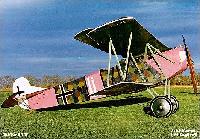 |
Сайт - Pilots-and-planes /WWW/
|
|
|
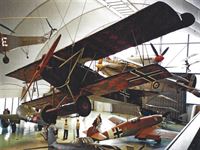 |
C.Owers - Fokker Aircraft of WWI. Vol.7: Postwar /Centennial Perspective/ (67)
|
| The fully restored D.VII in the RAF Museum's facility at Hendon in 2012.
|
 |
J.Herris - Fokker Aircraft of WWI. Vol.1: Spinne - M.10 & Watercraft /Centennial Perspective/ (51)
|
| Fokker D.VII "U.10" surrendered to pilots Sewall, Curtis, and McLanahan of the 95th Aero Squadron when it landed on their airfield a few days before the war ended. It has been restored to its original colors and is on display at the NASM.
|
 |
C.Owers - Fokker Aircraft of WWI. Vol.7: Postwar /Centennial Perspective/ (67)
|
| The "Knowlton Fokker" D.VII in its museum in Canada. This is one of the most authentic original Fokker D.VII fighters in existence and shows one variation of the original printed camouflage fabric applied to the D.VII (with some patches).
|
 |
C.Owers - Fokker Aircraft of WWI. Vol.7: Postwar /Centennial Perspective/ (67)
|
| Fokker D.VII(Alb) 6810/18 preserved in its original finish at Knowlton.
|
 |
C.Owers - Fokker Aircraft of WWI. Vol.7: Postwar /Centennial Perspective/ (67)
|
|
|
 |
C.Owers - Fokker Aircraft of WWI. Vol.7: Postwar /Centennial Perspective/ (67)
|
| Fokker D.VII(Alb) 6810/18 preserved in its original finish at Knowlton.
|
 |
C.Owers - Fokker Aircraft of WWI. Vol.7: Postwar /Centennial Perspective/ (67)
|
|
|
 |
C.Owers - Fokker Aircraft of WWI. Vol.7: Postwar /Centennial Perspective/ (67)
|
| Top: Completed aircraft on display. Bottom: Aircraft during restoration.
|
 |
C.Owers - Fokker Aircraft of WWI. Vol.7: Postwar /Centennial Perspective/ (67)
|
| The Museum's facility at Flugwerft Schleissheim in Oberschleissheim, now houses the D.VII. It is seen on display in 2016 with a reproduction Otto pusher.
|
 |
J.Herris - Development of German Warplanes in WWI /Centennial Perspective/ (1)
|
| This D.VII replica is seen here painted in Jasta 6 markings. This D.VII was one of three reproductions built for the film, The Blue Max. Purchased by Javier Arango, it was re-sold to The Vintage Aviator, Ltd. in New Zealand and was reworked. It now is a frequent flier at airshows along with both Pfalz D.III replicas from the same film.
|
 |
J.Herris - Development of German Warplanes in WWI /Centennial Perspective/ (1)
|
| The greatest result of the Fighter Competitions was the iconic Fokker D.VII, widely regarded as the best WWI fighter. Here a beautiful replica in a representative color scheme is shown in its element.
|
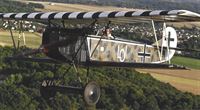 |
C.Owers - Fokker Aircraft of WWI. Vol.7: Postwar /Centennial Perspective/ (67)
|
| Replica Fokker D.VII in the colors of one of Ernst Udet's aircraft.
|
 |
J.Herris - Development of German Warplanes in WWI /Centennial Perspective/ (1)
|
|
|
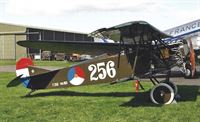 |
C.Owers - Fokker Aircraft of WWI. Vol.7: Postwar /Centennial Perspective/ (67)
|
| The restored ex-Mantz Fokker D.VII that is now displayed at the Nationale Militaire Museum in the Netherlands.
|
 |
W.Green, G.Swanborough - The Complete Book of Fighters
|
| A restored Albatros-built D VII in early Luchtvaartafdeling markings and originally one of 142 shipped to the USA in 1919.
|
 |
C.Owers - Fokker Aircraft of WWI. Vol.7: Postwar /Centennial Perspective/ (67)
|
| The restoration of LVA Fokker D.VII No. 266: This Fokker D.VII has been variously known as (Alb) 2528/18 (w/n 504); '7745/18'; N4729V and N6268. It is now resplendent in the colours of the LVA D.VII No. 266 The history of this particular machine is covered in the USA section, however, as it now resides in the Nationaal Militair Museum as a LVA machine, the restoration photographs are presented here.
|
 |
C.Owers - Fokker Aircraft of WWI. Vol.7: Postwar /Centennial Perspective/ (67)
|
|
|
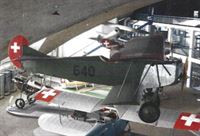 |
C.Owers - Fokker Aircraft of WWI. Vol.7: Postwar /Centennial Perspective/ (67)
|
| A Fokker D.VII tubular steel fuselage and tailplane survived for many years suspended in the vaulted hall at the Dubendorf military airfield. This was one of the D.VII fighters constructed by Alfred Comte. Reconstructed with new wings, etc., the restored aircraft is displayed in the Flieger Flab Museum, Dubendorf, bearing the false serial No. 640.
|
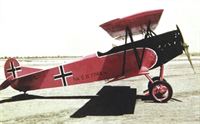 |
C.Owers - Fokker Aircraft of WWI. Vol.7: Postwar /Centennial Perspective/ (67)
|
| Mantz's original D.VII (NX-3764) with 220-hp Hispano-Suiza engine bore this colour scheme for a number of years.
|
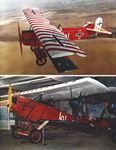 |
C.Owers - Fokker Aircraft of WWI. Vol.7: Postwar /Centennial Perspective/ (67)
|
| This was the last scheme that the aircraft wore before going to the Netherlands - a tribute to Ernst Udet.
|
 |
J.Herris, J.Leckscheid - Fokker Aircraft of WWI. Vol.5: 1918 Designs Part 1: Prototypes & D.VI /Centennial Perspective/ (55)
|
| The Fokker V11, works number 1883, participated in the First Fighter Competition powered by a 160 hp Mercedes D.III engine. It is seen here in its original form with short fuselage and no fixed fin, clear indication of its Triplane heritage. (Peter M. Grosz Collection/STDB)
|
 |
J.Herris, J.Leckscheid - Fokker Aircraft of WWI. Vol.5: 1918 Designs Part 1: Prototypes & D.VI /Centennial Perspective/ (55)
|
| Fokker V11 in its original form. There was no central cut-out in the wing trailing edge, and the balance portions of the elevators had straight-edged tips. The short fuselage without fixed fin made the aircraft directionally unstable and challenging to fly; it was certainly not suitable for operational use.
|
 |
J.Herris, J.Leckscheid - Fokker Aircraft of WWI. Vol.5: 1918 Designs Part 1: Prototypes & D.VI /Centennial Perspective/ (55)
|
| Fokker V11 in its original form. There is slight dihedral on the upper wing and the undercarriage axle does not have an airfoil. The nose radiator was simple and effective. The wing design was excellent both structurally and aerodynamically, being strong, relatively simple, and offering exceptional stall characteristics, (Peter M. Grosz Collection/STDB)
|
 |
J.Herris, J.Leckscheid - Fokker Aircraft of WWI. Vol.5: 1918 Designs Part 1: Prototypes & D.VI /Centennial Perspective/ (55)
|
The Fokker V11, work number 1883, in revised form with longer fuselage that imparted greater stability. (Peter M. Grosz Collection/STDB)
The modified V.11 with revised ailerons and new tail unit. The upper wing has been moved aft, necessitating a small cut-out in the trailing edge to improve the pilot’s upward view.
|
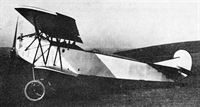 |
A.Weyl - Fokker: The Creative Years /Putnam/
|
| This aircraft is believed to be the second Fokker V.11, modified to production standard. It had a large exhaust manifold carrying the exhaust gases to a level above the upper wing.
|
 |
J.Herris, J.Leckscheid - Fokker Aircraft of WWI. Vol.5: 1918 Designs Part 1: Prototypes & D.VI /Centennial Perspective/ (55)
|
| The Fokker V18 was based on the same formula as the V11 but had larger vertical tail surfaces for improved stability.
|
 |
J.Herris, J.Leckscheid - Fokker Aircraft of WWI. Vol.5: 1918 Designs Part 1: Prototypes & D.VI /Centennial Perspective/ (55)
|
| In this front view, V18 closely resembled its sister aircraft V11. The light-colored tip of the lower left wing indicates this photo, as well as the other frontal view, were taken after the damage suffered on 25 January had been repaired.
|
 |
J.Herris, J.Leckscheid - Fokker Aircraft of WWI. Vol.5: 1918 Designs Part 1: Prototypes & D.VI /Centennial Perspective/ (55)
|
| The Fokker V18 was based on the same formula as the V11 but had larger vertical tail surfaces for improved stability.
|
 |
J.Herris, J.Leckscheid - Fokker Aircraft of WWI. Vol.5: 1918 Designs Part 1: Prototypes & D.VI /Centennial Perspective/ (55)
|
| Fokker V18, works number 2116, at the First Fighter Competition at Adlershof in late January/early February 1918. The curved leading edge of the horizontal tailplane is in evidence. This was of a very similar shape to that seen on the Fokker F.I Triplanes. The somewhat ungainly tail fin appears to have been retro-fitted, and its shape loosely resembles a similar component seen on the earlier Fokker D.IV. Also apparent in this view is the comparatively large cut-out to the upper wing centre-section.
|
 |
A.Weyl - Fokker: The Creative Years /Putnam/
|
| The Fokker V.18.
|
 |
J.Herris, J.Leckscheid - Fokker Aircraft of WWI. Vol.5: 1918 Designs Part 1: Prototypes & D.VI /Centennial Perspective/ (55)
|
| Closeup of the exhaust side of Fokker V18 showing noticeable stains on the rear cabane strut. Of interest is the cut in leading edge of the metal side panel which enabled swivelling the component back into place after engine maintenance.
|
 |
J.Herris, J.Leckscheid - Fokker Aircraft of WWI. Vol.5: 1918 Designs Part 1: Prototypes & D.VI /Centennial Perspective/ (55)
|
| The Fokker V21 was the production prototype of the Fokker D.VII.
|
 |
J.Herris, J.Leckscheid - Fokker Aircraft of WWI. Vol.5: 1918 Designs Part 1: Prototypes & D.VI /Centennial Perspective/ (55)
|
| The Fokker V21 was a variant of the Fokker D.VII. Old-style national insignia were applied.
|
 |
J.Herris, J.Leckscheid - Fokker Aircraft of WWI. Vol.5: 1918 Designs Part 1: Prototypes & D.VI /Centennial Perspective/ (55)
|
| The lack of a top wing cut out would indicate that this is possibly a V.11 or V.18 that has been revised to D.VII standards. The Maltese crosses also signal its early age in D.VII production.
|
 |
J.Herris, J.Leckscheid - Fokker Aircraft of WWI. Vol.5: 1918 Designs Part 1: Prototypes & D.VI /Centennial Perspective/ (55)
|
| Front view of the Fokker V21 was essentially identical the production Fokker D.VII except for the national insignia.
|
 |
J.Herris, J.Leckscheid - Fokker Aircraft of WWI. Vol.5: 1918 Designs Part 1: Prototypes & D.VI /Centennial Perspective/ (55)
|
Fokker V 22, Vorläufer für D.VII. Nr. 2342 (MAG 90.05). mit vierblättrigem Jaray-Propeller
Fokker V 22, предшественник D.VII. № 2342 (MAG 90.05). с четырехлопастным винтом Jaray
The V22 was a D.VII prototype with 200 hp Austro-Daimler engine and 4-bladed Jaray propeller. In an attempt to improve propeller efficiency, the blades were oriented at 70°/110° instead of the much more common 90°. The extra power of the 200 hp Austro-Daimler engine gave it much improved performance compared to the V21. It is shown here at Schwerin before shipment to Austria where it was designated 90.05.
|
 |
J.Herris, J.Leckscheid - Fokker Aircraft of WWI. Vol.5: 1918 Designs Part 1: Prototypes & D.VI /Centennial Perspective/ (55)
|
Fokker V 22 at Schwerin in March 1918. It was powered by a 200 hp Daimler engine and armed with two synchronized Schwarzlose M16 machine guns. In all other respects the airframe was similar to the Fokker D. VII.
The V22 was a D.VII prototype with 200 hp Austro-Daimler engine and 4-bladed Jaray propeller for evaluation by the Austro-Hungarian Fliegerarsenal. The extra power of the 200 hp Austro-Daimler engine gave it significantly improved performance compared to the V21. The Austrian authorities were concerned about the lack of steel tube, but after Germany agreed to supply sufficient steel tube for production - and Lt. Mallinkrodt's demonstration of the aircraft to the LFT chief - the aircraft was chosen for Austro-Hungarian production. The all-wood Pfalz D.XII was also considered for production because Austria had plentiful supplies of wood, but the Fokker had better flying qualities.
|
 |
J.Herris, J.Leckscheid - Fokker Aircraft of WWI. Vol.5: 1918 Designs Part 1: Prototypes & D.VI /Centennial Perspective/ (55)
|
| Close-up of the Fokker V 22 showing how the Austro-Daimler engine was enclosed by a smooth, close-fitting cowling, typical of the early Fokker D.VII aircraft. The four-bladed propeller was constructed and shipped in two pieces, then bolted together on the propeller shaft.
|
 |
J.Herris, J.Leckscheid - Fokker Aircraft of WWI. Vol.5: 1918 Designs Part 1: Prototypes & D.VI /Centennial Perspective/ (55)
|
| Closeup of V22 tail assembly; Fokker D.VII 241/18 is in the background.
|
 |
J.Herris, J.Leckscheid - Fokker Aircraft of WWI. Vol.5: 1918 Designs Part 1: Prototypes & D.VI /Centennial Perspective/ (55)
|
Tony Fokker wiping his hands after demonstrating the V 22 at Matyasfold in May 1918. A two-bladed propeller has been fitted and the standard Fokker streaked camouflage applied. In the background is the Fokker 90.03 (V7) and the Aviatik D.I(MAG) 92.14.
V22 was camouflaged before it was sent to MAG factory and designated 90.05. In this photo it has Fokker 2-bladed propeller. Fokker triplane prototype 90.03 is in the left background. (Peter M. Grosz collection/STDB)
|
 |
J.Herris - Fokker Aircraft of WWI. Vol.6: Foreign Service /Centennial Perspective/ (56)
|
Fokker-Maschinen am MAG-Flugfeld, Fokker V 7 und Fokker V 22, im Fluge Fokker V 12
Fokker Triplane MAG 90.03 with 150 hp Steyr at center and MAG 90.05 at right.
Now designated 90.05, V22 it at right. In this photo it has Fokker 2-bladed propeller. Fokker triplane prototype 90.03 is at left.
|
 |
J.Herris - Fokker Aircraft of WWI. Vol.6: Foreign Service /Centennial Perspective/ (56)
|
MAG 90.05 flys in to land; MAG 90.03 is at right. (Peter M. Grosz collection/STDB)
Im Fluge Fokker V 22, am Boden Dreidecker 90.03, Aviatik-Berg D.I 92.14, Aviatik-Berg C.I-Baureihe 91, Ufag C.I-Flugzeug 161.01
|
 |
A.Weyl - Fokker: The Creative Years /Putnam/
|
| Fok. D.VII with 210-h.p. Austro-Daimler engine, photographed at Schwerin.
|
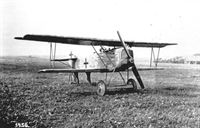 |
J.Herris, J.Leckscheid - Fokker Aircraft of WWI. Vol.5: 1918 Designs Part 1: Prototypes & D.VI /Centennial Perspective/ (55)
|
| V22-II with wooden fuselage & 200 hp Austro-Daimler. (Peter M. Grosz Collection/STDB)
|
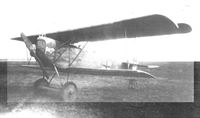 |
P.Grosz, G.Haddow, P.Shiemer - Austro-Hungarian Army Aircraft of World War One /Flying Machines/
|
| The second Fokker D.VII with wooden, plywood-covered fuselage photographed at the Lubeck-Travemunde factory prior to delivery on 27 August 1918.
|
 |
J.Herris, J.Leckscheid - Fokker Aircraft of WWI. Vol.5: 1918 Designs Part 1: Prototypes & D.VI /Centennial Perspective/ (55)
|
| V22-II with wooden fuselage & 200 hp Austro-Daimler. (Peter M. Grosz Collection/STDB)
|
 |
J.Herris, J.Leckscheid - Fokker Aircraft of WWI. Vol.5: 1918 Designs Part 1: Prototypes & D.VI /Centennial Perspective/ (55)
|
| V22-II with wooden fuselage & 200 hp Austro-Daimler. (Peter M. Grosz Collection/STDB)
|
 |
J.Herris, J.Leckscheid - Fokker Aircraft of WWI. Vol.5: 1918 Designs Part 1: Prototypes & D.VI /Centennial Perspective/ (55)
|
| V22 machine gun installation.
|
 |
J.Herris, J.Leckscheid - Fokker Aircraft of WWI. Vol.5: 1918 Designs Part 1: Prototypes & D.VI /Centennial Perspective/ (55)
|
| The Fokker V24 was a variant of the Fokker D.VII powered by the over-compressed 200 hp Benz Bz.IVu engine. Although offering more power, the engine was also significantly heavier, and the 185 hp BMW IIIa engine provided both better maneuverability and better performance due to its lighter weight.
|
 |
J.Herris, J.Leckscheid - Fokker Aircraft of WWI. Vol.5: 1918 Designs Part 1: Prototypes & D.VI /Centennial Perspective/ (55)
|
| Front and rear quarter views of the Fokker V24 at Schwerin before application of national insignia. Powered by the over-compressed 200 hp Benz Bz.IVu engine, it looks like a standard D.VII with more robust cowling.
|
 |
J.Herris, J.Leckscheid - Fokker Aircraft of WWI. Vol.5: 1918 Designs Part 1: Prototypes & D.VI /Centennial Perspective/ (55)
|
| Front and rear quarter views of the Fokker V24 at Adlershof after application of national insignia. The additional weight negated potential performance gains from the additional power.
|
 |
J.Herris, J.Leckscheid - Fokker Aircraft of WWI. Vol.5: 1918 Designs Part 1: Prototypes & D.VI /Centennial Perspective/ (55)
|
| The Fokker V24 powered by the over-compressed 200 hp Benz Bz.IVu engine at Adlershof. The standard D.VII powered by the 185 hp BMW IIIa was lighter and offered better performance and maneuverability.
|
 |
J.Herris, J.Leckscheid - Fokker Aircraft of WWI. Vol.5: 1918 Designs Part 1: Prototypes & D.VI /Centennial Perspective/ (55)
|
| Closeup view of the radiator of the Fokker V24.
|
 |
J.Herris, J.Leckscheid - Fokker Aircraft of WWI. Vol.5: 1918 Designs Part 1: Prototypes & D.VI /Centennial Perspective/ (55)
|
| Benz Bz IVau engine in a test rig.
|
 |
J.Herris, J.Leckscheid - Fokker Aircraft of WWI. Vol.5: 1918 Designs Part 1: Prototypes & D.VI /Centennial Perspective/ (55)
|
| The Benz Bz.IV engine in the NMUSAF. (NMUSAF)
|
 |
J.Herris, J.Leckscheid - Fokker Aircraft of WWI. Vol.5: 1918 Designs Part 2: D.VII & E.V/D.VIII /Centennial Perspective/ (55)
|
| On the left side of the forward “oval” side panel, only a single rectangular service door was provided on the initial production aircraft. A small triangular access hatch, barely visible here, was installed on the upper part of the forward fabric covering of the fuselage sides. No machine gun blast tubes were fitted to this aircraft, at least when this photo was taken. These can be seen in the other photos above the engines.
|
 |
J.Herris, J.Leckscheid - Fokker Aircraft of WWI. Vol.5: 1918 Designs Part 2: D.VII & E.V/D.VIII /Centennial Perspective/ (55)
|
| Jasta 10 was most likely the first recipient of the D.VII, and it is only fitting that the earliest and lowest-numbered production D.VII known to reach the front became the plane of the Staffel commander, Lt. Erich Loewenhardt. He is seen here with his D.VII 232/18 during a visit to Jasta 19 along with fellow Jasta 10 pilot Lt. "Fritz" Friedrichs. No doubt the official reason for this was to introduce neighboring units to the new Fokker, which was actually sometimes confused with the S.E.5a. Besides the leaders streamers, only the yellow nose marking of Jasta 10 appear to have been applied to Loewenhardt's fighter, although it is possible that the rear fuselage decking and horizontal tailplane could have been yellow, too. However, no photographs showing this part of the plane clearly are available at this point, so this detail remains speculative and is based on a photo of his earlier Fokker Triplane. Detailed information about the pilot and his aeroplanes can be found in "Blue Max Airmen Volume 17".
|
 |
J.Herris, J.Leckscheid - Fokker Aircraft of WWI. Vol.5: 1918 Designs Part 2: D.VII & E.V/D.VIII /Centennial Perspective/ (55)
|
| Seen here after arrival at the Armee-Flug-Park in the Area of the 2nd German Army, D.VII 244/18 was another example destined for Jasta 10. The Fokker works number 2329 can be read on the central "N" strut, and the military number "244" has been chalked onto the forward fuselage fabric near the wing root. Details of the Mercedes engine show well in this view. (Greg VanWyngarden)
|
 |
J.Herris, J.Leckscheid - Fokker Aircraft of WWI. Vol.5: 1918 Designs Part 2: D.VII & E.V/D.VIII /Centennial Perspective/ (55)
|
Some of the very first Fokker-built D.VIIs carried an odd-looking hybrid version of the "Iron Cross" and "Bar Cross" national marking, which was basically an Iron Cross with straight cross arms. Most likely, this was the result of a misinterpretation of Idflieg order 41390, which regulated a new style of national marking. According to this, a straight-lined Iron Cross was to be applied in the usual positions, rather than the previous ones with curved cross arms. One can only assume that the painters at Schwerin received this order without an accompanying illustration of the new cross style, and followed the text of the order in a literal manner.
On these early planes, the bottom of the rudder was also painted in the streaked scheme of the fuselage, and the streaked camouflage applied to the fin extended up to the forward tip of the rudder. The tail cross was then centered on the white background.
|
 |
J.Herris, J.Leckscheid - Fokker Aircraft of WWI. Vol.5: 1918 Designs Part 2: D.VII & E.V/D.VIII /Centennial Perspective/ (55)
|
| On very early D.VIIs, the forward part of the tail fin, up to the edge of the rudder, and the rudder area below the horizontal tail surfaces were also painted in the streaked scheme. On the fuselage, somewhat oddly-shaped Iron Crosses with straight cross arms are present. These may have been a result of a misinterpretation of a directive issued in March 1918 which required a change from the Iron Cross national marking to the Balkenkreuz format. The wing crosses are still the usual Iron Crosses with white outline. (Greg VanWyngarden)
|
 |
J.Herris, J.Leckscheid - Fokker Aircraft of WWI. Vol.5: 1918 Designs Part 2: D.VII & E.V/D.VIII /Centennial Perspective/ (55)
|
| Seen almost from the same perspective but almost four months later, 244/18 is seen here in the markings of Lt. Alois Heldmann. Jasta 10 upgraded to the BMW-powered D.VIIF in late July, so Heldmann's aircraft could be made available to Lt. Lothar von Richthofen when he unexpectedly returned to the Jagdgeschwader on 25 July 1918. He had recovered from a broken jaw, an injury received as a consequence of a crash in a Dr.I on 13 March 1918. (Peter M. Grosz Collection/STDB)
|
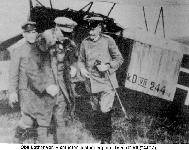 |
Сайт - Pilots-and-planes /WWW/
|
| Oblt Lothar von Richthofen is standing next to his D.VII (244/18).
|
 |
J.Herris, J.Leckscheid - Fokker Aircraft of WWI. Vol.5: 1918 Designs Part 2: D.VII & E.V/D.VIII /Centennial Perspective/ (55)
|
| Supposedly these photos were taken on 25 July 1918, after he had scored his 30th aerial victory, which also turned out to be 500th victory credited to JG I. However, this victory was scored at around 7:50 p.m., while the lighting conditions indicate that the photos were not taken around dusk. Also visible in two of these photos is Major Albrecht von Richthofen, his father. His presence suggests that Lothar's return to the front may not have been completely surprising as was reported at the time. (Peter M. Grosz Collection/STDB)
|
 |
J.Herris, J.Leckscheid - Fokker Aircraft of WWI. Vol.5: 1918 Designs Part 2: D.VII & E.V/D.VIII /Centennial Perspective/ (55)
|
| Another unit that received early examples of the D.VII was Royal Wurttemberg Jagdstaffel 28w, and pictured here is 247/18 at the unit's airfield at Iseghem. All crosses on this aircraft show signs of conversion from the Iron Cross to the thick form of the Balkenkreuz marking. The Jasta 28w unit marking of a yellow horizontal tail plane with a black bar centred on each side is visible in the upper photo.
|
 |
J.Herris, J.Leckscheid - Fokker Aircraft of WWI. Vol.3: Early Biplane Fighters /Centennial Perspective/ (53)
|
| About the first 150 D.VIIs produced by Fokker were delivered with fuselages that were painted in a streaked scheme that was similar to that of the Fokker Triplane. These streaks are usually portrayed in an olive green color. However, the upper relic photographed behind glass at the"Musee de l'Air" in Paris in July 2004 shows a second color: a dark "forest" green at left. This must have been the color that resulted in the dark streaks in photos. The olive green was probably a result of the yellowing of the clear dope applied to weatherproof the fabric. The dope yellowed within a few weeks, and light green pigments mixed into the dope would result in the "olive" green pictured.
|
 |
J.Herris, J.Leckscheid - Fokker Aircraft of WWI. Vol.5: 1918 Designs Part 2: D.VII & E.V/D.VIII /Centennial Perspective/ (55)
|
A new pilot pointing at his pilot’s badge, standing next to a very early Fokker D.VII with Maltese crosses changed over. The partially painted fin would indicate that this is a Fokker built machine.
Following his crash of Fokker D.VII 234/18 "Fritz" Friedrichs of Jasta 10 also flew two other D.VII's, 258/18 and 309/18. However, the poor quality of this photo does not provide enough details to identify with which of these two planes he is pictured here, along with two of his mechanics. He fell victim to one of several inflight fires that destroyed numerous Fokker D.VII's in mid-July 1918 due to self-ignition of the phosphorous ammunition. In Friedrich's case, the incident occurred on 15 July 1918 at around 8:45 p.m., while he was flying 309/18. His attempt to take to his parachute in order to escape the flames failed. (Peter M. Grosz Collection/STDB)
|
 |
J.Herris, J.Leckscheid - Fokker Aircraft of WWI. Vol.5: 1918 Designs Part 2: D.VII & E.V/D.VIII /Centennial Perspective/ (55)
|
Lt. Emil Thuy poses next to his personal Fokker D.VII 262/18 early in its frontline career. The aircraft was accepted at Schwerin on 11 April 1918, and in this photo the fuselage and wing crosses show signs of very careful conversion to the new "midstyle" Balkenkreuz with full white outline. The photo was taken at Iseghem airfield, where the unit was stationed until June 6, 1918. Its tempting to speculate that this photo was taken to commemorate his 20th victory on May 8, 1918. (Peter M. Grosz Collection/ STDB)
Lt Emil Thuy, as commander of Jasta 28 with his Fokker D VII, 262/18. Thuy had been given Jasta 28 after learning his craft with Jasta 21. A Pour Le Merite holder, Thuy survived the war with a confirmed 32 victories.
|
 |
J.Herris, J.Leckscheid - Fokker Aircraft of WWI. Vol.5: 1918 Designs Part 2: D.VII & E.V/D.VIII /Centennial Perspective/ (55)
|
| A later photo of the same aircraft, taken at Aniche airfield, where the unit was based between 17 August and 01 October 1918. The crosses are now converted to the "late-style" Balkenkreuz of 8:1 proportions, the order for which was issued on 04 June 1918. The white fuselage band has received a narrow dark border of unknown color, possibly red, and the rudder cross has been enlarged. The machine guns have received the addition of a telescopic gun sight and streamers are fitted to the rear interplane "N" strut. On 16 September 1918, Thuy scored his 30th victory, and he ended the war with a score of 35 confirmed aerial victories. (Peter M. Grosz Collection/ STDB)�
|
 |
J.Herris, J.Leckscheid - Fokker Aircraft of WWI. Vol.5: 1918 Designs Part 2: D.VII & E.V/D.VIII /Centennial Perspective/ (55)
|
| We have to thank the great pioneer of German WWI aviation Alex Imrie for bringing the wartime memories and photographs of Jasta 11 pilot Willi Gabriel to public attention. Gabriel joined Jasta 11 on 17 May 1918, just after the unit converted to the D.VII, coming from Schlachtstaffel 15. Here he proudly poses with his first D.VII, 286/18, which was initially marked with the unit's red nose and his personal markings of light blue and orange stripes. The markings of this plane underwent a bit of an evolution, a lengthwise orange stripe was later added to the fuselage sides. (Alex Imrie Collection)
|
 |
J.Herris, J.Leckscheid - Fokker Aircraft of WWI. Vol.5: 1918 Designs Part 2: D.VII & E.V/D.VIII /Centennial Perspective/ (55)
|
| Five Fokker D.VIIs from Jasta 11 are preparing for a mission at Beugneux airfield in June 1918. At left is 286/18, the personal plane of 11 victory ace Vfw. Willi Gabriel, who is in the process of putting on his flying kit by the left wingtip. By now he had a lengthwise orange stripe added to the fuselage. The third plane in the lineup appears to be that of Lt. Werner Steinhauser, who is known to have had red and golden-yellow stripes applied to the tails of his aircraft. He was credited with ten victories and is thought to be the first pilot of Jasta 11 to be killed while flying the D.VII, crashing fatally at around 8:00 a.m. on 26 June 1918. (Alex Imrie)
|
 |
J.Herris, J.Leckscheid - Fokker Aircraft of WWI. Vol.5: 1918 Designs Part 2: D.VII & E.V/D.VIII /Centennial Perspective/ (55)
|
| Thanks to the research of the much-missed historian Alex Imrie, Willi Gabriel's Fokker D.VII 286/18 was the first Jasta 11 D.VII to be documented in detail. Besides the red nose marking of Jasta 11, he had the tail section painted in light blue and orange stripes. When photographed, a lengthwise orange stripe had been added to the middle of the fuselage and the fuselage decking. Gabriel was credited with ten victories while flying with the Staffel between 19 May and 18 July. Soon after, a row with the new commander of Jagdgeschwader I, a certain Hermann Goring, over the confirmation of a victory claim, caused Gabriel to be transferred to AFP 2. He would not see frontline service again. (Alex Imrie)
|
 |
J.Herris, J.Leckscheid - Fokker Aircraft of WWI. Vol.5: 1918 Designs Part 2: D.VII & E.V/D.VIII /Centennial Perspective/ (55)
|
On the last 60-or so Fokker D.VIIs in the streaked fuselage scheme the military number was applied in white paint. 332/18 was one of these planes, and it was operated by Jasta "Boelcke". An usual detail applied to the D.VIIs operated by this Jasta was the fact that the streaked forward section of the tail fin of their Fokker-built aircraft was overpainted white. (Peter M. Grosz Collection/STDB)
|
 |
Сайт - Pilots-and-planes /WWW/
|
| 353/18, an early standard Fokker D.VII with a 160-hp Mercedes engine in the factory standard vertical Green streaked camouflage on the fuselage and 45 degree streaks on the horizontal top wing and tail surfaces.
|
 |
J.Herris, J.Leckscheid - Fokker Aircraft of WWI. Vol.5: 1918 Designs Part 2: D.VII & E.V/D.VIII /Centennial Perspective/ (55)
|
| Fokker D.VII 373/18 was the personal plane flown by Uffz. Heinrich Piel, who served with Jasta 13, which was a component unit of Jagdgeschwader II. The white military number is barely visible below the blue fuselage paint, which was the Geschwader color of JG II at the time. The aircraft was accepted at Schwerin on 11 May 1918. Photographs indicate that Piel flew two different D.VIIs carrying similar stork markings, but it is not known if he was killed on 29 June 1918 while flying 373/18 or the other D.VII. The two small cooling slots, seen on the engine side panel with their openings facing forward, were an innovation of a JG II Werkmeister. (Peter M. Grosz Collection/STDB)
|
 |
J.Herris, J.Leckscheid - Fokker Aircraft of WWI. Vol.5: 1918 Designs Part 2: D.VII & E.V/D.VIII /Centennial Perspective/ (55)
|
| A rare line-up of Jasta 11 BMW-powered D.VII fighters allows for a highly interesting insight into the application of military numbers on early Fokker-built aircraft. D.VII 377/18F (accepted on 15 May 1918), seen at left, is thought to have been the second-to-last aircraft carrying the white serials, and it still carries the streaked fuselage factory scheme, Right next to it, D.VII 325/18F (accepted on 04 May 1918) appears in a very similar factory scheme, and the application of the "F" behind the number was apparently limited to the planes up to D.VIIF 378/18. The third plane from left, D.VIIF 460/18 (accepted 06 June 1918), is known to have been the personal plane of Lt. Erich Just, and the "F" is now applied between "D.VII" and the military number, which was the usual style of application on all later BMW-powered machines. (Greg VanWyngarden)
|
 |
J.Herris, J.Leckscheid - Fokker Aircraft of WWI. Vol.5: 1918 Designs Part 2: D.VII & E.V/D.VIII /Centennial Perspective/ (55)
|
| Factory-fresh 379/18 was accepted at Schwerin on 10 May 1918 and had been set up to be photographed for posterity in a very careful manner. This was most likely the first D.VII to have the fuselage covered in the by then common polygon-dyed aviation fabric, in this case the four-color variation was applied. The military number has now again been applied in black, and it would continue to be applied to do in this way until production at Schwerin ceased. (Peter M. Grosz Collection/STDB)
|
 |
J.Herris, J.Leckscheid - Fokker Aircraft of WWI. Vol.5: 1918 Designs Part 2: D.VII & E.V/D.VIII /Centennial Perspective/ (55)
|
The misinterpretation of the previously mentioned order was quickly rectified, and the straight-armed "Balkenkreuz" began to appear. Also decreed by this order was that a white border measuring 15 centimeters was to be applied around the cross. Since the instructions were not very well formulated, a great deal of confusion was caused, and this resulted in the application of crosses that appeared rather "fat". Often, a far bigger white border was applied, and, from a distance, the black crosses would hardly be visible against this white background, this being especially true for the fuselage cross.
On Fokker-built aircraft, the forward part of the tail fin was left in four- or five-color aircraft fabric, only the rear part of the fin was painted white. On all Schwerin-built VIIs marked with the tail Balkenkreuz, this marking was applied in the position shown in the photo, very close to the rudder/tail fin hinge line.
The style of application of the military number is interesting, it reads "Fok.D VII 379/18." on this aircraft. Barely visible at the bottom of the rudder, hidden in the shadow cast by the horizontal tailplane, is the Fokker factory serial number 2466. The aircraft was accepted on 10 May 1918.
|
 |
J.Herris, J.Leckscheid - Fokker Aircraft of WWI. Vol.5: 1918 Designs Part 2: D.VII & E.V/D.VIII /Centennial Perspective/ (55)
|
| Lt. Gustav Fraedrich poses next to Mercedes-powered Fokker D.VII 383/18, which is the third aircraft seen in the line-up.
|
 |
J.Herris, J.Leckscheid - Fokker Aircraft of WWI. Vol.5: 1918 Designs Part 2: D.VII & E.V/D.VIII /Centennial Perspective/ (55)
|
| Ten Fokker-built D.VII's of Jasta 72s are lined up perfectly for the benefit of the photographer at Bergnicourt airfield in July 1918. Closest to the camera is D.VII 401/18 "M"(accepted 17 May), the Mercedes-powered aircraft flown by the unit commander and Pour le Merite ace Lt. Karl Menckhoff. At the time, Menckhoff also had BMW-powered D.VIIF 502/18 (accepted 19 June) at his disposal, this plane being marked in an almost identical way as 401/18. For some reason, it is now seen in this line-up shot. The fourth aircraft from the end of the line-up is D.VIIF 494/18 "F"(accepted on 17 June), which was the BMW-powered D.VII flown by Lt. Gustav Fraedrich. He would take command of the unit on 23 October 1918 and survived the war with a total of six confirmed victories.
|
 |
J.Herris, J.Leckscheid - Fokker Aircraft of WWI. Vol.5: 1918 Designs Part 2: D.VII & E.V/D.VIII /Centennial Perspective/ (55)
|
|
|
 |
J.Herris, J.Leckscheid - Fokker Aircraft of WWI. Vol.5: 1918 Designs Part 2: D.VII & E.V/D.VIII /Centennial Perspective/ (55)
|
| Fokker D.VII 402/18 is seen here at the local Armee-Flugpark before delivery to a Jagdstaffel. The aircraft was accepted on 21 May 1918, and it is covered in five-color dyed fabric. At the time, the thick white "Balkenkreuze" were applied at the factory to both the fuselage and wings. On the rear fuselage, below the tailplane, a chalked marking reading "X gut" is visible. This indicated that the aircraft had been checked and was ready to be picked up by a Jagdstaffel pilot. (Peter M. Grosz Collection/STDB)
|
 |
J.Herris, J.Leckscheid - Fokker Aircraft of WWI. Vol.5: 1918 Designs Part 2: D.VII & E.V/D.VIII /Centennial Perspective/ (55)
|
| The recipient of this aircraft was Vzfw. Max Holtzem, who flew with Jasta 16b. Holtzem added his personal marking of a comet to the fuselage sides, which symbolized "Good Hope" to him. The nose was painted Bavarian blue, barely visible in this view, and a white-black-white band was added to the tailplane, these two details being the unit markings. This was one of several D.VIIs which featured an "open" application of the fuselage military number, i.e. the gaps left by the stencil were not filled in with black paint. (Peter M. Grosz Collection/STDB)
|
 |
J.Herris, J.Leckscheid - Fokker Aircraft of WWI. Vol.5: 1918 Designs Part 2: D.VII & E.V/D.VIII /Centennial Perspective/ (55)
|
| Vfw. Max Holtzem is pictured here looping his Fokker D.VII 402/18 over the Jagdstaffel 18 airfield. Holtzem earned his flying license in 1913, served as a test pilot with the Pfalz company in 1915 and eventually joined Jasta 16b in September 1917. He was born in Elberfeld (now Wuppertal) in Prussia, but since his mother was born in Wurzburg, he could claim to be half-Bavarian, enough to join a Bavarian Staffel. While he was not credited with a single confirmed victory, he remained with the Staffel until the end of the war, no doubt due to being a highly skilled pilot. After the war, he became a test pilot for Fokker in America, often flying with Anthony Fokker himself in the 1920s. Holtzem passed away in 1980. (Peter M. Grosz Collection/STDB)
|
 |
J.Herris, J.Leckscheid - Fokker Aircraft of WWI. Vol.5: 1918 Designs Part 2: D.VII & E.V/D.VIII /Centennial Perspective/ (55)
|
One of the greatest services Manfred von Richthofen did for Germany was instigating the fighter competitions, and the Fokker D.VII was the greatest result of those competitions. Arriving at the front days after Richthofen's death in his Fokker Triplane, he was not able to fly the D.VII in combat himself. Initially using the 170 hp Mercedes D.IIIa engine, when fitted with the superb 185 hp BMW IIIa it was arguably the best all-around fighter of the war. Here D.VII 406/18, accepted on 18 May 1918, and other D.VIIs are shipped to the front by rail two days later, on Monday, 20 May. (Peter M. Grosz Collection/STDB)
Fok. D.VII aircraft on their way to the front on railway flat wagons, June 1918. The recess in the fuselage underside that accommodated the lower wing can be seen.
Disassembled for transportation, this train load of early Fokker built D.VIIs are being shipped from the Schwerin factory to the front. One of the requirements of the Idflieg was that an aircraft could be easily and quickly disassembled for transporting.
|
 |
J.Herris, J.Leckscheid - Fokker Aircraft of WWI. Vol.5: 1918 Designs Part 2: D.VII & E.V/D.VIII /Centennial Perspective/ (55)
|
| A mix-up of components can be seen on some D.VIIs, and the nose of D.VIIF 460/18 seen here is a good example. This was a late aircraft from the initial batch (227/18 - 526/18) featuring the same trio of louvres seen above on 507/18. The upper panel is an organ transplant donated by an aircraft from the 4250/18 - 4300/18 military numbers sequence. Originally, this aircraft also featured the “low” collector exhaust as seen above. The opening for this exhaust has been carefully faired over, the patch being just visible in the picture. A new exhaust of the “saxophone” design has been fitted as a replacement item, and the replaced upper panel may simply have been a leftover from an aircraft which had this item removed during the summer months and which been lost in combat.
|
 |
R.Kosin - The German Fighter since 1915 /Putnam/
|
| Fokker D.VII
|
 |
Сайт - Pilots-and-planes /WWW/
|
"Фоккер" D.VII №461/18 на испытаниях в Адлерсхофе.
A Fokker built D.VIIF in the lozenge type camouflaged fabric. The lozenge pattern was printed on the fabric after it was made and before it was applied to the airframe.
|
 |
J.Herris, J.Leckscheid - Fokker Aircraft of WWI. Vol.5: 1918 Designs Part 2: D.VII & E.V/D.VIII /Centennial Perspective/ (55)
|
| To commemorate special occasions, group photos were taken, and here pilots of Jagdstaffel 15 gather in front of Georg von Hantelmann's plane. He scored his 20th victory on 9 October 1918 at 4:15 p.m., and the lighting indicates that the photo was most likely taken on the next day. Very likely, the aircraft seen behind the men is D.VIIF 465/18, which was one of six BMW-powered D.VIIs delivered to Jasta 15 in July. Von Hantelmann was nominated for the Pour-le-Merite on 30 October but failed to receive the award due to the end of the war. Depending upon source, was credited with 25-26 confirmed and 4-5 unconfirmed victories, all of which were scored while flying D.VIIs.
|
 |
J.Herris, J.Leckscheid - Fokker Aircraft of WWI. Vol.5: 1918 Designs Part 2: D.VII & E.V/D.VIII /Centennial Perspective/ (55)
|
| Being born on 14 April 1883, Oblt. Carl Menckhoff was 35 years of age when these photos were taken in July 1918. He was given command of Jagdstaffel 72 when the unit was formed in early 1918, and was decorated with the Pour-le-Merite on 23 April 1918. The Jasta received the D.VII at an early stage, and Menckhoff had two at his disposal. By early July 1918 he was credited with 35 confirmed victories, and he then had the luxury of having two identically-marked fighters at his disposal: D.VII 401/18 and D.VIIF 502/18, seen behind him in both photos. Menckhoff was brought down on 25 July 1918 after his engine was disabled, and crashed into a tree. He was taken into captivity unharmed, with a total of 39 victories to his credit. Under his command, the Staffel was credited with 33 victories while only a single pilot was killed. (Dr. Hannes Tager)
|
 |
J.Herris, J.Leckscheid - Fokker Aircraft of WWI. Vol.5: 1918 Designs Part 2: D.VII & E.V/D.VIII /Centennial Perspective/ (55)
|
| Two views of D.VII 507/18 show the aircraft in partially-completed factory finish, the metal nose parts and the wheel covers lack paint at this stage. The machine guns also remain to be fitted, and the mix of crosses (fully outlined fuselage cross and wing crosses with 5:4 cross arm proportions) indicated that these components did not receive their national markings at the same time. This aircraft was accepted at Schwerin on 19 June 1918 and was powered by a Mercedes D.IIIa engine with the serial number 41747. (Peter M. Grosz Collection/STDB)
|
 |
J.Herris, J.Leckscheid - Fokker Aircraft of WWI. Vol.5: 1918 Designs Part 2: D.VII & E.V/D.VIII /Centennial Perspective/ (55)
|
| Although slower than many of its competitors, the Fokker V II prototype's easy handling and reluctance to spin endeared the aircraft to the trials pilots, unanimously adjudging it the overall winner of the first of the 1918 Alderhof fighter trials. As there was an urgent need for an initial 400 of these single seat fighters, a figure beyond Fokker's ability to meet on time, contracts were placed simultaneously with Fokker and Albatros, with AEG being drawn in later. Given the military designation Fokker D VII, the machine was powered initially by a 160hp Mercedes D III, this being soon replaced by the 185hp BMW IIIa. This latter engine pushed the top level speed up by 7mph, to 124mph at sea level and had an even more dramatic effect on the fighter's rate of climb, with the time to reach 3,280 feet dropping to 2.5 minutes from 3.8 minutes for the earlier Mercedes powered examples. Rapid as it was, with first operational deliveries being made in April 1917 to JG I, the Fokker DVII's passage into service appears to have been essentially trouble-free. Even more significantly, no subsequent fatal flaws, such as those experienced with Fokker's Dr I, were to emerge. At last Anthony Fokker and his chief designer, Reinhold Platz, had produced a real winner that would not only keep the factory full, but would soon come to earn the respect of the all the Allied pilots who encountered it. Armed with the standard twin 7.92mm Spandaus, over 800 examples of the D VII had been delivered to 48 operational Jastas by the start of September 1918. Showing off its well proportioned lines, Fokker D VII, 507/18, seen here, reportedly served with the famed Jasta Boelcke.
|
 |
J.Herris, J.Leckscheid - Fokker Aircraft of WWI. Vol.5: 1918 Designs Part 2: D.VII & E.V/D.VIII /Centennial Perspective/ (55)
|
The last 70-or-so examples of the first Fokker production batch received a trio of cooling louvres that were initially positioned relatively far up, as seen here on D.VII 507/18. Plastic kit manufacturers have constantly gotten this detail wrong, showing these openings in the later “low” position that was typical for the final production version. Note that the initial collector exhaust, which exited via an opening in the side panel, was actually slanted backwards. A small rectangular access hatch is positioned below the exhaust.
The rear of the chin panel was now deepened somewhat compared to the photo on the left. In the top two photos the metal nose sections were still unpainted when the photographs were taken. Before shipment to the front, these were painted dark green.
|
 |
J.Herris, J.Leckscheid - Fokker Aircraft of WWI. Vol.5: 1918 Designs Part 2: D.VII & E.V/D.VIII /Centennial Perspective/ (55)
|
Accepted on 19 June 1918. D.VII 507/18 exhibits a fuselage cross with the correct 15 centimeter border. However, this was outdated by then, since two new orders concerning the application of national crosses had been issued in the meantime. The first, dated 15 May, only concerned the wing crosses, which were now to be applied with 5:4 proportions, resulting in a marking resembling a grave cross. Likely it was this similarity let to the issue of the third - and final - order specifying the application of national markings on 4 June 1918. According to this, the crosses were now to be marked with cross arms of equal proportions, and this resulted in the slim "Balkenkreuz" marking known from the many late-war photos of German aircraft.
Both 379/18 and 507/18 were covered in four-color polygon fabric, but this type of fabric was not applied to all aircraft of the first Fokker D.VII batch (227/18-153/18). Several aircraft were covered in five-color dyed aviatipn fabric, and sometimes fuselages, wings and ailerons were covered in either of these colors.
|
 |
J.Herris, J.Leckscheid - Fokker Aircraft of WWI. Vol.5: 1918 Designs Part 2: D.VII & E.V/D.VIII /Centennial Perspective/ (55)
|
| The second Schwerin production batch was numbered 4250/18 to 4449/18, and pictured here is the most famous aircraft in this batch. Fokker D.VIIF 4253/18, accepted on 04 July, was the personal plane of Ernst Udet, the leader of Jagdstaffel 4, and it was photographed here when elements of Jagdgeschwader I landed at Epinoy airfield on 21 August 1918. The works number 2954 can be read on the bottom of the rudder.
|
 |
J.Herris, J.Leckscheid - Fokker Aircraft of WWI. Vol.5: 1918 Designs Part 2: D.VII & E.V/D.VIII /Centennial Perspective/ (55)
|
A right-side view of Ernst Udet's Fokker D.VIIF 4253/18 is pictured earlier in this book, and this photo of the plane, taken at FEA 2 in Furth in early October 1918, shows a view of the left side. Eagle-eyed readers will note that the "LO!" monogram was applied further aft on the left side, and the upper cowling panels had not been put back in place after the hot summer period had come to an end. The lower wing crosses remain in the factory-applied 5:4 proportions; nobody deemed it necessary to convert them to the equal proportions that were required for about three months. (Peter M. Grosz Collection/STDB)
Oblt Ernst Udet, seen here standing in front of his Fokker D VII 'Lo' was born on 26 April 1896 and was to become the last commander of Jasta 4, having previously served with Jastas 15, 37 and 11. At the time of the Armistice, Udet was a Pour Le Merite holder, with 62 confirmed victories, which makes him Germany's second highest scoring ace of the war after Baron Manfred von Richthofen. Udet remained prominent in post-war German aviation circles, particularly as an aerobatic pilot and lent his name to an aircraft manufacturer during the 1920s. Along with a number of other former prominent military fliers, Udet rejoined the Luftwaffe in 1935 with the rank of Generaloberst, the equivalent of a four-star general or Air Chief Marshal. Subsequently blamed for shortfalls in aircraft production, Udet took his own life on 17 November 1941.
|
 |
J.Herris, J.Leckscheid - Fokker Aircraft of WWI. Vol.5: 1918 Designs Part 2: D.VII & E.V/D.VIII /Centennial Perspective/ (55)
|
| The first fifty-or-so aircraft from the second production batch mounted upper engine cowlings that featured six to eight cooling louvres. These can be seen here on the two Jagdstaffel 10 aircraft at Metz-Frescaty in late September/early October 1918. The machine nearest to the camera is possibly D.VIIF 4264/18, which was the personal mount of Lt. Alois Heldmann.
|
 |
J.Herris, J.Leckscheid - Fokker Aircraft of WWI. Vol.5: 1918 Designs Part 2: D.VII & E.V/D.VIII /Centennial Perspective/ (55)
|
| Jagdstaffel 4 received BMW-powered Fokkers in September, and seen here is D.VIIF 4275/18 from this batch. While out of the photo, the upper nose cowling panels would have looked very similar to the ones seen in the photo above. This was one of several Jasta 4 D.VIIs marked with colored fuselage longerons, as well as a broad fuselage band. The forward part of the tail fin, which was covered in polygon fabric on Fokker-build machines, has been overpainted in white, with a thin stripe of an unknown light color acting as a division line. (Peter M. Grosz Collection/STDB)
|
 |
J.Herris, J.Leckscheid - Fokker Aircraft of WWI. Vol.5: 1918 Designs Part 2: D.VII & E.V/D.VIII /Centennial Perspective/ (55)
|
| Three days after the death of Jasta 10 commander Oblt. Erich Loewenhardt on 10 August 1918, Lt. Arthur Laumann, who had previously served with Jasta 66, took command of the unit. His personal plane at Jasta 10 became Fokker D.VIIF 4282/18, and he is seen in the cockpit of this plane in this photo, which was published as a "Sanke" card.The fuselage was covered in four-color fabric.
|
 |
J.Herris, J.Leckscheid - Fokker Aircraft of WWI. Vol.5: 1918 Designs Part 2: D.VII & E.V/D.VIII /Centennial Perspective/ (55)
|
| Hermann Goring liked to use white as his personal color on many of his planes, and on Fokker D.VIIF 4283/18 the rear fuselage was painted in this color. The forward fuselage and upper wing surfaces were painted red, in order to ensure easy recognition of the JG I commander in the air, even though he flew very few combat sorties from August 1918 until the end of the war. Again, the cooling louvres in the upper cowling part can be seen. This plane has previously been misidentified as D.VIIF 4253/18, and some writers have concluded that Udet and Goring shared this plane. This is wrong, however, as the Fokker works number 2984 can be clearly seen on the bottom of the rudder in the original print. (Alex Imrie)�
|
 |
J.Herris, J.Leckscheid - Fokker Aircraft of WWI. Vol.5: 1918 Designs Part 2: D.VII & E.V/D.VIII /Centennial Perspective/ (55)
|
| Names were fairly often applied to German fighter aircraft, and D.VII 4301/18 "OttO", seen here, flew with Jagdstaffel 71. This was a Mercedes-powered aircraft, accepted at the Schwerin factory on 15 July 1918, and reportedly was the personal mount of Vzfw. Otto Baurose, who served with the unit from 6 February to the end of the war. The photo was taken at Habsheim airfield. (Peter M. Grosz Collection/STDB)
|
 |
J.Herris, J.Leckscheid - Fokker Aircraft of WWI. Vol.5: 1918 Designs Part 2: D.VII & E.V/D.VIII /Centennial Perspective/ (55)
|
| Another unidentified Jasta 10 D.VIIF is seen here in American hands. This photo allows a better view at the cooling louvres described previously, but readers must be warned that the fuselage fabric with the small Balkenkreuz was not original. Apparently, some of the fuselage fabric was "souvenired" after capture and later replaced by the fabric seen in the photo. (Peter M. Grosz Collection/STDB)
|
 |
J.Herris, J.Leckscheid - Fokker Aircraft of WWI. Vol.5: 1918 Designs Part 2: D.VII & E.V/D.VIII /Centennial Perspective/ (55)
|
This aircraft from the second batch illustrates a shortlived addition of cooling louvres on the upper metal panel. These are noted in photos of aircraft in the military number sequence 4250/18 - 4300/18. In this photo six louvres can be seen, but this was not always the case. Other photos show eight louvres on the left and/or right side.
The opening seen below the radiator and the prop mounting were a modification carried out at Jasta level, as was the barely visible hole in the forward part of the chin panel.
|
 |
J.Herris, J.Leckscheid - Fokker Aircraft of WWI. Vol.5: 1918 Designs Part 2: D.VII & E.V/D.VIII /Centennial Perspective/ (55)
|
| While the military number of Fokker D.VIIF "5" serving with Jasta 26 cannot be made out, visible details suggest that is was also a plane from the 4250/18 - 4449/18 range. It appears that the fuselage band onto which the "5" has been applied was not white but of some other color that photographs light on orthochromatic film. Visiting nurses take a keen interest in the aircraft, while the Staffel's German shepherd tries to escape the summer heat in the shadow cast by the left lower wing. One must assume the nurses forgot to bring along treats for the dog since the animal seems not to be bothered by the visitors. (Greg VanWyngarden)
|
 |
J.Herris, J.Leckscheid - Fokker Aircraft of WWI. Vol.5: 1918 Designs Part 2: D.VII & E.V/D.VIII /Centennial Perspective/ (55)
|
| Fokker D.VIIF 4330/18, accepted on 25 July 1918, was also assigned to Jagdstaffel 4. The pilot seated in the cockpit might be Lt. Egon Koepsch, who was photographed sitting on the left wheel of this aircraft, thus it was likely his personal plane. The fuselage of this aircraft was covered in five-color dyed fabric. By this time the upper cowling panels were smooth without any factory-applied louvres, which remained the standard for the rest of the Fokker production aircraft. (Peter M. Grosz Collection/STDB)
|
 |
J.Herris, J.Leckscheid - Fokker Aircraft of WWI. Vol.5: 1918 Designs Part 2: D.VII & E.V/D.VIII /Centennial Perspective/ (55)
|
A blurred view of the same aircraft, taken at Metz-Frescaty, in late September/early October 1918. The stripes seen on the fuselage longerons of this plane were similar to the ones seen on D.VIIF 4275/18 and some other planes from the same unit. This may have been a Kette marking, although this is speculative at this point.
|
 |
J.Herris, J.Leckscheid - Fokker Aircraft of WWI. Vol.5: 1918 Designs Part 2: D.VII & E.V/D.VIII /Centennial Perspective/ (55)
|
| Fokker D.VIIF 4332/18, accepted on 25 July 1918, was another Jasta 4 aircraft, being the personal mount of Lt Julius Bender. Here two of his mechanics pose next to the plane. Bender joined JG I on 31 January 1918 and was not credited with any victories. He served with Jasta 4 until the end of the war, and was described in "Jagd In Flanderns Himmel" as being one of the backbone pilots of the unit. (Peter M. Grosz Collection/STDB)
|
 |
J.Herris, J.Leckscheid - Fokker Aircraft of WWI. Vol.5: 1918 Designs Part 2: D.VII & E.V/D.VIII /Centennial Perspective/ (55)
|
| Ernst Udet and his groundcrew are pictured here at "Grand Metz" airfield in late September 1918. Just behind them Bender's D.VIIF 4332/18 can be seen, sporting a two-color fuselage band, most likely yellow-red-yellow, the colors of his native Grand Duchy Baden. The fuselage longerons and tailplane are also painted in a dark color, most likely either red or black. (Peter M. Grosz Collection/STDB)
|
 |
J.Herris, J.Leckscheid - Fokker Aircraft of WWI. Vol.5: 1918 Designs Part 2: D.VII & E.V/D.VIII /Centennial Perspective/ (55)
|
| Fokker D.VIIF 4348/18, Werknummer 3049, was accepted on 2 August 1918 and flew with Jagdstaffel "Boelcke" up until the end of the war. The identity of the pilot is not confirmed, but the personal marking of the coat of arms of Berlin was applied to the fuselage sides and decking, behind the cockpit, so one may assume that the pilot, had a connection to the German capitol. The aircraft was one of several Fokker fighters of this unit that were handed over to the RAF at Nivelles after the armistice. (Upper photo: Greg VanWyngarden, lower photo: Peter M. Grosz Collection/STDB)
|
 |
J.Herris, J.Leckscheid - Fokker Aircraft of WWI. Vol.5: 1918 Designs Part 2: D.VII & E.V/D.VIII /Centennial Perspective/ (55)
|
| The oblique black and white stripes on the horizontal tail surfaces identify this as a former Jasta 37 machine, now in British hands after the armistice. The fuselage fabric was obviously covered in a single dark color since the fabric polygons and the military number are covered completely, but the letter "Z", painted in an even darker color shows clearly. Barely visible on the fin is the Fokker works number, which appears to read 3095. This would equate to D.VII 4394/18, accepted on 1 August 1918. The tires have been removed, and the fuselage fabric has been cut open below the cockpit, allowing a glimpse at some of the welded fuselage structure. (Greg VanWyngarden)
|
 |
J.Herris, J.Leckscheid - Fokker Aircraft of WWI. Vol.5: 1918 Designs Part 2: D.VII & E.V/D.VIII /Centennial Perspective/ (55)
|
| Fokker D.VIIF 5124/18"K" was another ex-Jagdstaffel "Boelcke" aircraft, seen here in British hands at Nivelles after the Armistice. Both the"K"and the arrow were applied in a somewhat crude manner, the style of both markings being slightly different on both sides. This aircraft was accepted on 20. September 1918 and was powered by a BMW IIIa engine with the serial number 1263. Keeping in mind that shipping time to the front was at least two weeks it can only have seen around a month of frontline service with Jasta "Boelcke" before it was handed over to the RAF. (Upper photo: Peter M. Grosz Collection/STDB, lower photo : Greg VanWyngarden)
|
 |
J.Herris, J.Leckscheid - Fokker Aircraft of WWI. Vol.5: 1918 Designs Part 2: D.VII & E.V/D.VIII /Centennial Perspective/ (55)
|
Командир 1-й истребительной эскадры Герман Геринг в кабине своего "Фоккера" D.VII с фюзеляжем, окрашенным в белый цвет, лето 1918 г.
Anthony Fokker was very keen to maintain good relationships with frontline pilots, even more so if they held key positions. This was apparently the reason why Fokker D.VIIF 5125/18, accepted on 10. September 1918, received such an immaculate paintjob at the factory, being painted completely in Goring's favorite color, white. The neat spinner fitted to this aircraft was manufactured be the Rupp company and was only seen on BMW-powered aircraft. This photo was taken at Marville airfield in October 1918. (Peter M. Grosz Collection/STDB)
|
 |
J.Herris, J.Leckscheid - Fokker Aircraft of WWI. Vol.5: 1918 Designs Part 2: D.VII & E.V/D.VIII /Centennial Perspective/ (55)
|
| A close-up photo of this aircraft proves that it showed very little signs of use. In the closing months of the war Goring few very few (if any) combat sorties, claiming that "only from the ground he was able to see all events taking place in the air". By then, he was commanding Jagdgeschwader I, Germany's most elite fighter unit, and had been decorated with the "Pour le Merite". There was nothing more he could achieve, and that would be the more logical explanation why he avoided exposing himself to the risks of aerial combat.
|
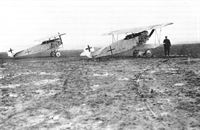 |
C.Owers - Fokker Aircraft of WWI. Vol.7: Postwar /Centennial Perspective/ (67)
|
| [7630/18 ?]
|
 |
C.Owers - Fokker Aircraft of WWI. Vol.7: Postwar /Centennial Perspective/ (67)
|
| William Barker, with his left arm in a sling, besides Fokker D.VII F 7728/18 on Hounslow airfield on 20 April 1919. The fighter retains its twin Maxim 08/15 machine guns.
|
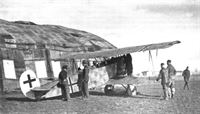 |
C.Owers - Fokker Aircraft of WWI. Vol.7: Postwar /Centennial Perspective/ (67)
|
| 7729/18 photographed at Coblenz post-Armistice
|
 |
J.Herris, J.Leckscheid - Fokker Aircraft of WWI. Vol.5: 1918 Designs Part 2: D.VII & E.V/D.VIII /Centennial Perspective/ (55)
|
| Many factory-fresh D.VIIs were handed over to the Entente nations following the armistice, and seen here is D.VIIF 7729/18, along with several curious American servicemen. This plane was accepted on 29 October 1918, and it was probably still on the way to one of the German Armee Flugparks when the hostilities ended. The engine powering this plane was BMW IIIa # 1626. (Peter M. Grosz Collection/STDB)
|
 |
J.Herris, J.Leckscheid - Fokker Aircraft of WWI. Vol.5: 1918 Designs Part 2: D.VII & E.V/D.VIII /Centennial Perspective/ (55)
|
| The fact that aircraft were not accepted in numerical sequence at the Fokker factory at Schwerin is proven by D.VIIF 7732/18. It was accepted on 22 November 1918, three and a half weeks after the plane seen in the previous photo. This was one of the aircraft powered by an Opel-built BMW IIIa engine, serial number 12087. Note the Fokker works number 3584 just above the wing root attachment point. The fuselage is covered in four-color polygon aircraft fabric. (Peter M. Grosz Collection/STDB)
|
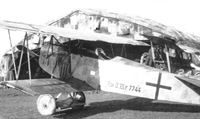 |
C.Owers - Fokker Aircraft of WWI. Vol.7: Postwar /Centennial Perspective/ (67)
|
| Fokker D.VII F 7744/18 with the 25th Aero Squadron, Toul, post-Armistice. The Squadron's S.E.5a fighters are in the background.
|
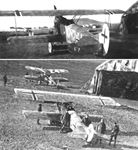 |
C.Owers - Fokker Aircraft of WWI. Vol.7: Postwar /Centennial Perspective/ (67)
|
| Fokker D.VII F 7744/18 with the 25th Aero Squadron, Toul, post-Armistice. The Squadron's S.E.5a fighters are in the background.
|
 |
J.Herris, J.Leckscheid - Fokker Aircraft of WWI. Vol.5: 1918 Designs Part 2: D.VII & E.V/D.VIII /Centennial Perspective/ (55)
|
7756/18 showing the distinctive 'star' on its rudder. The D.VII fighters in the line-up all appear to have their motor cowls removed.
Only 27 D.VIIs in the 7700/18 to 7799/18 range were Mercedes-powered, and Fokker D.VII 7756/18 is one of these powered by the engine with the serial number 41152. Interestingly, this engine had previously been fitted to D.VII 5110/18, which was accepted on 17 September 1918. Either this airframe was lost quickly leaving the engine intact or there were problems with the engine that required removal and the engine was returned for repair and then fitted to the next airframe. 7756/18 was accepted on 26 October 1918, and like the previously shown planes it was one of the many surrendered examples. (Peter M. Grosz Collection/STD
|
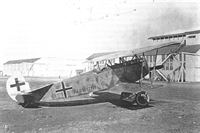 |
C.Owers - Fokker Aircraft of WWI. Vol.7: Postwar /Centennial Perspective/ (67)
|
| D.VII F 7772/18 has a new windscreen arrangement and no armament. The D.VII fighters were flown in their German colours as trainers in the USAS. (AHT AL0385-12)
|
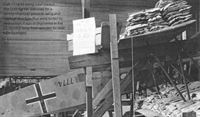 |
C.Owers - Fokker Aircraft of WWI. Vol.7: Postwar /Centennial Perspective/ (67)
|
| D.VII 7774/18 being sand loaded. This D.VII fighter was used for a variety of tests to prove its wing and fuselage structure that were tested to destruction. It was instrumental in the US moving away from wooden to steel tube fuselages.
|
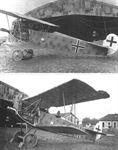 |
C.Owers - Fokker Aircraft of WWI. Vol.7: Postwar /Centennial Perspective/ (67)
|
| Fokker D.VII F 7788/18 (w/n 3460) with BMW IIIA No. 1674, was accepted on 29 November 1918, after the Armistice. It was a new aircraft when it came into US hands. (via M O'Neal)
|
 |
J.Herris, J.Leckscheid - Fokker Aircraft of WWI. Vol.5: 1918 Designs Part 2: D.VII & E.V/D.VIII /Centennial Perspective/ (55)
|
| Another post-armistice machine was Fokker D.VIIF 7788/18, powered by BMW IIIa # 1674. The small, dark diamond-shaped polygons indicate that the five-colored aircraft fabric covered the fuselage. These pictures perfectly illustrate how different the gray-shades are rendered in photos taken from slightly different angles and under different lighting conditions. When photographed, the machine guns had been removed, and the mud stains on the wheels prove that the plane was flown just recently. (Peter M. Grosz Collection/STDB)
|
 |
J.Herris, J.Leckscheid - Fokker Aircraft of WWI. Vol.5: 1918 Designs Part 2: D.VII & E.V/D.VIII /Centennial Perspective/ (55)
|
| "Fok.D VII F 7788/18" was one of several aircraft handed over to the American forces as part of the Armistice agreement. The diamond-shaped polygon seen on the fuselage readily identifies the five-color aircraft fabric. Crosses are of the previously-described final version, and when photographed, the rudder was a replacement component; note that the horizontal cross arm is positioned slightly lower. The factory serial number of this plane was 3640, but the number on the rudder appears to read 3584, which in turn was the factory serial of D.VII F 7732/18. This was another one of the late-production aircraft handed over to the victors, and a photo of the fuselage of this particular plane is featured in this book as well. Replacement of the rudder or other components with those coming from other aircraft was common, and contrary to what has been written previously, the major components from the three D.VII manufacturers were interchangeable.
|
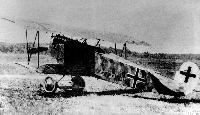 |
Сайт - Pilots-and-planes /WWW/
|
|
|
 |
C.Owers - Fokker Aircraft of WWI. Vol.7: Postwar /Centennial Perspective/ (67)
|
| D.VIIF 7796/18 bears the insignia of the Air Service Mechanics School, Kelly Field, placed over the fuselage cross. The tail has been overpainted, but German insignia is left on the wings. Also, the machine is fully armed. The school moved to Chanute Field in 1922.
|
 |
J.Herris, J.Leckscheid - Fokker Aircraft of WWI. Vol.5: 1918 Designs Part 2: D.VII & E.V/D.VIII /Centennial Perspective/ (55)
|
| Two Fokker D.VIIs from the final production batch (10300/18 - 10499/18?) are known to have been powered by the Mana IIIa engine, built by the Maschinenfabrik-Augsburg-Nurnberg (MAN). The first of these was 10347/18, and the second one, 10348/18 is pictured here. The performance provided by this engine was comparable to the BMW IIIa engine, although it is not known that any examples of it saw frontline service before the armistice. These are post-war views of the aircraft in American hands showing the aircraft from both sides. The fuselage was covered in five-color dyed fabric. (Peter M. Grosz Collection/STDB)
|
 |
J.Herris, J.Leckscheid - Fokker Aircraft of WWI. Vol.5: 1918 Designs Part 2: D.VII & E.V/D.VIII /Centennial Perspective/ (55)
|
The final style of Fokker nose design is documented in the lower pair of photos. On the left side, a pair of cooling louvres was added around to the oval forward section of the side panel. The trio of cooling openings on the oval panel has now been positioned lower than before, compare to the position seen on the earlier aircraft above.
A triangular rear metal side panel was added, and this incorporated the previously-seen small triangular access panel in its upper position. Three other large louvres of equal size are present in the lower section of the panel, and two small slots are placed onto the rear of the panel. The upper panel was again of the early plain style.
The radiator filler was now offset to the left side, and in this view the “Rupp-Nabe” is visible. This item was only seen on BMW-powered examples of the D.VII. It was a quick-release propeller hub which was mounted to the airscrew with a single central nut.
|
 |
J.Herris, J.Leckscheid - Fokker Aircraft of WWI. Vol.5: 1918 Designs Part 2: D.VII & E.V/D.VIII /Centennial Perspective/ (55)
|
| The cooling louvres on the right side mirrored those of the left, and the Fokker manufacturer's plate is seen well in this photo. Another small triangular maintenance panel appeared on very late-production machines, seen here above the opening left by the removed lower wing.
|
 |
J.Herris, J.Leckscheid - Fokker Aircraft of WWI. Vol.5: 1918 Designs Part 2: D.VII & E.V/D.VIII /Centennial Perspective/ (55)
|
| In order to photograph the front of the plane, it was simply swung around, and a guard watches the photo session from a distance. Two small identifying details of Albatros-built D.VIIs can be seen in this view: the rectangular wheel valve covers on the wheel hubs and the six hinges on the leading edge of the tow-piece axle wing. For some reason, the tail skid is missing. (Peter M. Grosz Collection/STDB)
|
 |
J.Herris, J.Leckscheid - Fokker Aircraft of WWI. Vol.5: 1918 Designs Part 2: D.VII & E.V/D.VIII /Centennial Perspective/ (55)
|
| The first example of the Albatros-manufactured D.VII, carrying the military number 527/18, can be seen here on the ramp at Adlershof. Faintly visible in the left background of the photo is the factory where it was manufactured. The Albatros company was located just across the field, to the left of the Zeppelin shed, and the plane was likely simply towed across the grass field. The stenciled data applied to the tail surfaces reads "Fok.D7(Alb.)527", while the fuselage has been marked "Fok. DVII (Alb.) 527/18". (Peter M. Grosz Collection/STDB)
|
 |
J.Herris, J.Leckscheid - Fokker Aircraft of WWI. Vol.5: 1918 Designs Part 2: D.VII & E.V/D.VIII /Centennial Perspective/ (55)
|
| The nose of 527/18, the first Albatros-production D.VII, shows that initially only a single side-panel with an oval shape was fitted on the left side. The basic layout of this panel was very similar to those of early Fokker- and O.A.W.-built planes. The "pimple" on the upper engine panel was seen on Fokker V21, but not adopted on Fokker-built production aircraft. Albatros retained this detail on all their production aircraft, although it became teardrop-shaped very soon. A similar-shaped small bulge can be seen on the chin panel near the prop shaft. These two details are good identifying features of Johannisthal-built D.VIIs.
|
 |
J.Herris, J.Leckscheid - Fokker Aircraft of WWI. Vol.5: 1918 Designs Part 2: D.VII & E.V/D.VIII /Centennial Perspective/ (55)
|
| A closeup of the right side of the nose of 527/18 showing the opening for and the shape of the low collector exhaust. This was typical for the first 130-or-so aircraft. The lower maintenance door seen here was very similar to those seen on planes from the other two manufacturers, while the shape and position of the upper door was unique to Albatros-built planes. The "pimple" noted before was also incorporated on the right side. On this plane, the Albatros manufacturer's plate was still mounted in an oblique manner. Almost all photos of later good enough to show these plates show these mounted horizontally below the lower maintenance door.
|
 |
J.Herris, J.Leckscheid - Fokker Aircraft of WWI. Vol.5: 1918 Designs Part 2: D.VII & E.V/D.VIII /Centennial Perspective/ (55)
|
| A later picture of 527/18, now equipped with tailskid, windshield and a different propeller, but lacking machine guns and the axle wing. Two white fuselage bands have been painted around the fuselage. Markings like these appear unusual on aircraft that were evaluated in the homeland, but they did serve a purpose: during formation flights the neighboring pilot would see he was flying at the correct distance when these two band appeared "closed" to him. (Peter M. Grosz Collection/STDB)
|
 |
J.Herris, J.Leckscheid - Fokker Aircraft of WWI. Vol.5: 1918 Designs Part 2: D.VII & E.V/D.VIII /Centennial Perspective/ (55)
|
| An even later photo of the same machine, taken at the DFW aircraft factory at Lindenthal near Leipzig. The purpose of this visit may have been to familiarize the staff there with the new Fokker in case the company would be tasked with repair work on planes that were returned from frontline service in damaged condition.
|
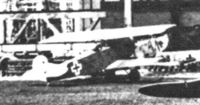 |
J.Herris, J.Leckscheid - Fokker Aircraft of WWI. Vol.5: 1918 Designs Part 2: D.VII & E.V/D.VIII /Centennial Perspective/ (55)
|
| Good photographs showing the earliest factory-applied cross-styles on Albatros-built D.VIIs are currently unavailable, so only two poor-quality views of these are presented here. Seen in the background of a Johannisthal factory-photo is this early-production example. The fuselage cross is fully-outlined, and this was probably also the case on the wing crosses. The rudder cross has been washed out by strong sunlight, but the early small rudder crosses typical for early machines will be featured in the following pages.
|
 |
J.Herris, J.Leckscheid - Fokker Aircraft of WWI. Vol.5: 1918 Designs Part 2: D.VII & E.V/D.VIII /Centennial Perspective/ (55)
|
| One of the first units equipped with Albatros-built D.VIIs in late May/early June was Jasta 18, which was then based at Lille in the area of the 6. Army. When the unit moved approximately 300 kilometers south-east to Montingen (Montigny) near Metz on 14 June, they handed over their still new fighters to other Jastas nearby. One of the units profiting from this donation was Jagdstaffel 30 at Phalempin. Here a very early-production machine is seen, note the traces of converting the big early Balkenkreuz markings on the wings to the later thin version of the marking. (Peter M. Grosz Collection/STDB)
|
 |
J.Herris, J.Leckscheid - Fokker Aircraft of WWI. Vol.5: 1918 Designs Part 2: D.VII & E.V/D.VIII /Centennial Perspective/ (55)
|
| Another nearby recipient of ex-Jasta 18 D.VII (Alb.) fighters was Jasta 43, stationed nearby at Haubourdin. Five very early-production examples can be seen in this view, the first and second from right being former Jasta 18 examples. Seen from the right are the planes flown by: Lt. Josef Keller, Lt. Simons, Lt. Karl Wernicke, Lt. Josef Raesch, and Oblt. Adolf Gutknecht. The small rudder crosses placed in the position seen here were only seen on very early Albatros-built planes. (Greg VanWyngarden)
|
 |
J.Herris, J.Leckscheid - Fokker Aircraft of WWI. Vol.5: 1918 Designs Part 2: D.VII & E.V/D.VIII /Centennial Perspective/ (55)
|
| Photographed in front of the Albatros factory at Johannisthal, 541/18 was a test plane built with a wooden fuselage. This was a precautionary measure to ensure continued production of the type in case a shortage of steel tubes for fuselages would arise at some point during series production. However, this never happened, and it remained the sole wooden-fuselage example built by Albatros. The aircraft was eventually shipped to the front and reached Jasta 30 on 28 July 1918. (Peter M. Grosz Collection/STDB)
|
 |
A.Weyl - Fokker: The Creative Years /Putnam/
|
| Fok. D.VII (Alb.) 541/18 with plywood fuselage.
|
 |
J.Herris, J.Leckscheid - Fokker Aircraft of WWI. Vol.5: 1918 Designs Part 2: D.VII & E.V/D.VIII /Centennial Perspective/ (55)
|
| Jasta 43 pilot Lt. Simons poses in front of his very early-production D.VII (Alb.), the military number of which may be 554/18. This identification is only tentative, since the last digit of the military number can hardly be deciphered. However, the lower wing cross shows clear signs of conversion from the early thick style, an indication that this was one of the first few dozen aircraft built. (Greg VanWyngarden)
|
 |
J.Herris, J.Leckscheid - Fokker Aircraft of WWI. Vol.5: 1918 Designs Part 2: D.VII & E.V/D.VIII /Centennial Perspective/ (55)
|
| Jasta 43 commander Oblt. Adolf Gutknecht and crew pose in front of his D VII (Alb.) 571/18, the last aircraft seen in the previous lineup. The wing crosses were converted from the early thick style, and the lifting handle on the rear fuselage has been mounted facing upwards, as on O.A.W. machines. (Greg VanWyngarden)
|
 |
J.Herris, J.Leckscheid - Fokker Aircraft of WWI. Vol.5: 1918 Designs Part 2: D.VII & E.V/D.VIII /Centennial Perspective/ (55)
|
| Vfw. Karl Burberg joined Jasta 43 on 16 August 1918, and poses here for a photo in the D VII (Alb.) that was assigned to him. Like the previous planes, this was another very early Johannisthal-built machine on which the fuselage fabric extended up the forward landing gear leg. It must have seen about ten weeks of frontline service or more by the time he joined the unit, as can be seen from the additional cooling vents added to the cowling panels and the various fabric patches. (Peter M. Grosz Collection/STDB)
|
 |
J.Herris, J.Leckscheid - Fokker Aircraft of WWI. Vol.5: 1918 Designs Part 2: D.VII & E.V/D.VIII /Centennial Perspective/ (55)
|
| A single Fokker-built D.VII, second from right, is shown in line with half a dozen early-production Albatros-built machines from Jasta 30 at Phalempin airfield, circa July 1918. All aircraft are heavily painted, and the plane in the center is apparently the ex-Jasta 18 plane seen previously in two photos. The white rear fuselage has now received additional oblique stripes. The history of Jasta 30 is recounted in the book "Royal Prussian Jagdstaffel 30", also published by Aeronaut books. (Peter M. Grosz Collection/STDB)
|
 |
J.Herris, J.Leckscheid - Fokker Aircraft of WWI. Vol.5: 1918 Designs Part 2: D.VII & E.V/D.VIII /Centennial Perspective/ (55)
|
| The aircraft seen second from left in the previous photo is seen here in a full side view. It must have been one of the last planes built before the introduction of the rear side panel. The military number has been marked on the middle "N" strut, but it is too indistinct to be made out. (Peter M. Grosz Collection/STDB)
|
 |
J.Herris, J.Leckscheid - Fokker Aircraft of WWI. Vol.5: 1918 Designs Part 2: D.VII & E.V/D.VIII /Centennial Perspective/ (55)
|
| The next version of the national insignia on the fuselage and wings was already the Balkenkreuz of 5:4 proportions, seen here on 646/18. The aircraft was photographed just after delivery to Jasta 23b at Epinoy here. Although this was a fairly early-production aircraft, the rudder cross would see hardly any change in the future. Eventually, the fuselage and wing crosses would also be applied with equal proportions. This change was introduced somewhere.
|
 |
J.Herris, J.Leckscheid - Fokker Aircraft of WWI. Vol.5: 1918 Designs Part 2: D.VII & E.V/D.VIII /Centennial Perspective/ (55)
|
| Fok. DVII (Alb.) 652/18 is seen here soon after it arrived at Jasta 23b, which was stationed at Epinoy airfield. The plane is still in factory-fresh condition, and the tail has already been put up on a trestle. A close look at the photo reveals the reason for this setup: a unit member is standing on the other side of the fuselage, applying a marking between cockpit and cross. He himself is standing on a small trestle, too, and the bucket of white paint can be seen to his feet. The bulbous contour of the Albatros-style chin panel shows particularly well in this view.
|
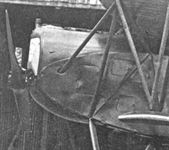 |
J.Herris, J.Leckscheid - Fokker Aircraft of WWI. Vol.5: 1918 Designs Part 2: D.VII & E.V/D.VIII /Centennial Perspective/ (55)
|
| Detail view of the nose of 652/18 illustrates that by this time some changes had been implemented. A second metal side panel of triangular shape is now mounted behind the first one. This one also features two maintenance doors, the upper almost resembling the outline of an Aztec pyramid. No cooling louvers are yet present on these two components, and the "pimple" is now of the aforementioned shape. The chin panel is noticeably more bulbous than on Fokker- and O.A.W.-built planes. This type of chin panel can be seen on many but not all Albatros-built D.VIIs.
|
 |
J.Herris, J.Leckscheid - Fokker Aircraft of WWI. Vol.5: 1918 Designs Part 2: D.VII & E.V/D.VIII /Centennial Perspective/ (55)
|
| Photographed just moments later, the painter has now stepped down from his trestle in order to paint the bottom of his marking of choice. From this perspective two interesting details of the plane can be made out. A "Morell" tachometer has been fitted to the starboard "N" strut, and the port outer part of the axle wing, outboard the landing gear struts, is missing in order to allow access to the bungee cords of the landing gear. (Bruno Schmaling)
|
 |
J.Herris, J.Leckscheid - Fokker Aircraft of WWI. Vol.5: 1918 Designs Part 2: D.VII & E.V/D.VIII /Centennial Perspective/ (55)
|
| As seen is this view of 652/18 taken soon afterwards, the painter applied an "L" as the personal marking on this Fokker D VII (Alb.). Further upgrades include a rear view mirror, a tubular gunsight, a flare pistol, and a flare cartridge holder. The full story behind this personal marking ('L' for Lotte, his girlfriend Charlotte's nickname), as well as the story of the entire Jagdstaffel, is told in "Royal Bavarian Jagdstaffel 23", also published by Aeronaut Books. (Bruno Schmaling)
|
 |
J.Herris, J.Leckscheid - Fokker Aircraft of WWI. Vol.5: 1918 Designs Part 2: D.VII & E.V/D.VIII /Centennial Perspective/ (55)
|
| Kest 1a operated several Albatros-built D.VIIs, and among these was 666/is seen here.The crank mounted outside the cockpit was used to lower and lift the wireless aerial, the tip of which can be seen below the fuselage. Kest 1a evaluated the use of wireless communication for purposes of home defense. This was one of the last aircraft to be delivered with the low-exiting exhaust. (Peter M. Grosz Collection/STDB)
|
 |
J.Herris, J.Leckscheid - Fokker Aircraft of WWI. Vol.5: 1918 Designs Part 2: D.VII & E.V/D.VIII /Centennial Perspective/ (55)
|
| The second metal side panel of triangular shape was also applied to the right side, as seen here on 666/18. Only the upper maintenance door appeared on this side, and another addition was the circular maintenance door above the lower wing close to the rear cabane strut. This was already noted on 611/18.
|
 |
J.Herris, J.Leckscheid - Fokker Aircraft of WWI. Vol.5: 1918 Designs Part 2: D.VII & E.V/D.VIII /Centennial Perspective/ (55)
|
| Several pilots from Kest 1a took the opportunity to have their picture taken in the cockpit of this aircraft, and here Lt. Dembowski takes his turn. The wrinkles seen in the upper part of the four-color fabric typically appeared on frontline aircraft after short periods of service, as did the oil stains. (Peter M. Grosz Collection/STDB)
|
 |
J.Herris, J.Leckscheid - Fokker Aircraft of WWI. Vol.5: 1918 Designs Part 2: D.VII & E.V/D.VIII /Centennial Perspective/ (55)
|
| The serial of this Jasta 56 plane, flown by Lt. Lutz Beckmann, has been covered by the comprehensive paintjob. But the presence of the rear side panel and the low-exiting exhaust identify this plane as being one from approximately the 600/18 - 676/18 range. (Peter M. Grosz Collection/STDB)
|
 |
J.Herris, J.Leckscheid - Fokker Aircraft of WWI. Vol.5: 1918 Designs Part 2: D.VII & E.V/D.VIII /Centennial Perspective/ (55)
|
| Two Albatros-built D.VIIs roughly from the 668/18 - 787/18 production range are seen here in the markings of Jasta 18 at Montingen (Montigny) in September 1918. The first aircraft seen is that of Staffelfuhrer Lt. August Raben, who extended the application of red paint on the fuselage up to the tail surfaces. He also used a white Raven as his marking, his family name being the inspiration behind the unit marking. The third aircraft is an early-production O.A.W.-built plane. Seen well are the three cooling openings on the chin panel and a large one on the forward upper engine cowling. (Greg VanWyngarden).
|
 |
J.Herris, J.Leckscheid - Fokker Aircraft of WWI. Vol.5: 1918 Designs Part 2: D.VII & E.V/D.VIII /Centennial Perspective/ (55)
|
| Perfectly set up for a side-view photo, 677/18 was one of the first Albatros-built D.VIIs fitted with the high-mounted "saxophone" exhaust, the forward part of which is still covered by the upper side panel. The two side panels still lack any factory-applied cooling louvers, and for some unknown reason the machine guns are missing, but a "Morell" tachometer is fitted to the starboard "N" strut. Fuselage crosses are still of 5:4 proportions. (Peter M. Grosz Collection/STDB)
|
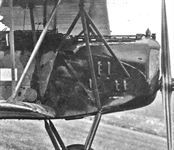 |
J.Herris, J.Leckscheid - Fokker Aircraft of WWI. Vol.5: 1918 Designs Part 2: D.VII & E.V/D.VIII /Centennial Perspective/ (55)
|
| This view of the right side of 677/17 may have been taken to document the first Albatros-built example with the "saxophone" style exhaust. On the forward side panel, three small louvers appear aligned with the lower maintenance door, and two taller ones appear just above it. A rigging diagram and a datum line have now been applied to the fuselage fabric as well. The chin panel was now separate from the radiator face and was attached to it with a pair of spring clamps on each side of the prop.
|
 |
J.Herris, J.Leckscheid - Fokker Aircraft of WWI. Vol.5: 1918 Designs Part 2: D.VII & E.V/D.VIII /Centennial Perspective/ (55)
|
| By 788/18, the first cooling louvers on the forward side panel appeared, three small ones in a row in front and behind the lower maintenance door and a taller pair above it. This was to be the standard arrangement on this component for the rest of the Albatros license-built variant. The factory-applied fuselage cross was now of equal proportions. The military number has been marked on the rudder. The aircraft served with Kest 4b at Freiburg im Breisgau, and pictured with his aircraft here is Offzstv. Hermann Pohlmann. (Lower photo: Tobias Weber)
|
 |
J.Herris, J.Leckscheid - Fokker Aircraft of WWI. Vol.5: 1918 Designs Part 2: D.VII & E.V/D.VIII /Centennial Perspective/ (55)
|
| On 12 August 1918, Jasta 53 pilot Offzstv. Fritz Blumenthal was brought down and taken POW south-west of Proyart, following combat with 41 Sqn. and 209 Sqn., RAF. As on many other D.VIIs, the upper cowlings were removed on the aircraft during the summer, and the Jasta 53 Werkmeister also added three large ventilation holes to the front of the chin panels, similar to those seen earlier on the aircraft of Jasta 18. It is unclear if the rudder cross was painted out by the Jasta or if the plain (white?) fin and rudder shown here was here were applied after capture. According to the evaluation report, it was powered by a Mercedes engine carrying the serial 34358, which was a refurbished engine produced in mid-1917. (Peter M. Grosz Collection/STDB)
|
 |
J.Herris, J.Leckscheid - Fokker Aircraft of WWI. Vol.5: 1918 Designs Part 2: D.VII & E.V/D.VIII /Centennial Perspective/ (55)
|
| Close look at the nose of 817/18 shows that the forward panel was the first component to receive cooling louvers, two small ones in front, then three slightly taller ones a bit higher arranged in the center of the side panel. The circular openings in the chin panel were added by the Jasta 53 groundcrew in order to provide additional cooling for the engine and ammunition compartment during the hot summer months.
|
 |
J.Herris, J.Leckscheid - Fokker Aircraft of WWI. Vol.5: 1918 Designs Part 2: D.VII & E.V/D.VIII /Centennial Perspective/ (55)
|
| Blumethal's Fok. D VII (Alb.) 817/18 is seen here in two motion picture stills, soon after the dismantled aircraft was salvaged. The white tail and oblique fuselage band, bordered with dark blue paint, as well as the "Nickchen IV" moniker, were the personal markings of the pilot. The white nose was the unit marking of Jasta 53. (Greg VanWyngarden).
|
 |
J.Herris, J.Leckscheid - Fokker Aircraft of WWI. Vol.5: 1918 Designs Part 2: D.VII & E.V/D.VIII /Centennial Perspective/ (55)
|
| This aircraft was probably the first intact D.VII to be captured by an RAF unit and was subsequently evaluated by the British, as seen here. As on several Albatros-built D.VIIs, the right outer section of the axle wing has been removed. (Peter M. Grosz Collection/STDB)
|
 |
J.Herris, J.Leckscheid - Fokker Aircraft of WWI. Vol.5: 1918 Designs Part 2: D.VII & E.V/D.VIII /Centennial Perspective/ (55)
|
| The plane closest to the camera in this and the previous photo was either 883/18 or 833/18, both of which he flew between mid-August and late October. This proves that, from early August to late October, he alternated between three different personal D.VIIs. Since 833/18 was recorded to have been powered by a BMW IIIa engine, and the plane seen here appears to mount a Mercedes D.IIIa (note the "tube" mounted on the side of the cylinders, below the exhaust), the aircraft seen here was most likely 883/18. The cooling louvers seen on the triangular-shaped panel are unusual and may have been applied at unit level, while those on the forward side panel are standard for late Albatros-built aircraft from the first production batch. Both aircraft seen in this pair of photos were painted in an identical manner, the only way to differentiate between them is to look for the factory-applied details. (Reinhard Kastner)
|
 |
J.Herris, J.Leckscheid - Fokker Aircraft of WWI. Vol.5: 1918 Designs Part 2: D.VII & E.V/D.VIII /Centennial Perspective/ (55)
|
| Between mid-June 1918 and the end of the war, Jasta 34b commander Oblt. Robert Greim flew seven different Fokker D.VIIs, all of these being Albatros-built planes from the first production batch. The fuselage and rudder crosses on the plane seen in the rear of this photo indicate that the plane seen at rear was most likely 697/18, which he began flying on 3 August, on his first flight after having recovered from an injury suffered in a crash a month and a day earlier. His last recorded flight on the plane was on 22 September. Greim survived the war with a total of 28 confirmed victories, and he was awarded the Pour le Merite on 10 October 1918. After the war, he took part in several demonstration flights with Ernst Udet. (Reinhard Kastner)
|
 |
J.Herris, J.Leckscheid - Fokker Aircraft of WWI. Vol.5: 1918 Designs Part 2: D.VII & E.V/D.VIII /Centennial Perspective/ (55)
|
| One of the last aircraft from the first Albatros batch is seen here at Nivelles after the end of hostilities. The military number was most likely 916/18 (or, less likely, 910/18), and the arrangement of cooling louvers was identical to that seen on 817/18. White "A" previously served with Jagdstaffel 37. (Greg VanWyngarden).
|
 |
J.Herris, J.Leckscheid - Fokker Aircraft of WWI. Vol.5: 1918 Designs Part 2: D.VII & E.V/D.VIII /Centennial Perspective/ (55)
|
| The rear metal nose panel also received louvers soon afterwards. Initially, only one or two such louvers were added, appearing on late aircraft from the first batch, but clear photos showing these are not currently available to the authors. The first aircraft of the second batch featured five louvers arranged in the way seen here. This was pretty much the final layout of these louvers for the rest of D.VII production by Albatros.
|
 |
J.Herris, J.Leckscheid - Fokker Aircraft of WWI. Vol.5: 1918 Designs Part 2: D.VII & E.V/D.VIII /Centennial Perspective/ (55)
|
| On the right fuselage side, five louvers were also added to the rear side panel. Arrangement of these could differ slightly, but the style shown here was very common from the first aircraft of the second batch onwards. The forward part of the exhaust was now also fully exposed to the airstream, and a neat "swung" cutout was seen on late-production Albatros-built machines just in front of it.
|
 |
J.Herris, J.Leckscheid - Fokker Aircraft of WWI. Vol.5: 1918 Designs Part 2: D.VII & E.V/D.VIII /Centennial Perspective/ (55)
|
| While the military number 5220/18 suggests that it was a much later aircraft than the one seen above, there were only about 30 D.VIIs manufactured between them at Johannisthal. The most obvious upgrade is the addition of several ventilation louvers to the triangular rear side panel. (Peter M. Grosz Collection/STDB)
|
 |
Сайт - Pilots-and-planes /WWW/
|
| A D.VII built by the Albatros company is identified by the all-white fin and rudder as well as the distinctively different (from Fokker) lettering on the fuselage and the louver pattern on the engine cowling.
|
 |
J.Herris, J.Leckscheid - Fokker Aircraft of WWI. Vol.5: 1918 Designs Part 2: D.VII & E.V/D.VIII /Centennial Perspective/ (55)
|
| As a replacement for the O.A.W.-built D.VII that was scorched by the balloon explosion on 14 September, Lt. Friedrich Noltenius of Jasta 11 received Fokker D.VII( Alb) 5278/18. It was named "Hertha" in honor of his sister, and the red/white markings were the Hanseatic colors of Bremen, their home town. The photo here was taken during a visit to Jastaschule II at Nivelles in mid-September. Noltenius scored 21 victories and survived the war. (Peter M. Grosz Collection/STDB)
|
 |
J.Herris, J.Leckscheid - Fokker Aircraft of WWI. Vol.5: 1918 Designs Part 2: D.VII & E.V/D.VIII /Centennial Perspective/ (55)
|
| Noltenius was posted to Jasta 6 on 21 September, and just two months later "Hertha" returned to Nivelles where it was photographed in British hands. Which Jasta 27 pilot picked up the plane in the interim period is not known. (Peter M. Grosz Collection/STDB)
|
 |
J.Herris, J.Leckscheid - Fokker Aircraft of WWI. Vol.5: 1918 Designs Part 2: D.VII & E.V/D.VIII /Centennial Perspective/ (55)
|
| Since the fuselage marking covered the military number, it was re-marked in the upper rear corner of the fuselage cross arms. (Greg VanWyngarden)
|
 |
J.Herris, J.Leckscheid - Fokker Aircraft of WWI. Vol.5: 1918 Designs Part 2: D.VII & E.V/D.VIII /Centennial Perspective/ (55)
|
| Another postwar photo of Fokker D.VII(Alb) 5278/18 Hertha, at Nivelles with a British pilot in the cockpit showing its colorful markings to advantage.
|
 |
J.Herris, J.Leckscheid - Fokker Aircraft of WWI. Vol.5: 1918 Designs Part 2: D.VII & E.V/D.VIII /Centennial Perspective/ (55)
|
| The orientation of the "Bremen" flag on the right side is seen in these views, and it was also applied to the center section of the upper wing. While it is commonly believed that the noses and tails of Jasta 27 aircraft were yellow, this was perhaps no longer true for the tail during the last months of the war. While the early photo of the plane shows the tail in four-color fabric, it is shown here painted white. The rudder fitted now was a replacement item from a late-production OAW.-built aircraft. At least three pilots are known to have joined Jasta 27 after Noltenius left the unit, and any of them could have taken over the plane. Alternatively, it could have been taken over by Jasta 36, a sister unit in JG III. In this case, the nose would have been painted blue at this point, but this is mere speculation. (Greg VanWyngarden)
|
 |
J.Herris, J.Leckscheid - Fokker Aircraft of WWI. Vol.5: 1918 Designs Part 2: D.VII & E.V/D.VIII /Centennial Perspective/ (55)
|
| Dismantled Hertha being transported to a collection center. The "Astra" prop seen in previous photos has been replaced by a different type. (Greg VanWyngarden)
|
 |
J.Herris, J.Leckscheid - Fokker Aircraft of WWI. Vol.5: 1918 Designs Part 2: D.VII & E.V/D.VIII /Centennial Perspective/ (55)
|
| Nivelles was a major post-war collection point for single-seaters of numerous Jagdstaffeln. Seen here is D VII (Alb.) 5298/18 from Jasta 5, showing off the red-bordered green tail unit marking. The lack of personal marking on the fuselage indicates that this was a reserve plane. (Peter M. Grosz Collection/STDB)
|
 |
J.Herris, J.Leckscheid - Fokker Aircraft of WWI. Vol.5: 1918 Designs Part 2: D.VII & E.V/D.VIII /Centennial Perspective/ (55)
|
| Post-war view of unarmed 5322/18, supposedly taken in Bulgaria, allows a look at the cooling louvers from the rear. Note the large "/" seen on this and other late-production aircraft and compare it to that seen on 611/18 and 652/18, pictured earlier in this book. (Peter M. Grosz Collection/STDB)
|
 |
C.Owers - Fokker Aircraft of WWI. Vol.7: Postwar /Centennial Perspective/ (67)
|
| Fokker D.VII (Alb) 5324/18 photographed after the Armistice. This machine was examined by the British and was destroyed in October 1920, under orders from the victorious Allies.
|
 |
C.Owers - Fokker Aircraft of WWI. Vol.7: Postwar /Centennial Perspective/ (67)
|
|
|
 |
C.Owers - Fokker Aircraft of WWI. Vol.7: Postwar /Centennial Perspective/ (67)
|
|
|
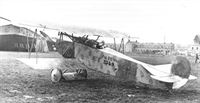 |
C.Owers - Fokker Aircraft of WWI. Vol.7: Postwar /Centennial Perspective/ (67)
|
| D.VII (Alb) 5349/18 has the German insignia crudely overpainted. It appears to have full armament.
|
 |
K.Delve - World War One in the Air /Crowood/
|
| Outright winner of the fighter competition was the Fokker DVII; the type has been assessed as one of the best three fighters of the war and it certainly caused the Allies many problems during 1918.
|
 |
C.Owers - Fokker Aircraft of WWI. Vol.7: Postwar /Centennial Perspective/ (67)
|
| Fokker D.VII (Alb) 5353/18 in British hands post-Armistice. The area for the British cockade has been outlined on the German cross.
|
 |
J.Herris, J.Leckscheid - Fokker Aircraft of WWI. Vol.5: 1918 Designs Part 2: D.VII & E.V/D.VIII /Centennial Perspective/ (55)
|
| Unarmed D VII (Alb.) 5477/18 is seen here from both sides in two post-war pictures. Numerous patches are visible on the wing and fuselage fabric, and the nose and tail were painted in an unknown color by the original owners, which remain unidentified at this point. While the engine side panels remain unchanged to earlier aircraft in this batch, the radiator filler neck has now been moved to the left from the previously seen central position. The rectangular openings on the radiator bottom seen on late aircraft of the other two manufacturers now found their way to Albatros-built machines as well. (San Diego Museum Archives)
|
 |
C.Owers - Fokker Aircraft of WWI. Vol.7: Postwar /Centennial Perspective/ (67)
|
| Fokker D.VII (Alb) 5477/18 was delivered to Sarreguemines post-Armistice.
|
 |
J.Herris, J.Leckscheid - Fokker Aircraft of WWI. Vol.5: 1918 Designs Part 2: D.VII & E.V/D.VIII /Centennial Perspective/ (55)
|
| A lineup of four Albatros-built D.VIIs at Hounslow after the war, with D VII (Alb.) 5524/18 "RK" heading the quartet. This plane has previously wrongly been identified as 5924/18, and this photo may have been the origin of this mistake. A blemish on this grainy print has caused the second digit to appear like a "9". However, this number was not part of the second Albatros-built D.VII batch, and the true military number of this plane must have been 5524/18. The other candidate, 5324/18, was found in Bulgaria after the war. (Peter M. Grosz Collection/STDB)
|
 |
J.Herris, J.Leckscheid - Fokker Aircraft of WWI. Vol.5: 1918 Designs Part 2: D.VII & E.V/D.VIII /Centennial Perspective/ (55)
|
Fokker D VIIs, with which the majority of Jagdstaffeln re-equipped during the summer and autumn of 1918.
For some reason, the first two aircraft in this lineup 5524/18 and 6769/18, as well as 6822/18 at the far end, have been fitted with O.A.W.-built fins and rudders. D VII (Alb.) has the central radiator filler neck, while the other ones have the offset one. (Peter M. Grosz Collection/STDB)
|
 |
J.Herris, J.Leckscheid - Fokker Aircraft of WWI. Vol.5: 1918 Designs Part 2: D.VII & E.V/D.VIII /Centennial Perspective/ (55)
|
"RK" was originally flown by Jasta 63 pilot Lt. Richard Kraut, who joined this unit on 25 October, coming from Jasta 4. The background color of this personal marking on this aircraft is unconfirmed. In Jasta 4 he used black for this, but for the color profile grey has been chosen since the background color is lighter than the re-marked serial on the lower rear fuselage. The horizontal tailplane may also have been a replacement item, since the rear part of the fuselage decking shows remnants of a two-color stripe marking.
The Canadian pilot entering Richard Kraut's Jasta 63 D.VII, (Alb) 5524/18, at Hounslow, UK, in 1919, has not been identified for certain.
|
 |
J.Herris, J.Leckscheid - Fokker Aircraft of WWI. Vol.5: 1918 Designs Part 2: D.VII & E.V/D.VIII /Centennial Perspective/ (55)
|
| D VII (Alb.) 6666/18 shows up in many photos taken by American personnel after the war. The Jasta operating it previously applied a two-color lozenge pattern to the nose and tail sections of the fighter. In the upper photo, this tail marking illustrates that the fuselage cross was positioned further forward on Albatros-built planes. On this aircraft, the rib tapes were cut from the polygon-dyed aircraft fabric. (Greg VanWyngarden)
|
 |
J.Herris, J.Leckscheid - Fokker Aircraft of WWI. Vol.5: 1918 Designs Part 2: D.VII & E.V/D.VIII /Centennial Perspective/ (55)
|
| Photographs of Albatros-built D VIIs powered by the BMW IIIa engine are rare, but 6786/18 shown here was one of them. The pointed Rupp-Nabe spinner, seen above, was an identifying feature for aircraft powered by this engine. As far as it is possible to determine, all other photos of Albatros-built DVIIs shown in this book show aircraft powered by the Mercedes engine. Again, the British maintenance crew has fitted O.A.W.-built fin and rudder components to this aircraft. Otherwise, it remained in factory finish. (Peter M. Grosz Collection/STDB)
|
 |
C.Owers - Fokker Aircraft of WWI. Vol.7: Postwar /Centennial Perspective/ (67)
|
This photo of 6810/18 is thought to have been taken soon after the war, and this time a Fokker-built rudder is installed, while the tail fin appears to be an Albatros-built component. This particular aircraft survives to this day, and is exhibited as the only unrestored surviving Fokker D.VII at the Lac-Brome Museum in Knowlton, Canada.
Note the Imperial Gift De Havilland D.H.9a in the background. Canada received 12 D.H.9a bombers to form an airforce.
|
 |
C.Owers - Fokker Aircraft of WWI. Vol.7: Postwar /Centennial Perspective/ (67)
|
| Fokker D.VIII(ALB) 6810/18 in Canada postwar.
|
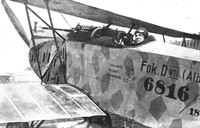 |
J.Herris, J.Leckscheid - Fokker Aircraft of WWI. Vol.5: 1918 Designs Part 2: D.VII & E.V/D.VIII /Centennial Perspective/ (55)
|
| The metal side panels on all D.VIIs quickly showed wear and tear, and those seen here on 6816/18 are no exception. Removal of the inner cover of the right wheel exposes a look at the spokes.
|
 |
J.Herris, J.Leckscheid - Fokker Aircraft of WWI. Vol.5: 1918 Designs Part 2: D.VII & E.V/D.VIII /Centennial Perspective/ (55)
|
| Group photo of RAF personnel at Hounslow, 6822/18 being the aircraft closest behind them. This lineup was taken from the other end of the lineup headed by 5524/18 "RK"seen previously. All four fighters are fitted with airspeed indicator pitot tubes on their starboard "N" strut. (Peter M. Grosz Collection/STDB)
|
 |
J.Herris, J.Leckscheid - Fokker Aircraft of WWI. Vol.5: 1918 Designs Part 2: D.VII & E.V/D.VIII /Centennial Perspective/ (55)
|
| The name and unit of the pilot of D VII (Alb.) 6825/18, Lt. Franz Bacher, Jasta 3, were applied to the side of its fuselage before handing them over to the new French owners. The aircraft most likely only arrived at Jasta 3 shortly before the armistice. (Peter M. Grosz Collection/STDB)
|
 |
J.Herris, J.Leckscheid - Fokker Aircraft of WWI. Vol.5: 1918 Designs Part 2: D.VII & E.V/D.VIII /Centennial Perspective/ (55)
|
| One of the factory-new D.VIIs handed over to the French was Fok. D VII (Alb.) 6852/18, which was exhibited in Paris along with other captured and surrendered military equipment. The unusual perspective of the photo above allows a rare look at the upper surfaces of late Albatros-produced D.VIIs.
|
 |
J.Herris, J.Leckscheid - Fokker Aircraft of WWI. Vol.5: 1918 Designs Part 2: D.VII & E.V/D.VIII /Centennial Perspective/ (55)
|
| Jasta 33 Staffelfuhrer Karl-August von Schonebeck is pictured here very late in the war in his personal Fok. D VII (Alb.) 6880/18. As far as can be seen, this was another rare BMW-powered Fok. D VII (Alb.). (Bruno Schmaling)
|
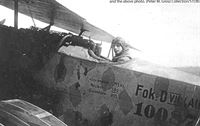 |
J.Herris, J.Leckscheid - Fokker Aircraft of WWI. Vol.5: 1918 Designs Part 2: D.VII & E.V/D.VIII /Centennial Perspective/ (55)
|
| A rare example of the final Albatros D.VII batch. Fok: D VII (Alb.) 10087/18 of Polizeistaffel Hannover was photographed in 1919. Compare the subtle differences in the application of the military number and weights table in this and the above photo. (Peter M. Grosz Collection/STDB)
|
 |
J.Herris - Development of German Warplanes in WWI /Centennial Perspective/ (1)
|
| One of the greatest services Manfred von Richthofen did for Germany was instigating the fighter competitions, and the Fokker D.VII was the greatest result of those competitions. Arriving at the front days after Richthofen's death in his Fokker Triplane, he was not able to fly the D.VII in combat himself. Initially using the Mercedes D.IIIa engine, when fitted with the superb 185 hp BMW.IIIa the D.VII was the best all-around fighter of the war. This D.VII flew with Jasta 49.
|
 |
C.Owers - Fokker Aircraft of WWI. Vol.7: Postwar /Centennial Perspective/ (67)
|
| Another Albatros built D.VII in French hands.
|
 |
J.Herris, J.Leckscheid - Fokker Aircraft of WWI. Vol.5: 1918 Designs Part 2: D.VII & E.V/D.VIII /Centennial Perspective/ (55)
|
| The close-up frontal view of the radiator shows the way the right upper engine cowling wraps around the top of the radiator. The two small inspection windows on the bottom of the upper wing, were peculiar to Albatros-built examples, and the angled exhaust. (Peter M. Grosz Collection/STDB)
|
 |
J.Herris, J.Leckscheid - Fokker Aircraft of WWI. Vol.5: 1918 Designs Part 2: D.VII & E.V/D.VIII /Centennial Perspective/ (55)
|
| After both Albatros and O.A.W. received orders to build the D.VII under licence, pattern aircraft were sent to both manufacturers from Fokker. Reportedly, Fokker had no pattern drawings available that could be provided to both factories, and much has been made of this in the past. But, realistically, why would he have prepared those? Until then, no previous Fokker type had been manufactured under license by another company, let alone two! Fokker D.VII 230/18 was the pattern machine that went to O.A.W. for study, where it was stripped of its fabric to closely examine the complex weld joins of the fuselage and struts, as well the cantilever wing. Both Albatros and O.A.W. had built wooden-fuselage aircraft with rigged wings before, so manufacturing details of Fokkers ground-breaking new design had to be studied. In this photo, D.VII 230/18 is seen at Adlershof after it had been re-covered at O.A.W. in their initial production outfit. Four-color aircraft fabric has been applied to the airframe, the military number "Fok.D.7 230/18" has been applied in the new O.A.W.- style but without including O.A.W. - after all, this was still a Fokker-built machine. The position and style of application of the fuselage and wing crosses was identical to that seen on initial O.A.W.-built production aircraft. (Peter M. Grosz Collection/STDB)
|
 |
J.Herris, J.Leckscheid - Fokker Aircraft of WWI. Vol.5: 1918 Designs Part 2: D.VII & E.V/D.VIII /Centennial Perspective/ (55)
|
| Fokker D.VII (O.A.W.) 2001/18 is seen here just after delivery mid-May 1918. The blended application of the mauve nose patches shows well in this view, and this pattern was also applied to the wheel covers. The photo also allows a look at the position and the style of application of the Balkenkreuz on the lower wing. The propeller fitted to this aircraft is manufactured by Axial, but lacks the well-known company decal. Barely visible is the military number applied in white on the upper central section of the prop, which was common on O.A.W.-built aircraft. (Peter M. Grosz Collection/STDB)�
|
 |
J.Herris, J.Leckscheid - Fokker Aircraft of WWI. Vol.5: 1918 Designs Part 2: D.VII & E.V/D.VIII /Centennial Perspective/ (55)
|
| More details of the aircraft can be seen in this view of the factory-fresh aircraft, especially the high position of the military number "Fokker D.7. (O.A.W.) 2001/18" close to the cross is unusual. The fuselage military number would move several times during production. The fact that individual components were often interchanged between aircraft is also illustrated by the photo: the wheel hub is marked with the serial 2005/18! Both aircraft are known to have served with Jagdstaffel 66. (Peter M. Grosz Collection/STDB)
|
 |
J.Herris, J.Leckscheid - Fokker Aircraft of WWI. Vol.5: 1918 Designs Part 2: D.VII & E.V/D.VIII /Centennial Perspective/ (55)
|
| While the image is too blurred to allow deciphering the military number, comparison of the fuselage fabric polygons and the mauve patches on the nose with the previous two photos confirms that this image shows D,7. (O.A.W.) 2001/18 in flight. Very likely the image was snapped at the same time as the previous pictures. Obviously pilots serving both at the Armee Flugparks and the first Jagdstaffeln to receive the first examples of the revolutionary new biplane fighter were eager to test-fly the new plane as soon as they had a chance to do so.
|
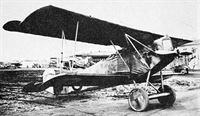 |
A.Weyl - Fokker: The Creative Years /Putnam/
|
| The captured Fok. D.VII (O.A.W.) 2009/18, apparently at Martlesham Heath
|
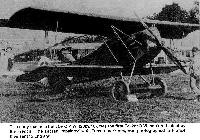 |
Сайт - Pilots-and-planes /WWW/
|
| This early machine built by O.A.W. (2009/18), was the first Fokker D.VII captured intact by the French. The aircraft, repainted with French markings, was photographed in France then sent to England.
|
 |
J.Herris, J.Leckscheid - Fokker Aircraft of WWI. Vol.5: 1918 Designs Part 2: D.VII & E.V/D.VIII /Centennial Perspective/ (55)
|
Fok. D.7. (O.A.W.) 2009/18 was the first D.VII to fall into Entente hands intact. This photo taken by its new owners reveals some interesting details of the early O.A.W.-built machines. The nose was painted dark green with mauve patches, and it appears the mauve was blended into the green when the paint was still wet, resulting in a “cloudy” appearance.
The military number has been painted in black on the rear cabane strut and in white on the base of the prop blade. The maintenance access doors on the right side panel were similar in shape to those used by Fokker, as was the low-exiting dual exhaust. Unlike Fokker, O.A.W. did not mount a manufacturer's plate onto the side panel.
The light-colored wing rib tapes are usually referred to as being light blue. However, they may have been cut from plain linen in order to use up remaining stocks of this material.
O.A.W. never adopted the “streaked” fuselage appearance. Aircraft from the first production batch were, as far as can be determined, predominantly covered in four-color fabric.
|
 |
J.Herris, J.Leckscheid - Fokker Aircraft of WWI. Vol.5: 1918 Designs Part 2: D.VII & E.V/D.VIII /Centennial Perspective/ (55)
|
| This very clear picture of newly-delivered D.7. O.A.W. 2010/18 shows that O.A.W. followed Idflieg regulations in exemplary fashion. The military number was to be applied to all major components, and it is seen here in black - on the forward landing gear strut, rear cabane strut, the bottom of the rudder and the forward "N"-strut. The fuselage number has already been re-located - compared to 2001/18 it is applied further behind the cross, but still positioned somewhat high. (Peter M. Grosz Collection/STDB)
|
 |
J.Herris, J.Leckscheid - Fokker Aircraft of WWI. Vol.5: 1918 Designs Part 2: D.VII & E.V/D.VIII /Centennial Perspective/ (55)
|
| Photographed just after delivery to the front in mid-May 1918, the left side of the nose of Fok. D.7. (O.A.W.) 2010/18 shows a user-friendly innovation that remained exclusive to O.A.W.-built aircraft. On the left upper cowling panel, a narrow rectangular maintenance door was installed to allow easy access to the inside without removal of the panel. The cloudy nose painting shows well here, and the military number was also painted onto the forward landing gear strut. In Jasta service, the nose and struts were often covered with paint, making identification of individual aircraft fairly challenging.
|
 |
J.Herris, J.Leckscheid - Fokker Aircraft of WWI. Vol.5: 1918 Designs Part 2: D.VII & E.V/D.VIII /Centennial Perspective/ (55)
|
| The three-quarter rearview of the plane shows the orientation of the four-color fabric on the fuselage. On this plane, the military number was applied to the rudder but not to the fin. O.A.W.-built aircraft had the lifting handles on the rear lower longerons, seen below the military number, were curved upwards. The other two manufacturers mounted these downwards, but in service sometimes the maintenance crews adapted the O.A.W. style on D.VIIs from the other two manufacturers. (Peter M. Grosz Collection/STDB)
|
 |
J.Herris, J.Leckscheid - Fokker Aircraft of WWI. Vol.5: 1918 Designs Part 2: D.VII & E.V/D.VIII /Centennial Perspective/ (55)
|
| The first examples of the O.A.W.-built D.VIIs that reached the front in mid-May 1918 carried national markings that were similar to those of the Fokker-built machines of the same vintage. The rudder cross was placed in a similar position, but O.A.W. always painted the entire tail fin white - though a few very early examples may have had these components covered with plain varnished linen. The works number was applied to the lower section of the rudder, here on the left side, and the weights table, datum line and military number on the fuselage were applied in white. The white “Fok. D.7.(O.A.W.) 2010/18” behind the fuselage cross was positioned fairly high, the "/18” being aligned with the horizontal arm of the cross. Just visible is the upper wing cross which, on early O.A.W.-built aircraft, did not touch the aileron.
|
 |
J.Herris, J.Leckscheid - Fokker Aircraft of WWI. Vol.5: 1918 Designs Part 2: D.VII & E.V/D.VIII /Centennial Perspective/ (55)
|
| Fokker D.VII (O.A.W.) 2035/18 of 22-victory Pour le Merite ace Rudolf Windisch, Jasta 66. Vzfw. Erich Sonneck is in the foreground. The aircraft carries the Weisser Hirsch Sanatorium stag insignia and yellow shield. The red/white/black markings on the tail shown in the profile were the Jasta 66 unit markings. (Greg VanWyngarden)
|
 |
J.Herris, J.Leckscheid - Fokker Aircraft of WWI. Vol.5: 1918 Designs Part 2: D.VII & E.V/D.VIII /Centennial Perspective/ (55)
|
| 27-victory ace Karl Thom is seated here in his new D.VII (O.A.W.) 2052/18 after his personal "T" and the unit marking of a black and white fuselage band had been applied to the aircraft. The nose and tail were also painted in a dark color thought to have been black. His writings imply that he scored his last 13 victories (plus one unconfirmed) flying this plane between 11 June and 4 August 1918. A week later, he was severely injured in the hip during aerial combat but brought the plane down in a safe landing. He only returned to his unit on 6 November, and found the plane still waiting for him. Not wanting to hand over his trusted "horse", as he called it, to the Entente as required by the Armistice agreement, he deliberately crashed it on 9 November, and was wounded again in the process. (Peter M. Grosz Collection/STDB)
|
 |
J.Herris, J.Leckscheid - Fokker Aircraft of WWI. Vol.5: 1918 Designs Part 2: D.VII & E.V/D.VIII /Centennial Perspective/ (55)
|
| A close view of the tail of Karl Thom's D.VII (O.A.W.) 2052/18 reveals a few early changes in factory markings: The fuselage cross has already slimmed down somewhat - compare it to the one seen on D.VII 402/18. The (partially overpainted) military number on the fuselage was now centered with the horizontal cross arm - it would remain in this position as long as the serial was applied in white. Rarely seen in photos is the application of the military number on both the fin and rudder, and the “Albatros” logo on the upper corner of the rudder was often seen on early-production aircraft.
|
 |
J.Herris, J.Leckscheid - Fokker Aircraft of WWI. Vol.5: 1918 Designs Part 2: D.VII & E.V/D.VIII /Centennial Perspective/ (55)
|
| An early aircraft from the first O.A.W. batch is seen here serving with Jasta 27, likely photographed in July or August 1918. The crosses show signs of modification, initially they were probably similar to those seen on Thom's aircraft. The military number cannot be deciphered in the photo, the white /18 on the rear fuselage is barely visible, but this was an aircraft approximately from the 2050/18 - 2080/18 range, and it most likely reached the unit in early to mid-June 1918. The pilot seen on the right, leaning against the left lower wing and holding his walking stick, is Lt. Friedrich Noltenius, who only joined the unit on 15 July 1918, coming from Jastaschule II. This indicates that the plane was "pre-owned", and his personal markings of the red and white Hanseatic stripes probably covered an earlier marking. These stripes were a reference to his hometown Bremen. Seen next to him is his brother Armin, who was not a member of Jasta 27 but merely visited his brother in his new unit. (Peter M. Grosz Collection/STDB)
|
 |
J.Herris, J.Leckscheid - Fokker Aircraft of WWI. Vol.5: 1918 Designs Part 2: D.VII & E.V/D.VIII /Centennial Perspective/ (55)
|
| Almost exactly two months after joining the Jasta, on 14 September, Noltenius brought down an observation balloon as his seventh confirmed victory. His personal diary recorded that this balloon went up in flames about 50 meters in front of him during the attack, and he actually flew right through the explosion. This photo was taken after his safe landing at Aniche airfield following the event, and vividly documents what happened. Shreds of balloon fabric got caught in the struts and on the tailplane, and the fuselage fabric of his D.VII had suffered considerable damage as well. In that condition, the aircraft could no longer be considered airworthy, and it was probably soon returned to the nearest Armee Flugpark or a repair facility in Germany for a thorough overhaul. (Peter M. Grosz Collection/STDB)
|
 |
J.Herris, J.Leckscheid - Fokker Aircraft of WWI. Vol.5: 1918 Designs Part 2: D.VII & E.V/D.VIII /Centennial Perspective/ (55)
|
| If the difficult to decipher military number on the wheel cover is anything to go by, this photo shows Fokker D.7. (O.A.W.) 2090/18. By that number, the factory at Schneidemuhl had begun to apply the thin Balkenkreuz markings with 5:4 cross arm proportions to their products. The smiling pilot standing next to the plane is Jasta 45 pilot Lt. Ulrich Konnemann, who joined the unit on 23 May 1918. The photo was probably taken some time in late June, right after he had received his new plane and had it painted in his personal colors. Konnemann served with the Staffel right up to the Armistice and was credited with four confirmed victories. His last personal victory was also the 113th and final victory of Jagdstaffel 45, which he scored at around 11:05 a.m. on 30 October 1918. (Peter M. Grosz Collection/STDB)
|
 |
J.Herris, J.Leckscheid - Fokker Aircraft of WWI. Vol.5: 1918 Designs Part 2: D.VII & E.V/D.VIII /Centennial Perspective/ (55)
|
| A mixed lineup of Jagdstaffel 45 aircraft, most likely photographed at the units airfield north-east of Arcy-Sainte-Restitue during the second half of June 1918. Closest to the camera are six newly-arrived Fokker D.7. (O.A.W.) fighters, seen behind them are the five remaining Albatros D.Va fighters. The photo documents that that Jagdstaffel 45 was initially only half-equipped with the new Fokker fighter. Konnemann's aircraft is seen third from left, and in this halftone picture the two-color fuselage band appears in a different tonality when compared to the photo above. (Peter M. Grosz Collection/STDB)
|
 |
J.Herris, J.Leckscheid - Fokker Aircraft of WWI. Vol.5: 1918 Designs Part 2: D.VII & E.V/D.VIII /Centennial Perspective/ (55)
|
| A post-war image of D.7. (O.A.W.) 2113/18 with a group of Entente pilots posing around the tail, offering a good look at the application of the military number on the tail fin and rudder. The stripes on the horizontal tailplane identify it as an aircraft formerly operated by Jagdstaffel 71, and in fact it was the personal mount of the Staffelfuhrer, Lt.d.R. Hermann Stutz. A bracing wire connects the tail fin and the forward horizontal tailplane. These steel-tube components sometimes went a bit out of shape as a result of violent combat maneuvers. The light-colored rib tapes seen here and on many O.A.W.-built D.VIIs are usually interpreted as being light blue, but they may have simply been plain linen. This would have allowed to use up remaining stocks of this material for a useful purpose without the need to paint it. (Peter M. Grosz Collection/STDB)
|
 |
J.Herris, J.Leckscheid - Fokker Aircraft of WWI. Vol.5: 1918 Designs Part 2: D.VII & E.V/D.VIII /Centennial Perspective/ (55)
|
| Again the military number on the wheel cover is almost impossible to decipher, but in combination with available unit documents, this photo most likely shows D.7. O.A.W. 2141/18. The plane flew with Jagdstaffel 75, and thanks to the research by Bruno Schmaling we know that it was the personal mount of Lt. Lothar Haussler. His personal marking consisted of his ornate "LH" monogram and a pair of butcher's cleavers - his parents ran a butcher shop! The large cooling slots on the triangular rear side panels could be mistaken as coming from a late-production, but the arrangement and style of the slots and the missing circular maintenance door on this component indicate that this panel was likely modified by the Jasta 75 maintenance crew. (Bruno Schmaling)
|
 |
J.Herris, J.Leckscheid - Fokker Aircraft of WWI. Vol.5: 1918 Designs Part 2: D.VII & E.V/D.VIII /Centennial Perspective/ (55)
|
| Although the military numbers of this airplane have been covered by the blue and white paint used by Jagdstaffel 12 during the summer of 1918, the crosses of 5:4 proportions indicate that this plane was a late example from the first O.A.W. production batch. The fully-cowled high-mounted saxophone exhaust was now becoming common. The tents in the background indicate that the photograph was taken at Mesnil-Bruntel aerodrome, where Jasta 12 remained until 12 July 1918. The broom on the fuselage was the personal marking of Lt. Hans Besser, who joined the unit around this time. "Besen ist Besser" ("broom is Besser'' - one should keep in mind that the family name means "better" in German!) was a popular keyword amongst the pilots of Jagstaffel 12 in the summer of 1918. Besser is known to have flown at least two other D.VIIs later. He was credited with two victories over American D.H.4s in September 1918 and remained with the unit until the end of the conflict. (Alex Imrie)
|
 |
J.Herris, J.Leckscheid - Fokker Aircraft of WWI. Vol.5: 1918 Designs Part 2: D.VII & E.V/D.VIII /Centennial Perspective/ (55)
|
| The second O.A.W. batch was numbered 4000/18 - 4199/18 and pictured here is 4006/18 at Adlershof. Idflieg regularly picked random aircraft fresh out of the factory in order to check them thoroughly, and seems to have been the case in this instance. The position and 5:4 proportions of the crosses were typical for the early aircraft from this batch. Serials on the horizontal tail surfaces were still applied with the "D.7" prefix. On O.A.W.-built aircraft, the military number on the tailplane was usually only applied on the left side. (Peter M. Grosz Collection/STDB)
|
 |
J.Herris, J.Leckscheid - Fokker Aircraft of WWI. Vol.5: 1918 Designs Part 2: D.VII & E.V/D.VIII /Centennial Perspective/ (55)
|
| Fokker D.7 O.A.W. 4068/18 is seen here on the Kest 1b airfield at Karlsruhe in the summer of 1918. The crosses are still applied in a manner identical to 4006/18, and besides the personal "M" marking the aircraft is still in factory finish. (Greg VanWyngarden)�
|
 |
J.Herris, J.Leckscheid - Fokker Aircraft of WWI. Vol.5: 1918 Designs Part 2: D.VII & E.V/D.VIII /Centennial Perspective/ (55)
|
| Although the personal "Mercedes Star" marking of Jasta 60 pilot Lt. Karl Waldemar Ritscherle has obscured the first two digits of the works number, the absence of the circular maintenance panel and the cross-arms of equal proportions are enough to identify this as "Fok.D VII.(O.A.W.) 4198/18". Three French and one British cockade were painted over the fuselage fabric bullet hole patches. (Peter M. Grosz Collection/STDB; also Bruno Schmaling)
|
 |
J.Herris, J.Leckscheid - Fokker Aircraft of WWI. Vol.5: 1918 Designs Part 2: D.VII & E.V/D.VIII /Centennial Perspective/ (55)
|
| The cloudy painting of the nose quickly made way to a more pragmatic style of applying the dark green and mauve colors. This resulted in a “giraffe”-like appearance, and probably less cleaning of the brushes at the factory paintjob. This unidentified D.VII was most likely a late aircraft from the second O.A.W. production batch (4000/18 - 4199/18). Upgrades included the high-exiting, “saxophone” style exhaust which was still fully enclosed by the upper cowling panels. The large side panel gained ten small cooling louvres resembling a cheese grater, and a small circular maintenance door was added to the lower fuselage side for the same purpose, a triangular access door was mounted a bit higher, and this had a single ventilation opening.
|
 |
J.Herris, J.Leckscheid - Fokker Aircraft of WWI. Vol.5: 1918 Designs Part 2: D.VII & E.V/D.VIII /Centennial Perspective/ (55)
|
| Fok. D VII.(O.A.W.) 4464/18 was an early aircraft from the third O.A.W. batch. It was the personal plane of Lt. Hans Jungwirth, Jasta 78b at Buhl. This is one of the D.VIIs powered by an overhauled example of a 1917-built Mercedes D.III engine, note the rocker arm boxes being located above the cylinders. This explains also why a propeller from an O.A.W.-built Albatros D.Va has been fitted in the original of the above photo the white "AWS D5a" inscription can be discerned. Both the pilot and his aircraft survived the war. (Peter M. Grosz Collection/STDB; also Bruno Schmaling)
|
 |
J.Herris, J.Leckscheid - Fokker Aircraft of WWI. Vol.5: 1918 Designs Part 2: D.VII & E.V/D.VIII /Centennial Perspective/ (55)
|
|
|
 |
J.Herris, J.Leckscheid - Fokker Aircraft of WWI. Vol.5: 1918 Designs Part 2: D.VII & E.V/D.VIII /Centennial Perspective/ (55)
|
| Jagdstaffel 35b received six O.A.W.-built Fokker D.VII on 24 August 1918, and 4487/18 became the personal plane of Lt. Friedrich Stoer. The story behind the markings of this plane is told in "Jasta Colors Volume 1", also published by Aeronaut books. (Bruno Schmaling)
|
 |
J.Herris, J.Leckscheid - Fokker Aircraft of WWI. Vol.5: 1918 Designs Part 2: D.VII & E.V/D.VIII /Centennial Perspective/ (55)
|
The numerically next aircraft was 4488/18, and it was operated by Jagdstaffel 71. It is seen here in a post-war photo. The different quality of factory paint versus that used in the field is vividly illustrated: while the factory-applied black and white show no signs of wear at all, the white marking applied on the tailplane and fuselage has flaked off considerably.
D.VII (O.A.W.) 4488/18 in American hands. The fighter is fully armed and appears to be in original colour scheme. Spad XIII fighters of the 138th Aero Squadron are in the background.
|
 |
J.Herris, J.Leckscheid - Fokker Aircraft of WWI. Vol.5: 1918 Designs Part 2: D.VII & E.V/D.VIII /Centennial Perspective/ (55)
|
| The Jagdstaffeln were constantly on the move, and when they were transferred to a more distant location aircraft were disassembled for transport by rail or truck. Here, the fuselage of Fok.D VII.(O.A.W.) 4489/18 from Jagdstaffel 32b "E" is seen next to Pfalz D.XII 2454/18. The small circular maintenance door that was introduced on the third O.A.W. batch can be seen well here, below the "cheese grater" cooling louvers. (Peter M. Grosz Collection/STDB)
|
 |
J.Herris, J.Leckscheid - Fokker Aircraft of WWI. Vol.5: 1918 Designs Part 2: D.VII & E.V/D.VIII /Centennial Perspective/ (55)
|
| Vizeflugmeister Franz Mayer and two of mechanics pose in front of what must be his Fok. D VII. (O.A.W.) 4499/18. The colors of the aircraft are described by his combat report from 5 September 1918: A white fuselage with black stripes and yellow nose and tail surfaces. Not doubt the wheels were yellow as well, and the fuselage may also have been yellow, too. A close look reveals that the cross is lighter than usual, compare with 4488/18, for example, and shows streaks that indicate some sort of overpainting. (Peter M. Grosz Collection/STDB)
|
 |
J.Herris, J.Leckscheid - Fokker Aircraft of WWI. Vol.5: 1918 Designs Part 2: D.VII & E.V/D.VIII /Centennial Perspective/ (55)
|
| Another Fok.D VII.(O.A.W.) delivered to Jagdstaffel 35b on 24 August was 4523/18, which was the plane flown by the Staffelfuhrer Lt. Rudolf Stark. He chose lilac as his personal color, and the tail and nose were painted accordingly, and to the fuselage band a narrow black outline was added. (Reinhard Kastner)
|
 |
J.Herris, J.Leckscheid - Fokker Aircraft of WWI. Vol.5: 1918 Designs Part 2: D.VII & E.V/D.VIII /Centennial Perspective/ (55)
|
Line up of Jasta 35b aircraft, showing Stark’s machine closest to the camera, in the middle stage of it's markings.
At some point during production of the second half of the second O.A.W. production batch (4000/18 - 4199/18), the fuselage military number was placed ahead of the fuselage cross and was, as well as the datum line and weights table, applied in black. The Arabic “7” made way to the Roman “VII” used by the other two manufacturers. The crosses were slimmed down considerably during manufacture of the second and third batches, and eventually matched the prescribed 8:1 proportions. During production of the third batch (4450/18 - 4649/18) the tail cross began to be applied onto the rudder only, and both styles of crosses can be seen in this lineup of Jasta 35b D.VIIs from this batch. On these aircraft, the wing crosses were positioned far outboard, the horizontal cross arms touched the wingtips.
|
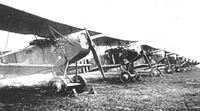 |
J.Herris, J.Leckscheid - Fokker Aircraft of WWI. Vol.5: 1918 Designs Part 2: D.VII & E.V/D.VIII /Centennial Perspective/ (55)
|
| View of Jasta 35b fighters lined up in perfect position on the occasion of the visit of General von Bruck on 14 September 1918, Lieu-Saint-Amand airfield. The uniform angled arrangement of the props was only arrived at after much discussion, according to Rudolf Stark. He also wittingly remarked that there was no regulation concerning this detail - yet! Five OAW.-built D.VIIs head the lineup, 4523/18, the personal plane of Staffelfuhrer Lt. Rudolf Stark being the plane closest to the camera, heads the row of aircraft. Additional cooling louvers have been cut into the upper engine cowlings by the mechanics of the Stoffel. The five Pfalz D.XII seen at the far end were delivered to the unit on 1 September, and were only accepted after much discussion. Additional D.VIIs were delivered to the unit in the coming weeks, as new pilots arrived at Jasta 35b. (Peter M. Grosz Collection/STDB)
|
 |
J.Herris, J.Leckscheid - Fokker Aircraft of WWI. Vol.5: 1918 Designs Part 2: D.VII & E.V/D.VIII /Centennial Perspective/ (55)
|
| Following the grounding of the Fokker E.V in late August, Jagdstaffel 6 received a shipment of O.A.W.-built D.VIIs to replace the "Parasols". Here Lt. Werner Noldecke poses with 4532/18; the military number has been re-marked on the forward fuselage fabric. Again, additional information on the plane and pilot can be found in in "Jasta Colors Volume 1". (Bruno Schmaling & Peter M. Grosz Collection/STDB)
|
 |
J.Herris, J.Leckscheid - Fokker Aircraft of WWI. Vol.5: 1918 Designs Part 2: D.VII & E.V/D.VIII /Centennial Perspective/ (55)
|
| Black and white striped D.VIIs also flew with Jagdstaffeln 5 and 52, and seen here is the famous example from the former unit. Fokker D.VII (O.A.W.) 4598/18 was the personal plane of 35-victory ace Lt. Otto Konnecke. He was decorated with the Pour le Merite on 26 September 1918, and while he went on the usual leave that was granted along with the awards, his fellow comrade Josef Mai borrowed the plane. The latter promptly scored his victories # 29 and 30 while flying it on 27 and 29 September. Mai survived the war and passed away on 18 January 1982 at the age of 94 years. (Peter M. Grosz Collection/STDB)
|
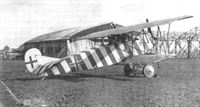 |
J.Herris, J.Leckscheid - Fokker Aircraft of WWI. Vol.5: 1918 Designs Part 2: D.VII & E.V/D.VIII /Centennial Perspective/ (55)
|
| After returning to Jasta 5, Konnecke resumed his scoring by being credited with his 32nd victory on 18 October. He added another victory on 01 November, and took part in the last major engagement that Jasta 5 was involved in. On 4 November, a trio of 57 Sqn RAF D.H.4s were brought down by Jasta 5 at around 11:45. Two of these opponents were credited to Konnecke, and most likely he was again flying 4598/18 during this combat. Konnecke died on 25 January 1956, aged 63. (Peter M. Grosz Collection/STDB)
|
 |
J.Herris, J.Leckscheid - Fokker Aircraft of WWI. Vol.5: 1918 Designs Part 2: D.VII & E.V/D.VIII /Centennial Perspective/ (55)
|
| His aircraft was amongst several Jasta 5 Fokker D.VIIs that were handed over to the RAF after the armistice. It must be pointed out that this plane did not carry the usual unit markings of a green tail with a narrow red outline. This marking can be made out on several aircraft that were photographed at Nivelles after the war, and the lack of this marking indicates the status that Konnecke must have had at Jasta 5 at the time.
|
 |
J.Herris, J.Leckscheid - Fokker Aircraft of WWI. Vol.5: 1918 Designs Part 2: D.VII & E.V/D.VIII /Centennial Perspective/ (55)
|
| On 9 November 1918, Jasta 65 pilot Heinz Freiherr von Beaulieu-Marconnay landed his Fokker D.VII (O.A.W.) 4635/18 " U.10"close to the 95th Aero Squadron airfield near Verdun. At its landing point, the plane was disassembled and then transported to the nearby USAS fighter unit. As shown in these views, the original fuselage cross on both sides, as well as the 95th AS unit marking on the left side were souvenired at an early stage, and were quickly patched over. The fuselage cross has been re-applied in an undersized manner. Heinz was a very experienced pilot with more than two years of service with FA 2, Jasta 7, and Kest 5 before he was posted to Jasta 65 on 27 August, coming from AFP C ."U.10" is now on display in the NASM.
|
 |
J.Herris, J.Leckscheid - Fokker Aircraft of WWI. Vol.5: 1918 Designs Part 2: D.VII & E.V/D.VIII /Centennial Perspective/ (55)
|
| After the plane had been re-assembled at the airfield of the 95th Aero Squadron, the "kicking mule" insignia of the unit was applied below the cockpit. In this photo, the large original fuselage cross is still in place. Heinz was the brother of the Pour le Merite-decorated ace Olivier von Beaulieu-Marconnay, who died on 26 October from injuries suffered from friendly fire on the 10th of the same month. It was variously reported that Heinz defected, lost his way in poor weather, or simply became disillusioned by the course of the war and simply landed "somewhere". In any case, his aircraft survives in restored shape at the NASM to this day.
|
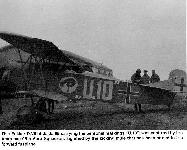 |
Сайт - Pilots-and-planes /WWW/
|
| This Fokker D.VII of Jasta 65 carrying the personal markings "U.10", was captured by the American 95th Aero Squadron, signified by the kicking mule that has been added to the forward fuselage.
|
 |
J.Herris, J.Leckscheid - Fokker Aircraft of WWI. Vol.5: 1918 Designs Part 2: D.VII & E.V/D.VIII /Centennial Perspective/ (55)
|
| A closeup view of "U.10" soon after capture allows a closer look at the level of detail with which the "kicking mule" insignia was applied by the 95th Aero Squadron painter. The fuselage side fabric is still in its original form.
|
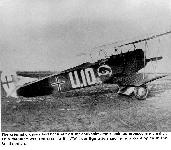 |
Сайт - Pilots-and-planes /WWW/
|
| The original crosses had been cut off for souvenirs, the repainted crosses are smaller. This machine was restored to its WW I configuration and is now on display in the Smithsonian.
|
 |
J.Herris, J.Leckscheid - Fokker Aircraft of WWI. Vol.5: 1918 Designs Part 2: D.VII & E.V/D.VIII /Centennial Perspective/ (55)
|
| The original large fuselage cross on the right side was also souvenired while in possession of the 95th, and then patched over. A smaller Balkenkreuz was then applied in an identical manner as the one on the left. An inscription denoting the date of capture as well some other details was added between the "10" and the kicking mule. The white outline of the upper wing crosses has almost worn off, which was rarely seen on the D.VII and other German fighters.
|
 |
J.Herris, J.Leckscheid - Fokker Aircraft of WWI. Vol.5: 1918 Designs Part 2: D.VII & E.V/D.VIII /Centennial Perspective/ (55)
|
| Fokker D.VII "U.10" is being unloaded at the 95th AS airfield. The original style of application of the "U.10"marking, applied as"U.10". on the upper wing, is clearly visible.
|
 |
J.Herris, J.Leckscheid - Fokker Aircraft of WWI. Vol.5: 1918 Designs Part 2: D.VII & E.V/D.VIII /Centennial Perspective/ (55)
|
| Fokker D.VII "U.10" before restoration on display at the NASM annex.
|
 |
J.Herris, J.Leckscheid - Fokker Aircraft of WWI. Vol.5: 1918 Designs Part 2: D.VII & E.V/D.VIII /Centennial Perspective/ (55)
|
| "U.10" on display in its first guise at the NASM before restoration. The patched-over fabric below the cockpit and the replacement fuselage cross can be made out well in this side view.
|
 |
J.Herris, J.Leckscheid - Fokker Aircraft of WWI. Vol.5: 1918 Designs Part 2: D.VII & E.V/D.VIII /Centennial Perspective/ (55)
|
| Fokker D.VII "U.10" on display at NASM.
|
 |
J.Herris, J.Leckscheid - Fokker Aircraft of WWI. Vol.5: 1918 Designs Part 2: D.VII & E.V/D.VIII /Centennial Perspective/ (55)
|
| Uffz. Alfred Bader and two of his mechanics pose by the nose of the aircraft. The military number 4649/18 can be read clearly on the wheel hub and struts in this wonderful photo. The two other Jasta 65 D.VIIs that can be seen in the background lack personal markings on the fuselage. Thus it seems that the "Sieben Schwaben" is newly applied. (Tobias Weber)
|
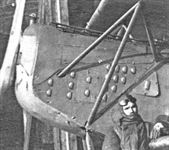 |
J.Herris, J.Leckscheid - Fokker Aircraft of WWI. Vol.5: 1918 Designs Part 2: D.VII & E.V/D.VIII /Centennial Perspective/ (55)
|
| D.VII (O.A.W.) 4649/18 was the last aircraft of the third O.A.W. production batch and flew with Jagdstaffel 65, where the nose and fuselage were fully overpainted. The nose panels gained another eight cooling louvres on its forward section. The circular access door can just be seen behind the shoulder of the pilot. On this aircraft, the upper cowling panel considerably overlaps the side panels, almost touching the forward and rear cabane struts. This detail was also noted on some other O.A.W.-built D.VIIs, but it remained fairly rare. The radiator filler neck was still centrally positioned, and openings have been added into the radiator matrix in order to improve cooling of the forward engine cylinder.
|
 |
J.Herris, J.Leckscheid - Fokker Aircraft of WWI. Vol.5: 1918 Designs Part 2: D.VII & E.V/D.VIII /Centennial Perspective/ (55)
|
| Bader joined Jagdstaffel 65 on 31 August 1918, coming from Jastaschule II, just four days after Lt. Heinz von Beaulieu-Marconnay arrived. The photographs on these two pages were taken in October 1918 at La Ferte airfield. (Peter M. Grosz Collection/STDB)
|
 |
J.Herris, J.Leckscheid - Fokker Aircraft of WWI. Vol.5: 1918 Designs Part 2: D.VII & E.V/D.VIII /Centennial Perspective/ (55)
|
| We have to thank historian Tobias Weber for correcting an old mistake concerning the pilot of the famous "Die Sieben Schwaben". It was actually the personal plane of Uffz. Alfred Bader. (Tobias Weber)
|
 |
J.Herris, J.Leckscheid - Fokker Aircraft of WWI. Vol.5: 1918 Designs Part 2: D.VII & E.V/D.VIII /Centennial Perspective/ (55)
|
| It seems fitting that, being the last aircraft of the third O.A.W. production batch, 4649/18 received some of the most spectacular personal markings seen. This view of the left side of the fuselage proves that the design of the artwork differed from the one seen on the right. The cowling chin panel looks considerably lighter than in the previous photo. Jasta 65 ended the war at Tichemont, and the background suggests this duo of photos was taken shortly before the Armistice. Bader was credited with two victories over Salmson two seaters, the first one on 2 October and the second one on 8 November. This was also the 34th and final victory credited to the unit. (Peter M. Grosz Collection/STDB)
|
 |
J.Herris, J.Leckscheid - Fokker Aircraft of WWI. Vol.5: 1918 Designs Part 2: D.VII & E.V/D.VIII /Centennial Perspective/ (55)
|
| On 20 October Jasta 65 transferred to Tichemont airfield where this and the photo on the opposite page were taken. It may be interesting to note that the upper engine panel overlapped the side panel, almost touching the forward interplane strut. Late aircraft from the third O.A.W. batch typically carried the number and arrangement of cooling louvers seen here. The fuselage and nose shown in the profile are unconfirmed. They are based on the colors recorded for "U. 10." of the same unit. (Peter M. Grosz Collection/STDB)
|
 |
J.Herris, J.Leckscheid - Fokker Aircraft of WWI. Vol.5: 1918 Designs Part 2: D.VII & E.V/D.VIII /Centennial Perspective/ (55)
|
| Jasta 75 pilot Lt. Heinrich Lux and his mechanic pose with Fok.DVII. (O.A.W.) 6316/18 at Habsheim airfield. The most visible upgrade to the fourth batch is the long cooling louvers, and on the first few dozen examples those on the forward panel had a flat profile. Those on the triangular-shaped panel already had the later, more pointed shape. The fuselage (and presumably the wings) are covered in five-color fabric. (Peter M. Grosz Collection/STDB)
|
 |
C.Owers - Fokker Aircraft of WWI. Vol.7: Postwar /Centennial Perspective/ (67)
|
| There are three D.VII in this photograph. D.VII (O.A.W.) 6318/18 is the only one that can be identified.
|
 |
J.Herris, J.Leckscheid - Fokker Aircraft of WWI. Vol.5: 1918 Designs Part 2: D.VII & E.V/D.VIII /Centennial Perspective/ (55)
|
| Three mechanics of Jasta 12 dressed up as pilots pose next to the personal aircraft of the Staffelfuhrer, Lt. Hermann Becker. The military number marked on the wheel cover reads Fok.D VII.(O.A.W.) 6340/18, and the photo was likely taken in October 1918 at Carignan or Florenville. The left aileron was repaired or is a replacement part, lacking the lower section of the Balkenkreuz. Two of the rib-tapes have been reinforced. The aircraft survived the war and appears on a list of D.VIIs inspected at Coblenz dated 1 January 1919. From this we learn that it was in unserviceable condition and was powered by Mercedes D.IIIau 43025. Hermann Becker survived the war with a total of 23 confirmed victories. (Alex Imrie)
|
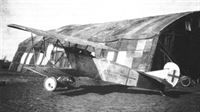 |
C.Owers - Fokker Aircraft of WWI. Vol.7: Postwar /Centennial Perspective/ (67)
|
| OAW built 6344/18 in full Jasta colours and individual fuselage marking, in British hands post-Armistice, at Bavay on 11 March 1919. Possibly a Jasta 58 machine.
|
 |
J.Herris, J.Leckscheid - Fokker Aircraft of WWI. Vol.5: 1918 Designs Part 2: D.VII & E.V/D.VIII /Centennial Perspective/ (55)
|
| Oblt. Amandus Rostock took command of Jasta 76b on 7 October 1918, and is seen here joining up with his groundcrew, who are conducting maintenance on his new Fok.DVII. (O.A.W.) 6372/18. The airframe was covered in five-color fabric, and the tail of Uffz. Josef Bauer's Fok.DVII. (O.A.W.) is just visible in the background.
|
 |
J.Herris, J.Leckscheid - Fokker Aircraft of WWI. Vol.5: 1918 Designs Part 2: D.VII & E.V/D.VIII /Centennial Perspective/ (55)
|
| Rostock's Fok.D VII. (O.A.W.) 6372/18 is seen here after it was fully painted in his personal scheme. Note the outboard position of the upper wing crosses. (Bruno Schmaling)
|
 |
J.Herris, J.Leckscheid - Fokker Aircraft of WWI. Vol.5: 1918 Designs Part 2: D.VII & E.V/D.VIII /Centennial Perspective/ (55)
|
| Uffz. Josef Geyer is smiling happily into the camera from the cockpit of his new D.VII. The serial visible on the forward landing gear strut identifies this as O.A.W.-built 6381/18, seen here after it was fully painted in his personal scheme. The fuselage of this plane was covered in four-color fabric, and the lower wing crosses are now located further inboard. More information on the history of Jagdstaffel 76 and the aircraft of this unit can be found in "Royal Bavarian Jagdstaffel 76", also published by Aeronaut Books. (Bruno Schmaling)
|
 |
J.Herris, J.Leckscheid - Fokker Aircraft of WWI. Vol.5: 1918 Designs Part 2: D.VII & E.V/D.VIII /Centennial Perspective/ (55)
|
| Fok.DVII. (O.A.W.) 6428/18 was the personal plane of Jasta 71 pilot Hans-Joachim von Hippel. The aircraft was covered in five-color fabric, and the outboard position of the wing crosses may be noted. He received this plane on 2 October 1918, and this photograph seems to have been taken soon after the striped tail unit marking and his personal "Lude" inscription had been applied. (Peter M. Grosz Collection/STDB)
|
 |
J.Herris, J.Leckscheid - Fokker Aircraft of WWI. Vol.5: 1918 Designs Part 2: D.VII & E.V/D.VIII /Centennial Perspective/ (55)
|
| Also photographed on the same occasion at the Jasta 71 airfield at Habsheim was Fok.DVII. (O.A.W.) 6467/18 "Ede", the personal plane flown by Lt. Fritz Oppenhorst. The fuselage was also covered in five-color fabric, and it has won the wheel from 6454/18 in the components lottery. (Peter M. Grosz Collection/STDB)
|
 |
J.Herris, J.Leckscheid - Fokker Aircraft of WWI. Vol.5: 1918 Designs Part 2: D.VII & E.V/D.VIII /Centennial Perspective/ (55)
|
| Fok.DVII. (O.A.W.) 6520/18, seen here in the hands of the 1st Aero Squadron after the war, likely at Trier. This plane had seen previous service with Jagdstaffel 67 and likely reached the unit just a few weeks before the end of the war. The small circular maintenance door is seen opened in this picture.
|
 |
C.Owers - Fokker Aircraft of WWI. Vol.7: Postwar /Centennial Perspective/ (67)
|
| Someone had the foresight to mark the serial 6557 on the top of the rudder of this O.A.W. D.VII.
|
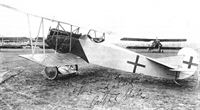 |
C.Owers - Fokker Aircraft of WWI. Vol.7: Postwar /Centennial Perspective/ (67)
|
| Fokker D.VII (O.A.W.) 6587/18 at Trier. 1st Lt Ralph E Spake in the cockpit. The machine is unarmed and a new windscreen fitted. The squadron insignia was later applied to this machine and it was eventually shipped to the US facility at Romorantin.
|
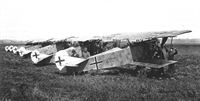 |
C.Owers - Fokker Aircraft of WWI. Vol.7: Postwar /Centennial Perspective/ (67)
|
This is thought to be a photograph taken in the USA when the Fokkers were erected and flown in their original German makings and armament. O.A.W. 8331/18 leads the line-up of six D.VII fighters. The distinctive 'star' on the rudder of the second machine identifies it as 7756/18. Another O.A.W. built D.VII, 8392/18 is third in line.
A post-war lineup shot of six D.VIIs after being handed over to the Entente forces in accordance with the armistice agreement. The first and the third plane in this shot are examples from the final OAW.-batch, the other four are Fokker-built. Closest to the camera is 8331/18, the third plane in the lineup being 8392/18. Both are covered in four-color fabric, while the second-to-last plane seen (Fokker-built) has a five-color fabric fuselage.
|
 |
C.Owers - Fokker Aircraft of WWI. Vol.7: Postwar /Centennial Perspective/ (67)
|
| Fokker D.VII (O.A.W.) 8371/18 with typical O.A.W. painted engine panels
|
 |
C.Owers - Fokker Aircraft of WWI. Vol.7: Postwar /Centennial Perspective/ (67)
|
| D.VII (O.A.W.) 8371/18 in the Exhibition Building, Melbourne. It appears to be when the display was being set up. Note the Australian Air Corps Sopwith Pup in the background.
|
 |
C.Owers - Fokker Aircraft of WWI. Vol.7: Postwar /Centennial Perspective/ (67)
|
| The semi-permanent display at the Exhibition Building in Melbourne. The Fokker D.VII (O.A.W.) 8371/18 is surrounded by aerial bombs with the Vickers Vimy and a Junkers monoplane wing in the background. (AWM photo)
|
 |
Сайт - Pilots-and-planes /WWW/
|
|
|
 |
J.Herris, J.Leckscheid - Fokker Aircraft of WWI. Vol.5: 1918 Designs Part 2: D.VII & E.V/D.VIII /Centennial Perspective/ (55)
|
| This frontal view of Fok.D VII. (O.A.W.) 8425/18 nicely shows a detail typical to many O.A.W.-built D.VIIs: the half green, half mauve-painted axle wing. The wheel covers were painted in these two colors, too, both on the inside and outside. As seen here, the radiator filler neck was offset to the left on late-production aircraft of all three D.VII manufacturers. (Greg VanWyngarden)
|
 |
J.Herris, J.Leckscheid - Fokker Aircraft of WWI. Vol.5: 1918 Designs Part 2: D.VII & E.V/D.VIII /Centennial Perspective/ (55)
|
| On the snow-covered airfield at Koblenz, Fok.D VII. (O.A.W.) 8425/18 poses for the camera. The fuselage of the aircraft is covered in four-color fabric, while the wings are covered in the five-color variant of the material. Beginning early in the fourth batch, O.A.W. began to discontinue the use of light-colored rib tapes and used four- or five-color fabric instead, as seen here. No military number has been applied to the fin or rudder on this plane. By coincidence, the wheel fitted to this plane is that of 8331/18, which heads the above lineup photo. (Greg VanWyngarden)
|
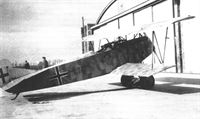 |
C.Owers - Fokker Aircraft of WWI. Vol.7: Postwar /Centennial Perspective/ (67)
|
| OAW built 8487/18 in British hands post-Armistice.
|
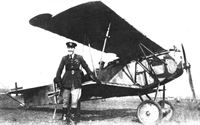 |
C.Owers - Fokker Aircraft of WWI. Vol.7: Postwar /Centennial Perspective/ (67)
|
| S.F. Vincent is standing by Fokker D.VII (O.A.W.) 8488/18. Martingall in cockpit. (via S.F. Vincent)
|
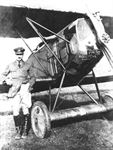 |
C.Owers - Fokker Aircraft of WWI. Vol.7: Postwar /Centennial Perspective/ (67)
|
| Maj E.L. Foot poses with O.A.W. built Fokker D.VII (8492/18). Note writing on cowl includes the date "1/3/19". (via S.F. Vincent)
|
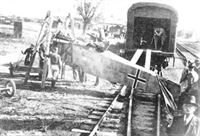 |
C.Owers - Fokker Aircraft of WWI. Vol.7: Postwar /Centennial Perspective/ (67)
|
| This appears to be the setting up the motion picture camera in the railway car in order to record the transportation of war planes surrendered under the Armistice. The fuselage of Fokker D.VII (O.A.W.) 8503/18 is being prepared to be moved. This fighter was returned to the USA and served at Ellington Field at one time. (via R Gentilli)
|
 |
C.Owers - Fokker Aircraft of WWI. Vol.7: Postwar /Centennial Perspective/ (67)
|
| Fokker D.VII (O.A.W.) 8507/18 photographed at Coblenz. Returned to the USA this aircraft participated in the Victory Loan Flying Circus.
|
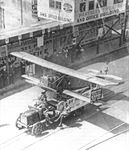 |
C.Owers - Fokker Aircraft of WWI. Vol.7: Postwar /Centennial Perspective/ (67)
|
| O.A.W. D.VII 8508/18 in a Victory Parade in Los Angeles which, according to the attached poster to the interplane struts, was flown by Capt von Richthofen who shot down '80 ALLY Planes.' The legend of the Red Baron already had a hold on popular imagination. The float is to advertise the Far West Flight air show at De Mille Field in April 1919.
|
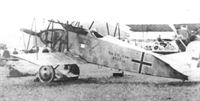 |
C.Owers - Fokker Aircraft of WWI. Vol.7: Postwar /Centennial Perspective/ (67)
|
| 8520/18, one of the four D.VII fighters that were flown by the Victory Loan Eastern Flights in the USA, with another D.VII behind.
|
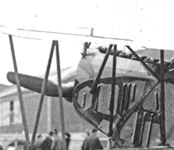 |
J.Herris, J.Leckscheid - Fokker Aircraft of WWI. Vol.5: 1918 Designs Part 2: D.VII & E.V/D.VIII /Centennial Perspective/ (55)
|
| The cooling louvres on O.A.W.-built aircraft from the fourth and fifth production batch were almost identical, and those on the left side almost mirrored the layout of the other side of the nose. One exception was the taller maintenance door on the forward side panel, which usually featured a single louvre. The rectangular maintenance door on the upper panel was a feature of all D.VII's from this manufacturer. On most late-production aircraft the radiator filler neck was positioned on the left, as seen here in a post-war view of D.VII O.A.W. 8520/18.
|
 |
C.Owers - Fokker Aircraft of WWI. Vol.7: Postwar /Centennial Perspective/ (67)
|
| Fokker D.VII (OAW) 8532/18 in its original German markings.
|
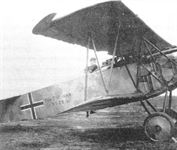 |
C.Owers - Fokker Aircraft of WWI. Vol.7: Postwar /Centennial Perspective/ (67)
|
| Fokker 1st Lt George H. Belser in the cockit of (O.A.W.) 8538/18. The location was Camp Pike, North Little Rock, Arkansas on 13 April 1919, as part of a Victory Loan Flying Circus air show. Belser was then based at Kelly Field, San Antonio, Texas as a flight instructor. On the April-May 1919 Victory Loan Flying Circus tour he was assigned as a Fokker pilot. All the pilots on the tour were initially assigned to fly an airplane type, e.g., Fokker, Spad VII, SE-5a, or Curtiss JN-4H/6H, even though they ended up switching types. Belser flew this Fokker regularly and oftentimes against the British 'ace' Anthony Beauchamp-Proctor, who mostly flew an SE-5a during the air shows. Belser was a good pilot, but he later was involved in an accident in St. Louis on 14 April 1919, when his Fokker ran through a cable barrier on landing, killed one boy, and injured several others. That was a crowd control issue and not Belser's fault. The serial of that Fokker D.VII is unknown. (via R Gentilli)
|
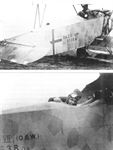 |
C.Owers - Fokker Aircraft of WWI. Vol.7: Postwar /Centennial Perspective/ (67)
|
|
|
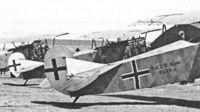 |
J.Herris, J.Leckscheid - Fokker Aircraft of WWI. Vol.5: 1918 Designs Part 2: D.VII & E.V/D.VIII /Centennial Perspective/ (55)
|
| This lineup of aircraft from the last production batch in American hands post-war shows the final application method of the crosses. The small cross centered on the rudder was applied in a way that exactly complied to the official Idflieg requirement which demanded exactly that. Fokker and Albatros did not apply in in this position, but this may have been accepted by the authorities in order to allow a quick “first look” identification of the origin of a specific aircraft to those who knew what to look for. The wing crosses were now applied further inboard in a position that matched that of late Fokker- and Albatros-built planes.
|
 |
C.Owers - Fokker Aircraft of WWI. Vol.7: Postwar /Centennial Perspective/ (67)
|
| 8539/18 leads the line-up of the three Fokker D.VII fighters at Rockwell Field before leaving on their Victory Loan Flying Circus tour of the far west, April-May 1919. An SE-5a and Curtiss Jenny are at the end of the line-up.
|
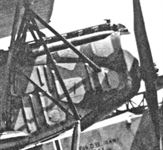 |
J.Herris, J.Leckscheid - Fokker Aircraft of WWI. Vol.5: 1918 Designs Part 2: D.VII & E.V/D.VIII /Centennial Perspective/ (55)
|
| On O.A.W.-built aircraft from the fourth and fifth production batch the “saxophone” style exhaust was exposed to the slipstream. The mauve patches remained to be painted on the dark green nose parts, and the upper panel seen here in a post-war photo of 8539/18 came from a different aircraft - the green seems darker, and the patches don't match. This also happened during service with the Jagdstaffeln. The final two batches featured cooling slots of various sizes, and another identifying feature was the lack of a manufacturer plate below the rectangular maintenance door on the forward side panel. The circular access door in front of the three cooling louvres on the lower rear panel was also unique to O.A.W.-built aircraft, but the side panels were interchangeable between manufacturers.
|
 |
C.Owers - Fokker Aircraft of WWI. Vol.7: Postwar /Centennial Perspective/ (67)
|
| Fokker D.VII (O.A.W.) in French hands with US onlookers.
|
 |
C.Owers - Fokker Aircraft of WWI. Vol.7: Postwar /Centennial Perspective/ (67)
|
| Again a D.VII handed over at the Armistice makes a backdrop for the unit photo. This O.A.W. built machine is identified by the serial stenciled on the bottom of the fin: - x476/18.
|
 |
C.Owers - Fokker Aircraft of WWI. Vol.7: Postwar /Centennial Perspective/ (67)
|
| This O.A.W. D.VII is unarmed with a new windscreen. The rudder markings appear to be non-standard.
|
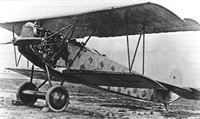 |
C.Owers - Fokker Aircraft of WWI. Vol.7: Postwar /Centennial Perspective/ (67)
|
This brand-new Fokker D.VII at Coblenz, only had its national insignias added to the wings before it was handed over to the US. (via M O'Neal)
Among the planes handed over after the armistice were many factory-fresh. In this O.A.W.-built D.VII, no military numbers or crosses were applied to the fuselage, rudder, or wheel hub, although a white military number is faintly visible on the port aileron. The fuselage is covered in five-color aircraft fabric, and the overdyed edges of the polygons are worth noting. (Peter M. Grosz Collection/STDB)
|
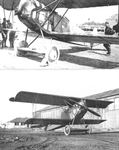 |
C.Owers - Fokker Aircraft of WWI. Vol.7: Postwar /Centennial Perspective/ (67)
|
| Another (O.A.W.) D.VII in the USA, the original caption states it is at Langley Field in 1921. This machine has had its armament removed. (AHT AL0385-07 & AL0385-10)
|
 |
C.Owers - Fokker Aircraft of WWI. Vol.7: Postwar /Centennial Perspective/ (67)
|
| This OAW. D.VII at Mitchell Field has been given a new finish; fabric surfaces are an overall light colour with an interesting cross applied to the rudder. The wing crosses have not been extended over the ailerons. Although the ammunition chutes are still attached, the machine guns have been removed. (AHT 0385-09)
|
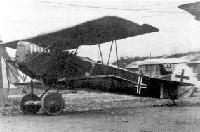 |
В.Обухович, А.Никифоров - Самолеты Первой Мировой войны
|
|
|
 |
J.Herris, J.Leckscheid - Fokker Aircraft of WWI. Vol.5: 1918 Designs Part 2: D.VII & E.V/D.VIII /Centennial Perspective/ (55)
|
| This aircraft "made the rounds" in order to familiarize nearby Jastas with the new biplane fighter. Here it is pictured on the airfield of Jasta Mat Phalempin on 23. May 1918, the Triplanes operated by Jasta 14 can be seen in the distance. Also stationed at this airfield at this time, but not in the photo, was Jagdstaffel 30, which was then operating the Pfalz D.IIIa.
|
 |
C.Owers - Fokker Aircraft of WWI. Vol.7: Postwar /Centennial Perspective/ (67)
|
| The Fokker D.VII obtained by German forces after the invasion of the Netherlands, eventually ended up after WWII on display in the Deutsches Museum, Munich.
|
 |
J.Herris, J.Leckscheid - Fokker Aircraft of WWI. Vol.5: 1918 Designs Part 2: D.VII & E.V/D.VIII /Centennial Perspective/ (55)
|
| Another rare case of decorating an aircraft is documented in the case of Lt. Josef Veltjens' early-production Fokker-built D.VII. While the "24" invited suggestion that a victory number is celebrated here, the photo was actually taken on 2 June 1918 in order to celebrate the 24 birthday of the pilot. The nose of the plane was painted red, while the rest of the fuselage was dark blue, the usual Jasta 15 unit coloring. It appears that the upper wing surfaces were also painted in a uniform color, most likely the aforementioned dark blue, and the wing crosses still have the broad white outline at this point. His personal marking was a winged arrow marked on the fuselage sides. Veltjens was credited with 35 victories and received the Pour le Merits on 16 August 1918. (Peter M. Grosz Collection/STDB)
|
 |
В.Шавров - История конструкций самолетов в СССР до 1938 г.
|
| Самолет "Фоккер" D-VII
|
 |
C.Owers - Fokker Aircraft of WWI. Vol.7: Postwar /Centennial Perspective/ (67)
|
| A post-war post-card of Strasbourg, Alsace. Alsace was ceded to Prussia in 1870 after the Franco-Prussian War. A statue of Kaiser Wilhelm I was mounted on the stone plinth, but after WWI, France regained the province and the Kaiser was removed and a Fokker DVII mounted on the plinth. Its serial and fate are not known.
|
 |
R.Kosin - The German Fighter since 1915 /Putnam/
|
| Fokker D.VII
|
 |
J.Herris, J.Leckscheid - Fokker Aircraft of WWI. Vol.5: 1918 Designs Part 2: D.VII & E.V/D.VIII /Centennial Perspective/ (55)
|
| One of several pilots who took a while to get into their stride was Lt. Kurt Monnington. He had been a fighter pilot for almost eleven months before scoring his initial victory on 11 May 1918. Then the D.VII arrived at Jasta 18, also dubbed Jasta "Raben" (Raven) as a reference to the name of their commander, and his scoring began to pick up. Between June and October he added another seven victories, and very likely the bulk of these were scored while flying this skull and crossbones marked early-production D.VII (O.A.W.). Monnington survived the war but died of pneumonia in Hamburg on 17 February 1939. (Greg VanWyngarden)
|
 |
C.Owers - Fokker Aircraft of WWI. Vol.7: Postwar /Centennial Perspective/ (67)
|
| Scenes from DIII 88 with the Fokker D.VII and Dr.I. The WWI scenes were only a short part of this film which praised the new Luftwaffe.
|
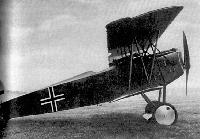 |
В.Обухович, А.Никифоров - Самолеты Первой Мировой войны
|
|
|
 |
J.Herris, J.Leckscheid - Fokker Aircraft of WWI. Vol.5: 1918 Designs Part 2: D.VII & E.V/D.VIII /Centennial Perspective/ (55)
|
| Jasta 4 converted to the D.VII in mid-June 1918, being equipped with O.A.W.-built machines. Here is an early Fokker-built example from Jasta 4 carrying the personal marking of Lt. Richard Kraut, who joined the unit on August 3, 1918. This aircraft may have seen previous service with Jasta 11 and was handed over to Jasta 4 after Jasta 11 converted to the BMW IIIa-powered D.VIIF in late June 1918. It is also possible that this was an ex-Jasta 6 aircraft. In any case, the nose, wheel covers and struts were now painted black, the Jasta 4 unit marking at that time. The personal marking applied to this plane was a white shield with a black cross, the coat of arms of the "Deutschordenstaat" (State of the German Order), which approximately extended over the territory that is now the three Baltic states, from the 15th to 16th century. (Peter M. Grosz Collection/STDB)
|
 |
J.Herris, J.Leckscheid - Fokker Aircraft of WWI. Vol.5: 1918 Designs Part 2: D.VII & E.V/D.VIII /Centennial Perspective/ (55)
|
| Jasta 6 converted from the Triplane to the D.VII around mid-May 1918, and this poor-quality image shows the personal aircraft of Lt. Richard Wenzl. Jasta 6 previously used black & white stripes applied to the horizontal tail plane as their unit marking, and on the D.VII this was extended to the nose section and wheel cover. Wenzl's personal marking was the inverted version of the 'Iron Cross' ribbon. The aircraft features a detail more commonly associated with the Dr.l: the lower fuselage longerons show a narrow light blue border, at least behind the personal marking. (Greg VanWyngarden)
|
 |
J.Herris, J.Leckscheid - Fokker Aircraft of WWI. Vol.5: 1918 Designs Part 2: D.VII & E.V/D.VIII /Centennial Perspective/ (55)
|
| The leader of Jagdgeschwader III, Oblt. Bruno Lorzer, flew with his old unit Jagdstaffel 26 and applied an expanded version of the black and white fuselage stripes of this unit on his personal D.VII. To allow immediate identification in the air, these stripes were also applied to the top of the upper wing and the bottom of the lower wing. Streamers are attached to the bottom of the rear interplane "N" struts as an additional recognition feature, and a tear in the upper wing fabric allows for a glimpse at some of the upper wing internal structure.
|
 |
O.Thetford, P.Gray - German Aircraft of the First World War /Putnam/
|
| A Fokker D VII captured by No. 84 Squadron of the Royal Air Force.
|
 |
C.Owers - Fokker Aircraft of WWI. Vol.7: Postwar /Centennial Perspective/ (67)
|
| This brand-new Fokker D.VII at Coblenz, only had its national insignias added to the wings before it was handed over to the US. (via M O'Neal)
|
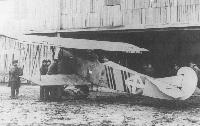 |
K.Delve - World War One in the Air /Crowood/
|
| Fokker DVII being inspected by Allied personnel at the end of the war.
|
 |
C.Owers - Fokker Aircraft of WWI. Vol.7: Postwar /Centennial Perspective/ (67)
|
| The hidden Fokker D.VII from Pour le Merite is taken out of the barn. When the hero flies again the machine (a mock up) is destroyed by fire under the hands of Government agents.
|
 |
C.Owers - Fokker Aircraft of WWI. Vol.7: Postwar /Centennial Perspective/ (67)
|
| These two photographs show a D.VII of Truppenfliegerstaffel 27, which later became Fliegerabt. 418, in German service post-Armistice. The machine bears the pilot's trident insignia and 'H' on the wing centre section. Note the numeral '5' under the tailplane.
|
 |
J.Herris, J.Leckscheid - Fokker Aircraft of WWI. Vol.5: 1918 Designs Part 2: D.VII & E.V/D.VIII /Centennial Perspective/ (55)
|
| Besides the famous von Richthofen brothers Manfred and Lothar, a third member of the family flew with Jasta 11 in 1918, their cousin Wolfram. He was credited with all of his eight victories while flying the D.VII, between June and the end of the war. The photo shows him in front of his D.VIIF in August or September 1918. For the last six days in August, he was acting commander of Jasta 11, continuing a family tradition. He died of cerebral hemorrhage on 12 June 1945. (Greg VanWyngarden)
|
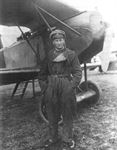 |
J.Herris, J.Leckscheid - Fokker Aircraft of WWI. Vol.5: 1918 Designs Part 2: D.VII & E.V/D.VIII /Centennial Perspective/ (55)
|
| Initially flying as an observer, Otto Schmidt was credited with his victory as early as 20 June 1916. His career as a fighter pilot began with Jasta 7 in March 1917, and he took command of Jasta 5 on 3 July 1918. He retained this position until the end of the war, being credited with 20 or 21 confirmed victories, depending upon source. Here he is pictured in front of an O.A.W.-built D.VII. The aircraft shows details that are identical to those of Konnecke's 4598/18, and both aircraft were probably delivered to Jasta 5 at the same time. Seen in the background is the tail of an Albatros-built D.VII. Schmidt died in his native city of Neunkirchen on 24 July 1944. (Peter M. Grosz Collection/STDB)
|
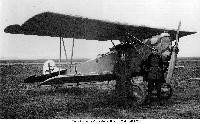 |
Сайт - Pilots-and-planes /WWW/
|
| Test pilots at the Ostdeutsche Albatros Werkes (O.A.W.).
|
 |
J.Herris, J.Leckscheid - Fokker Aircraft of WWI. Vol.5: 1918 Designs Part 2: D.VII & E.V/D.VIII /Centennial Perspective/ (55)
|
| Lt.d.R. Willi Nebgen joined Jasta 7 on 14 June 1918, arriving from Jastaschule I. Just two days later he claimed an S.E.5a for his initial victory, but failed to get confirmation for it. Yet another two days later, he was more lucky and his claim over a 3 Sqn. Sopwith Camel was allowed, and its pilot Lt. O.H. Nicholson was taken prisoner. His early-production Fokker-built D.VII was painted black on all surfaces, and his personal marking was a slanted green and white fuselage band, as noted by a German interwar-researcher on the back of this photo. On 22 October, after being credited with a total of four victories, he was killed in combat near Gontrode, the last of three pilots of Jasta 7 killed while the unit operated the Fokker D.VII. (Greg VanWyngarden)
|
 |
J.Herris, J.Leckscheid - Fokker Aircraft of WWI. Vol.5: 1918 Designs Part 2: D.VII & E.V/D.VIII /Centennial Perspective/ (55)
|
| Lt. Carl Degelow was another pilot who massively increased his score after receiving the Fokker D.VII. Flying with Jastas 7 and 40, he scored five victories from September 1917 to mid-June 1918. Then jasta 40 received the first examples of the new Fokker fighter, and he would be credited with another 25 victories between late June and early November 1918. He was given command of Jasta 40 on 10 July, and remained in charge until the end of the war. On 9 November 1918 he was decorated with the Pour le Merite, the last Jasta pilot to receive the award. This photo was likely taken to commemorate his award of the Hohenzollern House order, which he proudly shows off. His D.VII (Alb.), marked with his jumping white stag marking, is undergoing some major maintenance on the ammunition and fuel compartment.
|
 |
J.Herris, J.Leckscheid - Fokker Aircraft of WWI. Vol.5: 1918 Designs Part 2: D.VII & E.V/D.VIII /Centennial Perspective/ (55)
|
| Lt. Olivier Freiherr von Beaulieu-Marconnay initially served with the 4th Dragoon Regiment, being promoted to the rank of Leutnant in July 1916, two months short of his 18th birthday. In December 1917 he joined Jasta 18 and kept the "4D" horse branding marking of his former cavallery unit as the personal identifier on his aircraft. Here he poses alongside his Fokker D.VIIF, most likely after taking command of Jasta 19 on 2 September 1918. His aircraft was a late example from the first Fokker-built batch. The hole in the side panel for the early exhaust has been faired over and the later "saxophone" exhaust with matching panel has been installed. This aircraft was likely taken over by him from Hptm. Rudolf Berthold after he was wounded on 10 August 1918. Remnants of Berthold's winged sword insignia can be made out beneath the"4D" marking, the top surfaces of both wings were painted in blue paint that has weathered considerably, and some repair work has been carried out on the right side of the upper wing. (Peter M. Grosz Collection/STDB)
|
 |
J.Herris, J.Leckscheid - Fokker Aircraft of WWI. Vol.5: 1918 Designs Part 2: D.VII & E.V/D.VIII /Centennial Perspective/ (55)
|
| Royal Bavarian Jagdstaffel 78b received several aircraft from the second D.VII production batch, and here is the personal plane flown by Lt. Gerhard Ungewitter, marked with a lightning bolt. He served with the unit from 22 April 1918 to the end of the war, and was credited with a single victory over a DH 9 from 55 Squadron IAF on 13 August 1918. During the same combat Oblt. Benz, the commander of Jasta 78b, was killed, and Ungewitter served as the deputy commander of the Jasta for a month afterwards.
|
 |
J.Herris, J.Leckscheid - Fokker Aircraft of WWI. Vol.5: 1918 Designs Part 2: D.VII & E.V/D.VIII /Centennial Perspective/ (55)
|
| Oblt. Karl Bolle took command of the legendary Jagdstaffel Boelcke on 20 February 1918, and it was due to his leadership that the unit was credited with 138 confirmed victories (out of a total of 336) in the last six months before the end of the war. His own score at this time stood at 36, and here is pictured in front of his BMW-powered Fokker D.VIIF.
|
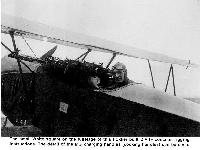 |
Сайт - Pilots-and-planes /WWW/
|
| The small White square on the fuselage of this Fokker built D.VIIF contains rigging instructions. The detail of the MG charging handles (cocking handles) can be seen.
|
 |
J.Herris, J.Leckscheid - Fokker Aircraft of WWI. Vol.5: 1918 Designs Part 2: D.VII & E.V/D.VIII /Centennial Perspective/ (55)
|
| Jagdstaffel 46 was one of the units formed under the "Amerika-Programm" which rapidly increased their score after introduction of the D.VII. During the last four months of the war, the unit scored 33 out of their total of 49 confirmed victories, while having only two pilots wounded in combat. The most successful pilot of the Stoffel was Vfw. Oskar Hennrich, pictured here next to his Fokker D.VII (O.A.W.). Visible details indicate that this was an early aircraft from the 6300/18 production batch. Hennrich was credited with 18-20 confirmed victories, 13 of these were scored against observation balloons. His overdue decoration with the Golden Military Merit Cross finally came on 3 November.
|
 |
J.Herris, J.Leckscheid - Fokker Aircraft of WWI. Vol.5: 1918 Designs Part 2: D.VII & E.V/D.VIII /Centennial Perspective/ (55)
|
| Lt. Wilhelm Leusch joined Jasta 19 on 15 April 1917 and remained with the unit until the end of the war. Here he is photographed at Stenay airfield in October 1918, and his aircraft is one of several O.A.W.-built planes from the 6300/18 range that were supplied to the component units of JG II. The wings are covered in five-color fabric with light-colored rib tapes. Leusch was one of those pilots who frequently changed their personal markings, and on this one he chose the flame-breathing dragon used by the metal-casting company "Unterberg & Helmle" in their 1918 adverts. The dragon was applied in a highly detailed manner, and the plane was handed over to the French after the war. Being credited with five victories, Leusch was given command of Jasta 19 following the death of Olivier von Beaulieu-Marconnay on 26 October. He survived the war but was tragically killed in a glider crash at the Wasserkuppe mountain on 14 August 1921.
|
 |
C.Owers - Fokker Aircraft of WWI. Vol.7: Postwar /Centennial Perspective/ (67)
|
| Another D.VII in French hands. The artwork is hidden by the crew.
|
 |
J.Herris, J.Leckscheid - Fokker Aircraft of WWI. Vol.5: 1918 Designs Part 2: D.VII & E.V/D.VIII /Centennial Perspective/ (55)
|
| JG II commander Hauptmann Rudolf Berthold resumed flying in late May 1918 after a recovery period of seven and a half months. Even then, his right arm was only under partial control, with bone splinters still working their way through the scar tissue. The light control forces needed to pilot the D.VII made return to flying for him much easier, and he resumed scoring on 28 May 1918, being credited with his 29th victory on that date. He would add a total of 16 claims to his tally at the controls of at least three different D.VIIs before yet another injury ended the war for him on 10 August 1918. (Peter M. Grosz Collection/STDB)
|
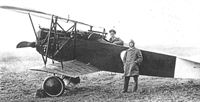 |
J.Herris, J.Leckscheid - Fokker Aircraft of WWI. Vol.5: 1918 Designs Part 2: D.VII & E.V/D.VIII /Centennial Perspective/ (55)
|
| Under the command of Lt. Degelow, Jasta 40 adopted black fuselages as a unit marking, and initially the tail was all-white. Personal markings were applied to the fuselage sides, and on his Fokker D.VII (Alb.) Lt. Willi Rosenstein adopted a white heart as his symbol, and it was apparently bordered in a color interpreted as red. Further information about Rosenstein can be found in "Jasta Colors Volume 1". (Peter M. Grosz Collection/STDB)
|
 |
J.Herris, J.Leckscheid - Fokker Aircraft of WWI. Vol.5: 1918 Designs Part 2: D.VII & E.V/D.VIII /Centennial Perspective/ (55)
|
| Another similar aircraft from this batch operated by Jasta 78b was the "EP" marked Fokker flown by Offz. Stv. Emil Prime. The military number is applied to the "N" strut but is not legible in the photo, preventing exact identification of the airframe. The blue paint used by the unit was only applied to the fuselage fabric, leaving the metal nose parts in factory finish. Two narrow white bands ahead of the tail section completed the unit marking. Being credited with three confirmed victories (as well as three claims that were not confirmed to him), he was the most successful pilot of the unit. (Peter M. Grosz Collection/STDB)
|
 |
J.Herris, J.Leckscheid - Fokker Aircraft of WWI. Vol.5: 1918 Designs Part 2: D.VII & E.V/D.VIII /Centennial Perspective/ (55)
|
| Franz Buchner's famous O.A.W.-built D.VII was one of the first aircraft from the 6300/18 - 6649/18 batch. The most noticeable external upgrade to this batch was the introduction of the long cooling louvers, and on the first few dozen examples the louvers on the forward panel had a flat profile. Those on the lower triangular-shaped panel already had the later, more pointed shape. The wings are covered in five-color fabric. The fuselage of this example was painted in a shade of blue that was considerably lighter than that of other JG II D.VIIs. Buchner had flown two or three other D.VIIs previous to this one, and it is likely that he scored 38 of his 40 victories on D.VIIs, which would make him the highest scoring pilot on the type. Buchner was awarded the Pour le Merite. (Peter M. Grosz Collection/STDB)
|
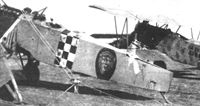 |
J.Herris, J.Leckscheid - Fokker Aircraft of WWI. Vol.5: 1918 Designs Part 2: D.VII & E.V/D.VIII /Centennial Perspective/ (55)
|
| The aircraft survived the war, and the one-piece intake manifold on the engine indicates it was powered by a BMW IIIa engine. (Peter M. Grosz Collection/STDB)
|
 |
J.Herris, J.Leckscheid - Fokker Aircraft of WWI. Vol.5: 1918 Designs Part 2: D.VII & E.V/D.VIII /Centennial Perspective/ (55)
|
| Buchner's D.VII (O.A.W.) was decorated with a large floral wreath to commemorate his 40th victory. Unfortunately, this obscured the military number on the base of the propeller. The "40" was drawn into the photo. The location where this photo was taken appears to be Stenay, and this indicates the picture was taken on 8 October when Buchner-claimed a pair of two-seaters. However, he did not get confirmation for these, and was only officially credited with his 40th and last victory on 22 October, when Jasta 13 was based at Carignan. Three days later, he was finally awarded the well-deserved Pour le Merite. A Pfalz D.XII is parked in the hangar behind the men. (Peter M. Grosz Collection/STDB)
|
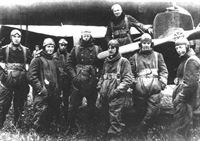 |
J.Herris, J.Leckscheid - Fokker Aircraft of WWI. Vol.5: 1918 Designs Part 2: D.VII & E.V/D.VIII /Centennial Perspective/ (55)
|
| Pilots of Jasta 4 at Escaufort aerodrome in front of a Fokker D.VII of their unit, 5 September 1918, exemplify the best of late-war German fighter aviation. The Fokker D.VII became the main German fighter as soon as its production could reequip the Jastas. Left to Right: Lt.d.R. Richard Kraut, Lt. Hildebrandt, Flieger Rohde, Lt.d.R. Adolf Hildebrandt, Lt. Joachim von Winterfeld, Lt. Egon Koepsch (acting CO), Lt.d.R. Heinrich Maushake, Lt. Heinz Graf von Gluszewski, and Lt.d.R. Julius Bender.
|
 |
J.Herris, J.Leckscheid - Fokker Aircraft of WWI. Vol.5: 1918 Designs Part 2: D.VII & E.V/D.VIII /Centennial Perspective/ (55)
|
| Vzfw. Christian Donhauser joined Jasta 17 around July 1918, having previously flown two-seaters in Fliegerabteilung 10. He scored his first victory with the Jasta on 20 August and ended the war with around 16 confirmed and 3 unconfirmed victories, making him the most successful pilot of the Staffel in the summer of 1918. He was awarded the Golden Military Merit Cross, commonly known as the "NCO Pour le Merite", on 9 October. Here he poses for the "Sanke" card photographer in front of his Albatros-built D.VII.
|
 |
J.Herris, J.Leckscheid - Fokker Aircraft of WWI. Vol.5: 1918 Designs Part 2: D.VII & E.V/D.VIII /Centennial Perspective/ (55)
|
| Photographed at Stenay in late September/early October, the two cooling louvers above his head face forward, thus acting as air intakes. This was a modification seen on several early D.VIIs serving with JG II. (Peter M. Grosz Collection/STDB)
|
 |
H.Cowin - Aviation Pioneers /Osprey/
|
| The youthful Lt Ulrich Nechel standing near his Fokker D VII. Nechel, born on 23 January 1898, was still aged only twenty at the time of the Armistice. Despite this, Nechel's confirmed score of 30 'kills', coupled to his leadership qualities had seen him selected to command Jasta 6 during the last months of the war. Prior to this, Nechel had served with Jastas 12 and 19. He was awarded the Pour Le Merite on 8 November 1918.
|
 |
J.Herris, J.Leckscheid - Fokker Aircraft of WWI. Vol.5: 1918 Designs Part 2: D.VII & E.V/D.VIII /Centennial Perspective/ (55)
|
| As was the case with Wilhelm Leusch earlier, Lt. Ulrich Neckel also frequently picked new personal markings for each of his new aircraft. After scoring 24 victories with Jastas 12,13, and 19, he was given command of Jasta 6 on 1 September 1918, where he would add six further victories to his scoreboard. At Jasta 6, he adopted the all-over black and white striped scheme previously used by Hans Kirschstein, seen here on his O.A.W.-built D.VII in September. Towards the end of the month, the unit received Fokker-built D.VIIFs, and this scheme was carried over on the pair of D.VIIFs he is known to have flown later. Neckel was the last German fighter pilot to be decorated with the Pour le Merite on 6 November, having risen through the ranks swiftly and being commissioned only in April 1918. Having survived 14 months of aerial fighting, he fell victim to Tubercolosis at the age of 30 on 11 May 1928 in Italy. (Peter M. Grosz Collection/STDB)
|
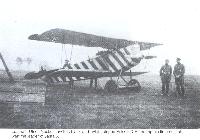 |
Сайт - Pilots-and-planes /WWW/
|
| Leutnant Ulrich Neckel flew this black-and-white striped Fokker D.VII during his time as last wartime leader of Jasta 6.
|
 |
J.Herris, J.Leckscheid - Fokker Aircraft of WWI. Vol.5: 1918 Designs Part 2: D.VII & E.V/D.VIII /Centennial Perspective/ (55)
|
| Jagdstaffel 6 traded their Mercedes-powered O.A.W.-built D.VIIs, which they received as immediate replacement for their grounded Fokker E.Vs, for D.VIIFs. The one of the Staffelfuhrer Lt. Ulrich Neckel has already been painted with his black and white-striped fuselage marking, and the one seen to the right of it also carries the Jasta 6 unit marking and a personal marking of an arrow on the fuselage. The plane at left appears to be an as-yet unpainted new arrival, while the three at right may have belonged to another component Jasta of JG I. The photo was taken at Marville, likely in early October. (Peter M. Grosz Collection/STDB)
|
 |
J.Herris, J.Leckscheid - Fokker Aircraft of WWI. Vol.5: 1918 Designs Part 2: D.VII & E.V/D.VIII /Centennial Perspective/ (55)
|
| Proudly wearing the Pour le Merite that was awarded to him on 24 June, Lt. Hans Kirschstein poses in front of his Fokker D.VII at the airfield at Beugneux. Very likely the photo was taken in early July after his return from the Second Fighter Competition in Berlin, where he was informed about the bestowal of the award on 25 June. (L. Bronnenkant)
|
 |
J.Herris, J.Leckscheid - Fokker Aircraft of WWI. Vol.5: 1918 Designs Part 2: D.VII & E.V/D.VIII /Centennial Perspective/ (55)
|
| A lineup of Jasta 6 Fokker D.VII fighters apparently taken at Beugneux airfield. Kirschstein's plane heads the lineup, the usual position for the aircraft of the officer in charge, indicating the photo was snapped on or after 10 June, when he took over command of the Staffel. Parked next to it is a captured, all-white Spad VII still carrying the unit marking of Esc. Spa. 62, its original owner. (Bruno Schmaling)
|
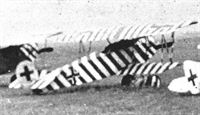 |
J.Herris, J.Leckscheid - Fokker Aircraft of WWI. Vol.5: 1918 Designs Part 2: D.VII & E.V/D.VIII /Centennial Perspective/ (55)
|
| Kirschstein joined Jasta 6 on 13 March 1918, and scored his first victory five days later. He managed to score his total of 27 victories within 14 weeks at the front. His all-over striped fighters were dubbed "optical illusion” by his comrades, an effective scheme that resulting in him only ever getting hit in the right wing, if at all. Tragically, he was badly injured on 16 July in a two-seater crash in which he was the passenger, and died the next morning. The photo is an enlargement of the lineup seen below. (Bruno Schmaling)
|
 |
J.Herris, J.Leckscheid - Fokker Aircraft of WWI. Vol.5: 1918 Designs Part 2: D.VII & E.V/D.VIII /Centennial Perspective/ (55)
|
| Lt.zur See Gotthard Sachsenberg flew this spectacularly-marked Fokker D.VII while serving as the commander of Marine Land Feld Jagdstaffel I. The aircraft was powered by a Mercedes engine. The fuselage was yellow, and black checkers covered the fuselage fabric. The patches on the yellow-painted upper wing may simply have been reinforcement tape that strengthened the fabric on the centre-section area. The upper-wing crosses appear to have been applied with with 5:4 cross arm proportions, indicating that this may have been a late aircraft from the first Fokker production batch. (Peter M. Grosz Collection/STDB)
|
 |
J.Herris, J.Leckscheid - Fokker Aircraft of WWI. Vol.5: 1918 Designs Part 2: D.VII & E.V/D.VIII /Centennial Perspective/ (55)
|
| Sachsenberg's D.VII shows up in the background of a Fokker E.V photo taken in mid-August 1918, allowing us a view of the left side. In this view the unit marking of MFJ I, a single black stripes on the elevators, can also be seen for once. The patches on the upper wing look too irregular to be a marking and may possibly just signify repair work on the center section. Sachsenberg was decorated with the Pour le Merite and survived the war with 31 victories to his credit. Aged 69, he died on 23 August 1961. (Peter M. Grosz Collection/STDB)
|
 |
A.Imrie - German Bombers /Arms & Armour/
|
| At various times during the war single-seat fighters undertook bombing operations. Shown here is Captain F. O. Soden of No 41 Squadron, RAF, with Leutnant Auer's Jagdstaffel 40 Fokker D VII which he forced to land at Ooteghen on 28 October 1918. This aircraft was fitted with wooden shelf racks on either side of the fuselage enabling eight Wurfgranaten 15 to be carried. These were suspended upside down by a length of wire through their noses, as was normal on CL category machines used by the Schlachtstaffeln. Withdrawal of the wires released the grenades which had ordinary percussion fuses.
|
 |
J.Herris, J.Leckscheid - Fokker Aircraft of WWI. Vol.5: 1918 Designs Part 2: D.VII & E.V/D.VIII /Centennial Perspective/ (55)
|
| OffzStv. Friedrich Altemeier served with Jasta 24 from its formation on 1 December 1916 until the end of the war, when his score stood at 21 victories. Rather fittingly, he was credited with the second victory of the unit on 3 March 1917 as well the 88th and final one on 10 November 1918. Here he is pictured in front of his heavily overpainted early-production Fokker D.VII in the summer of 1918. (Peter M. Grosz Collection/STDB)
|
 |
J.Herris, J.Leckscheid - Fokker Aircraft of WWI. Vol.5: 1918 Designs Part 2: D.VII & E.V/D.VIII /Centennial Perspective/ (55)
|
| To allow for a more natural look at the plane, the famous photo has been horizontally aligned. By Udet's own accounts, the photo was taken just one day before he was shot down in it and barely managed to bail out from low altitude. The frontline life of the aircraft was a mere 16 days. Note that the D.7 in the background has its upper cowling panel in place.
|
 |
J.Herris, J.Leckscheid - Fokker Aircraft of WWI. Vol.5: 1918 Designs Part 2: D.VII & E.V/D.VIII /Centennial Perspective/ (55)
|
|
|
 |
J.Herris, J.Leckscheid - Fokker Aircraft of WWI. Vol.5: 1918 Designs Part 2: D.VII & E.V/D.VIII /Centennial Perspective/ (55)
|
| Lineup of Jasta 4 Fokker D.7 (O.A.W.) fighters photographed in August 1918. Note the the upper cowlings are removed now, after the in-flight firers that occurred in mid-July. Udet is the third man from right, looking into the camera over his right shoulder. The "LO!" marked D.7 at far right was most likely his Mercedes-powered replacement backup machine. This could be interpreted as the successor to "Du doch nicht!!", but since he did not use it much it only received a simplyfied paint job. His article in "Motor" describes that he scored all his victories in August (# 41 to #60) while flying D.VIIF 4253/18, pictured previously in this book. He praised the reliability of the BMW engine to a great extend in the article, so there was hardly any need for him to resort to the less-powerful machine.
|
 |
K.Delve - World War One in the Air /Crowood/
|
| Fokker DVIIs of JG2 at Chery-les-Pouilly, late 1918.
|
 |
J.Herris, J.Leckscheid - Fokker Aircraft of WWI. Vol.5: 1918 Designs Part 2: D.VII & E.V/D.VIII /Centennial Perspective/ (55)
|
| After JG II departed the Giraumont/Tichemont airfield complex on 28 September, Jasta 64w remained the sole unit stationed there for a while. Here the unit is working up eleven newly-arrived O.A.W.-built D.VIIs from the 6300-6649/18 production batch. All aircraft seem to carry personal markings already, but the application of the unit markings is only partially complete. The third and fourth aircraft from left still feature the factory nose camouflage pattern, while the other planes already have received the "Pfalz silver grey" nose marking. The fuselage overpainting has so far only been completed on "Rudi" and "Ali" on the right, as well as the second aircraft on the left. Another D.VII (O.A.W.) with a tarp cover over its engine can be seen at far right, in front of the hangar. Finally, on 20 October, Jasta 65 also moved to the location, and both units would remain there until the end of the war. (Greg VanWyngarden)
|
 |
J.Herris, J.Leckscheid - Fokker Aircraft of WWI. Vol.5: 1918 Designs Part 2: D.VII & E.V/D.VIII /Centennial Perspective/ (55)
|
| Six early-production Albatros-built D.VIIs head this small lineup of Jasta 40 at their airfield near Lomme in the early summer of 1918. Closest to the camera is the personal aircraft of the Staffelfuhrer, Lt. Carl Degelow. Besides his "white stag" fuselage marking, an oblique white bar has been painted on the center section of the top wing to denote his position as unit commander. Second in line is the heart-marked aircraft of Lt. Rosenstein, carrying a lengthwise white stripe on the upper wing, indicating his status as deputy leader. This was an earlier aircraft than the one seen in side view a few pages earlier. A Pfalz D.IIIa and an Albatros D.Va are obliged to hide at the end of the lineup. (Peter M. Grosz Collection/STDB)
|
 |
J.Herris, J.Leckscheid - Fokker Aircraft of WWI. Vol.5: 1918 Designs Part 2: D.VII & E.V/D.VIII /Centennial Perspective/ (55)
|
| Jasta 13 parade their new Fokker D.VIIs in June 1918 at Mesnil. Ten of the fighters are seen in this view. (Peter M. Grosz Collection/STDB)
|
 |
Сайт - Pilots-and-planes /WWW/
|
|
|
 |
J.Herris, J.Leckscheid - Fokker Aircraft of WWI. Vol.5: 1918 Designs Part 2: D.VII & E.V/D.VIII /Centennial Perspective/ (55)
|
| Six D.VIIs from Jasta 36 are set up for the camera at Aniche in late August/early September 1918. The"N"-marked plane is an early Mercedes-powered Fokker-built machine that may have been handed over from Jasta "Boelcke" after the unit received D.VIIFs in August. Jasta 36 still had Fokker Triplanes and Fokker E.Vs when the photo was taken, and the mixed equipment no doubt made daily operations pretty challenging. (Peter M. Grosz Collection/STDB)
|
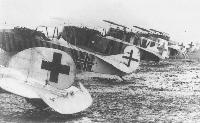 |
K.Delve - World War One in the Air /Crowood/
|
| Fokker DVIIs of JG3 (Jastas 2 and 36). The nearest aircraft - tail only - is an Albatros DVa.
|
 |
J.Herris, J.Leckscheid - Fokker Aircraft of WWI. Vol.5: 1918 Designs Part 2: D.VII & E.V/D.VIII /Centennial Perspective/ (55)
|
| Photographed at their airfield at Habsheim, Jagdstaffel 71 shows off their 14 Fokker D.VIIs in October 1918. By this time, the shortage of aircraft that plagued many Jagdstaffeln in the summer, during transition from the old types to the D.VII, was a thing of the past. Even a unit operating on a quiet sector of the front, such as Jasta 71, could now be brought up to the nominal strength of fourteen aircraft. The lineup consists of nine O.A.W.-built, four Albatros-built, and one Fokker-built example. Third from left is D.VII (O.A.W.) 4488/18, and sixth from left is D.VII (O.A.W.) 2113/18, the aircraft of Lt. Hermann Stutz, the Staffelfuhrer. At right, at the far end of the lineup, are “Lude" (D.VII (O.A.W.) 6428/18) and "Ede" (D.VII (O.A.W.) 6467/18). Individual views of these four aircraft can be found in previous pages of this book. (Tobias Weber)
|
 |
O.Thetford, P.Gray - German Aircraft of the First World War /Putnam/
|
| An interesting assortment of markings may be discerned on this group of Fokker D VIIs of Jasta 26, taken late in 1918.
|
 |
O.Thetford, P.Gray - German Aircraft of the First World War /Putnam/
|
| By November 1918 nearly 800 Fokker D VIIs were in service.
|
 |
J.Herris, J.Leckscheid - Fokker Aircraft of WWI. Vol.5: 1918 Designs Part 2: D.VII & E.V/D.VIII /Centennial Perspective/ (55)
|
| Out with the old - in with the new! In May 1918 Jagdstaffel 27 took delivery of their first examples of the new Fokker D.VII. These would soon replace the old Fokker Triplanes, three of which are also seen in this view, as well as the Albatros D.Va also seen in the photo.
|
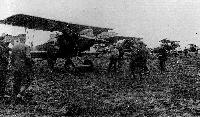 |
Сайт - Pilots-and-planes /WWW/
|
|
|
 |
J.Herris, J.Leckscheid - Fokker Aircraft of WWI. Vol.5: 1918 Designs Part 2: D.VII & E.V/D.VIII /Centennial Perspective/ (55)
|
| Jagdstaffel 18 arranged their aircraft in tails-up position in front of their hangars at Montingen for a visit by KoGenLuft General Ernst von Hoeppner. Besides this, all props were arranged vertically in order to appear as immaculate as possible. The picture was snapped at the moment when Jasta commander August Raben greets von Hoeppner, with the pilots standing in line to be addressed by their commanding General. In the far distance at right, a captured D.H.4 is parked in front of a tent. (Greg VanWyngarden)
|
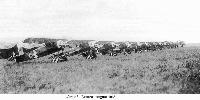 |
O.Thetford, P.Gray - German Aircraft of the First World War /Putnam/
|
| Nine Fokker E.V fighters of Jasta 6 lined up for the camera in early August, with five D.VIIs barely visible at the far end. These photos have previously been identified as having been taken at Bernes but it seems more likely that they were taken at Chambry around 5 August.
|
 |
J.Herris, J.Leckscheid - Fokker Aircraft of WWI. Vol.5: 1918 Designs Part 2: D.VII & E.V/D.VIII /Centennial Perspective/ (55)
|
| Nine Fokker E.V fighters of Jasta 6 lined up for the camera in early August, with five D.VIIs barely visible at the far end. These photos have previously been identified as having been taken at Bernes but it seems more likely that they were taken at Chambry around 5 August. The tall building visible seen in the background strongly resembles L'Eglise St-Pierre-St-Paul at Chambry.
|
 |
J.Herris, J.Leckscheid - Fokker Aircraft of WWI. Vol.5: 1918 Designs Part 1: Prototypes & D.VI /Centennial Perspective/ (55)
|
| A single Fokker D.VI of Kest 1b is seen here with several Fokker D.VIIs at Karlsruhe. The fuselage and rudder cross have been converted by extending the black cross arms. The Fokker company logo decal is visible on the bottom of the rudder, and next to it the Fokker Werknummer has been marked. Unfortunately, it is too indistinct to be read clearly. (Above: Greg VanWyngarden, Below: Reinhard Zankl)
|
 |
O.Thetford, P.Gray - German Aircraft of the First World War /Putnam/
|
| Fokker D VII fighters, hastily abandoned by the retreating German Army during the final Allied onslaught o f 1918.
|
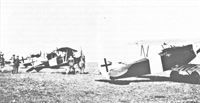 |
J.Herris - Siemens-Schuckert Aircraft of World War I /Centennial Perspective/ (12)
|
| Lineup of Jasta 12; SSW D.IV fighters at left and a Fokker D.VII at right.
|
 |
J.Herris - Halberstadt Aircraft of WWI. Volume 2: CL.IV-CLS.I & Fighters /Centennial Perspective/ (45)
|
| From left, Junkers D.I, Fokker D.VII, and Halberstadt C.V of Kampfgeschwader Sachsenberg aircraft at Swinemunde (today's Swinoujscie, in Poland) on the Baltic in 1919.
|
 |
J.Herris - Zeppelin-Staaken Aircraft of WW1. Vol 2: R.VI R.30/16 - E.4/20 /Centennial Perspective/ (48)
|
| Staaken R.XIV with five 245 hp Maybach Mb.IVa engines.The Fokker D.VII at right both gives scale to the Staaken and indicates it is on an operational airfield. (Peter M. Grosz collection/STDB)
|
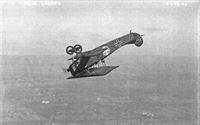 |
C.Owers - Fokker Aircraft of WWI. Vol.7: Postwar /Centennial Perspective/ (67)
|
| This photograph of a D.VII looping was published in the between the wars pulp magazines with the caption of a D.VII over the Western Front. This D.VII is in US service and was over Mineola, Long Island on 28 October 1920. The pilot was Lt Eugene Barksdale and the D.VII was from the 1 st Observation Squadron, whose insignia is carried on the fuselage.
|
 |
J.Herris - LVG Aircraft of WWI. Volume 2: Types C.II-C.V /Centennial Perspective/ (35)
|
| LVG C.V 4404/17 photographed in flight. We can not explain the large application of the serial number on the fuselage and the overall light paint job; this would often indicate a training or communications machine, but this one is armed and 'escorted'; the upper photo shows its Fokker D.VII escort. A long streamer is attached to the outboard wing strut. The exhaust manifold is somewhat different shape than that normally seen.
|
 |
Журнал - Flight за 1918 г.
|
| A side view of the Fokker D.VII (D.7) Biplane, showing the curious strut arrangement.
|
 |
C.Owers - Fokker Aircraft of WWI. Vol.7: Postwar /Centennial Perspective/ (67)
|
| In this photograph the D.VII appears to have a large windscreen and no national markings.
|
 |
C.Owers - Fokker Aircraft of WWI. Vol.7: Postwar /Centennial Perspective/ (67)
|
| D-EIRA was a Swiss D.VII that Ernst Udet brought to Germany in 1936 for installation in the Deutsche Luftfahrt Sammlung in Berlin. It also appeared in the film Pour Le Merite. It was apparently destroyed when the museum was bombed in WWII.
|
 |
Журнал - Flight за 1918 г.
|
| Three-quarter rear view of the Fokker biplane.
|
 |
Журнал - Flight за 1918 г.
|
| Rear view of the Fokker biplane.
|
 |
Jane's All The World Aircraft 1919 /Jane's/
|
| Front view of the Fokker D.VII (D.7) Biplane.
|
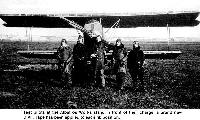 |
Сайт - Pilots-and-planes /WWW/
|
| Test pilots at the Albatros Works stand in front of their charge, a brand new D.VII. Tape has been applied to each rib position.
|
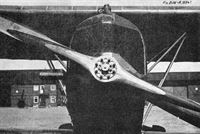 |
A.Weyl - Fokker: The Creative Years /Putnam/
|
| The nose of a standard Mercedes-powered Fok. D.VII. Engine cowlings differed slightly in detail, and several forms of exhaust manifold were fitted.
|
 |
J.Herris - Fokker Aircraft of WWI. Vol.6: Foreign Service /Centennial Perspective/ (56)
|
Fully-assembled airframe of a MAG-built Fokker D.VII at the MAG factory rolled out for inspection just before the end of the war. In the background mechanics are working on an Aviatik D.I(MAG).
Fokker D.VII (MAG), Flugzeugnummer 93.01, Rohbau bei MAG
|
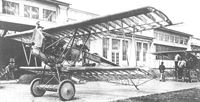 |
P.Grosz, G.Haddow, P.Shiemer - Austro-Hungarian Army Aircraft of World War One /Flying Machines/
|
| The fully-assembled airframe of a MAG-built Fokker D.VII rolled out for inspection shortly before the end of the war. Mechanics are working on an Aviatik D.I(MAG) in the background.
|
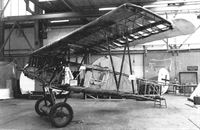 |
C.Owers - Fokker Aircraft of WWI. Vol.7: Postwar /Centennial Perspective/ (67)
|
| After the Tallmantz Collection was broken up the D.VII went through a number of hands and ended up in the Wings and Wheel Collection in Orlando, Florida. Sold to the Fokker Company when the museum closed, it was moved to the Netherlands where Fokker employees and enthusiasts in the Netherlands who restored it to its original configuration. The machine is shown after it arrived in the Netherlands. A Mercedes engine is in place but the rest of he airframe shows the many modifications made in its long career. Non-standard items include: - the upper wing leading edge is not sawtooth. Seat is incorrect. Diagonal bracing tubes in last fuselage bay. Fuel tank in centre section of upper wing. Large than normal upper wing trailing edge cut-out.
|
 |
J.Herris - Development of German Warplanes in WWI /Centennial Perspective/ (1)
|
| Fokker D.VII without its fabric covering shows the simple welded steel tube fuselage and innovative plywood wing structure.
|
 |
J.Herris, J.Leckscheid - Fokker Aircraft of WWI. Vol.5: 1918 Designs Part 1: Prototypes & D.VI /Centennial Perspective/ (55)
|
| Captured Fokker D.VII of Jasta 18 on display after removal of its engine. The lack of fabric covering shows details of the aircraft's welded steel tube structure and thick airfoil wooden wings.
|
 |
J.Herris, J.Leckscheid - Fokker Aircraft of WWI. Vol.5: 1918 Designs Part 2: D.VII & E.V/D.VIII /Centennial Perspective/ (55)
|
| Fokker D.VII without fabric covering shows details of the aircraft's welded steel tube structure, engine installation, and thick airfoil wooden wings.
|
 |
Сайт - Pilots-and-planes /WWW/
|
|
|
 |
J.Herris, T.Phillips - Fokker Aircraft of WWI. Vol.4: V.1-V.8, F.I & Dr.I /Centennial Perspective/ (54)
|
| The first Fokker D.VII prototype, V.11, under construction in the foreground. In the background is V.7O with its twin-row Oberursel U.III and deep engine cowling on the floor to the right. (Peter M. Grosz collection/STDB)
|
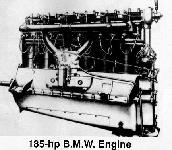 |
Сайт - Pilots-and-planes /WWW/
|
| 185-hp B.M.W. Engine
|
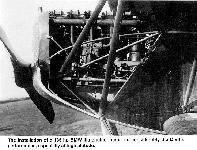 |
Сайт - Pilots-and-planes /WWW/
|
| The installation of a 185-hp BMW IIIa engine increased considerably the D.VII’s performance, especially at high altitude.
|
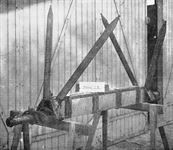 |
A.Weyl - Fokker: The Creative Years /Putnam/
|
| Standard Fok. D.VII undercarriage before fitting the aerofoil fairing to the axle.
|
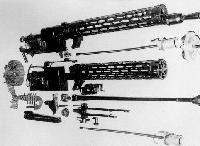 |
Сайт - Pilots-and-planes /WWW/
|
|
|
 |
R.Kosin - The German Fighter since 1915 /Putnam/
|
| Fokker D VII, twin machinegun installation located directly in front of the pilot.
|
 |
J.Herris, J.Leckscheid - Fokker Aircraft of WWI. Vol.5: 1918 Designs Part 1: Prototypes & D.VI /Centennial Perspective/ (55)
|
| Fokker V11 under construction in the factory.
|
 |
J.Herris, J.Leckscheid - Fokker Aircraft of WWI. Vol.5: 1918 Designs Part 1: Prototypes & D.VI /Centennial Perspective/ (55)
|
| Wing cellule of the Fokker V11 prototype being stress-tested in the Fokker factory.
|
 |
J.Herris, J.Leckscheid - Fokker Aircraft of WWI. Vol.5: 1918 Designs Part 1: Prototypes & D.VI /Centennial Perspective/ (55)
|
| Components of the Fokker V11 wing cellule being stress-tested in the Fokker factory.
|
 |
J.Herris - Fokker Aircraft of WWI. Vol.1: Spinne - M.10 & Watercraft /Centennial Perspective/ (51)
|
| Fokker's Schwerin factory after the Armistice shows a large number of partially completed D.VII and D.VIII airframes. Loath to have these confiscated by the Allies, Fokker arranged to smuggle more than 220 aircraft into Holland.
|
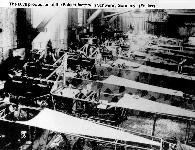 |
Сайт - Pilots-and-planes /WWW/
|
| The D.VII production at the Fokker factory in Schwerin, Germany.
|
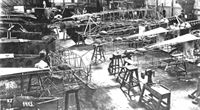 |
J.Herris, J.Leckscheid - Fokker Aircraft of WWI. Vol.5: 1918 Designs Part 2: D.VII & E.V/D.VIII /Centennial Perspective/ (55)
|
| A glimpse inside the manufacturing halls at the Fokker works in Schwerin is provided in this pair of photos, taken in August 1918. The conditions can only be described as overcrowded. In the upper view twenty fuselages can be counted. A stencil used for the application of the fuselage cross is resting on the middle aircraft in the left row.
|
 |
J.Herris, J.Leckscheid - Fokker Aircraft of WWI. Vol.5: 1918 Designs Part 2: D.VII & E.V/D.VIII /Centennial Perspective/ (55)
|
| A glimpse inside the manufacturing halls at the Fokker works in Schwerin is provided in this pair of photos, taken in August 1918. The conditions can only be described as overcrowded. In the upper view twenty fuselages can be counted.
|
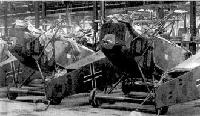 |
В.Обухович, А.Никифоров - Самолеты Первой Мировой войны
|
|
|
 |
J.Herris, J.Leckscheid - Fokker Aircraft of WWI. Vol.5: 1918 Designs Part 2: D.VII & E.V/D.VIII /Centennial Perspective/ (55)
|
| Two views documenting the chaos at the Fokker assembly hall in Schwerin after the war. Numerous Fokker D.VII and D.VIII fuselages can be seen, as well as several D.VIII wings, D.VIII cowlings, and numerous Oberursel engines. (Peter M. Grosz Collection/STDB)
|
 |
J.Herris, J.Leckscheid - Fokker Aircraft of WWI. Vol.5: 1918 Designs Part 2: D.VII & E.V/D.VIII /Centennial Perspective/ (55)
|
| By contrast, the production hall at Albatros in Berlin-Johannisthal is far more spacious and has far better lighting conditions. Even though the aircraft in the foreground are in the final stage of assembly, the fuselage military number remains to be applied. Note that on the first aircraft on the left the upper wing crosses have not yet been extended onto the ailerons.
|
 |
J.Herris, J.Leckscheid - Fokker Aircraft of WWI. Vol.5: 1918 Designs Part 2: D.VII & E.V/D.VIII /Centennial Perspective/ (55)
|
| By contrast, the production hall at Albatros in Berlin-Johannisthal is far more spacious and has far better lighting conditions. The aileron control cables are being routed through the opening in the wing. Wooden wheels were used to move the aircraft around the factory building, but of course the usual standard wheels were later mounted for the acceptance flight before delivery of the aircraft. No stencils showing the factory or military number are in sight.
|
 |
Сайт - Pilots-and-planes /WWW/
|
| Final assembly of a D.VII that has not had its temporary wooden wheels replaced by the spoked wheels and wheel covers.
|
 |
J.Herris - Pfalz Aircraft of WWI /Centennial Perspective/ (5)
|
| Moving day at Jagdgruppe 8b, commanded by von Schleich, that included Jastas 32b and 35b. Pfalz D.XII and Fokker D.VII fighters of Jasta 35b are being unloaded from a train at Bouchain on 25 September 1918 to move to their new airfield at Buhl. The Fokker D.VII with the "H"on a dark band is 4487/18; it was usually flown by Lt.d.R. F. Stoer.The D.XII with the"K1"on the side is 2454/18; it and the adjacent D.VII marked "E"were either Jasta 32b or Jasta 35b. When the entire Jagdgruppe moved it would typically be via train, saving wear on the aircraft.
|
 |
J.Herris - AEG Aircraft of WWI /Centennial Perspective/ (16)
|
| This view of the inside of the Zeppelin hangar in Trier shows AEG J.II 353/18 tactical '7' with its wings still on. A USAS Salmson 2 A2 is at lower left with a Rumpler C.IV in the center, an LVG C.VI behind the AEG J.II, and Fokker D.VII fighters among the aircraft that can be identified.
|
 |
J.Herris - Halberstadt Aircraft of WWI. Volume 2: CL.IV-CLS.I & Fighters /Centennial Perspective/ (45)
|
| Halberstadt C.V aircraft; the C.V on the right was C.3388/18. A Fokker D.VII in the left background indicates it was not the Halberstadt factory, but likely a postwar collection point in Germany, possibly Furth or Schleissheim. (Peter M. Grosz collection/STDB)
|
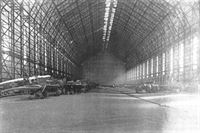 |
J.Herris - Halberstadt Aircraft of WWI. Volume 2: CL.IV-CLS.I & Fighters /Centennial Perspective/ (45)
|
| Halberstadt C.V is among Junkers monoplanes and a Fokker D.VII on the right of the Wainoden Zeppelin hall postwar. Junkers D.I(Jco) D.9166/18 is first in line on the left. This location is now Vainode in Latvia. (Peter M. Grosz collection/STDB)
|
 |
J.Herris, J.Leckscheid - Fokker Aircraft of WWI. Vol.5: 1918 Designs Part 1: Prototypes & D.VI /Centennial Perspective/ (55)
|
| A trio of D.VIs, at least one of them from Jasta 80b, seen amongst Fokker D.VIIs and Roland D.VIs after being turned over to the French after the armistice. The photo was probably taken at Neunkirchen or Saargemund. Many surrendered German fighters were gathered here. (Peter M. Grosz Collection/STDB)
|
 |
J.Herris, T.Phillips - Fokker Aircraft of WWI. Vol.4: V.1-V.8, F.I & Dr.I /Centennial Perspective/ (54)
|
| The Fokker V.1 with engine removed set up for testing a fuel tank in the undercarriage airfoil in 1918.
|
 |
J.Herris, T.Phillips - Fokker Aircraft of WWI. Vol.4: V.1-V.8, F.I & Dr.I /Centennial Perspective/ (54)
|
| Two Fokker D.VIIs, one without wings, to provide propeller blast from its rotating propeller.
|
 |
J.Herris, T.Phillips - Fokker Aircraft of WWI. Vol.4: V.1-V.8, F.I & Dr.I /Centennial Perspective/ (54)
|
| July 1918. Hermann Goring, center, with pilots of JG I (Richthofen Circus). Goring became commander of JG I after Reinhard was killed. An ace with 22 victories, Goring later became notorious as Reichsmarschall after Hitler achieved power in Germany. At this period ihe Fokker D VII (seen in background) was entering service in increasing numbers.
|
 |
J.Herris - Pfalz Aircraft of WWI /Centennial Perspective/ (5)
|
| Pfalz D.IIIa 1296/18 of Jasta 56 with a Jasta 56 Fokker D.VII in the background. Both aircraft carry the unit markings of chrome yellow nose and tail with blue-gray fuselage.
|
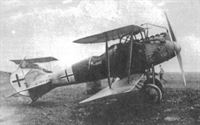 |
J.Herris - Roland Aircraft of WWI /Centennial Perspective/ (9)
|
| An unidentified D.VIa with a painted fuselage. A Fokker D.VII rests in the background.
|
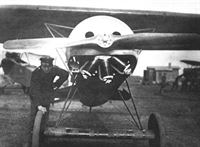 |
J.Herris, J.Leckscheid - Fokker Aircraft of WWI. Vol.5: 1918 Designs Part 2: D.VII & E.V/D.VIII /Centennial Perspective/ (55)
|
| Another unidentified "Parasol" with a light-colored engine cowling is seen in this head-on photo. The heavy castor-oil stains on the axle wing indicate that the plane has been well used, and the Fokker D.VII being pushed out of the picture by the groundcrew and the two-seater seen on the left indicate do not help with identification either. (Peter M. Grosz Collection/STDB)
|
 |
J.Forsgren - The Thomas-Morse MB-3 /Centennial Perspective/ (60)
|
| An MB-3A, presumably seen with Boeing prior to delivery. Of note is the Fokker D.VII in the background. Via Colin Owers
|
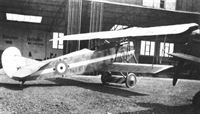 |
C.Owers - Fokker Aircraft of WWI. Vol.7: Postwar /Centennial Perspective/ (67)
|
| Fokker D.VII F 7703/18 was photographed by British and Australian servicemen at Bickendorf aerodrome, just outside Cologne, when on occupation duty post-Armistice.
|
 |
C.Owers - Fokker Aircraft of WWI. Vol.7: Postwar /Centennial Perspective/ (67)
|
| D.VII F No. 7703/18 on a snow-covered Bickendorf aerodrome.
|
 |
C.Owers - Fokker Aircraft of WWI. Vol.7: Postwar /Centennial Perspective/ (67)
|
| Fokker D.VII in British markings, Hangelar, Germany, January 1919. The fuselage was over-painted with coloured band behind cockpit. The dark marks are the shadow of the N interplane struts.
|
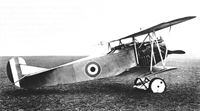 |
C.Owers - Fokker Aircraft of WWI. Vol.7: Postwar /Centennial Perspective/ (67)
|
| Fokker D.VII 6539/18 in British markings.
|
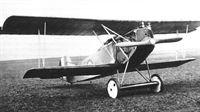 |
C.Owers - Fokker Aircraft of WWI. Vol.7: Postwar /Centennial Perspective/ (67)
|
| Another view of 6539/18, resplendent in British markings.
|
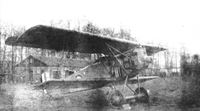 |
C.Owers - Fokker Aircraft of WWI. Vol.7: Postwar /Centennial Perspective/ (67)
|
| This D.VII, in British markings, has been previously captioned as No. 6539/18. Painted in British colours by No. 208 Squadron, RAF, it was written off at Donstiennes, Belgium, on 30 April 1919, when Maj C.E. Bryant, DSO, hit telephone wires.
|
 |
C.Owers - Fokker Aircraft of WWI. Vol.7: Postwar /Centennial Perspective/ (67)
|
| Another Albatros-built D.VII, No. 6792/18 in British hands, post-Armistice.
|
 |
C.Owers - Fokker Aircraft of WWI. Vol.7: Postwar /Centennial Perspective/ (67)
|
| D.VII (O.A.W.) 8482/18 has the guns removed and faired over. This machine has been marked by the British with a cross unlike any the D.VII carried in combat. This D.VII crashed at Shoreham on 30 April 1919, killing Major Albert Desbrisay Carter, DSO and bar, MC and Belgium Croix de Guerre, who was credited with destroying 31 enemy aircraft. The aircraft suffered structural failure just after take-off.
|
 |
C.Owers - Fokker Aircraft of WWI. Vol.7: Postwar /Centennial Perspective/ (67)
|
| British and German staff with Fokker D.VII post-Armistice. Appears to be an Albatros built machine. De Havilland D.H.9 in background.
|
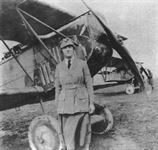 |
C.Owers - Fokker Aircraft of WWI. Vol.7: Postwar /Centennial Perspective/ (67)
|
| WRAF member poses in front of a Fokker D.VII Note "76" on cowl panel - part of serial number? The pilot in the background is examining another D.VII. (Location suggested as Lympne).
|
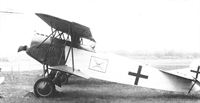 |
C.Owers - Fokker Aircraft of WWI. Vol.7: Postwar /Centennial Perspective/ (67)
|
| The ex-Nash Fokker D.VII as displayed in 1957 by the Royal Aeronautical Society. The fuselage is white with skull and crossed bones insignia, and vermilion and white wings, said to have been the scheme when with Jasta 71. The scheme was supplied by Mr Nash and has proved to be inauthentic. Restored in authentic colours the D.VIII now resides in the RAF Museum, Hendon.
|
 |
C.Owers - Fokker Aircraft of WWI. Vol.7: Postwar /Centennial Perspective/ (67)
|
| With the Swedish Army serial No. 937, Goring's D.VII was used as an unarmed trainer by the Flygkompaniet.
|
 |
J.Herris - Fokker Aircraft of WWI. Vol.1: Spinne - M.10 & Watercraft /Centennial Perspective/ (51)
|
The Fokker D.VII enjoyed a long and successful postwar career in a number of countries; here is 937 in Sweden. 937 was a demonstration aircraft brought in and left by Hermann Goring in 1919. Goering worked for Fokker but Fokker let him down and Goring had to take a job in Sweden. There he met baroness Karin von Kantzow, whom he married in 1923.
Only one Fokker D.VII was used by the AFK.
|
 |
C.Owers - Fokker Aircraft of WWI. Vol.7: Postwar /Centennial Perspective/ (67)
|
| Remarkably, the high performance Fokker D.VII was rarely flown by AFK pilots. Via Colin Owers
|
 |
C.Owers - Fokker Aircraft of WWI. Vol.7: Postwar /Centennial Perspective/ (67)
|
| Fokker D.VII in Sweden postwar. It was flown there by Hermann Goring. The axle airfoil has been removed, showing the structure.
|
 |
J.Forsgren - Swedish Military Aircraft 1911-1926 /Centennial Perspective/ (68)
|
| BMW IIIa powered Fokker D.VIIF 7716/18 (w/n 1549) is thought to have been specially prepared for Bruno Lorzer, the commander of JG III. Herman Goring flew the machine to Sweden. Whether this was his machine or he was merely a middle-man has not been confirmed. Although a civilian machine it still has the machine gun chutes fitted. The weights legend has been carefully retained on the bands. It was later sold to the AFK.
|
 |
C.Owers - Fokker Aircraft of WWI. Vol.7: Postwar /Centennial Perspective/ (67)
|
|
|
 |
C.Owers - Fokker Aircraft of WWI. Vol.7: Postwar /Centennial Perspective/ (67)
|
| Fokker D.VII with Finnish markings replacing the German national markings. The machine is in lozenge pattern fabric with typical OAW painted cowlings.
|
 |
C.Owers - Fokker Aircraft of WWI. Vol.7: Postwar /Centennial Perspective/ (67)
|
| Fokker D.VII serial 1C.357 in hangar at Utti, 1920. It was serving in Ilmailuosasto (Aviation Detachment) 2 at the time.
|
 |
C.Owers - Fokker Aircraft of WWI. Vol.7: Postwar /Centennial Perspective/ (67)
|
| Fokker D.VII (OAW) 8545/18, Finnish 1C.357 at Utti, 1920. No armament appears to be present.
|
 |
C.Owers - Fokker Aircraft of WWI. Vol.7: Postwar /Centennial Perspective/ (67)
|
| D.VII 1.D.357 in experimental 'splinter' camouflage scheme. The hard line defining the wing leading edge is noteworthy.
|
 |
C.Owers - Fokker Aircraft of WWI. Vol.7: Postwar /Centennial Perspective/ (67)
|
| With new serial 1.D.357 this D.VII has been fitted with skis. It is in the 'splinter' camouflage that was experimentally tried on the D.VII and some IVL A.22 floatplanes.
|
 |
C.Owers - Fokker Aircraft of WWI. Vol.7: Postwar /Centennial Perspective/ (67)
|
| 1.D.357 in flight shows off the 'splinter' camouflage scheme.
|
 |
J.Herris - Fokker Aircraft of WWI. Vol.6: Foreign Service /Centennial Perspective/ (56)
|
| Fokker-built D.VII with 225 hp Daimler and Schwarzlose machine guns in original lozenge fabric. After MAG installed engines and armament, six Fokker D.VII fighters entered Hungarian service in 1919 and saw service against Czechoslovakian forces. The work number of this Fokker-built D.VII, captured by Czechoslovakian troops and photographed in Czech markings, is not known. This photo was taken in autumn 1919.
|
 |
P.Grosz, G.Haddow, P.Shiemer - Austro-Hungarian Army Aircraft of World War One /Flying Machines/
|
| A Hungarian Fokker D.VII (MAG) captured by Czechoslovak forces in the course of the postwar fighting. The aircraft was armed with two Spandau LMG 08/15 machine guns.
|
 |
C.Owers - Fokker Aircraft of WWI. Vol.7: Postwar /Centennial Perspective/ (67)
|
Fokker-built D.VII work number, 3867, in Czech service after capture in 1919. Its radiator is more angular than the German original, and it has a Heiduk propeller. (Peter M. Grosz collection/STDB)
As first received in lozenge camouflage fabric finish, the Czech D.VII displays the radiator that is a hallmark of the Austro-Daimler engine. The armament is twin Schwarzlose machine guns. The early Czech roundel was applied and no fuselage serial is applied at this time.
|
 |
J.Herris - Fokker Aircraft of WWI. Vol.6: Foreign Service /Centennial Perspective/ (56)
|
| Fokker-built D.VII work number 3867, side number 16, with 225 hp Daimler and without its Schwarzlose machine guns is the third aircraft from left. The number '16' was its race number for the 1st National aviation meeting in September 1921, Prague-Kbely airfield.
|
 |
J.Herris - Fokker Aircraft of WWI. Vol.6: Foreign Service /Centennial Perspective/ (56)
|
| Fokker-built D.VII with 225 hp Daimler and Schwarzlose machine guns, now in Czechoslovak camouflage and markings. It entered Hungarian service in 1919; captured by Czechoslovakian troops it was repainted in Czechoslovakian markings. Its serial number, 38.67, was an adaptation of its Fokker work number, 3867. The radiator is subtly different than D.VII aircraft with German engines. It is shown here in 1923 with Sigma propeller. (Peter M. Grosz collection/STDB)
|
 |
C.Owers - Fokker Aircraft of WWI. Vol.7: Postwar /Centennial Perspective/ (67)
|
| D.VII 38.67 at Olomouc airfield, 1923. The machine had been repaired after a heavy landing in October 1921, and emerged again in a four colour camouflage scheme with the new Czechoslovakian markings.
|
 |
C.Owers - Fokker Aircraft of WWI. Vol.7: Postwar /Centennial Perspective/ (67)
|
| Personnel posing with 38.67.
|
 |
C.Owers - Fokker Aircraft of WWI. Vol.7: Postwar /Centennial Perspective/ (67)
|
| A pilot posing in front of 38.67. The airscrew is now a four-bladed Knoller-Jarray type and a white rectangle has been added to the fuselage side - this being the marking of the Vzduchoplavecke uciliste (Aeronautical Training Centre).
|
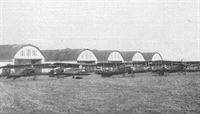 |
J.Herris - LVG Aircraft of WWI. Volume 3: Types C.VI-C.XI & Fighters /Centennial Perspective/ (36)
|
| Postwar Czech airfield with LVG C.VI at right front; Austro-Hungarian Fokker D.VII at left front. (Zahalka)
|
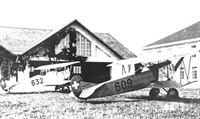 |
C.Owers - Fokker Aircraft of WWI. Vol.7: Postwar /Centennial Perspective/ (67)
|
| Two Swiss Fokker D.VII trainers in two different colour schemes.
|
 |
C.Owers - Fokker Aircraft of WWI. Vol.7: Postwar /Centennial Perspective/ (67)
|
| Swiss D.VII No. 609 with the engine panels removed. The turtle decking around the cockpit appears to have been removed as well. A venturi is fixed to the upper wing. The white crosses are on a small red field.
|
 |
C.Owers - Fokker Aircraft of WWI. Vol.7: Postwar /Centennial Perspective/ (67)
|
| No. 621 displays the two additional stringers added to the fuselage. The insignia on the rudder is on a white square field.
|
 |
C.Owers - Fokker Aircraft of WWI. Vol.7: Postwar /Centennial Perspective/ (67)
|
| No. 621 on a snow-covered field. The rudder is red with the white cross while the insignia on the wings is full chord.
|
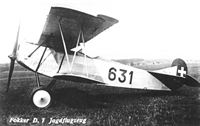 |
C.Owers - Fokker Aircraft of WWI. Vol.7: Postwar /Centennial Perspective/ (67)
|
| Unarmed No. 631 in the light colour scheme. The rudder is red and a weights legend is carried forward of the cockpit.
|
 |
C.Owers - Fokker Aircraft of WWI. Vol.7: Postwar /Centennial Perspective/ (67)
|
| Unarmed No. 631 in the light colour scheme. The rudder is red and a weights legend is carried forward of the cockpit.
|
 |
C.Owers - Fokker Aircraft of WWI. Vol.7: Postwar /Centennial Perspective/ (67)
|
| A D VII of Fliegerkompagnie 10 of the Swiss Fliegertruppe in the mid ’twenties, with 'Fokker' on radiator and bird insignia.
|
 |
C.Owers - Fokker Aircraft of WWI. Vol.7: Postwar /Centennial Perspective/ (67)
|
| This Swiss Fokker D.VII has individual exhaust pipes to the engine.
|
 |
C.Owers - Fokker Aircraft of WWI. Vol.7: Postwar /Centennial Perspective/ (67)
|
| A Swiss D.VII.
|
 |
C.Owers - Fokker Aircraft of WWI. Vol.7: Postwar /Centennial Perspective/ (67)
|
| A poor photograph showing an early D.VII in Netherlands service. The machine is armed and has the orange circle insignia on a white field to the fuselage and under both wings. The fuselage was probably in lozenge fabric as was the tailplane.
|
 |
C.Owers - Fokker Aircraft of WWI. Vol.7: Postwar /Centennial Perspective/ (67)
|
| Two civil Fokker D.VII F fighters in the Netherlands. Fokker marked the aircraft with orange circles such as were applied to the Netherlands military aircraft. These fighters do not have serials stenciled on them. While no armament is installed, the mountings may be seen.
|
 |
C.Owers - Fokker Aircraft of WWI. Vol.7: Postwar /Centennial Perspective/ (67)
|
| Sgt Bakkenes with a D.VII that is in lozenge fabric and has the orange circle insignia.
|
 |
C.Owers - Fokker Aircraft of WWI. Vol.7: Postwar /Centennial Perspective/ (67)
|
| Sgt Need with a D.VII with the early orange circle insignia without the white surround. The machine has been doped green overall. Armament is not fitted but the gun chutes are intact.
|
 |
C.Owers - Fokker Aircraft of WWI. Vol.7: Postwar /Centennial Perspective/ (67)
|
| Serial No. 250 have the 250-hp BMW installed. This D.VII fighters are armed and bear a longitudinal stringer along the centre of the fuselage. The same stringer has been noted on No. 271.
|
 |
C.Owers - Fokker Aircraft of WWI. Vol.7: Postwar /Centennial Perspective/ (67)
|
| An unarmed serial No. 250 still has the ammunition feeds on the starboard side of the top cowling.
|
 |
C.Owers - Fokker Aircraft of WWI. Vol.7: Postwar /Centennial Perspective/ (67)
|
| Overhauling serial No. 250.
|
 |
C.Owers - Fokker Aircraft of WWI. Vol.7: Postwar /Centennial Perspective/ (67)
|
| Serial No. 251 win the early scheme of green overall with orange circle insignia. The serial was repeated along the rear fuselage with the engine installed - F 251 Mc 160.
|
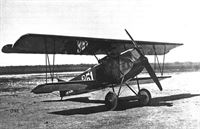 |
C.Owers - Fokker Aircraft of WWI. Vol.7: Postwar /Centennial Perspective/ (67)
|
|
|
 |
C.Owers - Fokker Aircraft of WWI. Vol.7: Postwar /Centennial Perspective/ (67)
|
| Serial No. 256 have the 250-hp BMW installed. This D.VII fighters are armed and bear a longitudinal stringer along the centre of the fuselage. The same stringer has been noted on No. 271.
|
 |
C.Owers - Fokker Aircraft of WWI. Vol.7: Postwar /Centennial Perspective/ (67)
|
| A pristine LVA Fokker D.VII No. 256 with navigation lights on the upper wing tips, underwing racks and no armament.
|
 |
C.Owers - Fokker Aircraft of WWI. Vol.7: Postwar /Centennial Perspective/ (67)
|
| D.VII No. 256 after hitting a trainer on 27 August 1924.
|
 |
C.Owers - Fokker Aircraft of WWI. Vol.7: Postwar /Centennial Perspective/ (67)
|
| An unarmed serial No. 256 in an embarrassing position!
|
 |
C.Owers - Fokker Aircraft of WWI. Vol.7: Postwar /Centennial Perspective/ (67)
|
| The underwing racks were handy for fitting meteorological instruments. Serial No. 257 does not have the logo showing the engine on its rear fuselage.
|
 |
C.Owers - Fokker Aircraft of WWI. Vol.7: Postwar /Centennial Perspective/ (67)
|
| Line up of LVA Fokker D.VII fighters with the first national insignia. Nos. 254, 256, 250 and 258 identified.
|
 |
C.Owers - Fokker Aircraft of WWI. Vol.7: Postwar /Centennial Perspective/ (67)
|
| No. 258 looks to have suffered little damage when the pilot, Brinkuis, performed this landing near Diemen on 8 October 1926. The hand hold markings at the wing tips are well shown.
|
 |
C.Owers - Fokker Aircraft of WWI. Vol.7: Postwar /Centennial Perspective/ (67)
|
| No. 259 as a backdrop to this pilot's portrait. The guns have been removed but the ammunition feeds are still in place.
|
 |
C.Owers - Fokker Aircraft of WWI. Vol.7: Postwar /Centennial Perspective/ (67)
|
| No. 259 is the centre of attention after making a successful forced landing due to engine trouble in 1931.
|
 |
C.Owers - Fokker Aircraft of WWI. Vol.7: Postwar /Centennial Perspective/ (67)
|
| Serial No. 260 carries an unusual application of the serial number with the Fokker added before the serial.
|
 |
C.Owers - Fokker Aircraft of WWI. Vol.7: Postwar /Centennial Perspective/ (67)
|
| LVA unarmed D.VII fighters, serial Nos. 260, 266 and 265 identified in this photograph. The serial on the light coloured D.VII cannot be read. It appears to have a fuel tank in the axle fairing.
|
 |
C.Owers - Fokker Aircraft of WWI. Vol.7: Postwar /Centennial Perspective/ (67)
|
| Serial No. 263 also carries the Fokker aft its serial.
|
 |
C.Owers - Fokker Aircraft of WWI. Vol.7: Postwar /Centennial Perspective/ (67)
|
| D.VII Nos 260 and 263 in storage with Fokker C.I No. 499 behind. It is thought that the Fokker stencil to the fuselage was applied when the two machines went to Iceland in 1932.
|
 |
C.Owers - Fokker Aircraft of WWI. Vol.7: Postwar /Centennial Perspective/ (67)
|
| A line-up of unarmed D.VII fighters. Nos. 265 and 262 identified. The engine panels are natural metal; the lower surfaces are in light blue. At the International Aero Exhibition Gothenburg (ILUG), Sweden, in 1923.
|
 |
C.Owers - Fokker Aircraft of WWI. Vol.7: Postwar /Centennial Perspective/ (67)
|
| In this view it can be clearly seen that the armament is missing from No. 265. At the International Aero Exhibition Gothenburg (ILUG), Sweden, in 1923.
|
 |
C.Owers - Fokker Aircraft of WWI. Vol.7: Postwar /Centennial Perspective/ (67)
|
|
|
 |
C.Owers - Fokker Aircraft of WWI. Vol.7: Postwar /Centennial Perspective/ (67)
|
| Serial No. 267 warming up on a winter's airfield.
|
 |
C.Owers - Fokker Aircraft of WWI. Vol.7: Postwar /Centennial Perspective/ (67)
|
| A Ford tanker refuels No. 267.
|
 |
C.Owers - Fokker Aircraft of WWI. Vol.7: Postwar /Centennial Perspective/ (67)
|
| Serial No. 269 with the instrument rack on its port interplane strut. Note the light coloured undersurfaces.
|
 |
C.Owers - Fokker Aircraft of WWI. Vol.7: Postwar /Centennial Perspective/ (67)
|
| Sgt Beekman with his D.VII. This aircraft was one delivered with the 180-hp BMW engine.
|
 |
C.Owers - Fokker Aircraft of WWI. Vol.7: Postwar /Centennial Perspective/ (67)
|
| The details behind this incident would be most welcome.
|
 |
C.Owers - Fokker Aircraft of WWI. Vol.7: Postwar /Centennial Perspective/ (67)
|
| The remains of serial No. 271. The serial can just be made out on the rear fuselage. The force of the impact must have been tremendous to cause the machine to end up like this.
|
 |
C.Owers - Fokker Aircraft of WWI. Vol.7: Postwar /Centennial Perspective/ (67)
|
| MLD Fokker D.VII fighters on the barge to De Kooy. D.VII Serial Nos. D-20, D-21. D-22, D-24 and D-25 identified. These fighters all have the early orange disk national insignia.
|
 |
C.Owers - Fokker Aircraft of WWI. Vol.7: Postwar /Centennial Perspective/ (67)
|
| MLD fighters with the headrest and fuel tank in the upper wing. D-20 has a coloured band around the fuselage, however, the wing bands appear white. The additional longitudinal stringer to the fuselage shows up well in this photograph.
|
 |
C.Owers - Fokker Aircraft of WWI. Vol.7: Postwar /Centennial Perspective/ (67)
|
| Serial No. D-21 with fully equipped pilot.
|
 |
C.Owers - Fokker Aircraft of WWI. Vol.7: Postwar /Centennial Perspective/ (67)
|
MLD D-24 showing the tightly cowled BMW engine and the underslung radiator. White bands are carried around the fuselage and wings.
Fok. D.VII in Dutch service. This aircraft has a belly radiator and much-modified engine cowling, steel airscrew, enlarged windscreen, and metal cowling panels as far aft as the cockpit.
|
 |
C.Owers - Fokker Aircraft of WWI. Vol.7: Postwar /Centennial Perspective/ (67)
|
| D-28 showing the modification to the MLD Fokker D.VII fighters with the 230-hp BMW IV motor.
|
 |
C.Owers - Fokker Aircraft of WWI. Vol.7: Postwar /Centennial Perspective/ (67)
|
| D-28 showing the modification to the MLD Fokker D.VII fighters with the 230-hp BMW IV motor.
|
 |
C.Owers - Fokker Aircraft of WWI. Vol.7: Postwar /Centennial Perspective/ (67)
|
| D-29 is another MLD D.VII with a headrest and the serial omitting the dash.
|
 |
C.Owers - Fokker Aircraft of WWI. Vol.7: Postwar /Centennial Perspective/ (67)
|
| The unarmed D-30 has the additional fuselage stringer but no headrest. The serial omits the dash.
|
 |
C.Owers - Fokker Aircraft of WWI. Vol.7: Postwar /Centennial Perspective/ (67)
|
| Serial D-35 is unarmed.
|
 |
C.Owers - Fokker Aircraft of WWI. Vol.7: Postwar /Centennial Perspective/ (67)
|
| Serial No. D-36 is unarmed.
|
 |
C.Owers - Fokker Aircraft of WWI. Vol.7: Postwar /Centennial Perspective/ (67)
|
| Serial No. D-37 in flight. The upper motor cowling is missing.
|
 |
C.Owers - Fokker Aircraft of WWI. Vol.7: Postwar /Centennial Perspective/ (67)
|
| Possibly the prototype Puma engined D.VII for the KNIL.
|
 |
C.Owers - Fokker Aircraft of WWI. Vol.7: Postwar /Centennial Perspective/ (67)
|
| Two unmarked Puma-powered KNIL Fokker D.VII fighters, not D.VIII as written on the photograph. The ammunition feed is visible on the nearest D.VII.
|
 |
C.Owers - Fokker Aircraft of WWI. Vol.7: Postwar /Centennial Perspective/ (67)
|
| An unmarked KNIL D.VII in Fokker's hangar.
|
 |
C.Owers - Fokker Aircraft of WWI. Vol.7: Postwar /Centennial Perspective/ (67)
|
| The Puma installation in the KNIL Fokker D.VII.
|
 |
C.Owers - Fokker Aircraft of WWI. Vol.7: Postwar /Centennial Perspective/ (67)
|
| Five unmarked Puma D.VII trainers for the KNIL.
|
 |
C.Owers - Fokker Aircraft of WWI. Vol.7: Postwar /Centennial Perspective/ (67)
|
| F-301 in full national markings.
|
 |
C.Owers - Fokker Aircraft of WWI. Vol.7: Postwar /Centennial Perspective/ (67)
|
| Carrying a cat insignia on its rudder, F-302 in flight.
|
 |
C.Owers - Fokker Aircraft of WWI. Vol.7: Postwar /Centennial Perspective/ (67)
|
|
|
 |
C.Owers - Fokker Aircraft of WWI. Vol.7: Postwar /Centennial Perspective/ (67)
|
| KNIL Fokker D.VII trainers F-301 to F-305 in flight. Each has an insignia on the top rudder stripe.
|
 |
C.Owers - Fokker Aircraft of WWI. Vol.7: Postwar /Centennial Perspective/ (67)
|
| KNIL Fokker D.VII trainers F-301 to F-305 in flight. Each has an insignia on the top rudder stripe.
|
 |
C.Owers - Fokker Aircraft of WWI. Vol.7: Postwar /Centennial Perspective/ (67)
|
| The five KNIL Fokker D.VII trainers over Batavia. No. F-303 has no upper wing national markings.
|
 |
C.Owers - Fokker Aircraft of WWI. Vol.7: Postwar /Centennial Perspective/ (67)
|
| Kalidjati airport, Netherlands Easts Indies (now Indonesia). KNIL Avros 504 trainers, de Havilland D.H.9 bombers and Fokker D.VII trainers on the field. The cat emblem appears on the rudder of at least two of the D.H.9 bombers.
|
 |
C.Owers - Fokker Aircraft of WWI. Vol.7: Postwar /Centennial Perspective/ (67)
|
| The civil D.VII in Dansk Luft Rederi markings. Unfortunately, the serial number has been painted over. The machine was covered in lozenge fabric overall but without German national markings.
|
 |
C.Owers - Fokker Aircraft of WWI. Vol.7: Postwar /Centennial Perspective/ (67)
|
|
|
 |
C.Owers - Fokker Aircraft of WWI. Vol.7: Postwar /Centennial Perspective/ (67)
|
| Taken in to Danish service the aircraft was doped a dark colour overall with Danish roundels. The serial 'F Nr.1' was placed in the centre of the rudder roundel.
|
 |
C.Owers - Fokker Aircraft of WWI. Vol.7: Postwar /Centennial Perspective/ (67)
|
| D.VII 7684/18 with the German insignia over-painted with Belgian markings; otherwise this fully armed machine is in full German camouflage, (via D Brackx)
|
 |
C.Owers - Fokker Aircraft of WWI. Vol.7: Postwar /Centennial Perspective/ (67)
|
| View of Moeres airfield post-war. D.VII 6693/18 bears the Thistle emblem of the 9th Escadrille as does the Hanriot H.D.1 parked next to it. The serial 'F 2' is presented on the middle rudder stripe. The Escadrille was equipped with the Hanriot H.D.1 and the Fokkers were used as trainers - given that they had a stationary engine and were more powerful than the Hanriots, this seems a strange combination of types. A late-war Gotha bomber can be seen in the background. Belgium's air arm used some of these bombers along with other German types in the years following WWL (via D Brackx)
|
 |
C.Owers - Fokker Aircraft of WWI. Vol.7: Postwar /Centennial Perspective/ (67)
|
| Fokker D.VII 6689/18 flown by the Belgian Air Service in German camouflage.
|
 |
C.Owers - Fokker Aircraft of WWI. Vol.7: Postwar /Centennial Perspective/ (67)
|
| D.VII No 13 leads this line-up. An Avro 504K is at the far end of the line.
|
 |
C.Owers - Fokker Aircraft of WWI. Vol.7: Postwar /Centennial Perspective/ (67)
|
| Fokker D.VII fighters flown by the Belgian Air Service as trainers at the pilot school at Wevelgem airbase in khaki overall. (Daniel Brackx)
|
 |
C.Owers - Fokker Aircraft of WWI. Vol.7: Postwar /Centennial Perspective/ (67)
|
| D.VII No. 34 had stars applied to the wheel covers. The cockpit modification into an unarmed trainer has a small headrest.
|
 |
C.Owers - Fokker Aircraft of WWI. Vol.7: Postwar /Centennial Perspective/ (67)
|
| Pitchou Lang poses in front of an unarmed Fokker D.VII with the red comet of the 10th Escadrille. The fuselage has been overpainted but the mainplanes and horizontal tail surfaces are still lozenge fabric, (via D Brackx)
|
 |
C.Owers - Fokker Aircraft of WWI. Vol.7: Postwar /Centennial Perspective/ (67)
|
| Belgian pilot Hugon Sylvain in his Fokker D.VII at Evere. The lozenge fabric has been overpainted and the machine is without armament, (via D Brackx)
|
 |
C.Owers - Fokker Aircraft of WWI. Vol.7: Postwar /Centennial Perspective/ (67)
|
| D.VII in markings for the film L'Yser.
|
 |
C.Owers - Fokker Aircraft of WWI. Vol.7: Postwar /Centennial Perspective/ (67)
|
| A D.VII from the film L'Equipage painted up in a diamond pattern, presumably to represent the losenge fabric. The single machine gun mounted on these machines is clearly seen.
|
 |
C.Owers - Fokker Aircraft of WWI. Vol.7: Postwar /Centennial Perspective/ (67)
|
| A L'Equipage D.VII set up for ground filming.
|
 |
C.Owers - Fokker Aircraft of WWI. Vol.7: Postwar /Centennial Perspective/ (67)
|
| Two almost identical photograph that are thought to show the result of the collision of one of the L'Equipage D.VII biplanes and an Avro 504K that was approaching to land.
|
 |
C.Owers - Fokker Aircraft of WWI. Vol.7: Postwar /Centennial Perspective/ (67)
|
| O-BABY still carries the Belgian rudder stripes and the roundels on the wings are faintly visible.
|
 |
C.Owers - Fokker Aircraft of WWI. Vol.7: Postwar /Centennial Perspective/ (67)
|
| O-BEBE about to start in an air race. The machine is still in lozenge fabric.
|
 |
C.Owers - Fokker Aircraft of WWI. Vol.7: Postwar /Centennial Perspective/ (67)
|
| Ploughshares - Civilian Fokker D.VII biplanes O-BILL and O-BEBE with Belgian Rumpler C types on a civil airfield. The Fokkers and at least one Rumpler are still in lozenge fabric. (via D Brackx)
|
 |
C.Owers - Fokker Aircraft of WWI. Vol.7: Postwar /Centennial Perspective/ (67)
|
| An unarmed D.VII in French hands post-Armistice. The German national markings have been crudely painted over on the fuselage but the personal marking appears to have been partially destroyed, however, it may just have deteriorated due to its age and use. (AHT AL0385-08)
|
 |
C.Owers - Fokker Aircraft of WWI. Vol.7: Postwar /Centennial Perspective/ (67)
|
| The pilot in Fokker D.VII (OAW) 8493/18 has been identified as Andrew McKeever. The aircraft bears the Maple leaf emblem of No. 1 Squadron, CAF, Shoreham, 30 April 1919.
|
 |
C.Owers - Fokker Aircraft of WWI. Vol.7: Postwar /Centennial Perspective/ (67)
|
| The two Williams, Bishop and Barker, pose with an OAW built D.VII. Barker's uniform sleeve has three wound stripes.
|
 |
C.Owers - Fokker Aircraft of WWI. Vol.7: Postwar /Centennial Perspective/ (67)
|
| Barker and a female friend pose with one of the armed D.VII F fighters in Canada.
|
 |
C.Owers - Fokker Aircraft of WWI. Vol.7: Postwar /Centennial Perspective/ (67)
|
| A black and white finished Air Service LUSAC 11 is lined-up behind the D.VII.
|
 |
C.Owers - Fokker Aircraft of WWI. Vol.7: Postwar /Centennial Perspective/ (67)
|
| William Barker in the Fokker D.VII that he flew in the Toronto to New York race. The machine guns are missing and the cowling faired in. There is no windscreen and the upper engine cowl panels are missing. The race No. 50 was applied to the fuselage and under the wings. Another D.VII is visible in the hangar in the background. These photographs were taken at Armour Heights in 1919.
|
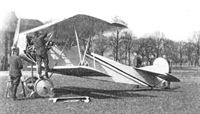 |
C.Owers - Fokker Aircraft of WWI. Vol.7: Postwar /Centennial Perspective/ (67)
|
| This Fokker D.VII (Albatros built) has been repainted and bears the insignia of the 9th Aero Squadron but retains the German crosses on the wings. The photograph was taken at Trier, Germany, in January 1919. The 9th Aero Squadron had at least two Fokkers that were flown by members of the squadron. These Fokkers were stated to be used to check that the Germans were abiding by the terms of the Armistice, however it seems more likely that they were placed into flying order in order to let the pilots obtain experience of the D.VII that was then the prime German fighter. Due to the unsettled state of affairs following the Armistice, it would have been advantageous for the Allied airmen to try the D.VII in flight.
|
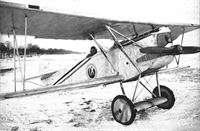 |
C.Owers - Fokker Aircraft of WWI. Vol.7: Postwar /Centennial Perspective/ (67)
|
| Fokker D.VII that bears the insignia of the 9th Aero Squadron. The photograph was taken at Trier, Germany, in January 1919.
|
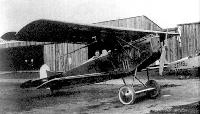 |
В.Обухович, А.Никифоров - Самолеты Первой Мировой войны
|
|
|
 |
C.Owers - Fokker Aircraft of WWI. Vol.7: Postwar /Centennial Perspective/ (67)
|
| This is possibly No.2, the Fokker D.VII (O.A.W.) that was flown in the 'First Transcontinental Reliability and Endurance Test' by Col C.C. Culver.
|
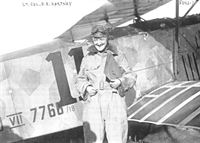 |
C.Owers - Fokker Aircraft of WWI. Vol.7: Postwar /Centennial Perspective/ (67)
|
| Lt Col Harold Evans Hartney with Fokker D.VII 7766/18 with the large racing number '11' on the fuselage - his entry in the 'First Transcontinental Reliability and Endurance Test'
|
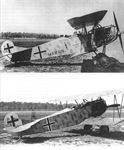 |
C.Owers - Fokker Aircraft of WWI. Vol.7: Postwar /Centennial Perspective/ (67)
|
| McCook P-108 (7776/18). It still has the gun mounts and ammunition chutes installed. An 'X' is painted on the upper wing centre section.
|
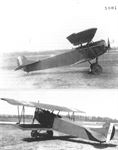 |
C.Owers - Fokker Aircraft of WWI. Vol.7: Postwar /Centennial Perspective/ (67)
|
| This D.VII with Liberty 6 motor, McCook P-127, sports a long pitot on the port interplane strut. The stencil on the central rudder stripe reads 'Fokker D.VII 8323 P 127.' This machine received the Air Service serial No. 94040.
|
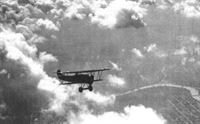 |
C.Owers - Fokker Aircraft of WWI. Vol.7: Postwar /Centennial Perspective/ (67)
|
| This is one of the D.VII fighters modified to carry an experimental engine. The under cowl bulge suggests the Liberty V-8 engine.
|
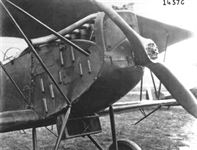 |
C.Owers - Fokker Aircraft of WWI. Vol.7: Postwar /Centennial Perspective/ (67)
|
| An additional radiator experiment using a Fokker D.VII.
|
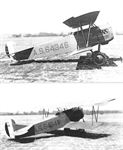 |
C.Owers - Fokker Aircraft of WWI. Vol.7: Postwar /Centennial Perspective/ (67)
|
| Single-seat D.VII serial No. A.S.64346 bearing McCook No. P-195 on its rudder. According to the late R Casari's U.S. Army Aviation Serial Numbers & Orders 1908-1923 Reconstructed, (Military Aircraft Publications, USA. 1995), this D.VII was given this serial to replace its German serial 8403. It appears to have a V-12 engine installed. As far as is known, McCook P numbers were not reused.
|
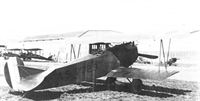 |
C.Owers - Fokker Aircraft of WWI. Vol.7: Postwar /Centennial Perspective/ (67)
|
| This D.VII in full USAS markings bears the serial A.S.7729 indicating it was 7729/18. The machine is unarmed with the large faired windscreen. US DH-4 bomber in the background.
|
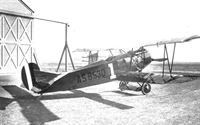 |
C.Owers - Fokker Aircraft of WWI. Vol.7: Postwar /Centennial Perspective/ (67)
|
| This unarmed D.VII, A.S..8530, has a slightly different serial application and an individual number that will stand out in flight. The engine cowling appears to be modified.
|
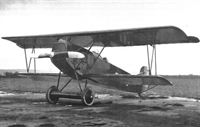 |
C.Owers - Fokker Aircraft of WWI. Vol.7: Postwar /Centennial Perspective/ (67)
|
| Unarmed A-5845 used by the Marine Corps in full colour scheme. The lettering on the fuselage can not be determined but may be 'Hans'.
|
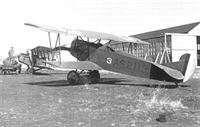 |
C.Owers - Fokker Aircraft of WWI. Vol.7: Postwar /Centennial Perspective/ (67)
|
| A.S.2113 bears the same style of serial application with 'Fok D VII' stenciled under the serial. It also bears the plane number '3'. Curtiss Jennys in the background. Photographed at Post Field, Oklahoma.
|
 |
C.Owers - Fokker Aircraft of WWI. Vol.7: Postwar /Centennial Perspective/ (67)
|
| The D.VII in plain finish has been identified as a USN/USMC machine.
|
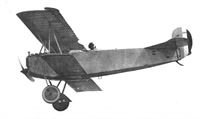 |
C.Owers - Fokker Aircraft of WWI. Vol.7: Postwar /Centennial Perspective/ (67)
|
| Only the '5845' Bureau No. on the central rudder stripe identifies this D.VII as a USMC aircraft.
|
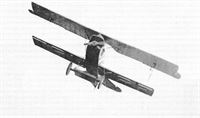 |
C.Owers - Fokker Aircraft of WWI. Vol.7: Postwar /Centennial Perspective/ (67)
|
| A D.VII in flight.
|
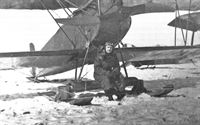 |
C.Owers - Fokker Aircraft of WWI. Vol.7: Postwar /Centennial Perspective/ (67)
|
| A D.VII fitted with skis for operating off snow covered fields.
|
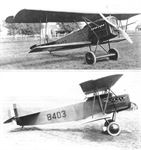 |
C.Owers - Fokker Aircraft of WWI. Vol.7: Postwar /Centennial Perspective/ (67)
|
| O.A.W. built 8403/18 was loaned to Packard to test their 1A-1116 motor. In these photographs, with it carrying a Packard engine, there is no P number on the rudder.
|
 |
A.Weyl - Fokker: The Creative Years /Putnam/
|
| U.S. Army Fok. D.VII with 350-h.p. Packard 1A-1237 engine.
|
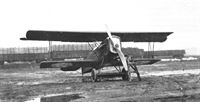 |
C.Owers - Fokker Aircraft of WWI. Vol.7: Postwar /Centennial Perspective/ (67)
|
| Packard engined D.VII showing the location of the underwing national markings.
|
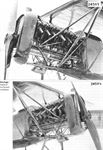 |
C.Owers - Fokker Aircraft of WWI. Vol.7: Postwar /Centennial Perspective/ (67)
|
| Details of the Packard installation.
|
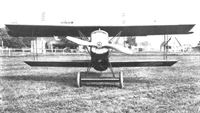 |
C.Owers - Fokker Aircraft of WWI. Vol.7: Postwar /Centennial Perspective/ (67)
|
| McCook Front view of a Fokker D.VII with the 12-cylinder Packard 1A-144 motor installed. At least four were so modified at McCook Field.
|
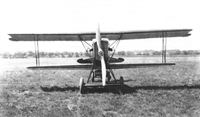 |
C.Owers - Fokker Aircraft of WWI. Vol.7: Postwar /Centennial Perspective/ (67)
|
| Front view of a McCook D.VII with what appears to be a V-eight motor. Note the subtle difference in the curvature of the radiator. The extra bracing to the centre section struts is noteworthy. There is no inlet in the under cowling panel. This machine's serial has not been determined.
|
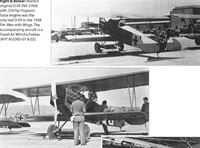 |
C.Owers - Fokker Aircraft of WWI. Vol.7: Postwar /Centennial Perspective/ (67)
|
| Mantz poses with his Fokker D.VII. At this time it has no machine guns mounted and a large windscreen. The exhaust outlets of the V-8 Hispano-Suiza engine are noteworthy.
|
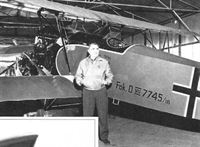 |
C.Owers - Fokker Aircraft of WWI. Vol.7: Postwar /Centennial Perspective/ (67)
|
| Mantz poses with his Fokker D.VII. At this time it has no machine guns mounted and a large windscreen. The exhaust outlets of the V-8 Hispano-Suiza engine are noteworthy.
|
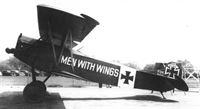 |
C.Owers - Fokker Aircraft of WWI. Vol.7: Postwar /Centennial Perspective/ (67)
|
| After the film was completed, the Paul Mantz Hispano-Suiza powered Fokker D.VII was painted with the movie's title and flown around the USA to promote William Wellman's colour motion picture Men with Wings.
|
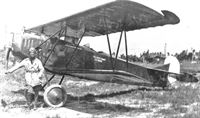 |
C.Owers - Fokker Aircraft of WWI. Vol.7: Postwar /Centennial Perspective/ (67)
|
| D.VII with Hall-Scott L-6 engine installed. Note the large hump in front of the cockpit. This is a single-seat D.VII.
|
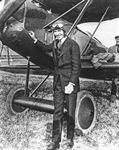 |
C.Owers - Fokker Aircraft of WWI. Vol.7: Postwar /Centennial Perspective/ (67)
|
| Eddie Rickenbacker posing with the same Hall Scott L-6 powered D.VII. The company logo is painted under the cockpit and under the lower wings
|
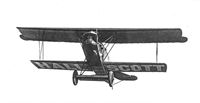 |
C.Owers - Fokker Aircraft of WWI. Vol.7: Postwar /Centennial Perspective/ (67)
|
| A Hall Scott D.VII in flight: There is no mistaking the engine in this D.VII; the twin carburettor intakes on the port side are well shown in this view.
|
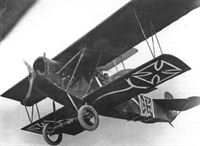 |
C.Owers - Fokker Aircraft of WWI. Vol.7: Postwar /Centennial Perspective/ (67)
|
| Oft reproduced photograph showing the closeness of the aircraft in Hells Angels. The straps around the fuselage that hold the camera are visible on each side of the fuselage cross. Hall-Scott powered example. (via late H Woodman)
|
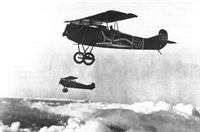 |
C.Owers - Fokker Aircraft of WWI. Vol.7: Postwar /Centennial Perspective/ (67)
|
| Two of the D.VII biplanes that were gathered by Howard Hughes for Hell's Angels. The nearest has von Richthofen painted under the cockpit. (via late H Woodman)
|
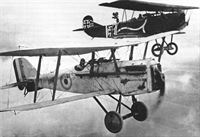 |
C.Owers - Fokker Aircraft of WWI. Vol.7: Postwar /Centennial Perspective/ (67)
|
| A D.VII and a S.E.5a line-up before shooting a scene. The camera mounted on the back of the D.VII was one of the ways that the aerial sequences in Hell's Angels have seldom been equaled. (via late H Woodman)
|
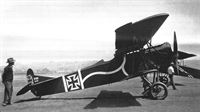 |
C.Owers - Fokker Aircraft of WWI. Vol.7: Postwar /Centennial Perspective/ (67)
|
|
|
 |
C.Owers - Fokker Aircraft of WWI. Vol.7: Postwar /Centennial Perspective/ (67)
|
| Original Fokker D.VII fighters on location for Hells Angels. The early curved national insignia was used and continues to be used in films as it is more cinematic than the straight late crosses.The closest D.VII has a Hispano-Suiza engine installed, while the other has a Hall-Scott with a flat radiator. (via late H Woodman)
|
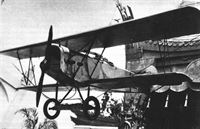 |
C.Owers - Fokker Aircraft of WWI. Vol.7: Postwar /Centennial Perspective/ (67)
|
A D.VII in a strange colour scheme was exhibited outside Gruman's Chinese at the Hollywood premier of Hell's Angels. The two carburettor intakes of the Hall-Scott L-6 are well shown in this view. (AHT AL0385-11)
|
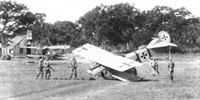 |
C.Owers - Fokker Aircraft of WWI. Vol.7: Postwar /Centennial Perspective/ (67)
|
| Graces' crashed Fokker D.VII on the set of Wings. The landing gear did not give way as planned and the'crash' was harder than allowed for. Grace broke his neck but did not realise it until the following day. Grace also spectacularly crashed a Spad 7 for this movie.
|
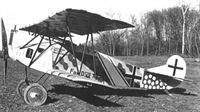 |
C.Owers - Fokker Aircraft of WWI. Vol.7: Postwar /Centennial Perspective/ (67)
|
| Cole Palen's Fokker D.VII reproduction at the Old Reinbeck Aerodrome was constructed using Fokker C.II parts.
|
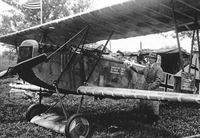 |
C.Owers - Fokker Aircraft of WWI. Vol.7: Postwar /Centennial Perspective/ (67)
|
| Jarrett's 'restored' Fokker D.VII.
|
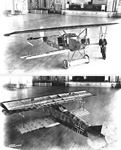 |
C.Owers - Fokker Aircraft of WWI. Vol.7: Postwar /Centennial Perspective/ (67)
|
| The Jarrett D.VII reconstruction. The wings did not follow the original construction.
|
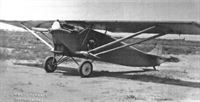 |
C.Owers - Fokker Aircraft of WWI. Vol.7: Postwar /Centennial Perspective/ (67)
|
A Rockerville modification of the Fokker D.VII into a monoplane, (via P.M. Bowers)
|
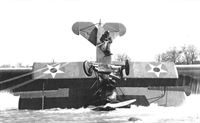 |
C.Owers - Fokker Aircraft of WWI. Vol.7: Postwar /Centennial Perspective/ (67)
|
| The pilot ended up in an embarrassing position when he force landed his D.VII in this river, downstream of the weir where the water was shallower and salvage was easier. Note the long pitot on the port interplane strut. Possibly P-127 that crashed in a river on 4 May 1920.
|
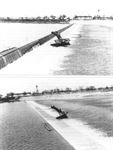 |
C.Owers - Fokker Aircraft of WWI. Vol.7: Postwar /Centennial Perspective/ (67)
|
|
|
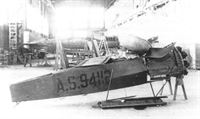 |
C.Owers - Fokker Aircraft of WWI. Vol.7: Postwar /Centennial Perspective/ (67)
|
| The remains of D.VIII McCook P-169, A.S.94112, probably in a McCook
|
 |
C.Owers - Fokker Aircraft of WWI. Vol.7: Postwar /Centennial Perspective/ (67)
|
| A Latvian D.VII that appears to be unarmed. The lozenge pattern can be distinguished through the over-painting on the original photograph.
|
 |
C.Owers - Fokker Aircraft of WWI. Vol.7: Postwar /Centennial Perspective/ (67)
|
| A Latvian pilot poses with his D.VIL The ugunskrusts (fire cross) national insignia has the arms rotating anticlockwise indicating an early application of the insignia.
|
 |
C.Owers - Fokker Aircraft of WWI. Vol.7: Postwar /Centennial Perspective/ (67)
|
| Latvian personnel pose with an armed Fokker D.VII. Part of the serial may be made out on the rear fuselage.
|
 |
J.Herris - Halberstadt Aircraft of WWI. Volume 2: CL.IV-CLS.I & Fighters /Centennial Perspective/ (45)
|
Fokker D.VII(OAW) 8595/18 (#4) flown by Lt. Munters, has crashed into Halberstadt C.V(DFW) 4237/18 (#19), both ex-Sachsenberg. (Moshe Bukhman)
This is thought to be the accident that finally ended in it being written off when it hit a Halberstadt C.V at the training squadron.
|
 |
C.Owers - Fokker Aircraft of WWI. Vol.7: Postwar /Centennial Perspective/ (67)
|
| Latvian Fokker D.VII No. 16 crashed on 27 February 1924 resulting in the death of the pilot, Kpt Edwins Bite. The aircraft appears to have been given a winter finish.
|
 |
C.Owers - Fokker Aircraft of WWI. Vol.7: Postwar /Centennial Perspective/ (67)
|
| Serial No.37 was constructed by the Lithuanian Army Aviation Workshop in 1930. The cockpit featured a headrest and revised rear fuselage. The lifting surface of the Fokker undercarriage has been eliminated.
|
 |
C.Owers - Fokker Aircraft of WWI. Vol.7: Postwar /Centennial Perspective/ (67)
|
| Lithuanian pilot A Gustaitis poses with D.VII serial No. 6, circa 1924.
|
 |
C.Owers - Fokker Aircraft of WWI. Vol.7: Postwar /Centennial Perspective/ (67)
|
| A Lithuanian pilot poses with a D.VII
|
 |
C.Owers - Fokker Aircraft of WWI. Vol.7: Postwar /Centennial Perspective/ (67)
|
| Personnel pose with D.VII Serial No.3 in aluminium finish. Circa 1925.
|
 |
C.Owers - Fokker Aircraft of WWI. Vol.7: Postwar /Centennial Perspective/ (67)
|
| Serial No.2 displays the second type of Lithuanian insignia. Kaunas airfield, circa 1921.
|
 |
C.Owers - Fokker Aircraft of WWI. Vol.7: Postwar /Centennial Perspective/ (67)
|
| Latvian Fokker D.VII No. 16 crashed on 27 February 1924 resulting in the death of the pilot, Kpt Edwins Bite. The aircraft appears to have been given a winter finish.
|
 |
C.Owers - Fokker Aircraft of WWI. Vol.7: Postwar /Centennial Perspective/ (67)
|
| Serial No.2 displays the second type of Lithuanian insignia. Kaunas airfield, circa 1921.
|
 |
C.Owers - Fokker Aircraft of WWI. Vol.7: Postwar /Centennial Perspective/ (67)
|
| Lithuanian airfield with a lone Fokker D.VII amongst Ansaldo biplanes obtained from Italy.
|
 |
C.Owers - Fokker Aircraft of WWI. Vol.7: Postwar /Centennial Perspective/ (67)
|
| D.VII serial No. 5 with personnel relaxing in summer, 1924. The machine has the top engine cowling panels removed and is armed.
|
 |
C.Owers - Fokker Aircraft of WWI. Vol.7: Postwar /Centennial Perspective/ (67)
|
| A Lithuanian aluminiun-doped D.VII serial No. 3 after its reconstruction in flight over Kaunas, circa 1926.
|
 |
C.Owers - Fokker Aircraft of WWI. Vol.7: Postwar /Centennial Perspective/ (67)
|
| The remains of serial No.5 after its fatal crash in 1933. The Fokker spun in and fell near Kaunas aerodrome while on its landing approach, killing the pilot-instructor A Stukas.
|
 |
C.Owers - Fokker Aircraft of WWI. Vol.7: Postwar /Centennial Perspective/ (67)
|
| Lakunas J Garolis in Puma engined D.VII No. 27, circa 1928. The installation of the Puma engine required an unslung radiator. The Netherlands KNIL modification to take the Puma was a much neater looking affair than this Lithuanian one.
|
 |
C.Owers - Fokker Aircraft of WWI. Vol.7: Postwar /Centennial Perspective/ (67)
|
| Lewandowka airfield, Lviv, in the early autumn of 1920. In the foreground, is Fokker D.VII CWL No. 22.04 (D.VII (OAW) 8588/18). Seated in the cockpit is 2nd Lt. pilot Antoni Bartkowiak, a pilot of the 15.EM (15th Fighter Squadron). The plane in the original finish, bearing all the characteristics for this series of OAW-built D.VII fighters. In the background is D.VII SLL No. 513/18, completely painted in dark green colour, also an aircraft from the 15.EM.
|
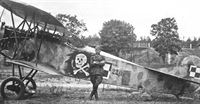 |
C.Owers - Fokker Aircraft of WWI. Vol.7: Postwar /Centennial Perspective/ (67)
|
| Fokker D.VII (OAW) CWL No. 22.05 "Memento Mori," belonging to the 13th Fighter Squadron (13.EM). At that time, the planes of this squadron had personal emblems painted on the aircraft sides. Aeroplane in original finish from OAW factory.
|
 |
C.Owers - Fokker Aircraft of WWI. Vol.7: Postwar /Centennial Perspective/ (67)
|
| Fokker D.VII No. 502/18, of Lt Pilot Wojciech Bialy of the 15th Fighter Squadron, Lewandowka airfield, August 1920. The plane in the original German finish characteristic for late production series from the Schneidemuhl plant. Visible under the fuselage is the carrier for two 12.5 kg P.u.W. bombs. According to the memoirs of the pilots, it was a rearmament of the aircraft to fight against Budyonny's cavalry. The synchronised machine guns are also unique. It was the only aircraft in the 15th EM to carry twin Vickers machine guns.
|
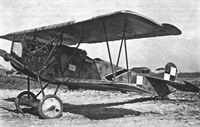 |
C.Owers - Fokker Aircraft of WWI. Vol.7: Postwar /Centennial Perspective/ (67)
|
| Another photo showing Fokker D.VII No. 502/18. The white, black and white chevron is the personal emblem of the pilot of the 15th Fighter Squadron (15.EM) Lt pil. Wojciech Bialy, (during the WWI a pilot of Jasta 47) who flew this machine most often. Photographed at Lewandowka airfield, Lviv, August 1920.
|
 |
C.Owers - Fokker Aircraft of WWI. Vol.7: Postwar /Centennial Perspective/ (67)
|
| Fokker SLL 511/18 (D.VII 4199/18 (OAW)) with of 2nd Lt. pilot Antoni Bartkowiak in the cockpit. Silesia, Sosnowiec, May 1921. At that time, the 15th EM was assigned to support the recent 3rd Silesian Uprising. Unfortunately, the squadron failed to achieve combat readiness and A Batrkowiak's plane was the only one to support the insurgents. For the occasion, the chessboards under the wings and on the side of the fuselage were painted over, leaving only the nationality markings on the upper wings.
|
 |
C.Owers - Fokker Aircraft of WWI. Vol.7: Postwar /Centennial Perspective/ (67)
|
| Fokker D.VII SLL no 519/18 photographed at the Lawica airport in the summer of 1920. In front of the plane "Directors" at the Higher School of Pilots (WSL): Pilot Second Lieutenant Antoni Wroniecki, Lieutenant Observer Szymyslik, Pilot Lieutenant Wawrzyn, Observer Second Lieutenant Korcz. The plane is in typical Albatross finish.
|
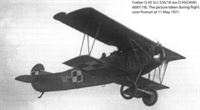 |
C.Owers - Fokker Aircraft of WWI. Vol.7: Postwar /Centennial Perspective/ (67)
|
| Fokker D.VII SLL 530/18 (ex-D.VII(OAW) 6687/18). The picture taken during flight over Poznan at 11 May 1921.
|
 |
C.Owers - Fokker Aircraft of WWI. Vol.7: Postwar /Centennial Perspective/ (67)
|
| Fokker Landing mishap at Wyzsza Szkola Pilotow (WSP - Advanced Pilots School) in Grudziadz, June 1922, is D.VII SLL.530/18 (ex-D.VII (OAW) 6687/18). The fuselage is in one-color overall, Polish dark green, with a light olivegray rudder. The wings were probably painted in two shades of Olive Green and Dark Green in a camouflage reminiscent of the streaked pattern painted in the Fokker factory during the WWI. The paint abrasions reveal the original OAW factory painting. Stencils on the rear part of the fuselage gave Polish informational and operational instructions: ‘St. Lotn. Lawica' and ‘Tu podpierac' (Support here). Under the cockpit was a weight table in black paint.
|
 |
C.Owers - Fokker Aircraft of WWI. Vol.7: Postwar /Centennial Perspective/ (67)
|
| Crashed Fokker SLL No. D.VII 546/18 on November 21, 1923 by the platoon pilot (Plutonowy) Gesek at the Lawica airfield. The accident did not look serious, but the aircraft was not repaired anymore. The plane is interwoven with the remains of post-renovation painting.
|
 |
C.Owers - Fokker Aircraft of WWI. Vol.7: Postwar /Centennial Perspective/ (67)
|
| Fokker D.VII no. 6697/18(Alb) crashed. Sergent, pil. Edmund Holodynski in May, 4th 1924. Aircraft in original factory camouflage, typical for this production batch from Albatros.
|
 |
C.Owers - Fokker Aircraft of WWI. Vol.7: Postwar /Centennial Perspective/ (67)
|
| Fokker D. VII nr 7658/18 (Fok) from 3dr Division Aviation Park. Aircraft in new camouflage, olivegreen-light ocher from the top and light blue from the bottom.
|
 |
C.Owers - Fokker Aircraft of WWI. Vol.7: Postwar /Centennial Perspective/ (67)
|
| Fokker D.VII nr 7658/18 (Fok) from 3dr Division Aviation Park. Aircraft in new camouflage, olivegreen-light ocher from the top and light blue from the bottom.
|
 |
C.Owers - Fokker Aircraft of WWI. Vol.7: Postwar /Centennial Perspective/ (67)
|
| Wrecked on March 6, 1923 by Lieutenant Karol Bieda Fokker D.VII 8422/18. As a result of the accident, the aviator was seriously injured, taken to a military hospital and died on the same day. The plane is in the original German camouflage, the repainting of hexagons, often visible on Polish Fokkers, is interesting.
|
 |
C.Owers - Fokker Aircraft of WWI. Vol.7: Postwar /Centennial Perspective/ (67)
|
| A commemorative photo taken in September 1920 at the Lewandowka airfield, showing the personnel and planes of the 15th Fighter Squadron. Aircraft from left: Fokker D.VIII 506/18; Fokker D.VII SLL 513/18; Fokker D.VII SLL 502/18; Fokker D.VII SLL 504/18; Fokker D.VII SLL 508/18; Fokker D.VII CWL 22.04 and Fokker D.VII SLL 511/18
|
 |
C.Owers - Fokker Aircraft of WWI. Vol.7: Postwar /Centennial Perspective/ (67)
|
| Fokker planes from the 15th EM at the Lewandowka airport in September 1920. The first from the left, the only one in Polish aviation, was Fokker D.VIII. 516/18. The shape and colour of the engine cover as well as the lozenge fabric covering seem to confirm this fact. An interesting fact is that all sources say that this plane was not armed. As can be seen in the photo, during the hottest battles with the Bolsheviks, the aircraft had two Spandau machine guns mounted. Further, one by one, Fokker D.VII (SLt No. 502/18), then in the center visible Fokker D.VII 10358/18 (Alb.) (SLL 504/18) with a personal emblem, initials "JH" inscribed in himself, belonging to the pilot Jozef Hendricks. Hereinafter Fokker D.VIIs: SLL 508/18; SLL 513/18; CWL 22.04; and SLL 511/18.
|
 |
C.Owers - Fokker Aircraft of WWI. Vol.7: Postwar /Centennial Perspective/ (67)
|
| Fokker D.VIIF CWL No.18.7 converted to courier version. This plane was assigned to Col. pilot Jerzy Kossowski (standing in front of the plane), commander of the 5th and then 3rd Fighter Squadron. The plane is unarmed, with an enlarged fuel tank and a spare trunk, which allows the passenger to be taken in an emergency. The entire plane (except the engine cowling) was painted a dark green.
|
 |
C.Owers - Fokker Aircraft of WWI. Vol.7: Postwar /Centennial Perspective/ (67)
|
The Fokker D.VII (MAG) 93.02 of the Hungarian Red Airborne Corps not only provides shade but also exhibits an extraordinarily long blast tube for the Schwarzlose M 16 machine gun.
Revolutionary D.VII 93.03. A MAG assembled machine fitted with a 225-hp Austro-Daimler engine and twin Schwarzlose MGs. Note blast tubes.
|
 |
C.Owers - Fokker Aircraft of WWI. Vol.7: Postwar /Centennial Perspective/ (67)
|
| These two D.VII fighters are in lozenge fabric. The red stars on the wheel covers (inner and outer) are noteworthy.
|
 |
C.Owers - Fokker Aircraft of WWI. Vol.7: Postwar /Centennial Perspective/ (67)
|
| Hungarian Soviet Republic of Bela Kun organized an air arm that utilized a red star as the national insignia. They carried their Austro-Hungarian serial at first. No. 38.69 on its back.
|
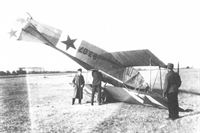 |
P.Grosz, G.Haddow, P.Shiemer - Austro-Hungarian Army Aircraft of World War One /Flying Machines/
|
| Fokker D.VII (MAG) 93.07 of the Hungarian Voros Repuloesapat (Red Airborne Corps) in trouble. A number of the MAG-built Fokkers saw service in the postwar border clashes.
|
 |
C.Owers - Fokker Aircraft of WWI. Vol.7: Postwar /Centennial Perspective/ (67)
|
| An open day at a Soviet airfield, probably at the Khodynka aerodrome in Moscow. The top surface of the upper wings of the aircraft appear to have been crudely censored. (via Gennady Petrov archive)
|
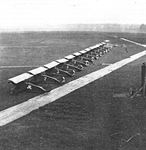 |
C.Owers - Fokker Aircraft of WWI. Vol.7: Postwar /Centennial Perspective/ (67)
|
| This line-up of Russian Fokker FD.VII fighters of the 1 st Separate Air Squadron at Gatchina aerodrome, have a variety of rudder markings, while the first in the line-up has an Egyptian head as an emblem. The ground crew relaxing between Fighters Nos. 1 and 2, show that people are the same everywhere, (via Gennady Petrov archive)
|
 |
C.Owers - Fokker Aircraft of WWI. Vol.7: Postwar /Centennial Perspective/ (67)
|
| Line-up of FD.VII at Gatchina airfield in 1923. The first aircraft has been stated to be a two-seat FD.VII, however it is more probably a Fokker C.I. (via Gennady Petrov archive)
|
 |
C.Owers - Fokker Aircraft of WWI. Vol.7: Postwar /Centennial Perspective/ (67)
|
| Since there is no one in the cockpit, this may be a demonstration on how to prime and start the motor. The end aircraft appears to be an Ansaldo. (via Gennady Petrov archive)
|
 |
L.Andersson - Soviet Aircraft and Aviation 1917-1941 /Putnam/
|
| Fifty Fokker D VII fighters were obtained from Holland and delivered in May 1922. They were assigned to the fighter eskadrilii at Gatchina, near Leningrad, and Kiev.
|
 |
C.Owers - Fokker Aircraft of WWI. Vol.7: Postwar /Centennial Perspective/ (67)
|
| At least nine FD.VII fighters can be made out in this photograph of an Aviation parade of the 1st Fighter Unit, Petrograd, 1923. The variety of uniforms amongst the airmen is noteworthy. (via Gennady Petrov archive)
|
 |
C.Owers - Fokker Aircraft of WWI. Vol.7: Postwar /Centennial Perspective/ (67)
|
| Soviet Fokker D.VII fighters being assembled in the field. Note the rudder insignia on No.5.
|
 |
А.Александров, Г.Петров - Крылатые пленники России
|
(КПР 79)
Line up of Russian Fokker D.VII fighters.
|
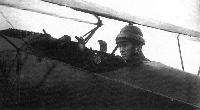 |
А.Александров, Г.Петров - Крылатые пленники России
|
(КПР 80а)
Close-up of a Russian pilot in a D.VII fighter.
|
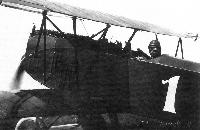 |
А.Александров, Г.Петров - Крылатые пленники России
|
(КПР 80б)
Possibly the same D.VII with '1' on the fuselage in the previous photograph. No machine guns are installed but the feed chutes are visible.
|
 |
C.Owers - Fokker Aircraft of WWI. Vol.7: Postwar /Centennial Perspective/ (67)
|
| On a snow covered field, refueling a FD.VII of the same unit by hand. (via Gennady Petrov archive)
|
 |
C.Owers - Fokker Aircraft of WWI. Vol.7: Postwar /Centennial Perspective/ (67)
|
| An unknown Russian poses in front of a FD.VII that has a light coloured rudder. The ammunition feed to the machine gun may be seen indicating that it may be in a fighter unit. (via Gennady Petrov archive)
|
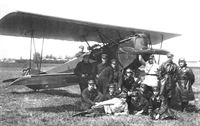 |
C.Owers - Fokker Aircraft of WWI. Vol.7: Postwar /Centennial Perspective/ (67)
|
| This FD.VII has light (blue) undersurfaces and a star on the fuselage. There is a stringer to the fuselage, and what appears to be a camera gun in front of the cockpit. Probably taken at a fighter school. (via Gennady Petrov archive)
|
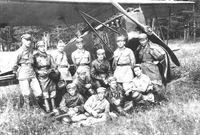 |
C.Owers - Fokker Aircraft of WWI. Vol.7: Postwar /Centennial Perspective/ (67)
|
| Members of the 38th Course at the School of Aerial Combat, Sepukhov, 1927, pose with their armed FD.VII. This machine has the light-coloured undersurfaces. (via Gennady Petrov archive)
|
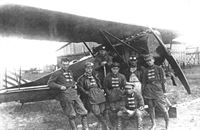 |
C.Owers - Fokker Aircraft of WWI. Vol.7: Postwar /Centennial Perspective/ (67)
|
| Bearing the tail markings of the other FD.VII Fokkers of this unit, the crew members pose with this armed aircraft. (via Gennady Petrov archive)
|
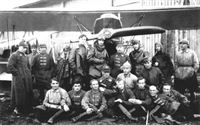 |
C.Owers - Fokker Aircraft of WWI. Vol.7: Postwar /Centennial Perspective/ (67)
|
| Members of a Soviet unit pose in front of a FD.VII. The variations in flight gear are noteworthy. (via Gennady Petrov archive)
|
 |
L.Andersson - Soviet Aircraft and Aviation 1917-1941 /Putnam/
|
| When delivered in May 1922 half of the fifty Fokker D VII fighters acquired by the RKKVF were assigned to the 1st Otdel'naya istrebitel'naya eskadril'ya at Gatchina, south of Leningrad.
|
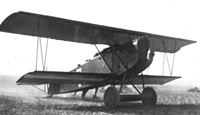 |
C.Owers - Fokker Aircraft of WWI. Vol.7: Postwar /Centennial Perspective/ (67)
|
| This armed FD.VII has interesting markings. A light (white) stripe across the lower surface of the bottom wing and vertical stripes to the rudder light coloured rudder. (via Gennady Petrov archive)
|
 |
C.Owers - Fokker Aircraft of WWI. Vol.7: Postwar /Centennial Perspective/ (67)
|
| Fokker FD.VII No. 6 taking off. (via Gennady Petrov archive)
|
 |
C.Owers - Fokker Aircraft of WWI. Vol.7: Postwar /Centennial Perspective/ (67)
|
| Canadian NASM D.VII. The cockpit views show how the printed camouflage fabric shows through it into the interior of the aircraft.
|
 |
J.Herris, J.Leckscheid - Fokker Aircraft of WWI. Vol.5: 1918 Designs Part 2: D.VII & E.V/D.VIII /Centennial Perspective/ (55)
|
| Available records indicate that Jagdstaffel 10 was the first unit to receive the D.VII. Reportedly the type reached the unit in the second half of April and replaced its Albatros D.Va and Pfalz D.IIIa fighters, the oldest types of aircraft operated by one of the four component Jastas in JG I. By 20 April 1918, the other three Jastas in JG I were operating the Fokker Dr.I. As a consequence, Jasta 10 was the perfect candidate to receive the D.VII. However, soon after arrival of the new type, Lt. Fritz Friedrichs crash-landed his D.VII 234/18 at Cappy. When photographed, his plane only carried the new Balkenkreuz marking on the rudder and fuselage, the wings retained the factory-applied Iron Crosses. (Peter M. Grosz Collection/STDB)
|
 |
J.Herris, J.Leckscheid - Fokker Aircraft of WWI. Vol.5: 1918 Designs Part 2: D.VII & E.V/D.VIII /Centennial Perspective/ (55)
|
| The landing speed of the D.VII was somewhat higher than that of earlier types, and this may have been a contributing factor in the accident. Two other of the new Jasta 10 fighters were also affected by the incident, suffering damage to their wings. The welded steel-tube fuselage of the D.VII was very sturdy, and the damage to the other two planes was probably repaired once replacement wings became available. (Peter M. Grosz Collection/STDB)
|
 |
J.Herris, J.Leckscheid - Fokker Aircraft of WWI. Vol.5: 1918 Designs Part 2: D.VII & E.V/D.VIII /Centennial Perspective/ (55)
|
| Lt. Kurt Wusthoff, a 27-victory ace, joined Jasta 15 on 16 June 1918 after being away from the front for three months. On the very next day, he was forced to land after aerial combat against several S.E.5a's, while flying D.VII 382/18. The crashed aircraft is seen here in British hands after its capture, and again the translucent blue color used by JG II is in evidence, allowing the fuselage cross to shine through. The two cooling slots seen on Piel's Jasta 13 aircraft are also seen here, indicating that this modification was not confined to a single unit in JG II. Wusthoff's career is covered in detail in the book The Blue Max Airmen Vol.11. (Peter M. Grosz Collection/STDB)
|
 |
J.Herris, J.Leckscheid - Fokker Aircraft of WWI. Vol.5: 1918 Designs Part 2: D.VII & E.V/D.VIII /Centennial Perspective/ (55)
|
| A view of the right side of Wusthoff's D.VII is presented here, showing that the skull and crossbones insignia was positioned further towards the rear of the fuselage on this side. Wusthoff was credited to three RAF pilots, and a fourth also put in a claim for him. By his own accounts, he had come under fire by 20 enemy aircraft, causing him to go down badly wounded. According to several sources, his aircraft, Fokker D.VII 382/18, was borrowed from Georg von Hantelmann. But whether this information was purely based on the assumption that von Hantelmann was a former Death Head Regiment hussar or some actual contemporary account is difficult to determine. Certainly Wusthoff had used the skull and crossbones markings on the spinner of one of his previous Albatros fighters. Hantelmann was recommended for the Pour-le-Merite but did not receive it due to Germany's collapse. (Greg VanWyngarden)
|
 |
J.Herris, J.Leckscheid - Fokker Aircraft of WWI. Vol.5: 1918 Designs Part 2: D.VII & E.V/D.VIII /Centennial Perspective/ (55)
|
| Some early-production O.A.W.-built D.VIIs served right until the end of the war. An example was 2024/18 seen here after the Armistice standing on its nose in front of one of the Zeppelin hangars at Cognelee, north-east of Namur. The early thick fuselage and wing crosses were carefully converted to the late "thin" Balkenkreuz style. The stains left by almost six months of frontline service on the inner lower wings may be of interest to the modeler.
|
 |
J.Herris, J.Leckscheid - Fokker Aircraft of WWI. Vol.5: 1918 Designs Part 2: D.VII & E.V/D.VIII /Centennial Perspective/ (55)
|
| As far as is known, Uffz. Buder of Kest 4b walked away from the crash of Fokker D.7 (O.A.W.) 4071/18. The welded steel-tube fuselage and landing gear of the D.VII offered good protection in case of a crash; a wooden Albatros fighter would have looked far worse after such a mishap. In the lower photo, the white O.A.W.-style weights table is shown to advantage. Four-color fabric covers the airframe. (Upper photo: Reinhard Zankl, lower photo; Peter M. Grosz Collection/STDB)
|
 |
J.Herris, J.Leckscheid - Fokker Aircraft of WWI. Vol.5: 1918 Designs Part 2: D.VII & E.V/D.VIII /Centennial Perspective/ (55)
|
| In the early afternoon of 3 October 1918, Jasta 67 pilot Lt. Hans Heinrich Marwede was brought down by groundfire near Montfaucon just after scoring his fifth victory over a balloon. His plane was Fok. D.7. (O.A.W.) 4092/18, and his plane was heavily souvenired even before the first pictures of it could be taken. The unusually thick rudder cross was seen on a few aircraft in this military number range. The upper photo allow a good view at the rear fuselage structure and the reverse side of the four-color fabric. The upper engine panel was apparently removed before the nose of the plane was painted. By the time of the crash, it had been re-fitted to the plane, no doubt due to the cooler fall temperatures. As a result, the factory "giraffe" pattern is still visible on this component. (Upper photo: Peter M. Grosz Collection/STDB, lower photo US Signal Corps)
|
 |
J.Herris, J.Leckscheid - Fokker Aircraft of WWI. Vol.5: 1918 Designs Part 2: D.VII & E.V/D.VIII /Centennial Perspective/ (55)
|
| Whenever the circumstances allowed, crashes were documented by photographs, and here we see "Fok.D VII.(O.A.W.) 4197/18" after a fairly mild mishap. Late aircraft of the second O.A.W. batch now had the military number applied in black between the cockpit and the fuselage cross. It would remain in this position until production was terminated at Schneidemuhl. Note that the small circular maintenance door on the fuselage, close to the wing root, is still not present on this plane. It would only be introduced with the third production batch. (Peter M. Grosz Collection/STDB)
|
 |
J.Herris, J.Leckscheid - Fokker Aircraft of WWI. Vol.5: 1918 Designs Part 2: D.VII & E.V/D.VIII /Centennial Perspective/ (55)
|
| Uffz. Harbers of Jasta 73 crashed Fok. D VII (Alb.) 611/18, perhaps as a result of an imperfect landing at night, since his unit regularly intercepted French night bombers in the summer of 1918. This plane carried the first noticeable major airframe upgrade in the form of the triangular rear metal side panel, as well as the small circular maintenance door above the lower wing root. The rudder is a replacement item, and two bracing wires have been installed to the fin and horizontal tail surfaces. Five-color fabric covers the fuselage of the fighter. (Peter M. Grosz Collection/STDB)
|
 |
L.Andersson - Soviet Aircraft and Aviation 1917-1941 /Putnam/
|
| This Fokker D VII came to grief in the water but was probably repaired.
|
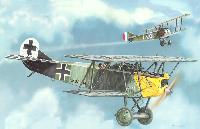 |
Сайт - Pilots-and-planes /WWW/
|
|
|
 |
Сайт - Pilots-and-planes /WWW/
|
| Fokker D.VII (OAW) 4464/18 flown by Ltn Hans Jungwirth of Jasta 78b. Light Blue tape has been applied to each wing rib.
|
 |
J.Herris, J.Leckscheid - Fokker Aircraft of WWI. Vol.5: 1918 Designs Part 2: D.VII & E.V/D.VIII /Centennial Perspective/ (55)
|
| The breathtaking artwork by Steven Anderson depicts Udet's "Du doch nicht!!" in the Red-White-Black interpretation. The upper cowling panel was probably still in place on 25 June 1918.
|
 |
C.Owers - Fokker Aircraft of WWI. Vol.7: Postwar /Centennial Perspective/ (67)
|
|
|
 |
J.Herris - Fokker Aircraft of WWI. Vol.6: Foreign Service /Centennial Perspective/ (56)
|
| Fokker D.VI 90.04 in 1918 with 150 hp Steyr 11 cylinder rotary, a Le Rhone copy. (Peter M. Grosz collection/ STDB)
|
 |
J.Herris, J.Leckscheid - Fokker Aircraft of WWI. Vol.5: 1918 Designs Part 2: D.VII & E.V/D.VIII /Centennial Perspective/ (55)
|
|
|
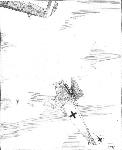 |
Журнал - Flight за 1918 г.
|
| "HANGING ON THE PROP." - The Fokker biplanes are said to be able to assume an attitude similar to that shown in this sketch, and to remain apparently stationary for long periods.
|
 |
R.Kosin - The German Fighter since 1915 /Putnam/
|
|
|
 |
W.Green, G.Swanborough - The Complete Book of Fighters
|
| Fokker D VII
|
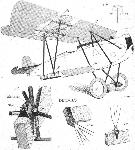 |
Журнал - Flight за 1918 г.
|
| THREE-QUARTER FRONT VIEW OF THE FOKKER BIPLANE, TYPE D VII. - In the machine captured the wings have been somewhat badly damaged, and it has not, therefore, been possible to represent exactly the shape of the wing tips. The upper plane has probably been approximately as shown in the drawing, but of the lower wing sufficient did not remain intact from which to reconstruct the shape of the tip. The unusual strutting of the top plane should be noticed. Inset are some constructional details.
|
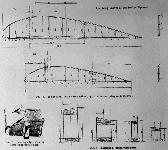 |
Jane's All The World Aircraft 1919 /Jane's/
|
| The Wing Curves of the Fokker Biplane.
|
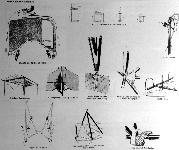 |
Jane's All The World Aircraft 1919 /Jane's/
|
|
|
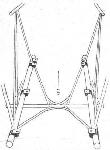 |
Журнал - Flight за 1918 г.
|
| Fig. 15 of the Official Report on the Fokker biplane. Reproduced to show omission of important tubes in the framework. (Compare with "FLIGHT" sketches of same subject.)
|
 |
P.Jarrett, K.Munson - Biplane to Monoplane: Aircraft Development, 1919-39 /Putnam/
|
| The sleel-tube fuselage and tail structure of the Fokker D.VII fighter of 1918. The heavily cambered, ply-skinned wooden wing adopted by Fokker during the war was employed in his company's successful series of interwar airliners.
|
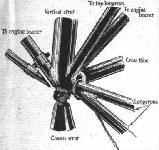 |
Журнал - Flight за 1918 г.
|
| Fig. 2. - A good idea of the extent to which welding is carried in the body of the Fokker biplane can be formed from the accompanying sketch, which shows a joint, or rather a series of joints, where eight different parts meet and are welded together. Needless to say, the making of such a joint would call for the highest skill.
|
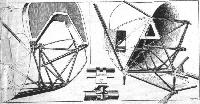 |
Журнал - Flight за 1918 г.
|
| Fig. 3. - Two sketches showing, from different points of view, the engine bearers and their mounting in the Fokker biplane. The inset shows the split collars by means of which the engine is secured to the two longitudinal bearers.
|
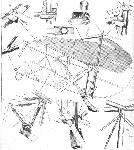 |
Журнал - Flight за 1918 г.
|
| Fig. 4. - Some constructional details of the rear part of the body and of the elevator and rudder of the Fokker biplane. At A is shown the attachment of the vertical fin to the cross tube of the tail plane. At B and C are shown details of the hinges employed for rudder and elevator, and also for the ailerons. The sketch at D shows the split collar by means of which the diagonal tubes that reinforce the body at the point where occur the lifting handles are secured to the lower longeron. At E is shown the springing of the tail skid, and the cable limiting its travel, while at F is illustrated the tail skid attachment to the vertical body strut. The tubular quadrant and wiring of the body is shown at G.
|
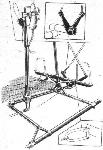 |
Журнал - Flight за 1918 г.
|
| Fig. 5. - Sketch showing controls of Fokker biplane. The insets show the aileron control crank arms and the rudder cable shackles respectively.
|
 |
Журнал - Flight за 1918 г.
|
| Fig. 6. - Diagram of aileron control system on Fokker biplane.
|
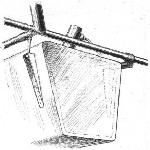 |
Журнал - Flight за 1918 г.
|
| Fig. 7. - The tank of the Fokker biplane is slung by means of brackets and bolts as shown in sketch. There are no bands or other supports for the bottom of the tank.
|
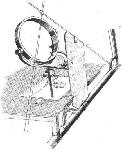 |
Журнал - Flight за 1918 г.
|
| Fig. 8. - The mounting of the compass on the Fokker biplane. Note the adjusting magnets mounted on a square section brass rod under the base plate. These magnets are locked in position and sealed by a lead seal.
|
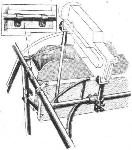 |
Журнал - Flight за 1918 г.
|
| Fig. 9. - Sketch showing mounting of one of the Spandau guns on thel Fokker biplane. Inset, the clips securing the cartridge boxes to the fuselage.
|
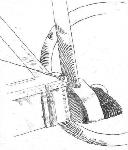 |
Журнал - Flight за 1918 г.
|
| Fig. 10. - The lower ends of the chassis struts of the Fokker biplane are welded to sheet-steel boxes, which carry the shock absorbers, and to which is also attached (by rivets) the aluminium box surrounding the axle.
|
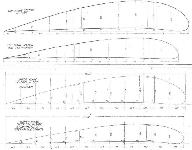 |
Журнал - Flight за 1918 г.
|
| Fig. 11. - Four typical sections of the wings of the Fokker biplane.
|
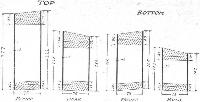 |
Журнал - Flight за 1918 г.
|
| Fig. 12. - Maximum cross sections of the four main spars of the Fokker biplane.
|
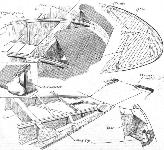 |
Журнал - Flight за 1918 г.
|
| Fig. 13. - Some details of the wing construction on the Fokker biplane.
|
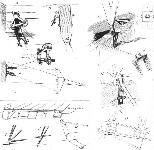 |
Журнал - Flight за 1918 г.
|
| Fig. 14. - Some details of the spar attachments and aileron pulleys of the Fokker biplane.
|
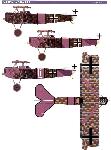 |
Сайт - Pilots-and-planes /WWW/
|
|
|
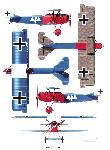 |
Сайт - Pilots-and-planes /WWW/
|
|
|
 |
J.Herris, J.Leckscheid - Fokker Aircraft of WWI. Vol.5: 1918 Designs Part 2: D.VII & E.V/D.VIII /Centennial Perspective/ (55)
|
| Fokker D.VII (O.A.W.) "Du doch nicht!!" of Lt. Ernst Udet
|
 |
J.Herris, J.Leckscheid - Fokker Aircraft of WWI. Vol.5: 1918 Designs Part 2: D.VII & E.V/D.VIII /Centennial Perspective/ (55)
|
| Fokker D.VII "U.10" of Lt. Heinz Freiherr von Beaulieu-Marconnay before capture and as now restored in the NASM.
|
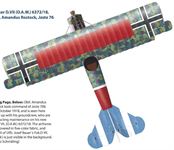 |
J.Herris, J.Leckscheid - Fokker Aircraft of WWI. Vol.5: 1918 Designs Part 2: D.VII & E.V/D.VIII /Centennial Perspective/ (55)
|
| Fokker D.VII (O.A.W.) 6372/18, Oblt. Amandus Rostock, Jasta 76
|
 |
J.Herris, J.Leckscheid - Fokker Aircraft of WWI. Vol.5: 1918 Designs Part 2: D.VII & E.V/D.VIII /Centennial Perspective/ (55)
|
| Fokker D.VII(Alb) 5278/18 Hertha. of Lt. Friedrich Noltenius, Jasta 27. Original markings.
|
 |
J.Herris, J.Leckscheid - Fokker Aircraft of WWI. Vol.5: 1918 Designs Part 2: D.VII & E.V/D.VIII /Centennial Perspective/ (55)
|
| Fokker D.VII(O.A.W.) 6340/18 of Lt. Hermann Becker, Staffelfuhrer of Jasta 12, JG II.
|
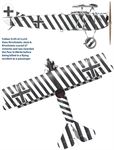 |
J.Herris, J.Leckscheid - Fokker Aircraft of WWI. Vol.5: 1918 Designs Part 2: D.VII & E.V/D.VIII /Centennial Perspective/ (55)
|
| Fokker D.VII of Lt.d.R. Hans Kirschstein, Jasta 6. Kirschstein scored 27 victories and was awarded the Pour le Merite before being killed in a flying accident as a passenger.
|
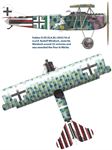 |
J.Herris, J.Leckscheid - Fokker Aircraft of WWI. Vol.5: 1918 Designs Part 2: D.VII & E.V/D.VIII /Centennial Perspective/ (55)
|
| Fokker D.VII (O.A.W.) 2035/18 of Lt.d.R. Rudolf Windisch, Jasta 66. Windisch scored 22 victories and was awarded the Pour le Merite.
|
 |
J.Herris, J.Leckscheid - Fokker Aircraft of WWI. Vol.5: 1918 Designs Part 1: Prototypes & D.VI /Centennial Perspective/ (55)
|
| Fokker V 11
|
 |
J.Herris, J.Leckscheid - Fokker Aircraft of WWI. Vol.5: 1918 Designs Part 1: Prototypes & D.VI /Centennial Perspective/ (55)
|
| Fokker V 18
|
 |
J.Herris, J.Leckscheid - Fokker Aircraft of WWI. Vol.5: 1918 Designs Part 1: Prototypes & D.VI /Centennial Perspective/ (55)
|
| Fokker V 21
|
 |
J.Herris, J.Leckscheid - Fokker Aircraft of WWI. Vol.5: 1918 Designs Part 1: Prototypes & D.VI /Centennial Perspective/ (55)
|
| Fokker V 22
|
 |
J.Herris, J.Leckscheid - Fokker Aircraft of WWI. Vol.5: 1918 Designs Part 1: Prototypes & D.VI /Centennial Perspective/ (55)
|
| Fokker V 24
|
 |
A.Weyl - Fokker: The Creative Years /Putnam/
|
| V.11; V.18; V.22
|
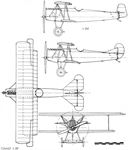 |
A.Weyl - Fokker: The Creative Years /Putnam/
|
| Fokker V.34; V.36
|
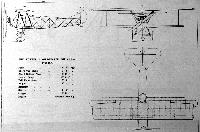 |
Jane's All The World Aircraft 1919 /Jane's/
|
| The Fokker Single-seater Biplane - Type D.7.
|
 |
W.Green, G.Swanborough - The Complete Book of Fighters
|
| The D VII.
|
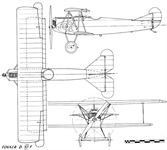 |
A.Weyl - Fokker: The Creative Years /Putnam/
|
| Fokker D.VIIF
|
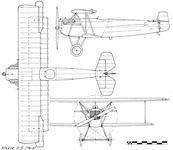 |
A.Weyl - Fokker: The Creative Years /Putnam/
|
| Fokker D.IX (PW-6)
|
 |
R.Kosin - The German Fighter since 1915 /Putnam/
|
| Fokker D.VII
|
 |
Журнал - Flight за 1918 г.
|
| THE FOKKER BIPLANE, TYPE D VII. - Plan, side and front elevations to scale.
|
 |
В.Кондратьев - Самолеты первой мировой войны
|
| Fokker D.VII
|
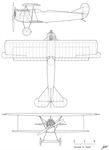 |
P.Grosz, G.Haddow, P.Shiemer - Austro-Hungarian Army Aircraft of World War One /Flying Machines/
|
| Fokker D.VII(MAG) Series 93
|
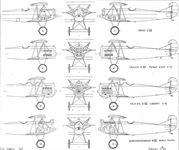 |
C.Owers - Fokker Aircraft of WWI. Vol.7: Postwar /Centennial Perspective/ (67)
|
|
|
 |
J.Herris, J.Leckscheid - Fokker Aircraft of WWI. Vol.5: 1918 Designs Part 2: D.VII & E.V/D.VIII /Centennial Perspective/ (55)
|
| Fokker-Built Fokker D.VII
|
 |
J.Herris, J.Leckscheid - Fokker Aircraft of WWI. Vol.5: 1918 Designs Part 2: D.VII & E.V/D.VIII /Centennial Perspective/ (55)
|
| Fokker D.VII Fokker-Built, Mercedes Engine
|
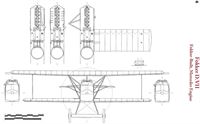 |
J.Herris, J.Leckscheid - Fokker Aircraft of WWI. Vol.5: 1918 Designs Part 2: D.VII & E.V/D.VIII /Centennial Perspective/ (55)
|
| Fokker D.VII Fokker-Built, Mercedes Engine
|
 |
J.Herris, J.Leckscheid - Fokker Aircraft of WWI. Vol.5: 1918 Designs Part 2: D.VII & E.V/D.VIII /Centennial Perspective/ (55)
|
| Fokker D.VII Fokker-Built, Mercedes Engine
|
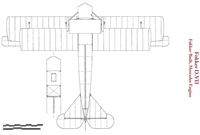 |
J.Herris, J.Leckscheid - Fokker Aircraft of WWI. Vol.5: 1918 Designs Part 2: D.VII & E.V/D.VIII /Centennial Perspective/ (55)
|
| Fokker D.VII Fokker-Built, Mercedes Engine
|
 |
J.Herris, J.Leckscheid - Fokker Aircraft of WWI. Vol.5: 1918 Designs Part 2: D.VII & E.V/D.VIII /Centennial Perspective/ (55)
|
| Albatros-Built Fokker D.VII
|
 |
J.Herris, J.Leckscheid - Fokker Aircraft of WWI. Vol.5: 1918 Designs Part 2: D.VII & E.V/D.VIII /Centennial Perspective/ (55)
|
| Fokker D.VII(Alb) Albatros-Built, Mercedes Engine
|
 |
J.Herris, J.Leckscheid - Fokker Aircraft of WWI. Vol.5: 1918 Designs Part 2: D.VII & E.V/D.VIII /Centennial Perspective/ (55)
|
| Fokker D.VII(Alb) Albatros-Built, Mercedes Engine
|
 |
J.Herris, J.Leckscheid - Fokker Aircraft of WWI. Vol.5: 1918 Designs Part 2: D.VII & E.V/D.VIII /Centennial Perspective/ (55)
|
| Fokker D.VII(Alb) Albatros-Built, Mercedes Engine
|
 |
J.Herris, J.Leckscheid - Fokker Aircraft of WWI. Vol.5: 1918 Designs Part 2: D.VII & E.V/D.VIII /Centennial Perspective/ (55)
|
| Fokker D.VII(Alb) Albatros-Built, Mercedes Engine
|
 |
J.Herris, J.Leckscheid - Fokker Aircraft of WWI. Vol.5: 1918 Designs Part 2: D.VII & E.V/D.VIII /Centennial Perspective/ (55)
|
| OAW-Built Fokker D.VII
|
 |
J.Herris, J.Leckscheid - Fokker Aircraft of WWI. Vol.5: 1918 Designs Part 2: D.VII & E.V/D.VIII /Centennial Perspective/ (55)
|
| Fokker D.VII(OAW) OAW-Built, Mercedes Engine
|
 |
J.Herris, J.Leckscheid - Fokker Aircraft of WWI. Vol.5: 1918 Designs Part 2: D.VII & E.V/D.VIII /Centennial Perspective/ (55)
|
| Fokker D.VII(OAW) OAW-Built, Mercedes Engine
|
 |
J.Herris, J.Leckscheid - Fokker Aircraft of WWI. Vol.5: 1918 Designs Part 2: D.VII & E.V/D.VIII /Centennial Perspective/ (55)
|
| Fokker D.VII(OAW) OAW-Built, Mercedes Engine
|
 |
J.Herris, J.Leckscheid - Fokker Aircraft of WWI. Vol.5: 1918 Designs Part 2: D.VII & E.V/D.VIII /Centennial Perspective/ (55)
|
| Fokker D.VII(OAW) OAW-Built, Mercedes Engine
|
 |
J.Herris, J.Leckscheid - Fokker Aircraft of WWI. Vol.5: 1918 Designs Part 2: D.VII & E.V/D.VIII /Centennial Perspective/ (55)
|
| Fokker D.VII, BMW Engine
|
 |
J.Herris, J.Leckscheid - Fokker Aircraft of WWI. Vol.5: 1918 Designs Part 2: D.VII & E.V/D.VIII /Centennial Perspective/ (55)
|
| Fokker D.VII, BMW Engine
|

